Cisco Systems 102050 802.11 a/g Cardbus Adapter User Manual AIR XX21AG HIG
Cisco Systems Inc 802.11 a/g Cardbus Adapter AIR XX21AG HIG
Contents
- 1. User Manual 1
- 2. User Manual 2
User Manual 1

Corporate Headquarters
Cisco Systems, Inc.
170 West Tasman Drive
San Jose, CA 95134-1706
USA
http://www.cisco.com
Tel: 408 526-4000
800 553-NETS (6387)
Fax: 408 526-4100
Cisco Aironet 802.11a/b/g Wireless LAN Client
Adapters (CB21AG and PI21AG)
Installation and Configuration Guide
Software Release 3.0
Customer Order Number:
Text Part Number: OL-4211-05
THE SPECIFICATIONS AND INFORMATION REGARDING THE PRODUCTS IN THIS MANUAL ARE SUBJECT TO CHANGE WITHOUT NOTICE. ALL
STATEMENTS, INFORMATION, AND RECOMMENDATIONS IN THIS MANUAL ARE BELIEVED TO BE ACCURATE BUT ARE PRESENTED WITHOUT
WARRANTY OF ANY KIND, EXPRESS OR IMPLIED. USERS MUST TAKE FULL RESPONSIBILITY FOR THEIR APPLICATION OF ANY PRODUCTS.
THE SOFTWARE LICENSE AND LIMITED WARRANTY FOR THE ACCOMPANYING PRODUCT ARE SET FORTH IN THE INFORMATION PACKET THAT
SHIPPED WITH THE PRODUCT AND ARE INCORPORATED HEREIN BY THIS REFERENCE. IF YOU ARE UNABLE TO LOCATE THE SOFTWARE LICENSE
OR LIMITED WARRANTY, CONTACT YOUR CISCO REPRESENTATIVE FOR A COPY.
The following information is for FCC compliance of Class A devices: This equipment has been tested and found to comply with the limits for a Class A digital device, pursuant
to part 15 of the FCC rules. These limits are designed to provide reasonable protection against harmful interference when the equipment is operated in a commercial
environment. This equipment generates, uses, and can radiate radio-frequency energy and, if not installed and used in accordance with the instruction manual, may cause
harmful interference to radio communications. Operation of this equipment in a residential area is likely to cause harmful interference, in which case users will be required
to correct the interference at their own expense.
The following information is for FCC compliance of Class B devices: The equipment described in this manual generates and may radiate radio-frequency energy. If it is not
installed in accordance with Cisco’s installation instructions, it may cause interference with radio and television reception. This equipment has been tested and found to
comply with the limits for a Class B digital device in accordance with the specifications in part 15 of the FCC rules. These specifications are designed to provide reasonable
protection against such interference in a residential installation. However, there is no guarantee that interference will not occur in a particular installation.
Modifying the equipment without Cisco’s written authorization may result in the equipment no longer complying with FCC requirements for Class A or Class B digital
devices. In that event, your right to use the equipment may be limited by FCC regulations, and you may be required to correct any interference to radio or television
communications at your own expense.
You can determine whether your equipment is causing interference by turning it off. If the interference stops, it was probably caused by the Cisco equipment or one of its
peripheral devices. If the equipment causes interference to radio or television reception, try to correct the interference by using one or more of the following measures:
• Turn the television or radio antenna until the interference stops.
• Move the equipment to one side or the other of the television or radio.
• Move the equipment farther away from the television or radio.
• Plug the equipment into an outlet that is on a different circuit from the television or radio. (That is, make certain the equipment and the television or radio are on circuits
controlled by different circuit breakers or fuses.)
Modifications to this product not authorized by Cisco Systems, Inc. could void the FCC approval and negate your authority to operate the product.
The Cisco implementation of TCP header compression is an adaptation of a program developed by the University of California, Berkeley (UCB) as part of UCB’s public
domain version of the UNIX operating system. All rights reserved. Copyright © 1981, Regents of the University of California.
NOTWITHSTANDING ANY OTHER WARRANTY HEREIN, ALL DOCUMENT FILES AND SOFTWARE OF THESE SUPPLIERS ARE PROVIDED “AS IS” WITH
ALL FAULTS. CISCO AND THE ABOVE-NAMED SUPPLIERS DISCLAIM ALL WARRANTIES, EXPRESSED OR IMPLIED, INCLUDING, WITHOUT
LIMITATION, THOSE OF MERCHANTABILITY, FITNESS FOR A PARTICULAR PURPOSE AND NONINFRINGEMENT OR ARISING FROM A COURSE OF
DEALING, USAGE, OR TRADE PRACTICE.
IN NO EVENT SHALL CISCO OR ITS SUPPLIERS BE LIABLE FOR ANY INDIRECT, SPECIAL, CONSEQUENTIAL, OR INCIDENTAL DAMAGES, INCLUDING,
WITHOUT LIMITATION, LOST PROFITS OR LOSS OR DAMAGE TO DATA ARISING OUT OF THE USE OR INABILITY TO USE THIS MANUAL, EVEN IF CISCO
OR ITS SUPPLIERS HAVE BEEN ADVISED OF THE POSSIBILITY OF SUCH DAMAGES.
CCSP, CCVP, the Cisco Square Bridge logo, Follow Me Browsing, and StackWise are trademarks of Cisco Systems, Inc.; Changing the Way We Work, Live, Play, and Learn,
and iQuick Study are service marks of Cisco Systems, Inc.; and Access Registrar, Aironet, BPX, Catalyst, CCDA, CCDP, CCIE, CCIP, CCNA, CCNP, Cisco, the Cisco
Certified Internetwork Expert logo, Cisco IOS, Cisco Press, Cisco Systems, Cisco Systems Capital, the Cisco Systems logo, Cisco Unity, Enterprise/Solver, EtherChannel,
EtherFast, EtherSwitch, Fast Step, FormShare, GigaDrive, GigaStack, HomeLink, Internet Quotient, IOS, IP/TV, iQ Expertise, the iQ logo, iQ Net Readiness Scorecard,
LightStream, Linksys, MeetingPlace, MGX, the Networkers logo, Networking Academy, Network Registrar, Packet, PIX, Post-Routing, Pre-Routing, ProConnect,
RateMUX, ScriptShare, SlideCast, SMARTnet, The Fastest Way to Increase Your Internet Quotient, and TransPath are registered trademarks of Cisco Systems, Inc. and/or
its affiliates in the United States and certain other countries.
All other trademarks mentioned in this document or Website are the property of their respective owners. The use of the word partner does not imply a partnership relationship
between Cisco and any other company. (0601R)
Cisco Aironet 802.11a/b/g Wireless LAN Client Adapters (CB21AG and PI21AG) Installation and Configuration Guide
Copyright © 2006 Cisco Systems, Inc.
All rights reserved.

iii
Cisco Aironet 802.11a/b/g Wireless LAN Client Adapters (CB21AG and PI21AG) Installation and Configuration Guide
OL-4211-05
CONTENTS
Preface xi
Audience xii
Purpose xii
Organization xii
Conventions xiii
Related Publications xv
Obtaining Documentation xv
Cisco.com xv
Product Documentation DVD xv
Ordering Documentation xv
Documentation Feedback xvi
Cisco Product Security Overview xvi
Reporting Security Problems in Cisco Products xvii
Obtaining Technical Assistance xvii
Cisco Technical Support & Documentation Website xvii
Submitting a Service Request xviii
Definitions of Service Request Severity xviii
Obtaining Additional Publications and Information xix
CHAPTER
1Product Overview 1-1
Introduction to the Client Adapters 1-2
Terminology 1-2
Hardware Components 1-3
Radio 1-3
Radio Antenna 1-3
LEDs 1-3
Software Components 1-4
Driver 1-4
Client Utilities 1-4
Network Configurations Using Client Adapters 1-5
Ad Hoc Wireless LAN 1-5
Wireless Infrastructure with Workstations Accessing a Wired LAN 1-6

Contents
iv
Cisco Aironet 802.11a/b/g Wireless LAN Client Adapters (CB21AG and PI21AG) Installation and Configuration Guide
OL-4211-05
CHAPTER
2Preparing for Installation 2-1
Safety information 2-2
FCC Safety Compliance Statement 2-2
Safety Guidelines 2-2
Warnings 2-2
Unpacking the Client Adapter 2-3
Package Contents 2-3
System Requirements 2-4
Site Requirements 2-5
For Infrastructure Devices 2-5
For Client Devices 2-5
CHAPTER
3Installing the Client Adapter 3-1
Inserting a Client Adapter 3-2
Inserting a PC-Cardbus Card 3-2
Inserting a PCI Card 3-3
Changing the Bracket 3-3
Inserting the Card 3-4
Assembling the Antenna 3-5
Mounting the Antenna 3-6
Installing the Client Adapter Software 3-9
Installing the Intermediate Driver Manually 3-20
Installing a Microsoft Hot Fix for Group Policy Delay 3-21
CHAPTER
4Using the Profile Manager 4-1
Overview of Profile Manager 4-2
Opening Profile Manager 4-2
Creating a New Profile 4-4
Including a Profile in Auto Profile Selection 4-8
Selecting the Active Profile 4-10
Modifying a Profile 4-11
Editing a Profile 4-11
Deleting a Profile 4-11
Importing and Exporting Profiles 4-11
Importing a Profile 4-12
Exporting a Profile 4-12

Contents
v
Cisco Aironet 802.11a/b/g Wireless LAN Client Adapters (CB21AG and PI21AG) Installation and Configuration Guide
OL-4211-05
CHAPTER
5Configuring the Client Adapter 5-1
Overview 5-2
Setting General Parameters 5-3
Setting Advanced Parameters 5-6
Setting Security Parameters 5-14
Overview of Security Features 5-14
Static WEP Keys 5-15
EAP (with Dynamic WEP Keys) 5-15
WPA and WPA2 5-19
CCKM Fast Secure Roaming 5-20
Reporting Access Points that Fail LEAP Authentication 5-20
Additional WEP Key Security Features 5-21
Synchronizing Security Features 5-22
Enabling Static WEP 5-26
Enabling WPA/WPA2 Passphrase 5-28
Enabling LEAP 5-29
Enabling EAP-FAST 5-34
Enabling EAP-TLS or PEAP 5-44
Enabling EAP-TLS 5-45
Enabling PEAP (EAP-GTC) 5-48
Enabling PEAP (EAP-MSCHAP V2) 5-52
Enabling PEAP (EAP-MSCHAP V2) Machine Authentication with Machine Credentials 5-55
Configuring Advanced Settings 5-58
Disabling Static WEP, WPA/WPA2 Passphrase, or EAP 5-58
Enabling Wi-Fi Multimedia 5-59
Enabling the QoS Packet Scheduler on Windows 2000 5-59
Enabling the QoS Packet Scheduler on Windows XP 5-62
Setting Roaming Parameters in the Windows Control Panel 5-63
Configuring Band Usage 5-65
CHAPTER
6Using EAP Authentication 6-1
Overview 6-2
Using LEAP or EAP-FAST 6-2
Using LEAP or EAP-FAST with the Windows Username and Password 6-3
After Profile Activation or Card Insertion 6-4
After a Reboot or Logon 6-4
After Your EAP-FAST Password Expires 6-5
Using LEAP or EAP-FAST with an Automatically Prompted Login 6-6

Contents
vi
Cisco Aironet 802.11a/b/g Wireless LAN Client Adapters (CB21AG and PI21AG) Installation and Configuration Guide
OL-4211-05
After Profile Activation or Card Insertion 6-6
After a Reboot or Logon 6-7
After Your EAP-FAST Password Expires 6-8
Using LEAP or EAP-FAST with a Manually Prompted Login 6-9
After Profile Activation 6-9
After a Reboot, Logon, or Card Insertion 6-10
After Your EAP-FAST Password Expires 6-12
Using LEAP or EAP-FAST with a Saved Username and Password 6-13
After Profile Activation or Card Insertion 6-13
After a Reboot or Logon 6-13
After Your EAP-FAST Password Expires 6-14
Using EAP-TLS 6-14
Using PEAP (EAP-GTC) 6-15
Windows NT or 2000 Domain Databases or LDAP Databases Only 6-15
OTP Databases Only 6-15
Using PEAP (EAP-MSCHAP V2) 6-16
Restarting the Authentication Process 6-16
CHAPTER
7Viewing Status and Statistics 7-1
Overview of ADU Status and Statistics Tools 7-2
Setting Parameters that Affect ADU Status and Statistics Tools 7-2
Viewing the Current Status of Your Client Adapter 7-4
Viewing Statistics for Your Client Adapter 7-12
CHAPTER
8Using the Aironet System Tray Utility (ASTU) 8-1
Overview of ASTU 8-2
The ASTU Icon 8-2
Tool Tip Window 8-3
Pop-Up Menu 8-5
Help 8-5
Exit 8-6
Open Aironet Desktop Utility 8-6
Troubleshooting 8-6
Preferences 8-6
Enable/Disable Radio 8-7
Manual Login 8-8
Reauthenticate 8-8
Select Profile 8-8

Contents
vii
Cisco Aironet 802.11a/b/g Wireless LAN Client Adapters (CB21AG and PI21AG) Installation and Configuration Guide
OL-4211-05
Show Connection Status 8-9
CHAPTER
9Routine Procedures 9-1
Removing a Client Adapter 9-2
Removing a PC-Cardbus Card 9-2
Removing a PCI Card 9-2
Client Adapter Software Procedures 9-3
Upgrading the Client Adapter Software 9-3
Manually Installing or Upgrading the Client Adapter Driver 9-6
Uninstalling the Client Adapter Software 9-6
ADU Procedures 9-7
Opening ADU 9-8
Exiting ADU 9-8
Finding the Version of ADU and Other Software Components 9-9
Viewing Client Adapter Information 9-10
Accessing Online Help 9-10
ASTU Procedures 9-11
Enabling or Disabling Your Client Adapter’s Radio 9-11
CHAPTER
10 Troubleshooting 10-1
Accessing the Latest Troubleshooting Information 10-2
Interpreting the Indicator LEDs 10-2
Troubleshooting the Client Adapter 10-3
Using the Cisco Aironet Troubleshooting Utility 10-3
Diagnosing Your Client Adapter’s Operation 10-4
Saving the Detailed Report to a Text File 10-7
Disabling the Microsoft Wireless Configuration Manager (Windows XP Only) 10-8
Disabling the Microsoft 802.1X Supplicant (Windows 2000 Only) 10-8
Client Adapter Recognition Problems 10-8
Resolving Resource Conflicts 10-9
Resolving Resource Conflicts in Windows 2000 10-9
Resolving Resource Conflicts in Windows XP 10-10
Problems Associating to an Access Point 10-10
Problems Connecting to the Network 10-11
Prioritizing Network Connections 10-11
Parameters Missing from Profile Management Windows 10-11
Windows Wireless Network Connection Icon Shows Unavailable Connection (Windows XP
Only) 10-11
Error Messages 10-12

Contents
viii
Cisco Aironet 802.11a/b/g Wireless LAN Client Adapters (CB21AG and PI21AG) Installation and Configuration Guide
OL-4211-05
APPENDIX
ATechnical Specifications 25
APPENDIX
BTranslated Safety Warnings 31
Explosive Device Proximity Warning 32
Antenna Installation Warning 33
Warning for Laptop Users 34
APPENDIX
CDeclarations of Conformity and Regulatory Information 37
Manufacturer’s Federal Communication Commission Declaration of Conformity Statement 38
Department of Communications – Canada 39
Canadian Compliance Statement 39
European Community, Switzerland, Norway, Iceland, and Liechtenstein 39
Declaration of Conformity with Regard to the R&TTE Directive 1999/5/EC 39
Declaration of Conformity Statement 41
Cisco Aironet CB21AG Wireless LAN Client Adapter 41
Cisco Aironet PI21AG Wireless LAN Client Adapter 42
Declaration of Conformity for RF Exposure 43
Guidelines for Operating Cisco Aironet Wireless LAN Client Adapters in Japan 43
Japanese Translation 43
English Translation 43
Administrative Rules for Cisco Aironet Wireless LAN Client Adapters in Taiwan 44
2.4- and 5-GHz Client Adapters 44
Chinese Translation 44
English Translation 44
5-GHz Client Adapters 45
Chinese Translation 45
English Translation 45
Brazil/Anatel Approval 45
AIR-CB21AG-W-K9 45
AIR-PI21AG-W-K9 46
APPENDIX
DChannels, Power Levels, and Antenna Gains 47
Channels 48
IEEE 802.11a 48
IEEE 802.11b/g 49
Maximum Power Levels and Antenna Gains 50
IEEE 802.11a 50
IEEE 802.11b 50

Contents
ix
Cisco Aironet 802.11a/b/g Wireless LAN Client Adapters (CB21AG and PI21AG) Installation and Configuration Guide
OL-4211-05
IEEE 802.11g 51
APPENDIX
EConfiguring the Client Adapter through the
Windows XP Operating System 53
Overview 54
Overview of Security Features 54
Static WEP Keys 54
EAP (with Dynamic WEP Keys) 55
WPA 56
Configuring the Client Adapter 57
Enabling EAP-TLS Authentication 62
Enabling PEAP Authentication 65
Enabling PEAP (EAP-MSCHAP V2) 66
Enabling PEAP (EAP-GTC) 68
Associating to an Access Point Using Windows XP 70
Viewing the Current Status of Your Client Adapter 70
APPENDIX
FPerforming a Site Survey 71
Overview 72
Guidelines 72
Additional Information 72
Opening the Site Survey Utility 73
Selecting the Client Adapter 73
Using the Associated AP Status Tab 74
Specifying Display Units 74
Viewing the Access Point’s Status 75
Using the AP Scan List Tab 78
Viewing the AP Scan List 79
Pausing the AP Scan List 83
Viewing AP Details 83
Generating an AP Scan Log File 86
Viewing an Accumulation of Access Points 88
Using the Proximity Beeper 88
Configuring the Proximity Beeper 88
Enabling the Proximity Beeper 90
Using Thresholds 90
Configuring Threshold Values 90
Enabling Threshold Triggers 93

Contents
x
Cisco Aironet 802.11a/b/g Wireless LAN Client Adapters (CB21AG and PI21AG) Installation and Configuration Guide
OL-4211-05
Entering a Comment in the Threshold Log File 94
Viewing the Threshold Log File 94
Deleting the Threshold Log File 95
Using AP Scanning 96
Configuring AP Scan Logging 96
Enabling AP Scan Logging 98
Viewing the AP Scan Log 98
Deleting the AP Scan Log 100
Saving the AP Scan List 100
Opening the AP Scan List 101
Viewing the Status Bar 102
Status Messages 102
Indicators 103
Resize Tab 103
Finding the Version of the Site Survey Utility 103
Accessing Online Help 103
Exiting the Site Survey Utility 104
Uninstalling the Site Survey Utility 104
APPENDIX
GUsing the Profile Migration Tool 105
Overview of the Profile Migration Tool 106
Rules Governing Profile Migration 106
Installing the Profile Migration Tool 107
Running the Profile Migration Tool 108
Command Line Options 109
Uninstalling the Profile Migration Tool 111
G
LOSSARY
I
NDEX

xi
Cisco Aironet 802.11a/b/g Wireless LAN Client Adapters (CB21AG and PI21AG) Installation and Configuration Guide
OL-4211-05
Preface
The preface provides an overview of the Cisco Aironet 802.11a/b/g Wireless LAN Client Adapters
(CB21AG and PI21AG) Installation and Configuration Guide (OL-4211-04), references related
publications, and explains how to obtain other documentation and technical assistance, if necessary.
The following topics are covered in this section:
•Audience, page xii
•Purpose, page xii
•Organization, page xii
•Conventions, page xiii
•Related Publications, page xv
•Obtaining Documentation, page xv
•Documentation Feedback, page xvi
•Cisco Product Security Overview, page xvi
•Obtaining Technical Assistance, page xvii
•Obtaining Additional Publications and Information, page xix

xii
Cisco Aironet 802.11a/b/g Wireless LAN Client Adapters (CB21AG and PI21AG) Installation and Configuration Guide
OL-4211-05
Preface
Audience
Audience
This publication is for the person responsible for installing, configuring, and maintaining a Cisco
Aironet IEEE 802.11a/b/g Wireless LAN Client Adapter (CB21AG or PI21AG) on a computer running
the Microsoft Windows 2000 or XP operating system. This person should be familiar with computing
devices and with network terms and concepts.
Note Windows 2000 and XP are the only supported operating systems.
Purpose
This publication describes the Cisco Aironet CB21AG and PI21AG client adapters and explains how to
install, configure, and troubleshoot them.
Caution This manual pertains specifically to Cisco Aironet CB21AG and PI21AG client adapters, whose
software is incompatible with that of other Cisco Aironet client adapters. Refer to the Cisco Aironet 340,
350, and CB20A Wireless LAN Client Adapters Installation and Configuration Guide for Windows if you
are installing or using 340, 350, or CB20A cards.
Organization
This publication contains the following chapters:
•Chapter 1, “Product Overview,” describes the client adapters and their hardware and software
components and illustrates two common network configurations.
•Chapter 2, “Preparing for Installation,” provides information that you need to know before installing
a client adapter, such as safety information and system requirements.
•Chapter 3, “Installing the Client Adapter,” provides instructions for installing the client adapter.
•Chapter 4, “Using the Profile Manager,” explains how to use the Aironet Desktop Utility (ADU)
profile manager feature to create and manage profiles for your client adapter.
•Chapter 5, “Configuring the Client Adapter,” explains how to change the configuration parameters
for a specific profile.
•Chapter 6, “Using EAP Authentication,” explains the sequence of events that occurs and the actions
you must take when a profile that is set for EAP authentication is activated.
•Chapter 7, “Viewing Status and Statistics,” explains how to use ADU to view the client adapter’s
status and its transmit and receive statistics.
•Chapter 8, “Using the Aironet System Tray Utility (ASTU),” explains how to use ASTU to view
status information about your client adapter and perform basic tasks.
•Chapter 9, “Routine Procedures,” provides procedures for common tasks related to the client
adapters, such as uninstalling client adapter software and opening ADU.
•Chapter 10, “Troubleshooting,” provides information for diagnosing and correcting common
problems that may be encountered when installing or operating a client adapter.

xiii
Cisco Aironet 802.11a/b/g Wireless LAN Client Adapters (CB21AG and PI21AG) Installation and Configuration Guide
OL-4211-05
Preface
Conventions
•Appendix A, “Technical Specifications,” lists the physical, radio, power, and regulatory
specifications for the client adapters.
•Appendix B, “Translated Safety Warnings,” provides translations of client adapter safety warnings
in nine languages.
•Appendix C, “Declarations of Conformity and Regulatory Information,” provides declarations of
conformity and regulatory information for the client adapters.
•Appendix D, “Channels, Power Levels, and Antenna Gains,” lists the IEEE 802.11a, b, and g
channels supported by the world's regulatory domains as well as the maximum power levels and
antenna gains allowed per domain.
•Appendix E, “Configuring the Client Adapter through the Windows XP Operating System,”
explains how to configure and use your client adapter with the Microsoft Wireless Configuration
Manager.
•Appendix F, “Performing a Site Survey” shows people who are responsible for conducting a site
survey how they can use the site survey utility to determine the best placement for infrastructure
devices within a wireless network.
Conventions
This publication uses the following conventions to convey instructions and information:
•Commands are in boldface.
•Variables are in italics.
•Configuration parameters are capitalized.
•Notes, cautions, and warnings use the following conventions and symbols:
Note Means reader take note. Notes contain helpful suggestions or references to materials not contained in
this manual.
Caution Means reader be careful. In this situation, you might do something that could result in equipment
damage or loss of data.
Warning
This warning symbol means danger. You are in a situation that could cause bodily injury. Before you
work on any equipment, be aware of the hazards involved with electrical circuitry and be familiar
with standard practices for preventing accidents. (To see translations of the warnings that appear
in this publication, refer to the appendix “Translated Safety Warnings.”)
Waarschuwing
Dit waarschuwingssymbool betekent gevaar. U verkeert in een situatie die lichamelijk letsel kan
veroorzaken. Voordat u aan enige apparatuur gaat werken, dient u zich bewust te zijn van de bij
elektrische schakelingen betrokken risico’s en dient u op de hoogte te zijn van standaard
maatregelen om ongelukken te voorkomen. (Voor vertalingen van de waarschuwingen die in deze
publicatie verschijnen, kunt u het aanhangsel “Translated Safety Warnings” (Vertalingen van
veiligheidsvoorschriften) raadplegen.)

xiv
Cisco Aironet 802.11a/b/g Wireless LAN Client Adapters (CB21AG and PI21AG) Installation and Configuration Guide
OL-4211-05
Preface
Conventions
Varoitus
Tämä varoitusmerkki merkitsee vaaraa. Olet tilanteessa, joka voi johtaa ruumiinvammaan. Ennen
kuin työskentelet minkään laitteiston parissa, ota selvää sähkökytkentöihin liittyvistä vaaroista ja
tavanomaisista onnettomuuksien ehkäisykeinoista. (Tässä julkaisussa esiintyvien varoitusten
käännökset löydät liitteestä "Translated Safety Warnings" (käännetyt turvallisuutta koskevat
varoitukset).)
Attention
Ce symbole d’avertissement indique un danger. Vous vous trouvez dans une situation pouvant
entraîner des blessures. Avant d’accéder à cet équipement, soyez conscient des dangers posés par
les circuits électriques et familiarisez-vous avec les procédures courantes de prévention des
accidents. Pour obtenir les traductions des mises en garde figurant dans cette publication, veuillez
consulter l’annexe intitulée « Translated Safety Warnings » (Traduction des avis de sécurité).
Warnung
Dieses Warnsymbol bedeutet Gefahr. Sie befinden sich in einer Situation, die zu einer
Körperverletzung führen könnte. Bevor Sie mit der Arbeit an irgendeinem Gerät beginnen, seien Sie
sich der mit elektrischen Stromkreisen verbundenen Gefahren und der Standardpraktiken zur
Vermeidung von Unfällen bewußt. (Übersetzungen der in dieser Veröffentlichung enthaltenen
Warnhinweise finden Sie im Anhang mit dem Titel “Translated Safety Warnings” (Übersetzung der
Warnhinweise).)
Avvertenza
Questo simbolo di avvertenza indica un pericolo. Si è in una situazione che può causare infortuni.
Prima di lavorare su qualsiasi apparecchiatura, occorre conoscere i pericoli relativi ai circuiti
elettrici ed essere al corrente delle pratiche standard per la prevenzione di incidenti. La traduzione
delle avvertenze riportate in questa pubblicazione si trova nell’appendice, “Translated Safety
Warnings” (Traduzione delle avvertenze di sicurezza).
Advarsel
Dette varselsymbolet betyr fare. Du befinner deg i en situasjon som kan føre til personskade. Før du
utfører arbeid på utstyr, må du være oppmerksom på de faremomentene som elektriske kretser
innebærer, samt gjøre deg kjent med vanlig praksis når det gjelder å unngå ulykker. (Hvis du vil se
oversettelser av de advarslene som finnes i denne publikasjonen, kan du se i vedlegget "Translated
Safety Warnings" [Oversatte sikkerhetsadvarsler].)
Aviso
Este símbolo de aviso indica perigo. Encontra-se numa situação que lhe poderá causar danos fisicos.
Antes de começar a trabalhar com qualquer equipamento, familiarize-se com os perigos
relacionados com circuitos eléctricos, e com quaisquer práticas comuns que possam prevenir
possíveis acidentes. (Para ver as traduções dos avisos que constam desta publicação, consulte o
apêndice “Translated Safety Warnings” - “Traduções dos Avisos de Segurança”).
¡Advertencia!
Este símbolo de aviso significa peligro. Existe riesgo para su integridad física. Antes de manipular
cualquier equipo, considerar los riesgos que entraña la corriente eléctrica y familiarizarse con los
procedimientos estándar de prevención de accidentes. (Para ver traducciones de las advertencias
que aparecen en esta publicación, consultar el apéndice titulado “Translated Safety Warnings.”)
Varning!
Denna varningssymbol signalerar fara. Du befinner dig i en situation som kan leda till personskada.
Innan du utför arbete på någon utrustning måste du vara medveten om farorna med elkretsar och
känna till vanligt förfarande för att förebygga skador. (Se förklaringar av de varningar som
förekommer i denna publikation i appendix "Translated Safety Warnings" [Översatta
säkerhetsvarningar].)

xv
Cisco Aironet 802.11a/b/g Wireless LAN Client Adapters (CB21AG and PI21AG) Installation and Configuration Guide
OL-4211-05
Preface
Related Publications
Related Publications
For more information about Cisco Aironet CB21AG and PI21AG Wireless LAN Client Adapters for
Windows, refer to the following publication:
•Release Notes for Cisco Aironet 802.11a/b/g Client Adapters (CB21AG and PI21AG) Install Wizard
For more information about related Cisco Aironet products, refer to the publications for your
infrastructure device. You can find Cisco Aironet technical documentation at this URL:
http://www.cisco.com/en/US/products/hw/wireless/tsd_products_support_category_home.html
Obtaining Documentation
Cisco documentation and additional literature are available on Cisco.com. Cisco also provides several
ways to obtain technical assistance and other technical resources. These sections explain how to obtain
technical information from Cisco Systems.
Cisco.com
You can access the most current Cisco documentation at this URL:
http://www.cisco.com/techsupport
You can access the Cisco website at this URL:
http://www.cisco.com
You can access international Cisco websites at this URL:
http://www.cisco.com/public/countries_languages.shtml
Product Documentation DVD
The Product Documentation DVD is a comprehensive library of technical product documentation on a
portable medium. The DVD enables you to access multiple versions of installation, configuration, and
command guides for Cisco hardware and software products. With the DVD, you have access to the same
HTML documentation that is found on the Cisco website without being connected to the Internet.
Certain products also have .PDF versions of the documentation available.
The Product Documentation DVD is available as a single unit or as a subscription. Registered Cisco.com
users (Cisco direct customers) can order a Product Documentation DVD (product number
DOC-DOCDVD= or DOC-DOCDVD=SUB) from Cisco Marketplace at this URL:
http://www.cisco.com/go/marketplace/
Ordering Documentation
Registered Cisco.com users may order Cisco documentation at the Product Documentation Store in the
Cisco Marketplace at this URL:
http://www.cisco.com/go/marketplace/

xvi
Cisco Aironet 802.11a/b/g Wireless LAN Client Adapters (CB21AG and PI21AG) Installation and Configuration Guide
OL-4211-05
Preface
Documentation Feedback
Nonregistered Cisco.com users can order technical documentation from 8:00 a.m. to 5:00 p.m.
(0800 to 1700) PDT by calling 1 866 463-3487 in the United States and Canada, or elsewhere by
calling 011 408 519-5055. You can also order documentation by e-mail at
tech-doc-store-mkpl@external.cisco.com or by fax at 1 408 519-5001 in the United States and Canada,
or elsewhere at 011 408 519-5001.
Documentation Feedback
You can rate and provide feedback about Cisco technical documents by completing the online feedback
form that appears with the technical documents on Cisco.com.
You can submit comments about Cisco documentation by using the response card (if present) behind the
front cover of your document or by writing to the following address:
Cisco Systems
Attn: Customer Document Ordering
170 West Tasman Drive
San Jose, CA 95134-9883
We appreciate your comments.
Cisco Product Security Overview
Cisco provides a free online Security Vulnerability Policy portal at this URL:
http://www.cisco.com/en/US/products/products_security_vulnerability_policy.html
From this site, you will find information about how to:
•Report security vulnerabilities in Cisco products.
•Obtain assistance with security incidents that involve Cisco products.
•Register to receive security information from Cisco.
A current list of security advisories, security notices, and security responses for Cisco products is
available at this URL:
http://www.cisco.com/go/psirt
To see security advisories, security notices, and security responses as they are updated in real time, you
can subscribe to the Product Security Incident Response Team Really Simple Syndication (PSIRT RSS)
feed. Information about how to subscribe to the PSIRT RSS feed is found at this URL:
http://www.cisco.com/en/US/products/products_psirt_rss_feed.html

xvii
Cisco Aironet 802.11a/b/g Wireless LAN Client Adapters (CB21AG and PI21AG) Installation and Configuration Guide
OL-4211-05
Preface
Obtaining Technical Assistance
Reporting Security Problems in Cisco Products
Cisco is committed to delivering secure products. We test our products internally before we release them,
and we strive to correct all vulnerabilities quickly. If you think that you have identified a vulnerability
in a Cisco product, contact PSIRT:
•For Emergencies only—security-alert@cisco.com
An emergency is either a condition in which a system is under active attack or a condition for which
a severe and urgent security vulnerability should be reported. All other conditions are considered
nonemergencies.
•For Nonemergencies—psirt@cisco.com
In an emergency, you can also reach PSIRT by telephone:
•1 877 228-7302
•1 408 525-6532
Tip We encourage you to use Pretty Good Privacy (PGP) or a compatible product (for example, GnuPG) to
encrypt any sensitive information that you send to Cisco. PSIRT can work with information that has been
encrypted with PGP versions 2.x through 9.x.
Never use a revoked or an expired encryption key. The correct public key to use in your correspondence
with PSIRT is the one linked in the Contact Summary section of the Security Vulnerability Policy page
at this URL:
http://www.cisco.com/en/US/products/products_security_vulnerability_policy.html
The link on this page has the current PGP key ID in use.
If you do not have or use PGP, contact PSIRT at the aforementioned e-mail addresses or phone numbers
before sending any sensitive material to find other means of encrypting the data.
Obtaining Technical Assistance
Cisco Technical Support provides 24-hour-a-day award-winning technical assistance. The Cisco
Technical Support & Documentation website on Cisco.com features extensive online support resources.
In addition, if you have a valid Cisco service contract, Cisco Technical Assistance Center (TAC)
engineers provide telephone support. If you do not have a valid Cisco service contract, contact your
reseller.
Cisco Technical Support & Documentation Website
The Cisco Technical Support & Documentation website provides online documents and tools for
troubleshooting and resolving technical issues with Cisco products and technologies. The website is
available 24 hours a day, at this URL:
http://www.cisco.com/techsupport

xviii
Cisco Aironet 802.11a/b/g Wireless LAN Client Adapters (CB21AG and PI21AG) Installation and Configuration Guide
OL-4211-05
Preface
Obtaining Technical Assistance
Access to all tools on the Cisco Technical Support & Documentation website requires a Cisco.com user
ID and password. If you have a valid service contract but do not have a user ID or password, you can
register at this URL:
http://tools.cisco.com/RPF/register/register.do
Note Use the Cisco Product Identification (CPI) tool to locate your product serial number before submitting
a web or phone request for service. You can access the CPI tool from the Cisco Technical Support &
Documentation website by clicking the Tools & Resources link under Documentation & Tools. Choose
Cisco Product Identification Tool from the Alphabetical Index drop-down list, or click the Cisco
Product Identification Tool link under Alerts & RMAs. The CPI tool offers three search options: by
product ID or model name; by tree view; or for certain products, by copying and pasting show command
output. Search results show an illustration of your product with the serial number label location
highlighted. Locate the serial number label on your product and record the information before placing a
service call.
Submitting a Service Request
Using the online TAC Service Request Tool is the fastest way to open S3 and S4 service requests. (S3
and S4 service requests are those in which your network is minimally impaired or for which you require
product information.) After you describe your situation, the TAC Service Request Tool provides
recommended solutions. If your issue is not resolved using the recommended resources, your service
request is assigned to a Cisco engineer. The TAC Service Request Tool is located at this URL:
http://www.cisco.com/techsupport/servicerequest
For S1 or S2 service requests, or if you do not have Internet access, contact the Cisco TAC by telephone.
(S1 or S2 service requests are those in which your production network is down or severely degraded.)
Cisco engineers are assigned immediately to S1 and S2 service requests to help keep your business
operations running smoothly.
To open a service request by telephone, use one of the following numbers:
Asia-Pacific: +61 2 8446 7411 (Australia: 1 800 805 227)
EMEA: +32 2 704 55 55
USA: 1 800 553-2447
For a complete list of Cisco TAC contacts, go to this URL:
http://www.cisco.com/techsupport/contacts
Definitions of Service Request Severity
To ensure that all service requests are reported in a standard format, Cisco has established severity
definitions.
Severity 1 (S1)—An existing network is down, or there is a critical impact to your business operations.
You and Cisco will commit all necessary resources around the clock to resolve the situation.
Severity 2 (S2)—Operation of an existing network is severely degraded, or significant aspects of your
business operations are negatively affected by inadequate performance of Cisco products. You and Cisco
will commit full-time resources during normal business hours to resolve the situation.

xix
Cisco Aironet 802.11a/b/g Wireless LAN Client Adapters (CB21AG and PI21AG) Installation and Configuration Guide
OL-4211-05
Preface
Obtaining Additional Publications and Information
Severity 3 (S3)—Operational performance of the network is impaired, while most business operations
remain functional. You and Cisco will commit resources during normal business hours to restore service
to satisfactory levels.
Severity 4 (S4)—You require information or assistance with Cisco product capabilities, installation, or
configuration. There is little or no effect on your business operations.
Obtaining Additional Publications and Information
Information about Cisco products, technologies, and network solutions is available from various online
and printed sources.
•The Cisco Product Quick Reference Guide is a handy, compact reference tool that includes brief
product overviews, key features, sample part numbers, and abbreviated technical specifications for
many Cisco products that are sold through channel partners. It is updated twice a year and includes
the latest Cisco offerings. To order and find out more about the Cisco Product Quick Reference
Guide, go to this URL:
http://www.cisco.com/go/guide
•Cisco Marketplace provides a variety of Cisco books, reference guides, documentation, and logo
merchandise. Visit Cisco Marketplace, the company store, at this URL:
http://www.cisco.com/go/marketplace/
•Cisco Press publishes a wide range of general networking, training and certification titles. Both new
and experienced users will benefit from these publications. For current Cisco Press titles and other
information, go to Cisco Press at this URL:
http://www.ciscopress.com
•Packet magazine is the Cisco Systems technical user magazine for maximizing Internet and
networking investments. Each quarter, Packet delivers coverage of the latest industry trends,
technology breakthroughs, and Cisco products and solutions, as well as network deployment and
troubleshooting tips, configuration examples, customer case studies, certification and training
information, and links to scores of in-depth online resources. You can access Packet magazine at
this URL:
http://www.cisco.com/packet
•iQ Magazine is the quarterly publication from Cisco Systems designed to help growing companies
learn how they can use technology to increase revenue, streamline their business, and expand
services. The publication identifies the challenges facing these companies and the technologies to
help solve them, using real-world case studies and business strategies to help readers make sound
technology investment decisions. You can access iQ Magazine at this URL:
http://www.cisco.com/go/iqmagazine
or view the digital edition at this URL:
http://ciscoiq.texterity.com/ciscoiq/sample/
•Internet Protocol Journal is a quarterly journal published by Cisco Systems for engineering
professionals involved in designing, developing, and operating public and private internets and
intranets. You can access the Internet Protocol Journal at this URL:
http://www.cisco.com/ipj

xx
Cisco Aironet 802.11a/b/g Wireless LAN Client Adapters (CB21AG and PI21AG) Installation and Configuration Guide
OL-4211-05
Preface
Obtaining Additional Publications and Information
•Networking products offered by Cisco Systems, as well as customer support services, can be
obtained at this URL:
http://www.cisco.com/en/US/products/index.html
•Networking Professionals Connection is an interactive website for networking professionals to share
questions, suggestions, and information about networking products and technologies with Cisco
experts and other networking professionals. Join a discussion at this URL:
http://www.cisco.com/discuss/networking
•World-class networking training is available from Cisco. You can view current offerings at
this URL:
http://www.cisco.com/en/US/learning/index.html

CHAPTER
1-1
Cisco Aironet 802.11a/b/g Wireless LAN Client Adapters (CB21AG and PI21AG) Installation and Configuration Guide
OL-4211-05
1
Product Overview
This chapter describes the Cisco Aironet CB21AG and PI21AG client adapters and illustrates their role
in a wireless network.
The following topics are covered in this chapter:
•Introduction to the Client Adapters, page 1-2
•Hardware Components, page 1-3
•Software Components, page 1-4
•Network Configurations Using Client Adapters, page 1-5
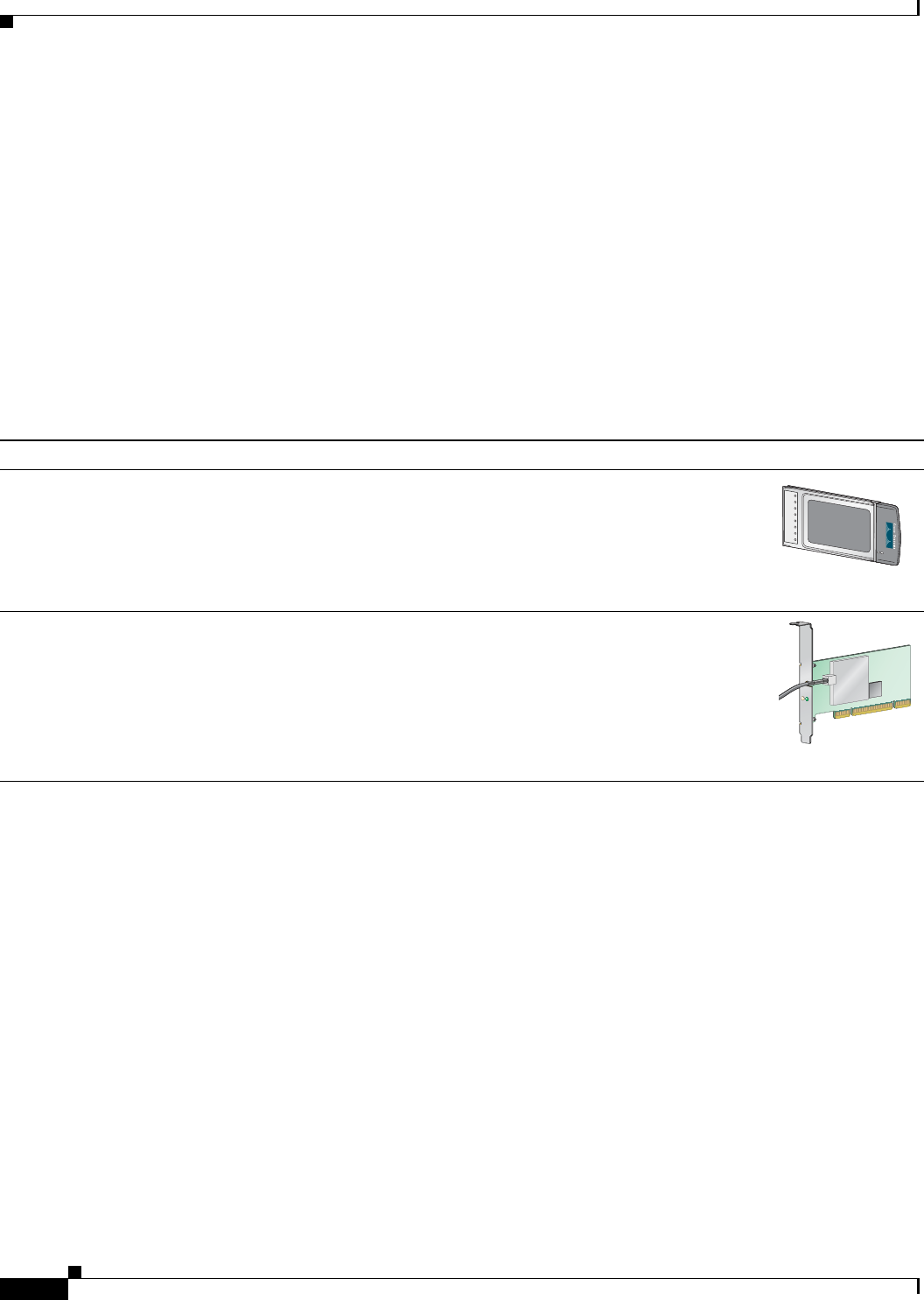
1-2
Cisco Aironet 802.11a/b/g Wireless LAN Client Adapters (CB21AG and PI21AG) Installation and Configuration Guide
OL-4211-05
Chapter 1 Product Overview
Introduction to the Client Adapters
Introduction to the Client Adapters
The Cisco Aironet IEEE 802.11a/b/g Wireless LAN Client Adapters (CB21AG and PI21AG) are radio
modules that provide wireless data communications among fixed, portable, and mobile devices within
both wireless and wired network infrastructures. The client adapters are fully compatible when used in
devices supporting “plug-and-play” (PnP) technology.
The primary function of the client adapters is to transfer data packets through the wireless infrastructure
by communicating with other clients or with access points that are connected to a wired LAN. The
adapters operate similarly to a standard network product except that radios rather than Ethernet cables
make the connection to the wire. No special wireless networking functions are required, and all existing
applications that operate over a network can operate using the adapters.
This document covers the two client adapters described in Table 1-1.
Terminology
The following terms are used throughout this document:
•client adapter—Refers to both types of adapters.
•PC-Cardbus card or PCI card—Refers to a specific adapter.
•workstation (or station)—Refers to a computing device with an installed client adapter.
•infrastructure device—Refers to a device that connects client adapters to a wired LAN, such as an
access point, bridge, or base station. Throughout this document, access point is used to represent
infrastructure devices in general.
Table 1-1 Client Adapter Types
Client Adapter Model Number Description Illustration
PC-Cardbus
card
AIR-CB21AG An IEEE 802.11a/b/g-compliant 2.4- and 5-GHz 54-Mbps client
adapter card radio module with a Cardbus interface that can be
inserted into any device equipped with a 32-bit Cardbus slot. Host
devices can include laptops and notebook computers.
PCI card AIR-PI21AG An IEEE 802.11a/b/g-compliant 2.4- and 5-GHz 54-Mbps client
adapter card radio module that can be inserted into any device
equipped with an empty PCI expansion slot, such as a desktop
personal computer.
95579
95580
STAT U S
ACTIVITY

1-3
Cisco Aironet 802.11a/b/g Wireless LAN Client Adapters (CB21AG and PI21AG) Installation and Configuration Guide
OL-4211-05
Chapter 1 Product Overview
Hardware Components
Hardware Components
The client adapters have three major hardware components: a radio, a radio antenna, and two LEDs.
Radio
The client adapters contain a dual-band radio that is both IEEE 802.11a and 802.11b/g compliant. The
radio uses both direct-sequence spread spectrum (DSSS) technology and orthogonal frequency division
multiplexing (OFDM) technology for client applications in the 2.4-GHz Industrial Scientific Medical
(ISM) frequency band and OFDM technology in the 5-GHz Unlicensed National Information
Infrastructure (UNII) frequency bands. The client adapters operate with other IEEE 802.11a or
802.11b/g-compliant client devices in ad hoc mode or with Cisco Aironet access points and other IEEE
802.11a or 802.11b/g-compliant infrastructure devices in infrastructure mode.
Radio Antenna
The type of antenna used depends on your client adapter:
•PC-Cardbus cards have an integrated, permanently attached 0-dBi gain, dual-band 2.4/5-GHz
diversity antenna. The benefit of the diversity antenna system is improved coverage. The system
works by enabling the card to sample and switch between its two antenna ports in order to select the
optimum port for receiving data packets. As a result, the card has a better chance of maintaining the
radio frequency (RF) connection in areas of interference. The antenna is housed within the section
of the card that hangs out of the Cardbus slot when the card is installed.
•PCI cards have a 1-dBi gain, dual-band 2.4/5-GHz antenna that is permanently attached by a 6.6-foot
(2-meter) cable. A base is provided with the antenna to enable it to be mounted to a wall or to sit
upright on a desk or other horizontal surface.
LEDs
The client adapters have two LEDs that glow or blink to indicate the status of the adapter or to convey
error messages. Refer to Chapter 10 for an interpretation of the LED codes.

1-4
Cisco Aironet 802.11a/b/g Wireless LAN Client Adapters (CB21AG and PI21AG) Installation and Configuration Guide
OL-4211-05
Chapter 1 Product Overview
Software Components
Software Components
The client adapters have two major software components: a driver and client utilities. These components
are installed together by running a single executable Install Wizard file that is available from Cisco.com.
This file can be run on Windows 2000 or XP and can be used only with CB21AG and PI21AG client
adapters.
Note Chapter 3 provides instructions on using the Install Wizard to install these software components.
Driver
The driver provides an interface between a computer’s operating system and the client adapter, thereby
enabling the operating system and the applications it runs to communicate with the adapter. The driver
must be installed before the adapter can be used.
Client Utilities
Two client utilities are available for use with the client adapters: Aironet Desktop Utility (ADU) and
Aironet System Tray Utility (ASTU). These utilities are optional applications that interact with the client
adapter’s radio to adjust settings and display information.
ADU enables you to create configuration profiles for your client adapter and perform user-level
diagnostics. Because ADU performs a variety of functions, it is documented by function throughout this
manual.
ASTU, which is accessible from an icon in the Windows system tray, provides a small subset of the
features available through ADU. Specifically, it enables you to view status information about your client
adapter and perform basic tasks. Chapter 8 provides detailed information and instructions on using
ASTU.
Note If your computer is running Windows XP, you can configure your client adapter through the Microsoft
Wireless Configuration Manager (or another third-party tool) instead of through ADU. Refer to
Appendix E for information. However, ADU is recommended for configuring the client adapter.
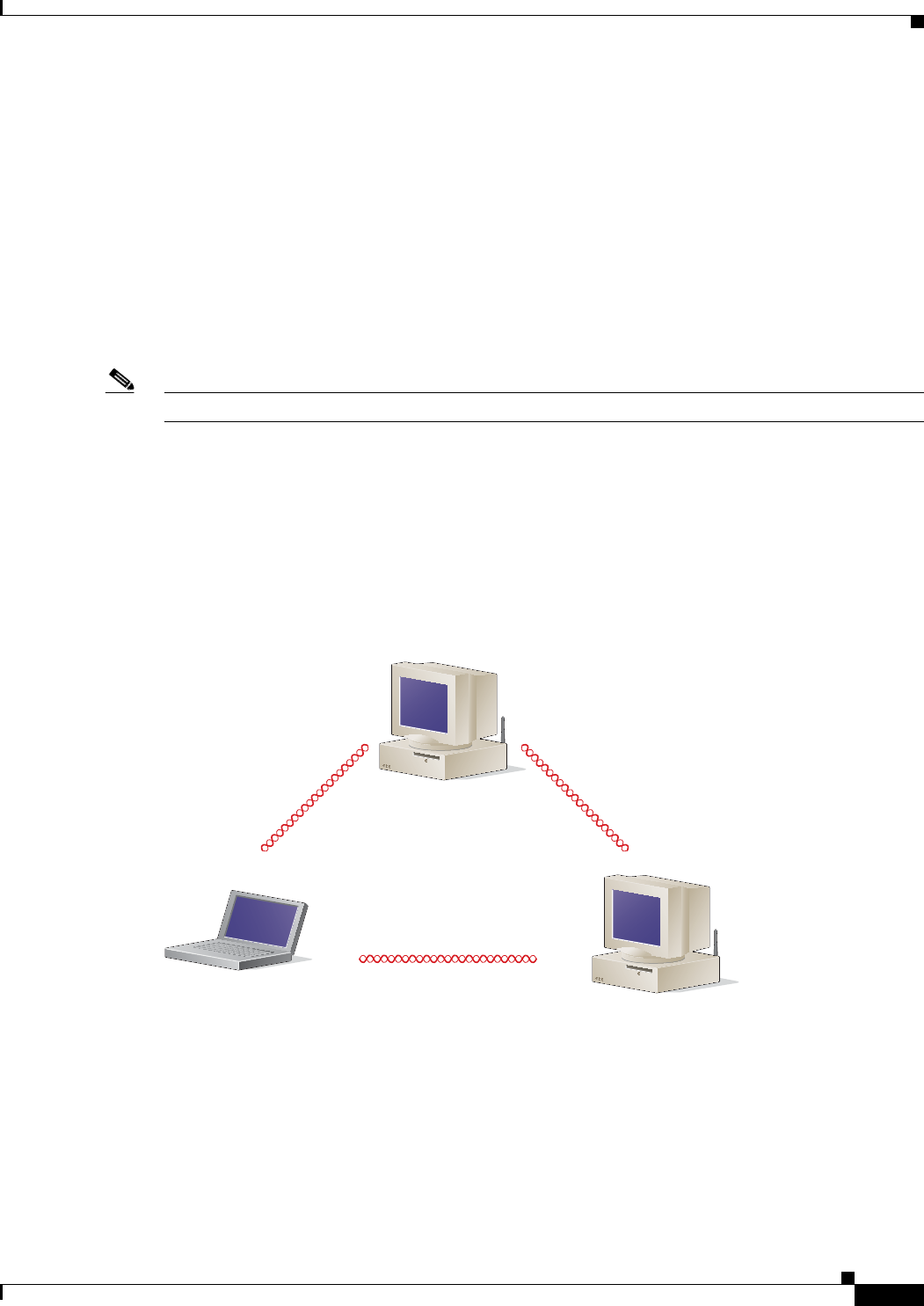
1-5
Cisco Aironet 802.11a/b/g Wireless LAN Client Adapters (CB21AG and PI21AG) Installation and Configuration Guide
OL-4211-05
Chapter 1 Product Overview
Network Configurations Using Client Adapters
Network Configurations Using Client Adapters
Client adapters can be used in a variety of network configurations. In some configurations, access points
provide connections to your network or act as repeaters to increase wireless communication range. The
maximum communication range is based on how you configure your wireless network.
This section describes and illustrates the two most common network configurations:
•Ad hoc wireless local area network (LAN)
•Wireless infrastructure with workstations accessing a wired LAN
For examples of more complex network configurations involving client adapters and access points, refer
to the documentation for your access point.
Note Refer to Chapter 5 for information on setting the client adapter’s network type.
Ad Hoc Wireless LAN
An ad hoc (or peer-to-peer) wireless LAN (see Figure 1-1) is the simplest wireless LAN configuration.
In a wireless LAN using an ad hoc network configuration, all devices equipped with a client adapter can
be linked together and communicate directly with each other. The use of an infrastructure device, such
as an access point, is not required.
Figure 1-1 Ad Hoc Wireless LAN
47520
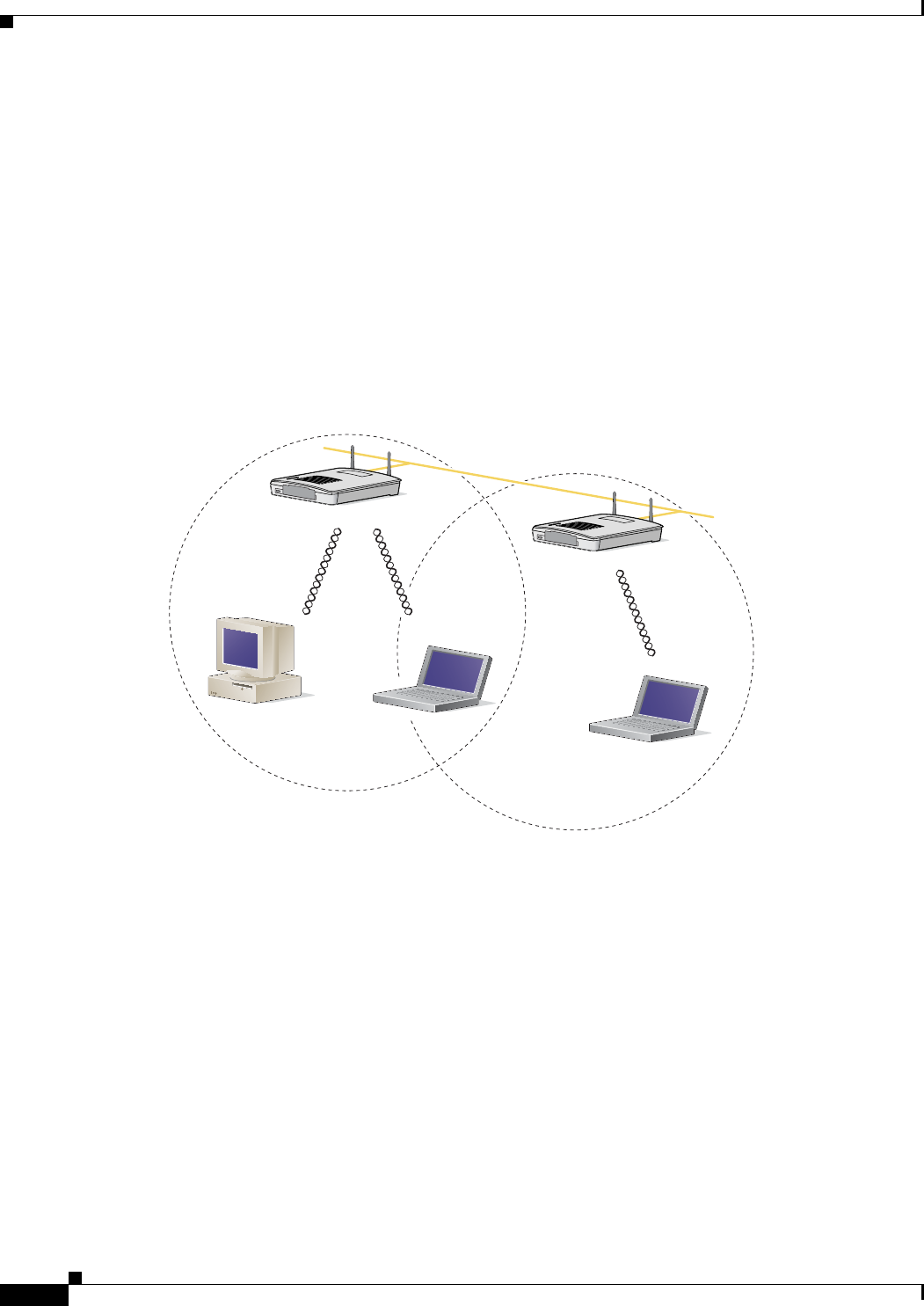
1-6
Cisco Aironet 802.11a/b/g Wireless LAN Client Adapters (CB21AG and PI21AG) Installation and Configuration Guide
OL-4211-05
Chapter 1 Product Overview
Network Configurations Using Client Adapters
Wireless Infrastructure with Workstations Accessing a Wired LAN
A microcellular network can be created by placing two or more access points on a LAN. Figure 1-2
shows a microcellular network with workstations accessing a wired LAN through several access points.
This configuration is useful with portable or mobile stations because it enables them to be directly
connected to the wired network even while moving from one microcell domain to another. This process
is transparent, and the connection to the file server or host is maintained without disruption. The mobile
station stays connected to an access point as long as it can. However, when the transfer of data packets
needs to be retried or beacons are missed, the station automatically searches for and associates to another
access point. This process is referred to as seamless roaming.
Figure 1-2 Wireless Infrastructure with Workstations Accessing a Wired LAN
Access Point
(Root Unit)
Access Point
(Root Unit)
65999
Wired LAN

CHAPTER
2-1
Cisco Aironet 802.11a/b/g Wireless LAN Client Adapters (CB21AG and PI21AG) Installation and Configuration Guide
OL-4211-05
2
Preparing for Installation
This chapter provides information that you need to know before installing a client adapter.
The following topics are covered in this chapter:
•Safety information, page 2-2
•Unpacking the Client Adapter, page 2-3
•System Requirements, page 2-4
•Site Requirements, page 2-5

2-2
Cisco Aironet 802.11a/b/g Wireless LAN Client Adapters (CB21AG and PI21AG) Installation and Configuration Guide
OL-4211-05
Chapter 2 Preparing for Installation
Safety information
Safety information
Follow the guidelines in this section to ensure proper operation and safe use of the client adapter.
FCC Safety Compliance Statement
The FCC, with its action in ET Docket 96-8, has adopted a safety standard for human exposure to RF
electromagnetic energy emitted by FCC-certified equipment. When used with approved Cisco Aironet
antennas, Cisco Aironet products meet the uncontrolled environmental limits found in OET-65 and ANSI
C95.1, 1991. Proper operation of this radio device according to the instructions in this publication will
result in user exposure substantially below the FCC recommended limits.
Safety Guidelines
•Do not touch or move the antenna while the unit is transmitting or receiving.
•Do not hold any component containing a radio such that the antenna is very close to or touching any
exposed parts of the body, especially the face or eyes, while transmitting.
•Do not operate the radio or attempt to transmit data unless the antenna is connected; otherwise, the
radio may be damaged.
•Use in specific environments:
–
The use of wireless devices in hazardous locations is limited to the constraints posed by the
safety directors of such environments.
–
The use of wireless devices on airplanes is governed by the Federal Aviation Administration
(FAA).
–
The use of wireless devices in hospitals is restricted to the limits set forth by each hospital.
Warnings
Observe the following warnings when operating the client adapter. The second warning pertains to the
PI21AG client adapter, and the third warning pertains to the CB21AG client adapter.
Warning
Do not operate your wireless network device near unshielded blasting caps or in an explosive
environment unless the device has been modified to be especially qualified for such use.
Warning
In order to comply with FCC radio frequency (RF) exposure limits, antennas should be located at a
minimum of 7.9 inches (20 cm) or more from the body of all persons.

2-3
Cisco Aironet 802.11a/b/g Wireless LAN Client Adapters (CB21AG and PI21AG) Installation and Configuration Guide
OL-4211-05
Chapter 2 Preparing for Installation
Unpacking the Client Adapter
Warning
This device has been tested and complies with FCC RF Exposure (SAR) limits in typical laptop
computer configurations and this device can be used in desktop or laptop computers with side
mounted PC Card slots that can provide at least 0.394 in (1 cm) separation distance from the antenna
to the body of the user or a nearby person. Thin laptop computers may need special attention to
maintain antenna spacing while operating. This device cannot be used with handheld PDAs (personal
digital assistants). Use in other configurations may not ensure compliance with FCC RF exposure
guidelines. This device and its antenna must not be co-located or operated in conjunction with any
other antenna or transmitter.
Translated versions of these safety warnings are provided in Appendix B.
Unpacking the Client Adapter
Follow these steps to unpack the client adapter:
Step 1 Open the shipping container and carefully remove the contents.
Step 2 Return all packing materials to the shipping container and save it.
Step 3 Ensure that all items listed in the “Package Contents” section below are included in the shipment. Check
each item for damage.
Note If any item is damaged or missing, notify your authorized Cisco sales representative.
Package Contents
Each client adapter is shipped with the following items:
•1-dBi gain antenna permanently attached by a 6.6-ft (2-m) cable, antenna base, low-profile bracket,
two mounting screws, and two plastic wall anchors (PCI cards only)
•Quick Start Guide: Cisco Aironet 802.11a/b/g Wireless LAN Client Adapters (CB21AG and PI21AG)
•Cisco Aironet 802.11a/b/g Wireless Adapters (CB21AG and PI21AG) CD

2-4
Cisco Aironet 802.11a/b/g Wireless LAN Client Adapters (CB21AG and PI21AG) Installation and Configuration Guide
OL-4211-05
Chapter 2 Preparing for Installation
System Requirements
System Requirements
In addition to the items shipped with the client adapter, you also need the following items in order to
install and use the adapter:
•One of the following computing devices running Windows 2000 or XP:
–
Laptop or notebook computer equipped with a 32-bit Cardbus slot
–
Desktop personal computer equipped with an empty PCI expansion slot
Note Cisco recommends a 300-MHz (or greater) processor.
•Service Pack 2 for Windows XP
•20 MB of free hard disk space (minimum)
•128 MB of RAM or greater (recommended)
•The appropriate tools for removing your computer’s cover and expansion slot dust cover and for
mounting the antenna base (for PCI cards)
•If your wireless network uses EAP-TLS or PEAP authentication, Certificate Authority (CA) and
user certificates for EAP-TLS authentication or CA certificate for PEAP authentication
•If your wireless network uses PEAP (EAP-GTC) authentication with a One-Time Password (OTP)
user database:
–
A hardware token device from OTP vendors or the Secure Computing SofToken program
(version 2.1 or later)
–
Your hardware or software token password
•The Microsoft 802.1X supplicant, if your client adapter is installed on a Windows 2000 device and
uses PEAP (EAP-MSCHAPV2) with machine authentication
•All necessary infrastructure devices (such as access points, servers, gateways, user databases, etc.)
must be properly configured for any authentication type you plan to enable on the client.
•The following information from your system administrator:
–
The logical name for your workstation (also referred to as client name)
–
The protocols necessary to bind to the client adapter, such as TCP/IP
–
The case-sensitive service set identifier (SSID) for your RF network
–
If your network setup does not include a DHCP server, the IP address, subnet mask, and default
gateway address of your computer
–
The wired equivalent privacy (WEP) keys of the access points with which your client adapter
will communicate, if your wireless network uses static WEP for security
–
The username and password for your network account
–
Protected access credentials (PAC) file if your wireless network uses EAP-FAST authentication
with manual PAC provisioning

2-5
Cisco Aironet 802.11a/b/g Wireless LAN Client Adapters (CB21AG and PI21AG) Installation and Configuration Guide
OL-4211-05
Chapter 2 Preparing for Installation
Site Requirements
Site Requirements
This section discusses the site requirements for both infrastructure and client devices.
For Infrastructure Devices
Because of differences in component configuration, placement, and physical environment, every
network application is a unique installation. Therefore, before you install any wireless infrastructure
devices (such as access points, bridges, and base stations, which connect your client adapters to a wired
LAN), a site survey must be performed to determine the optimum placement of these devices to
maximize range, coverage, and network performance. Appendix F, which is provided for people who are
responsible for conducting a site survey, explains how the site survey utility can be used to determine
the best placement for infrastructure devices within a wireless network.
Note Infrastructure devices are installed and initially configured prior to client devices.
For Client Devices
Because the client adapter is a radio device, it is susceptible to RF obstructions and common sources of
interference that can reduce throughput and range. Follow these guidelines to ensure the best possible
performance:
•Install the client adapter in an area where large steel structures such as shelving units, bookcases,
and filing cabinets will not obstruct radio signals to and from the client adapter.
•Install the client adapter away from microwave ovens. Microwave ovens operate on the same
frequency as the client adapter and can cause signal interference.

2-6
Cisco Aironet 802.11a/b/g Wireless LAN Client Adapters (CB21AG and PI21AG) Installation and Configuration Guide
OL-4211-05
Chapter 2 Preparing for Installation
Site Requirements

CHAPTER
3-1
Cisco Aironet 802.11a/b/g Wireless LAN Client Adapters (CB21AG and PI21AG) Installation and Configuration Guide
OL-4211-05
3
Installing the Client Adapter
This chapter provides instructions for installing the client adapter.
The following topics are covered in this chapter:
•Inserting a Client Adapter, page 3-2
•Installing the Client Adapter Software, page 3-9
•Installing the Intermediate Driver Manually, page 3-20
•Installing a Microsoft Hot Fix for Group Policy Delay, page 3-21
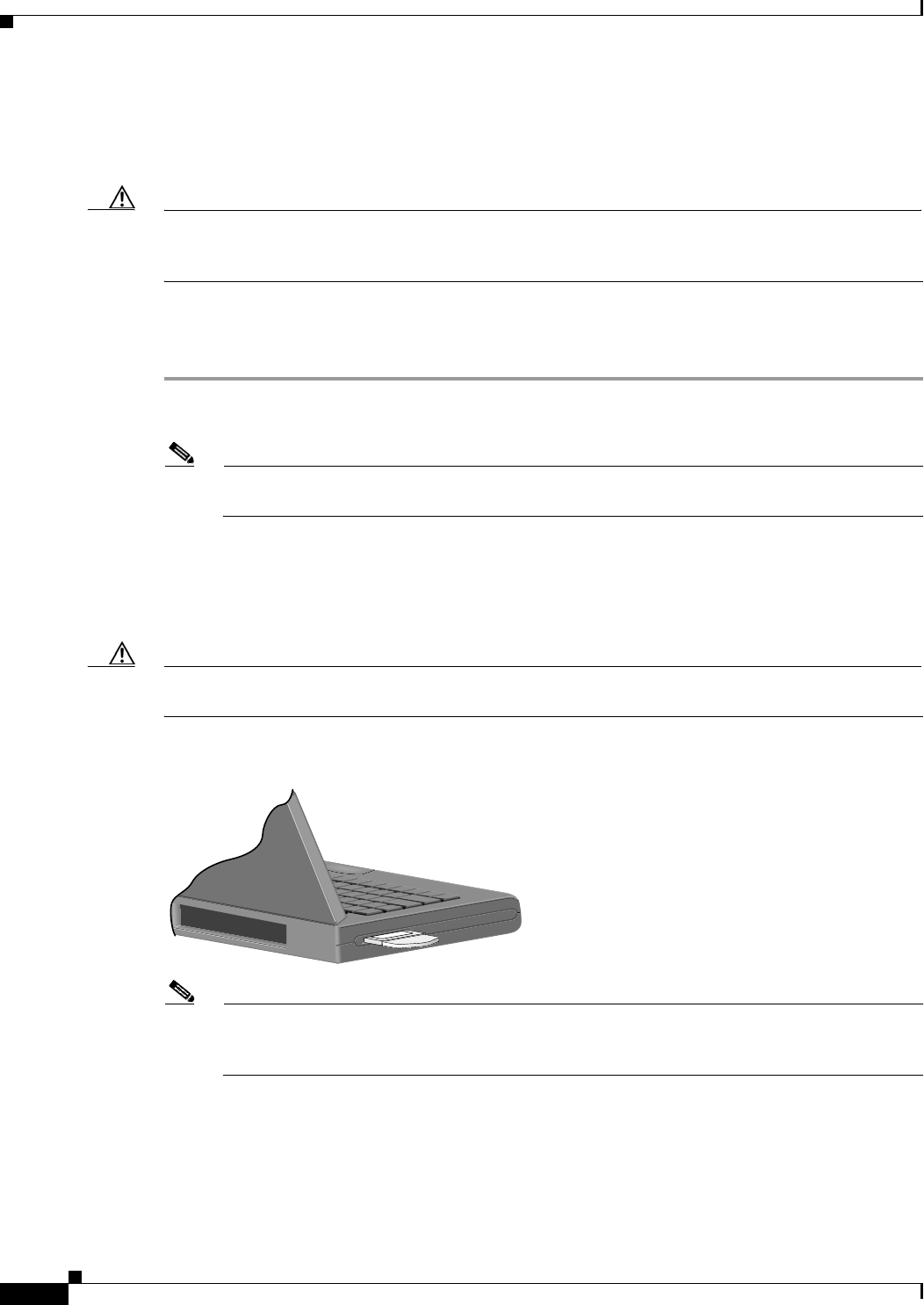
3-2
Cisco Aironet 802.11a/b/g Wireless LAN Client Adapters (CB21AG and PI21AG) Installation and Configuration Guide
OL-4211-05
Chapter 3 Installing the Client Adapter
Inserting a Client Adapter
Inserting a Client Adapter
This section provides instructions for inserting a PC-Cardbus card or PCI card into your computer.
Caution These procedures and the physical connections they describe apply generally to conventional Cardbus
slots and PCI expansion slots. In cases of custom or nonconventional equipment, be alert to possible
differences in Cardbus slot and PCI expansion slot configurations.
Inserting a PC-Cardbus Card
Step 1 Before you begin, examine the card. One end has a dual-row, 68-pin connector. The card is keyed so it
can be inserted only one way into the Cardbus slot.
Note The PC-Cardbus slot, if supported, is usually on the left or right side of a laptop computer,
depending on the model.
Step 2 Turn on your computer and let the operating system boot up completely.
Step 3 Hold the card with the Cisco label facing up and insert it into the Cardbus slot, applying just enough
pressure to make sure it is fully seated (see Figure 3-1). The green LED lights when the card is inserted
properly.
Caution Do not force the card into your computer’s Cardbus slot. Forcing it will damage both the card and the
slot. If the card does not insert easily, remove the card and reinsert it.
Figure 3-1 Inserting a PC-Cardbus Card into a Computer
Note The configuration profiles for PC-Cardbus cards are tied to the slot in which the card is inserted.
Therefore, you must always insert your PC-Cardbus card into the same slot or create profiles for
both slots. See Chapter 4 for information on creating profiles for your client adapter.
32617
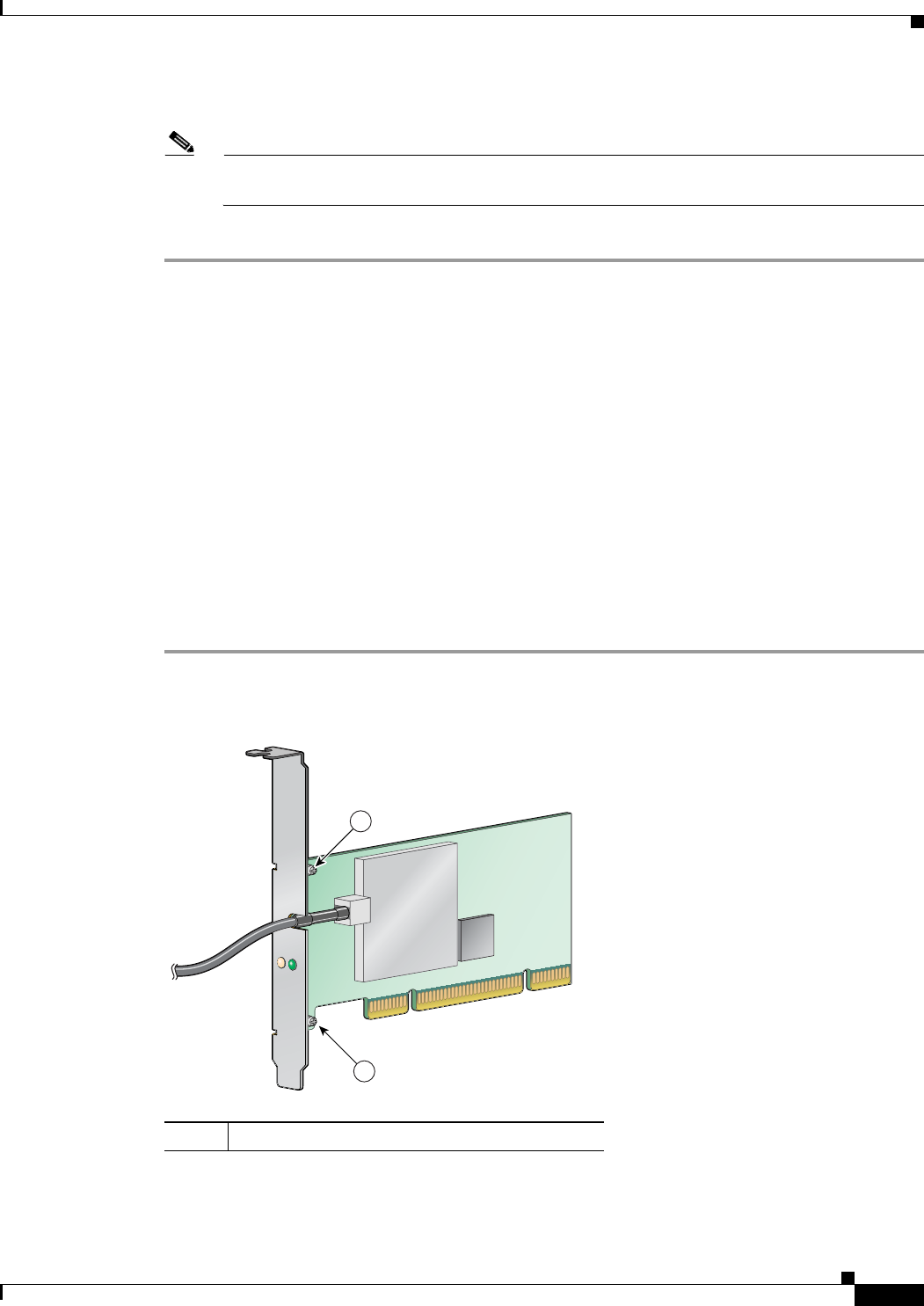
3-3
Cisco Aironet 802.11a/b/g Wireless LAN Client Adapters (CB21AG and PI21AG) Installation and Configuration Guide
OL-4211-05
Chapter 3 Installing the Client Adapter
Inserting a Client Adapter
Step 4 If the Found New Hardware Wizard window appears, click Cancel.
Note If you do not click Cancel, the wizard will attempt to install software for the client adapter but
will be unable to find it.
Step 5 Go to the “Installing the Client Adapter Software” section on page 3-9.
Inserting a PCI Card
You must perform the following procedures in the order listed below to insert a PCI card:
•Change the bracket (if required), see below
•Insert the card, page 3-4
•Assemble the antenna, page 3-5
•Mount the antenna, page 3-6
Changing the Bracket
The PCI card is shipped with a full-profile bracket attached. If the PC into which you are inserting the
PCI card requires the card to use a low-profile bracket, follow these steps to change brackets.
Step 1 Remove the two screws that attach the bracket to the card. See Figure 3-2.
Figure 3-2 Changing the PCI Card Bracket
95581
STATUS
ACTIVITY
1
1
1Bracket screws

3-4
Cisco Aironet 802.11a/b/g Wireless LAN Client Adapters (CB21AG and PI21AG) Installation and Configuration Guide
OL-4211-05
Chapter 3 Installing the Client Adapter
Inserting a Client Adapter
Step 2 Slide the bracket away from the card; then tilt the bracket to free the antenna cable.
Caution Do not pull on the antenna cable or detach it from the PCI card. The antenna is meant to be permanently
attached to the card.
Step 3 Hold the low-profile bracket to the card so that the LEDs slip through their corresponding holes on the
bracket.
Step 4 Insert the screws that you removed in Step 1 into the holes on the populated side of the card near the
bracket (see Figure 3-2) and tighten.
Inserting the Card
Follow the steps below to insert a PCI card into your PC.
Step 1 Turn off the PC and all its components.
Step 2 Remove the computer cover.
Note On most Pentium PCs, PCI expansion slots are white. Refer to your PC documentation for slot
identification.
Step 3 Remove the screw from the top of the CPU back panel above an empty PCI expansion slot. This screw
holds the metal bracket on the back panel.
Caution Static electricity can damage your PCI card. Before removing the card from the anti-static packaging,
discharge static by touching a metal part of a grounded PC.
Step 4 Locate an empty PCI expansion slot inside your computer.
Step 5 Slip your card’s antenna through the opening near the empty expansion slot so that it is located outside
of the computer. See Figure 3-3.
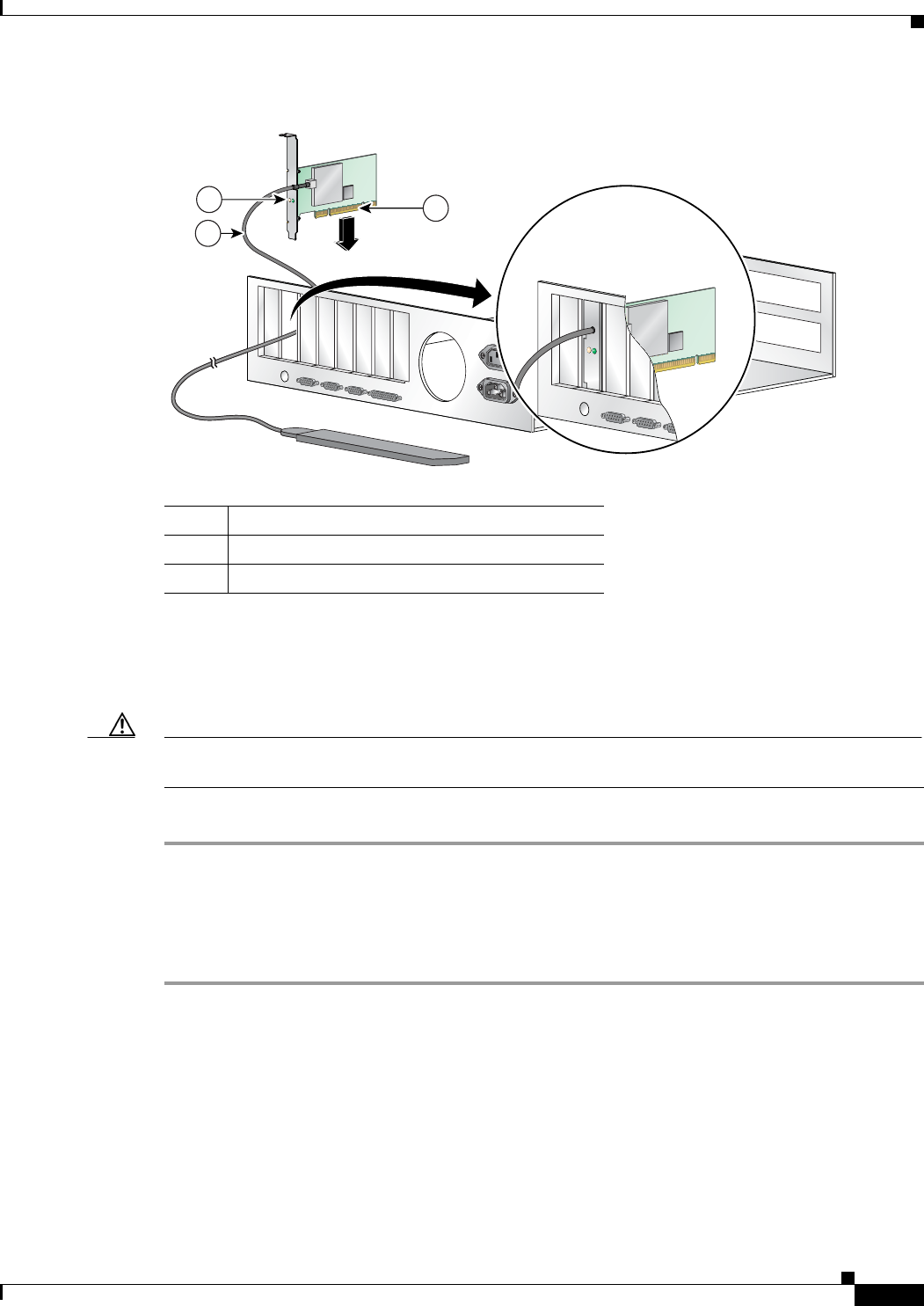
3-5
Cisco Aironet 802.11a/b/g Wireless LAN Client Adapters (CB21AG and PI21AG) Installation and Configuration Guide
OL-4211-05
Chapter 3 Installing the Client Adapter
Inserting a Client Adapter
Figure 3-3 Inserting a PCI Card into a PC
Step 6 Tilt the card to enable the LEDs to slip through the opening in the CPU back panel. See the enlarged
view in Figure 3-3.
Step 7 Press the card into the empty slot until its connector is firmly seated.
Caution Do not force the card into the expansion slot; this could damage both the card and the slot. If the card
does not insert easily, remove it and reinsert it.
Step 8 Reinstall the screw on the CPU back panel and replace the computer cover.
Assembling the Antenna
Follow the steps below to assemble the PCI card’s antenna.
Step 1 Slide the antenna through the opening in the bottom of the antenna base.
Step 2 Position the antenna so its notches are facing the Cisco label on the front of the base. See Figure 3-4.
STAT U S
ACTIVITY
95582
STATUS
ACTIVITY
2
1
3
1Antenna cable
2LEDs
3Card edge connector
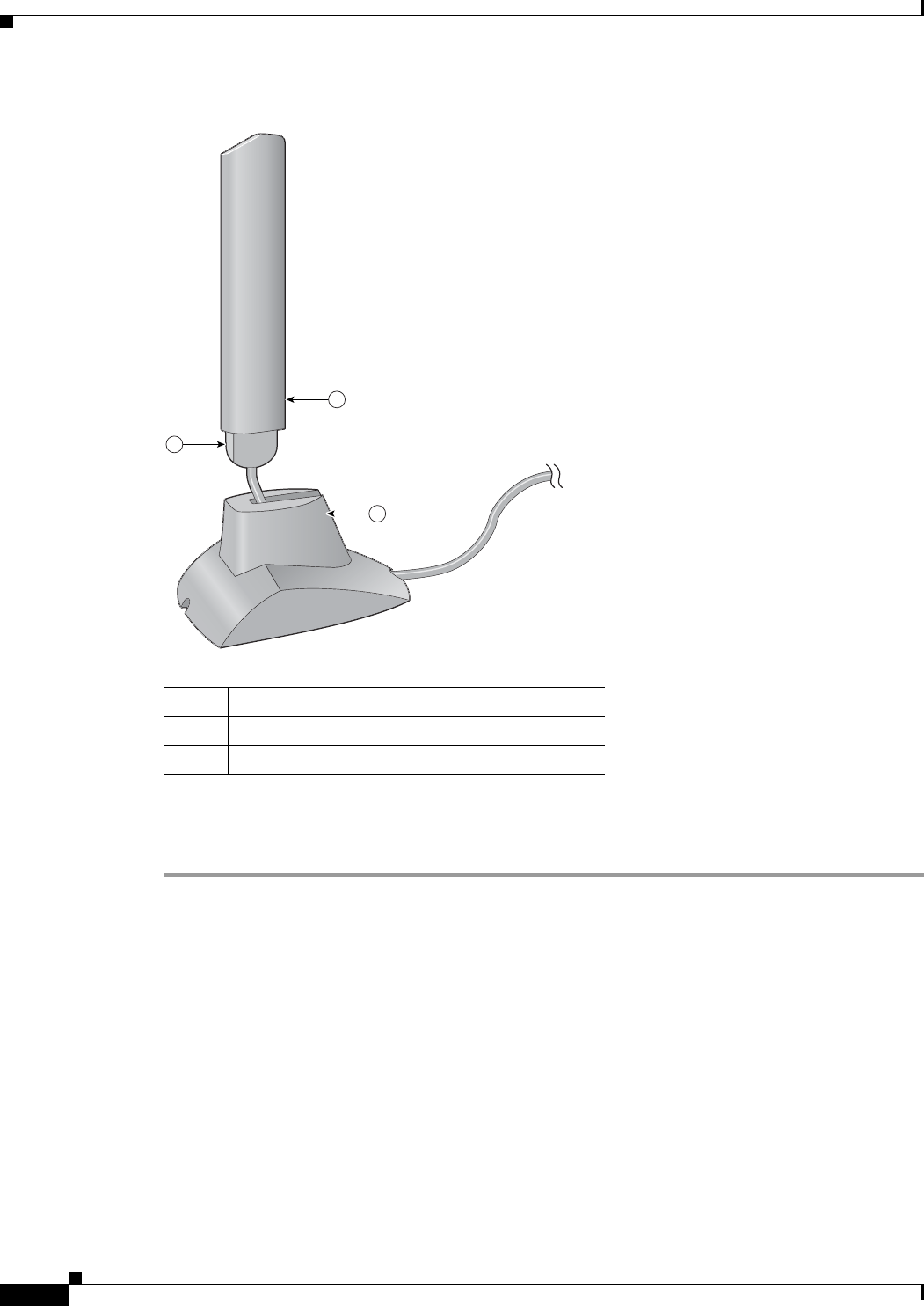
3-6
Cisco Aironet 802.11a/b/g Wireless LAN Client Adapters (CB21AG and PI21AG) Installation and Configuration Guide
OL-4211-05
Chapter 3 Installing the Client Adapter
Inserting a Client Adapter
Figure 3-4 Inserting the Antenna into Its Base
Step 3 Press the antenna cable into the receptacle on the top of the base as shown in Figure 3-4.
Step 4 Press the antenna straight down into the receptacle until it clicks into place.
Mounting the Antenna
Because the PCI card is a radio device, it is susceptible to RF obstructions and common sources of
interference that can reduce throughput and range. Follow these guidelines to ensure the best possible
performance:
•Place the PCI card’s antenna in an area where large steel structures such as shelving units,
bookcases, and filing cabinets will not obstruct radio signals being transmitted or received.
•Place the antenna away from microwave ovens and 2.4- and 5.8-GHz cordless phones. These
products can cause signal interference because they operate in the same frequency range as the PCI
card.
95584
2
1
3
1Antenna
2Notch
3Antenna base
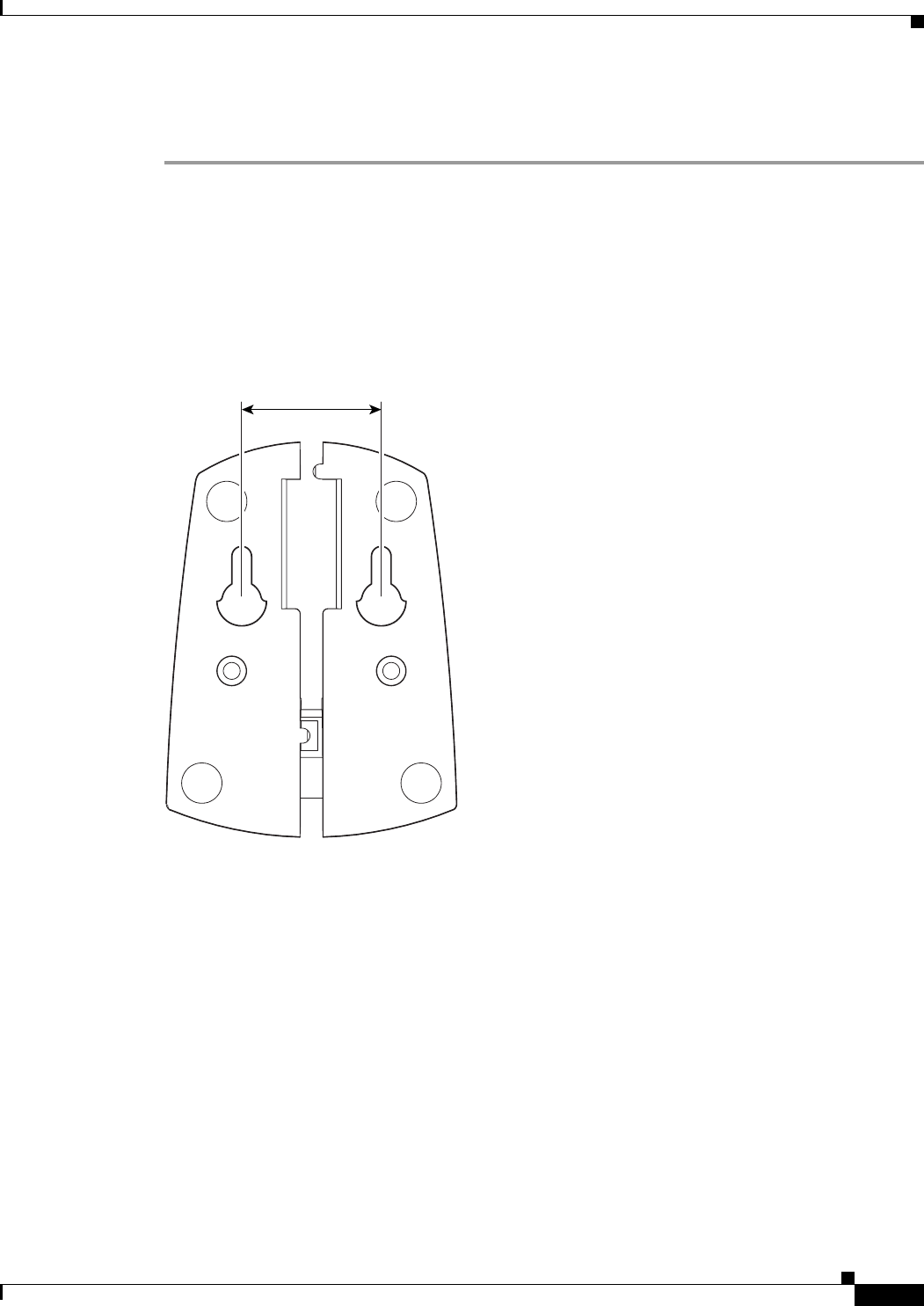
3-7
Cisco Aironet 802.11a/b/g Wireless LAN Client Adapters (CB21AG and PI21AG) Installation and Configuration Guide
OL-4211-05
Chapter 3 Installing the Client Adapter
Inserting a Client Adapter
Follow the steps below to position the PCI card’s antenna on a flat horizontal surface or to mount it to a
wall.
Step 1 Perform one of the following:
•If you want to use the antenna on a flat horizontal surface, position the antenna so it is pointing
straight up. Then go to Step 7.
•If you want to mount the antenna to a wall, go to Step 2.
Step 2 Drill two holes in the wall that are 1.09 in. (2.8 cm) apart. Figure 3-5 shows the distance between the
mounting holes on the bottom of the antenna base.
Figure 3-5 Bottom of Antenna Base
Step 3 Tap the two supplied wall anchors into the holes.
Step 4 Drive the two supplied screws into the wall anchors, leaving a small gap between the screw head and the
anchor.
Step 5 Position the mounting holes on the bottom of the antenna base over the screws (see Figure 3-6) and pull
down to lock in place.
95597
1.09 inches
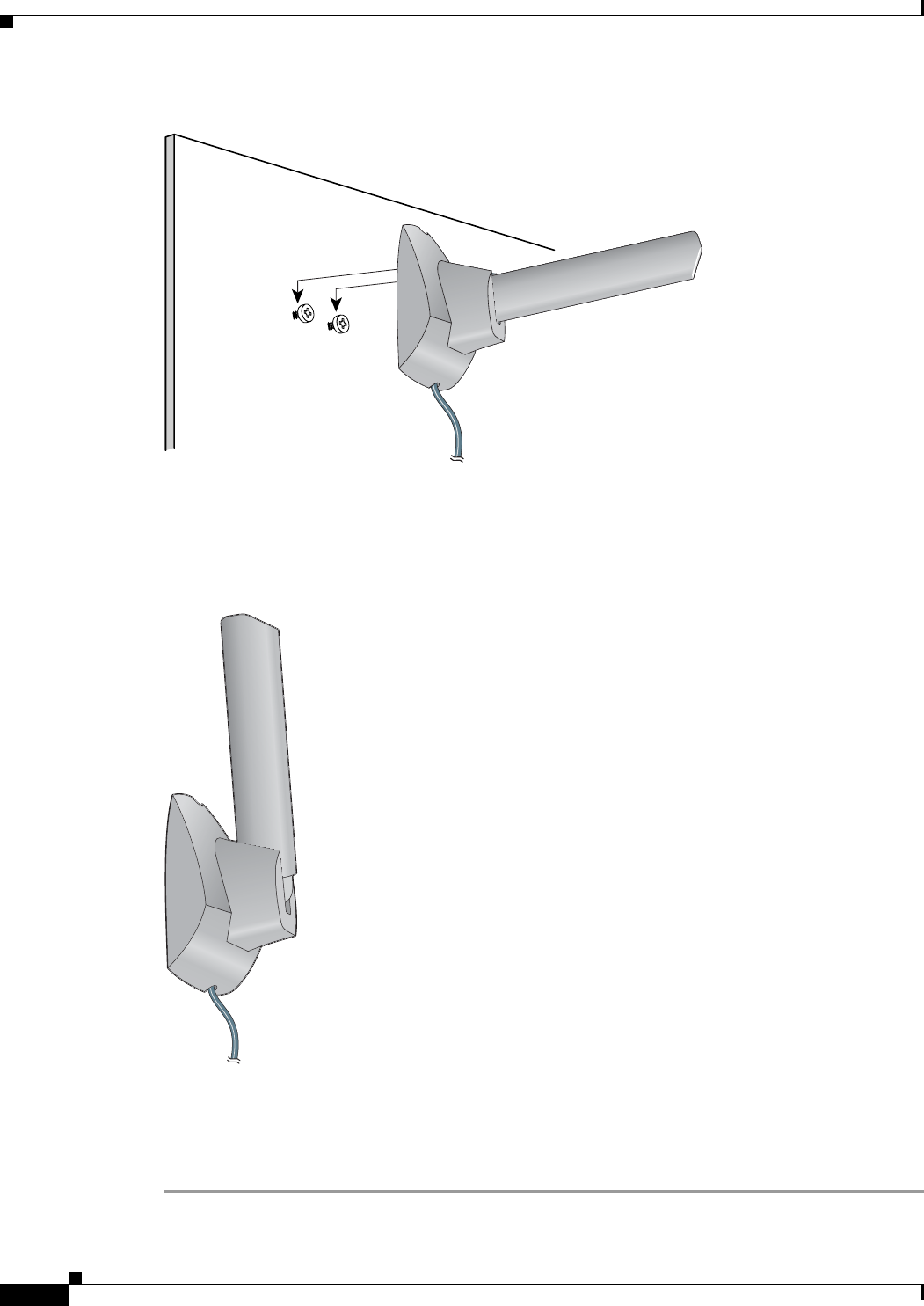
3-8
Cisco Aironet 802.11a/b/g Wireless LAN Client Adapters (CB21AG and PI21AG) Installation and Configuration Guide
OL-4211-05
Chapter 3 Installing the Client Adapter
Inserting a Client Adapter
Figure 3-6 Mounting the Antenna
Step 6 The antenna rotates 90 degrees from its base. For optimal reception, position the antenna so it is pointing
straight up (see Figure 3-7).
Figure 3-7 Rotating the Antenna
Step 7 Boot up your PC. The green LED lights when the card is inserted properly.
Step 8 If the Found New Hardware Wizard window appears, click Cancel.
Step 9 Go to the “Installing the Client Adapter Software” section below.
95595
95596

3-9
Cisco Aironet 802.11a/b/g Wireless LAN Client Adapters (CB21AG and PI21AG) Installation and Configuration Guide
OL-4211-05
Chapter 3 Installing the Client Adapter
Installing the Client Adapter Software
Installing the Client Adapter Software
This section describes how to install Cisco Aironet CB21AG or PI21AG client adapter driver and
utilities from a single executable file named WinClient-802.11a-b-g-Ins-Wizard-vx.exe, where x
represents the release number. Follow these steps to install these client adapter software components on
a computer running Windows 2000 or XP.
Caution Cisco Aironet CB21AG and PI21AG client adapter software is incompatible with other Cisco Aironet
client adapter software. The Aironet Desktop Utility (ADU) must be used with CB21AG and PI21AG
cards, and the Aironet Client Utility (ACU) must be used with all other Cisco Aironet client adapters.
Caution Do not eject your client adapter at any time during the installation process, including during the reboot.
Note This procedure is meant to be used the first time the Cisco Aironet CB21AG or PI21AG client adapter
software is installed on your computer. If this software is already installed on your computer, follow the
instructions in Chapter 9 to upgrade the client adapter software.
Note Only one CB21AG or PI21AG client adapter can be installed and used at a time. The software does not
support the use of multiple CB21AG or PI21AG cards.
Step 1 Make sure the client adapter is inserted into your computer.
Step 2 Make sure that you have a Cisco Connection Online (CCO) username and password.
Step 3 If you do not have a CCO username and password, go to Cisco’s main page (http://www.cisco.com) and
click Register (top). Then, follow the instructions to create a CCO username and password.
Step 4 Browse to the following location:
http://www.cisco.com/public/sw-center/
Step 5 Click Wireless Software.
Step 6 Click Wireless LAN Access.
Step 7 Click Cisco Wireless LAN Client Adapters.
Step 8 Click Cisco Aironet Wireless LAN Client Adapters.
Step 9 Perform one of the following steps:
•If you are using a PC-Cardbus card, click Cisco Aironet 802.11a/b/g CardBus Wireless LAN
Client Adapter (CB21AG).
•If you are using a PCI card, click Cisco Aironet 802.11a/b/g PCI Wireless LAN Client Adapter
(PI21AG).
Step 10 When prompted, enter your CCO username and password, and click OK.
Step 11 Click Aironet Client Installation Wizard (Firmware, Driver, Utility).
Step 12 Click Windows 2000 or Windows XP.
Step 13 Click the link with the greatest release number.
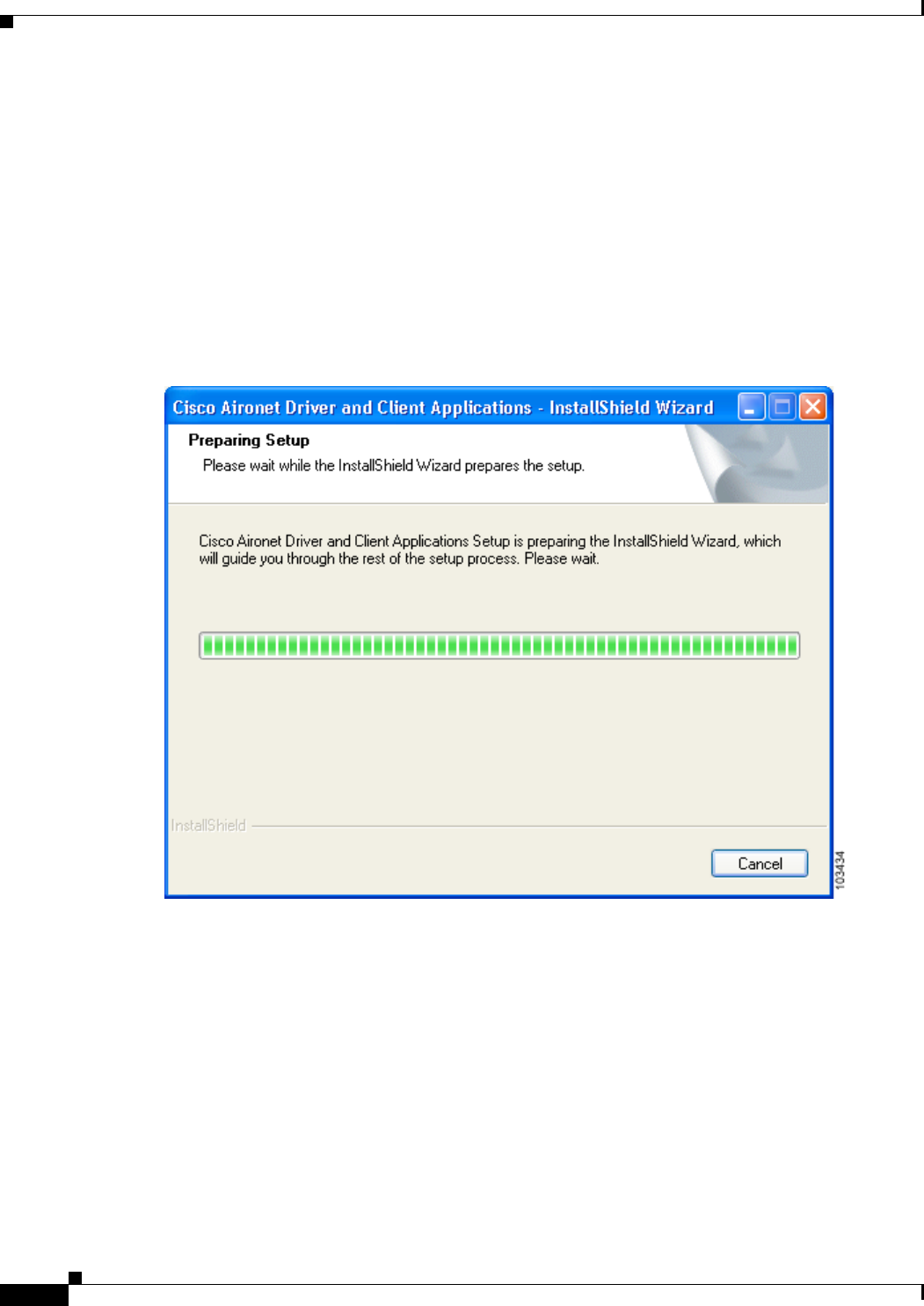
3-10
Cisco Aironet 802.11a/b/g Wireless LAN Client Adapters (CB21AG and PI21AG) Installation and Configuration Guide
OL-4211-05
Chapter 3 Installing the Client Adapter
Installing the Client Adapter Software
Step 14 Click the Install Wizard file (WinClient-802.11a-b-g-Ins-Wizard-vxx.exe), where xx is the version
number.
Step 15 If prompted, enter your CCO username and password, and click OK.
Step 16 Complete the encryption authorization form, read and accept the terms and conditions of the Software
License Agreement, select the file again to download it, and save the file on your computer’s Desktop.
Step 17 Use Windows Explorer to find the installer.
Step 18 Double-click the installer. The “Starting InstallShield Wizard” message appears followed by the
Preparing Setup window (see Figure 3-8) and the Cisco Aironet Installation Program window (see
Figure 3-9).
Figure 3-8 Preparing Setup Window
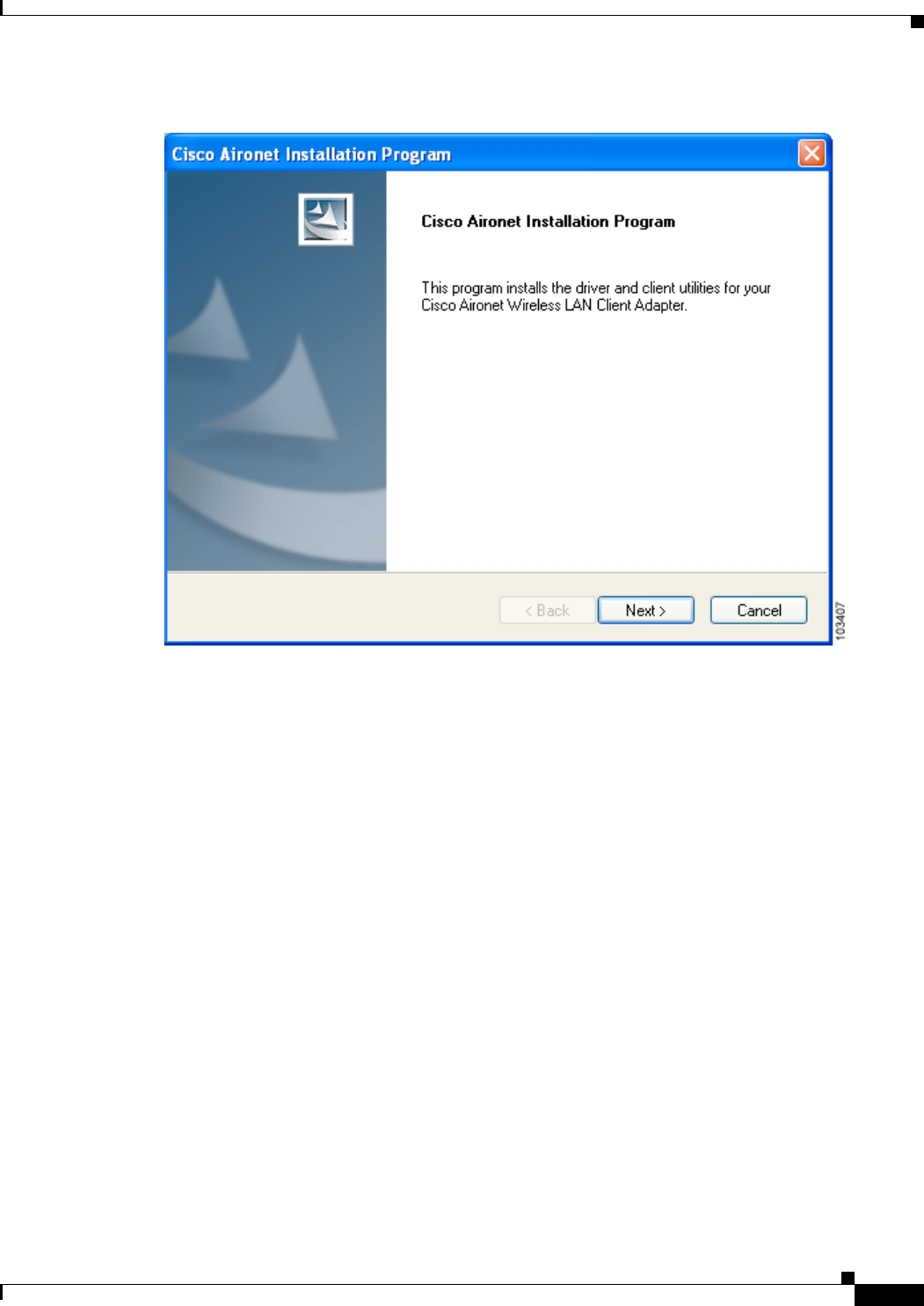
3-11
Cisco Aironet 802.11a/b/g Wireless LAN Client Adapters (CB21AG and PI21AG) Installation and Configuration Guide
OL-4211-05
Chapter 3 Installing the Client Adapter
Installing the Client Adapter Software
Figure 3-9 Cisco Aironet Installation Program Window
Step 19 Click Next. The Setup Type window appears (see Figure 3-10).
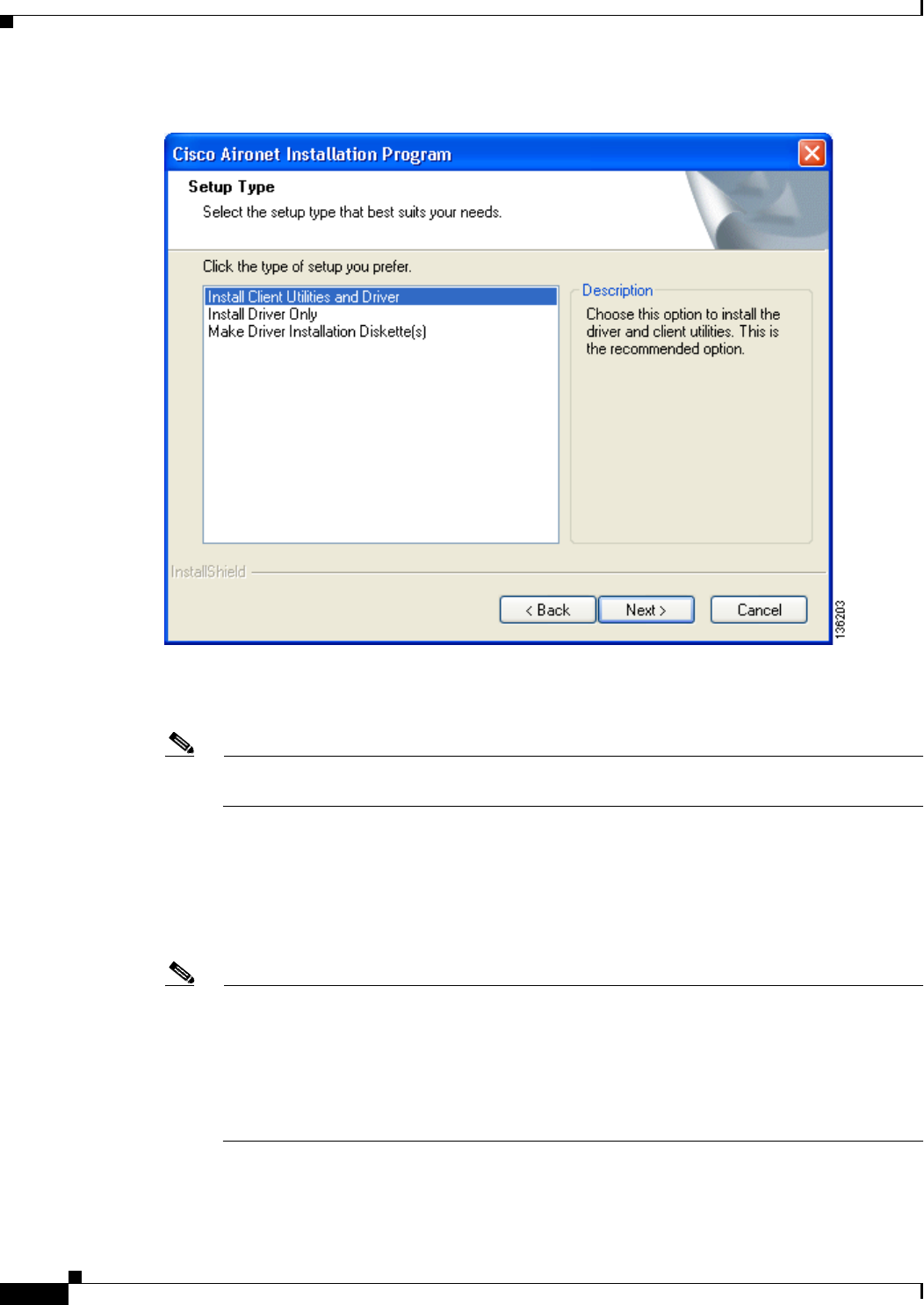
3-12
Cisco Aironet 802.11a/b/g Wireless LAN Client Adapters (CB21AG and PI21AG) Installation and Configuration Guide
OL-4211-05
Chapter 3 Installing the Client Adapter
Installing the Client Adapter Software
Figure 3-10 Setup Type Window
Step 20 Choose one of the following options and click Next:
Note To ensure compatibility among software components, Cisco recommends that you install the
client utilities and driver.
•Install Client Utilities and Driver—Installs the client adapter driver and client utilities.
•Install Driver Only—Installs only the client adapter driver. If you choose this option, click Next
and go to Step 32.
•Make Driver Installation Diskette(s)—Enables you to create driver installation diskettes that can
be used to install drivers using the Windows Device Manager.
Note If you choose one of the first two options and a client adapter is not inserted into your computer,
the following message appears: “The device may not be present or could have been
ejected/unplugged from the system. Insert or reinsert it now.” Insert the client adapter and click
OK. If you proceed without the client adapter inserted, the installation continues, but the driver
installation is incomplete. You must manually install the driver later using the Update Device
Driver Wizard. See the “Manually Installing or Upgrading the Client Adapter Driver” section on
page 9-6 for instructions.
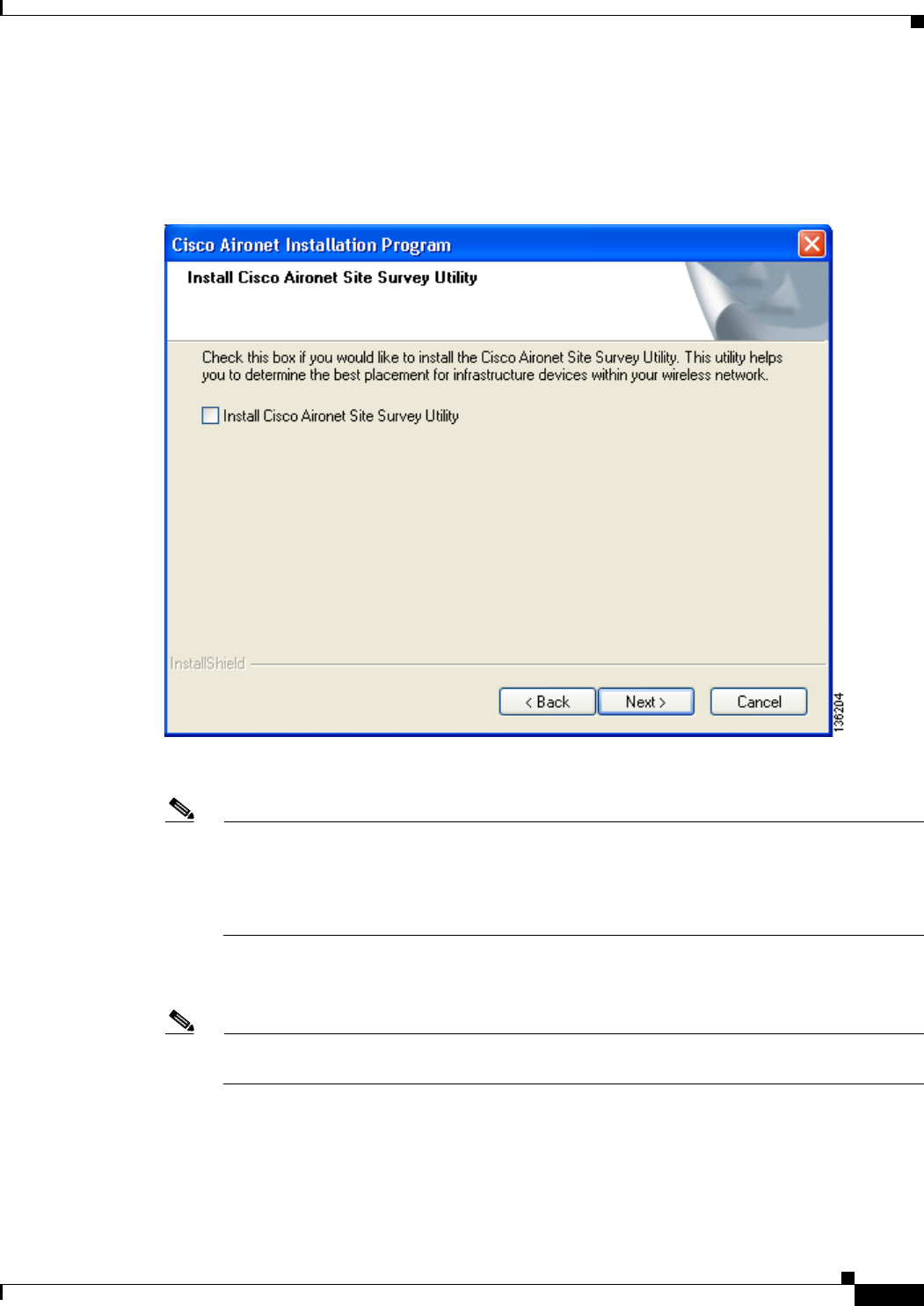
3-13
Cisco Aironet 802.11a/b/g Wireless LAN Client Adapters (CB21AG and PI21AG) Installation and Configuration Guide
OL-4211-05
Chapter 3 Installing the Client Adapter
Installing the Client Adapter Software
Step 21 When the Install Cisco Aironet Site Survey Utility window appears (see Figure 3-11), check the Install
Cisco Aironet Site Survey Utility check box if you want to install a utility that helps you to determine
the best placement of infrastructure devices within your wireless network. Click Next.
Figure 3-11 Install Cisco Aironet Site Survey Utility Window
Note The site survey utility is a stand-alone application, separate from ADU, that runs from an
executable file. If you check the Install Cisco Aironet Site Survey Utility check box, the Install
Wizard installs the site survey executable file in the C:\Program Files\Cisco Aironet directory
(unless you specify a different directory in Step 23). See Appendix F for instructions on using
the utility.
Step 22 If a message appears indicating that you are required to restart your computer at the end of the
installation process, click Ye s .
Note If you click No, you are asked to confirm your decision. If you proceed, the installation process
terminates.
The Choose Destination Location window appears (see Figure 3-12).
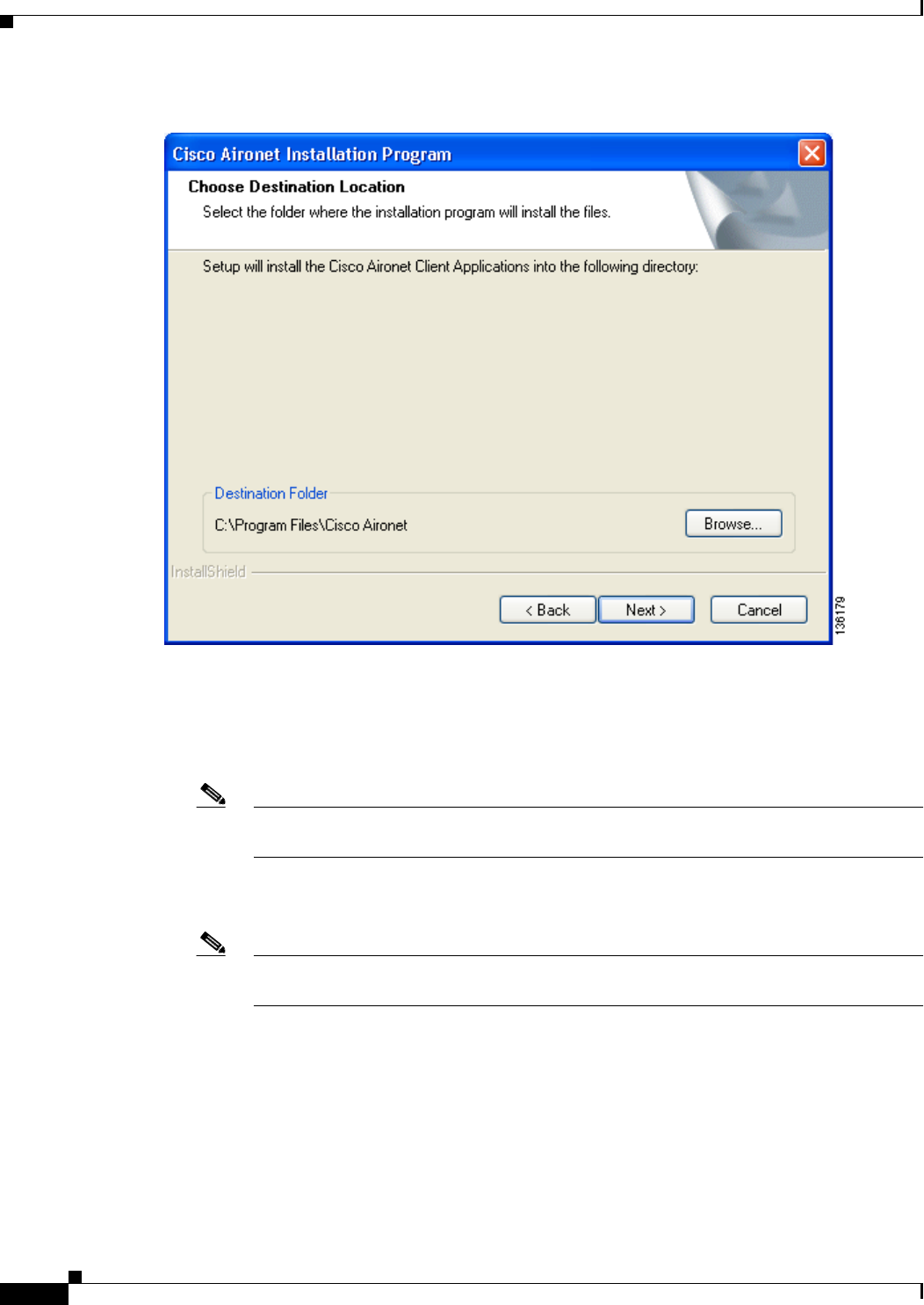
3-14
Cisco Aironet 802.11a/b/g Wireless LAN Client Adapters (CB21AG and PI21AG) Installation and Configuration Guide
OL-4211-05
Chapter 3 Installing the Client Adapter
Installing the Client Adapter Software
Figure 3-12 Choose Destination Location Window
Step 23 Perform one of the following:
•If you chose the first option in Step 20, click Next to install the client utility files in the C:\Program
Files\Cisco Aironet directory.
Note If you want to install the client utilities in a different directory, click Browse, choose a
different directory, click OK, and click Next.
•If you chose the Make Driver Installation Diskette(s) option in Step 20, insert a floppy disk into your
computer and click Next to copy the driver to the diskette. Go to Step 32.
Note If you want to copy the driver to a different drive or directory, click Browse, choose a new
location, click OK, and click Next.
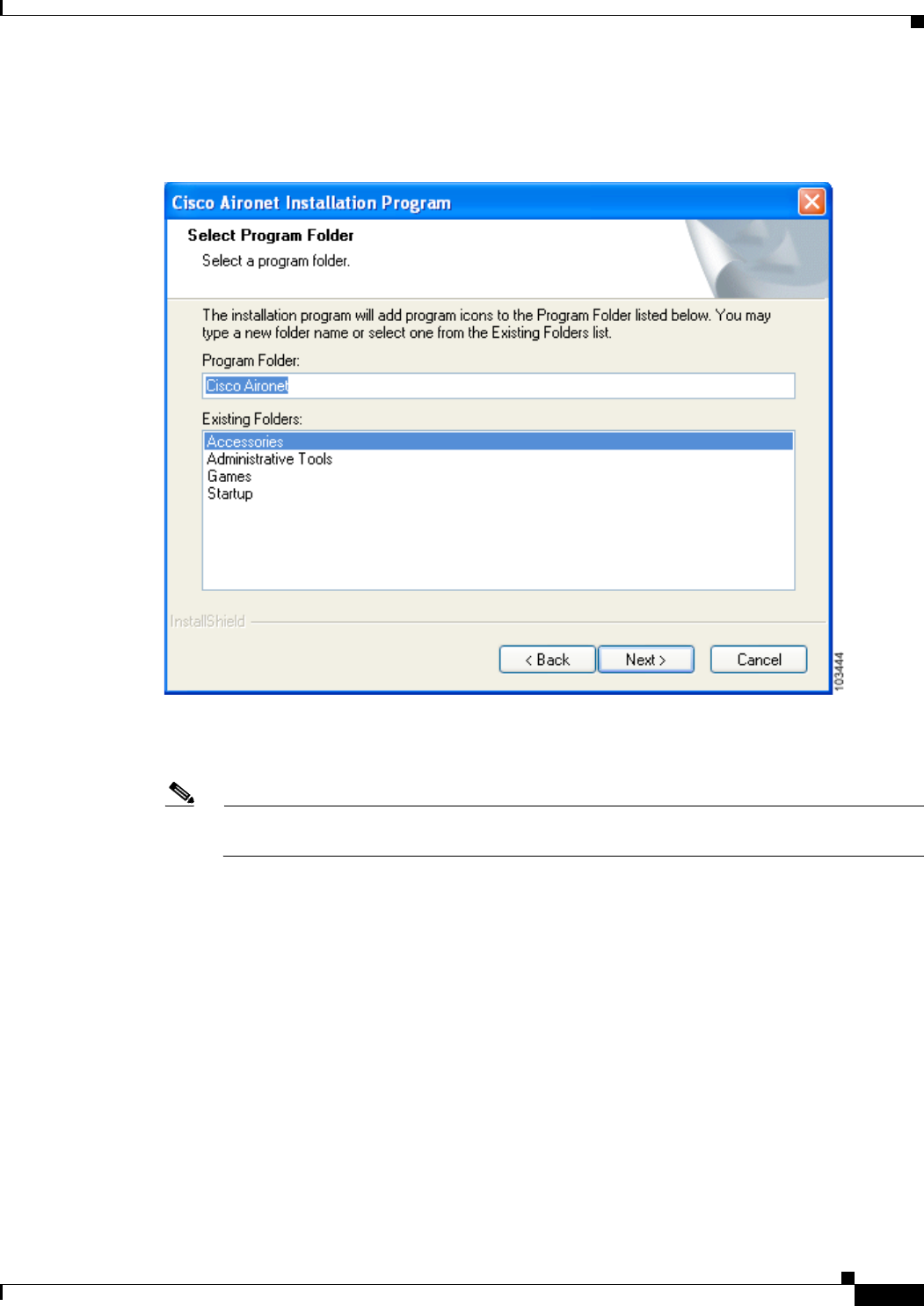
3-15
Cisco Aironet 802.11a/b/g Wireless LAN Client Adapters (CB21AG and PI21AG) Installation and Configuration Guide
OL-4211-05
Chapter 3 Installing the Client Adapter
Installing the Client Adapter Software
Step 24 The Select Program Folder window appears (see Figure 3-13).
Figure 3-13 Select Program Folder Window
Step 25 Click Next to add program icons to the Cisco Aironet program folder.
Note If you want to specify a different program folder, choose a folder from the Existing Folders list
or type a new folder name in the Program Folder field and click Next.
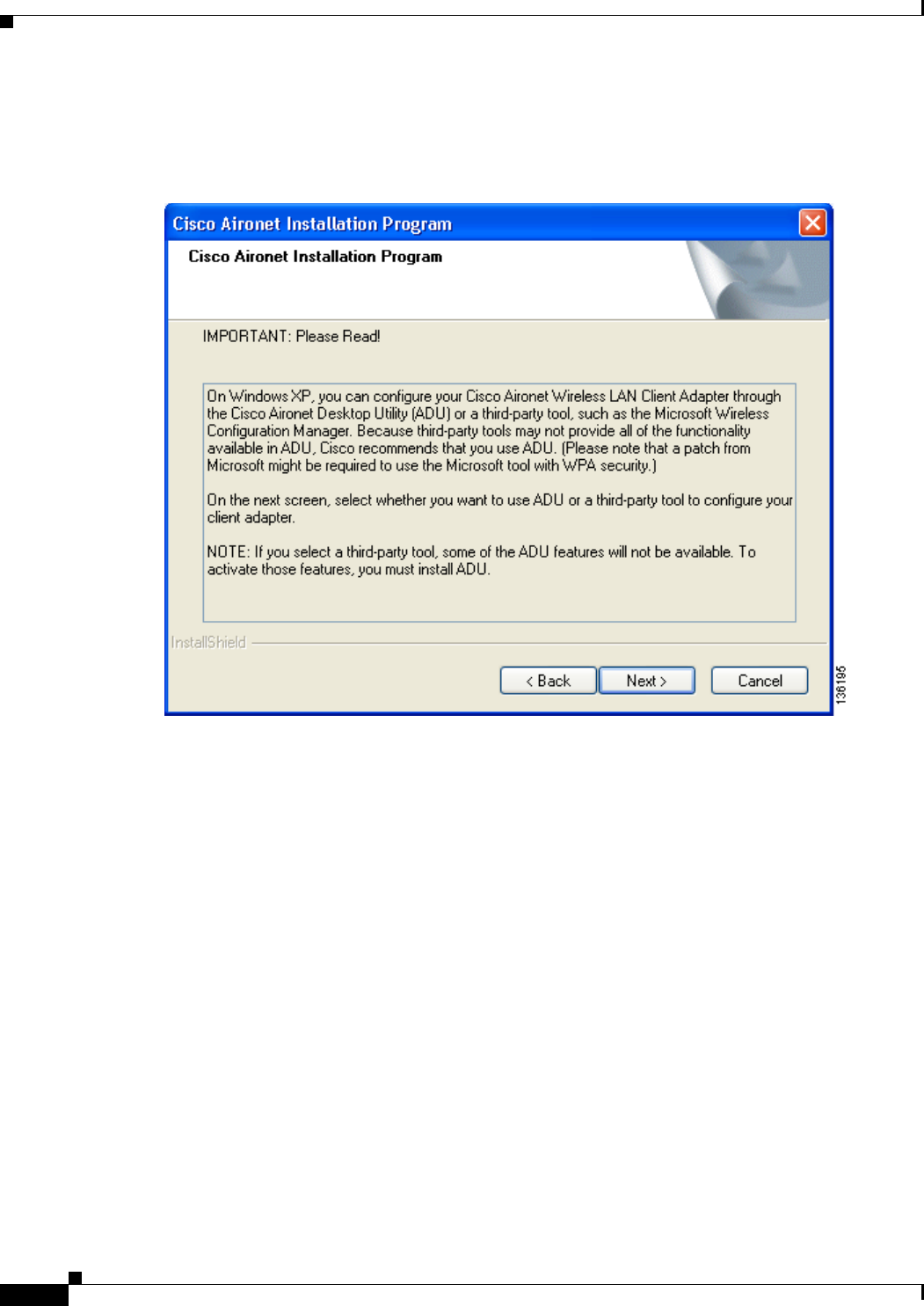
3-16
Cisco Aironet 802.11a/b/g Wireless LAN Client Adapters (CB21AG and PI21AG) Installation and Configuration Guide
OL-4211-05
Chapter 3 Installing the Client Adapter
Installing the Client Adapter Software
Step 26 If your computer is running Windows 2000, go to Step 32. If your computer is running Windows XP, the
window titled IMPORTANT: Please Read! appears (see Figure 3-14).
Figure 3-14 IMPORTANT: Please Read! Window
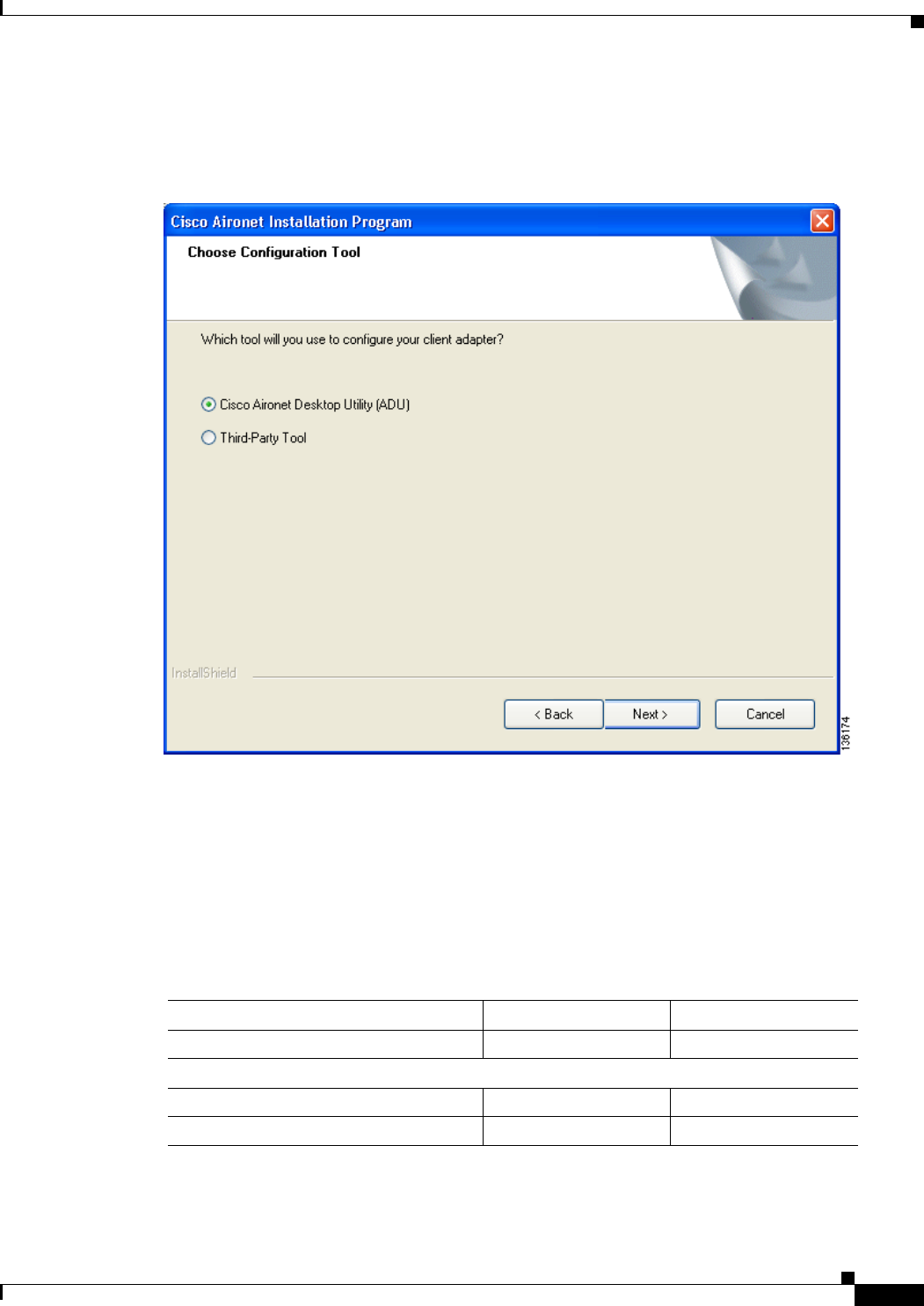
3-17
Cisco Aironet 802.11a/b/g Wireless LAN Client Adapters (CB21AG and PI21AG) Installation and Configuration Guide
OL-4211-05
Chapter 3 Installing the Client Adapter
Installing the Client Adapter Software
Step 27 Read the information displayed and click Next. The Choose Configuration Tool window appears (see
Figure 3-15).
Figure 3-15 Choose Configuration Tool Window
Step 28 Choose one of the following options:
•Cisco Aironet Desktop Utility (ADU)—Enables you to configure your client adapter using ADU.
•Third-Party Tool—Enables you to configure your client adapter using a third-party tool such as the
Microsoft Wireless Configuration Manager in Windows XP.
Table 3-1 compares Windows XP and ADU client adapter features.
Table 3-1 Comparison of Windows XP and ADU Client Adapter Features
Feature Windows XP ADU
Configuration parameters Limited Extensive
Capabilities
Create profiles Yes Yes
Enable/disable radio No Yes
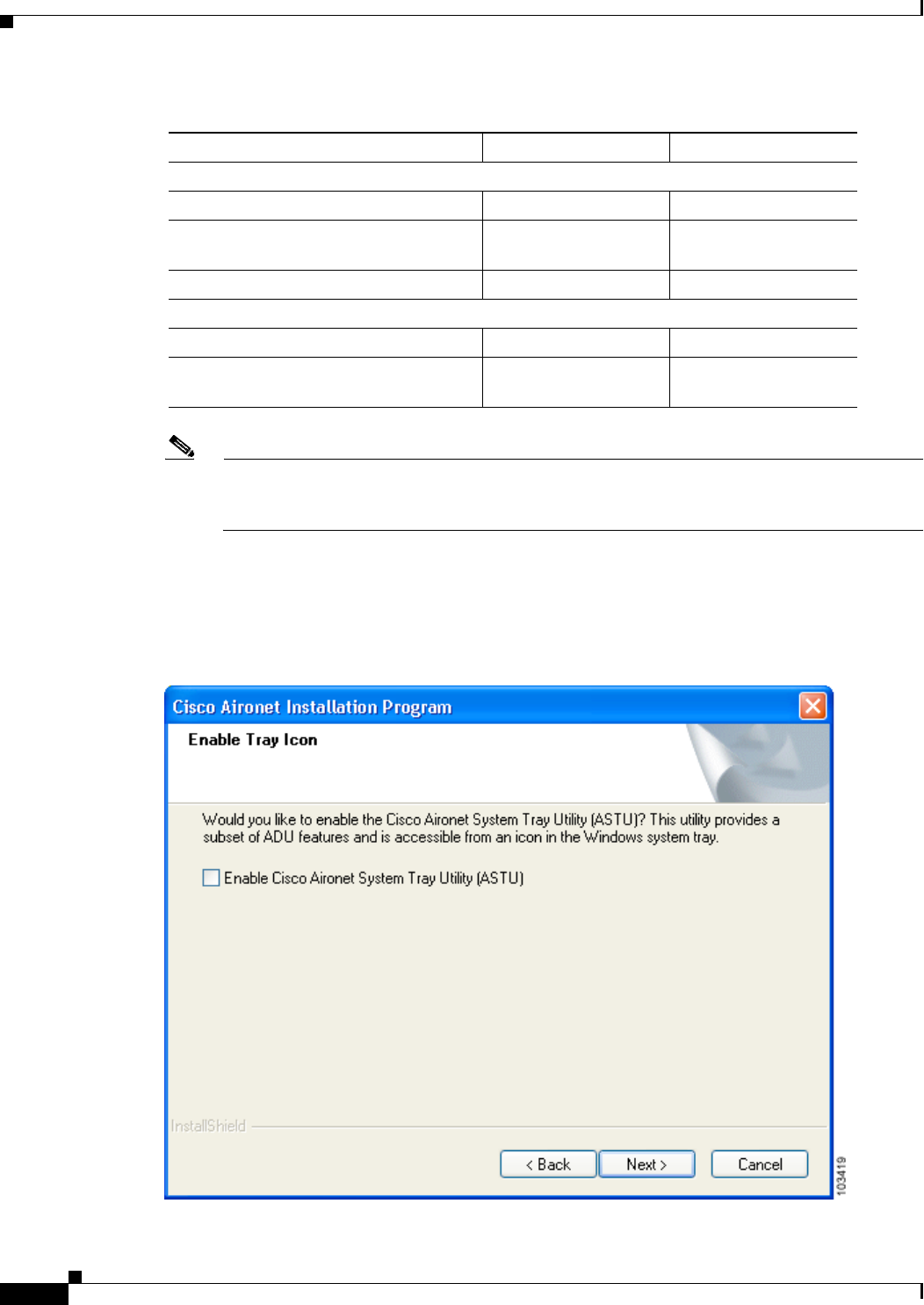
3-18
Cisco Aironet 802.11a/b/g Wireless LAN Client Adapters (CB21AG and PI21AG) Installation and Configuration Guide
OL-4211-05
Chapter 3 Installing the Client Adapter
Installing the Client Adapter Software
Note If you choose Cisco Aironet Desktop Utility (ADU) above, the Microsoft Wireless
Configuration Manager is disabled. If you ever manually enable it, you are prompted to disable
it whenever ADU is activated.
Step 29 Click Next.
Step 30 If you chose Cisco Aironet Desktop Utility (ADU) in Step 28, go to Step 32. If you chose Third-Party
Tool, the Enable Tray Icon window appears (see Figure 3-16).
Figure 3-16 Enable Tray Icon Window
Security
Static WEP Yes Yes
LEAP or EAP-FAST authentication
with dynamic WEP
No Yes
EAP-TLS or PEAP authentication Yes Yes
Status and statistics
Status window Limited Extensive
Statistics window (transmit &
receive)
No Yes
Table 3-1 Comparison of Windows XP and ADU Client Adapter Features (continued)
Feature Windows XP ADU
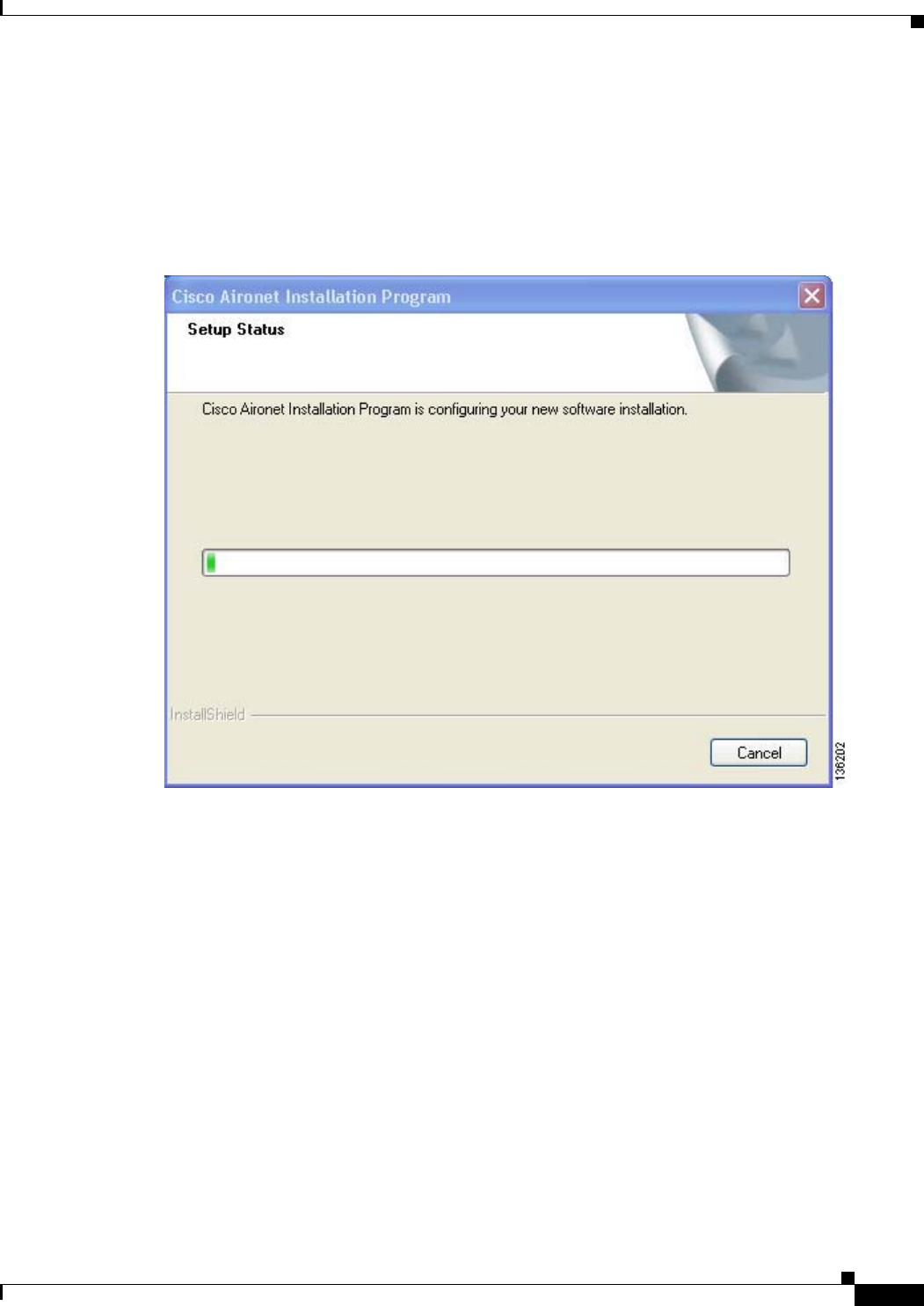
3-19
Cisco Aironet 802.11a/b/g Wireless LAN Client Adapters (CB21AG and PI21AG) Installation and Configuration Guide
OL-4211-05
Chapter 3 Installing the Client Adapter
Installing the Client Adapter Software
Step 31 Check the Enable Cisco Aironet System Tray Utility (ASTU) check box if you want to be able to use
ASTU even though you have chosen to configure your client adapter through a third-party tool instead
of ADU and click Next.
Step 32 When prompted to insert your client adapter, click OK. The Setup Status window appears (see
Figure 3-17).
Figure 3-17 Setup Status Window
The installation process begins, and you are notified as each software component is installed.
Step 33 When a message appears indicating that your computer needs to be rebooted, click OK and allow your
computer to restart.
Step 34 If the Windows Found New Hardware Wizard appears after your computer reboots, click Next, allow the
wizard to install the software for the client adapter, and click Finish.
Step 35 If your network setup does not include a DHCP server and you plan to use TCP/IP, follow these steps
for your operating system.
•Windows 2000
a. Double-click My Computer,Control Panel, and Network and Dial-up Connections.
b. Right-click Local Area Connection x (where x represents the number of the connection).
c. Click Properties.
d. In the Components Checked Are Used by This Connection field, click Internet Protocol
(TCP/IP) and Properties.

3-20
Cisco Aironet 802.11a/b/g Wireless LAN Client Adapters (CB21AG and PI21AG) Installation and Configuration Guide
OL-4211-05
Chapter 3 Installing the Client Adapter
Installing the Intermediate Driver Manually
e. Choose Use the following IP address and enter the IP address, subnet mask, and default gateway
address of your computer (which can be obtained from your system administrator).
f. Click OK to close each open window.
•Windows XP
a. Double-click My Computer,Control Panel, and Network Connections.
b. Right-click Wireless Network Connection x (where x represents the number of the connection).
c. Click Properties.
d. In the This Connection Uses the Following Items field, click Internet Protocol (TCP/IP) and
Properties.
e. Choose Use the following IP address and enter the IP address, subnet mask, and default gateway
address of your computer (which can be obtained from your system administrator).
f. Click OK to close each open window.
Step 36 If you are prompted to restart your computer, click Ye s .
Step 37 Now that your client adapter is properly installed, it is ready to be configured.
•If you are planning to configure your client adapter through ADU, go to Chapter 4 to create
configuration profiles.
•If you are planning to configure your client adapter through the Windows XP Wireless Configuration
Manager, go to Appendix E.
•If you are planning to configure your client adapter through another third-party tool, refer to the
documentation for that application.
Note If you want to be able to use ADU’s Group Policy Delay parameter, follow the instructions below to
download and install a necessary hot fix before configuring your client adapter.
Note If you experienced problems during or after installation, refer to Chapter 10 for troubleshooting
information.
Installing the Intermediate Driver Manually
In some instances, the installation of the CB21AG software might not work as expected because the
intermediate driver might not have installed correctly. In this situation, the installer might not detect this
condition, and the rest of the software will not function correctly.
The CB21AG intermediate driver must be installed manually. To install the intermediate driver manually,
follow these steps:
Step 1 Insert the client adapter.
Step 2 Click on "Network Connections" in the Start > Settings menu in Windows XP, or right click on "My
Network Places" in Windows 2000. Find the CB21AGg instance.

3-21
Cisco Aironet 802.11a/b/g Wireless LAN Client Adapters (CB21AG and PI21AG) Installation and Configuration Guide
OL-4211-05
Chapter 3 Installing the Client Adapter
Installing a Microsoft Hot Fix for Group Policy Delay
Step 3 Right click on the Cisco CB21AG instance, and left click on Properties.
Step 4 Choose the "Install" option and then add a new service.
Step 5 Choose the "Have disk" button. Go to \windows\system32 directory and choose wsimd.inf.
Step 6 Highlight and select "Wireless Intermediate Driver" and click "ok" button. The wireless IMD is bound
to the adapter.
Step 7 Reboot system.
Installing a Microsoft Hot Fix for Group Policy Delay
If you want to use the Group Policy Delay parameter on the Profile Management (Security) window in
ADU, you must install a Microsoft hot fix on computers running Windows 2000. The hot fix is
incorporated into Windows XP Service Pack 2 and later.
The Group Policy Delay parameter enables you to specify how much time elapses before the Windows
logon process starts Group Policy, a Windows feature used by administrators to specify configuration
options for groups of users. The objective is to delay the start of Group Policy until wireless network
authentication occurs. Follow the steps below to obtain and install the hot fix.
Note You must be a registered Cisco customer and log into Cisco.com in order to download the hot fix. If you
are unable to access the hot fix from Cisco.com, contact Microsoft Support to obtain it. The Windows
2000 support page provides the contact information:
http://support.microsoft.com/default.aspx?scid=fh;EN-US;win2000
Step 1 Use your computer’s web browser to access the following URL:
http://www.cisco.com/cgi-bin/tablebuild.pl/aironet_hotfix
Step 2 If prompted, enter your Cisco Connection Online (CCO) username and password, and click OK.
Note To create a CCO username and password, visit http://www.cisco.com.
Step 3 Click the hot fix file (userenv.zip).
Step 4 Complete the encryption authorization form and click Submit.
Step 5 Click the file again to download it.
Step 6 Save the file to your computer’s hard drive.
Step 7 Find the file using Windows Explorer, double-click it, and extract its files to a folder.
Step 8 Reboot your computer and press F8 while your computer is booting.
Step 9 When the boot menu appears, select Safe Mode with Command Prompt.
Note You must complete this procedure in safe mode; otherwise, system file protection (SFP) will
silently restore the original version of the file you are replacing.

3-22
Cisco Aironet 802.11a/b/g Wireless LAN Client Adapters (CB21AG and PI21AG) Installation and Configuration Guide
OL-4211-05
Chapter 3 Installing the Client Adapter
Installing a Microsoft Hot Fix for Group Policy Delay
Step 10 Copy the hot fix file (userenv.dll) to %systemroot%\System32 and overwrite the existing version of this
file.
Step 11 Delete the copy of userenv.dll in %systemroot%\System32\DllCache.
Step 12 Reboot your computer.

CHAPTER
4-1
Cisco Aironet 802.11a/b/g Wireless LAN Client Adapters (CB21AG and PI21AG) Installation and Configuration Guide
OL-4211-05
4
Using the Profile Manager
This chapter explains how to use the ADU profile manager feature to create and manage profiles for your
client adapter.
The following topics are covered in this chapter:
•Overview of Profile Manager, page 4-2
•Opening Profile Manager, page 4-2
•Creating a New Profile, page 4-4
•Including a Profile in Auto Profile Selection, page 4-8
•Selecting the Active Profile, page 4-10
•Modifying a Profile, page 4-11
•Importing and Exporting Profiles, page 4-11
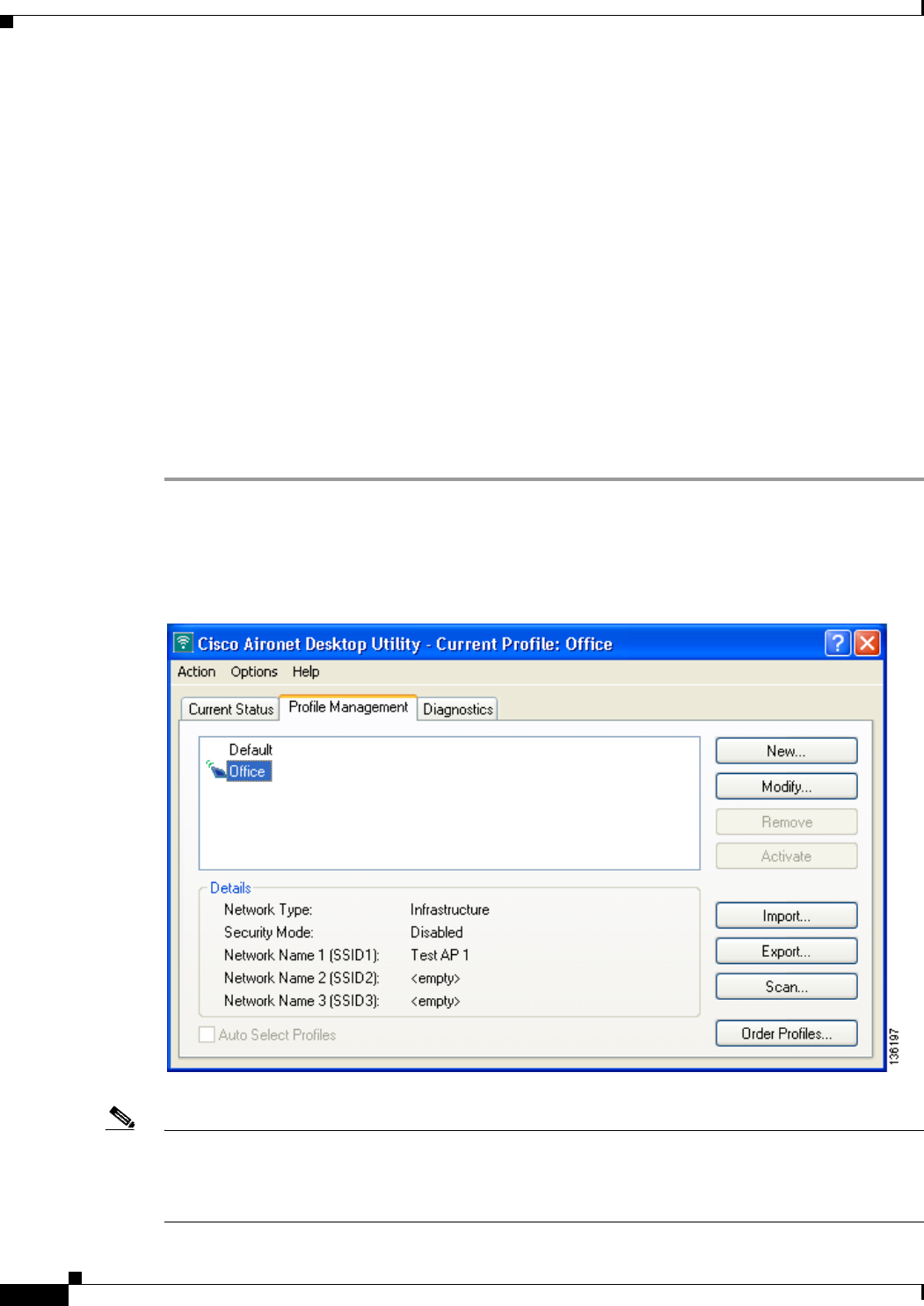
4-2
Cisco Aironet 802.11a/b/g Wireless LAN Client Adapters (CB21AG and PI21AG) Installation and Configuration Guide
OL-4211-05
Chapter 4 Using the Profile Manager
Overview of Profile Manager
Overview of Profile Manager
The ADU profile manager feature enables you to create and manage up to 16 profiles (saved
configurations) for your client adapter. These profiles enable you to use your client adapter in different
locations, each of which requires different configuration settings. For example, you may want to set up
profiles for using your client adapter at the office, at home, and in public areas such as airports. After
the profiles are created, you can easily switch between them without having to reconfigure your client
adapter each time you enter a new location.
Profiles are stored in the registry and are lost if you uninstall the client adapter’s software. To prevent
your profiles from becoming lost, Cisco recommends that you back up your profiles using the profile
manager’s import/export feature. See the “Importing and Exporting Profiles” section on page 4-11 for
details.
Opening Profile Manager
Step 1 To open the ADU profile manager, double-click the Aironet Desktop Utility icon on your desktop.
Step 2 Click the Profile Management tab. The Cisco Aironet Desktop Utility (Profile Management) window
appears (see Figure 4-1).
Figure 4-1 Cisco Aironet Desktop Utility (Profile Management) Window
Note The profile manager feature provides you with a default profile that is configured to use default values.
This profile is named Default and appears in the profiles list on the Cisco Aironet Desktop Utility
(Profile Management) window. You can use this profile as is by double-clicking it or modify it by
following the instructions in the “Modifying a Profile” section on page 4-11.

4-3
Cisco Aironet 802.11a/b/g Wireless LAN Client Adapters (CB21AG and PI21AG) Installation and Configuration Guide
OL-4211-05
Chapter 4 Using the Profile Manager
Opening Profile Manager
Table 4-1 provides a description of the status fields on the Cisco Aironet Desktop Utility (Profile
Management) window.
Profile manager enables you to perform the following tasks related to the management of profiles:
•Create a new profile, page 4-4
•Include a profile in auto profile selection, page 4-8
•Select the active profile, page 4-10
•Edit a profile, page 4-11
•Delete a profile, page 4-11
•Import a profile, page 4-12
•Export a profile, page 4-12
Follow the instructions on the page indicated for the task you want to perform.
Note If your system administrator used an administrative tool to deactivate certain parameters, these
parameters are disabled and cannot be selected.
Table 4-1 Description of Status Fields on Profile Management Window
Field Description
Network Type The type of network that is configured for the selected profile.
Value: Infrastructure or Ad Hoc
Note Refer to the Network Type parameter in Table 5-3 for instructions on
setting the network type.
Security Mode The type of security that is configured for the selected profile.
Value: None, Pre-Shared Key, WPA/WPA2 Passphrase, LEAP, EAP-FAST,
EAP-TLS, PEAP (EAP-GTC), PEAP (EAP-MSCHAP V2), or Host
Based EAP
Note Refer to Chapter 5 for instructions on setting client adapter security.
Network Name 1
(SSID1)
The service set identifier (SSID) is the wireless network that is configured for
the selected profile.
Note Refer to the SSID1 parameter in Table 5-2 for instructions on setting
SSID1.
Network Name 2
(SSID2)
An optional SSID that is configured for the selected profile. It identifies a
second distinct network and enables the client adapter to connect and/or roam
to that network without having to be reconfigured.
Note Refer to the SSID2 parameter in Table 5-2 for instructions on setting
SSID2.
Network Name 3
(SSID3)
An optional SSID that is configured for the selected profile. It identifies a
third distinct network and enables the client adapter to connect and/or roam
to that network without having to be reconfigured.
Note Refer to the SSID3 parameter in Table 5-2 for instructions on setting
SSID3.
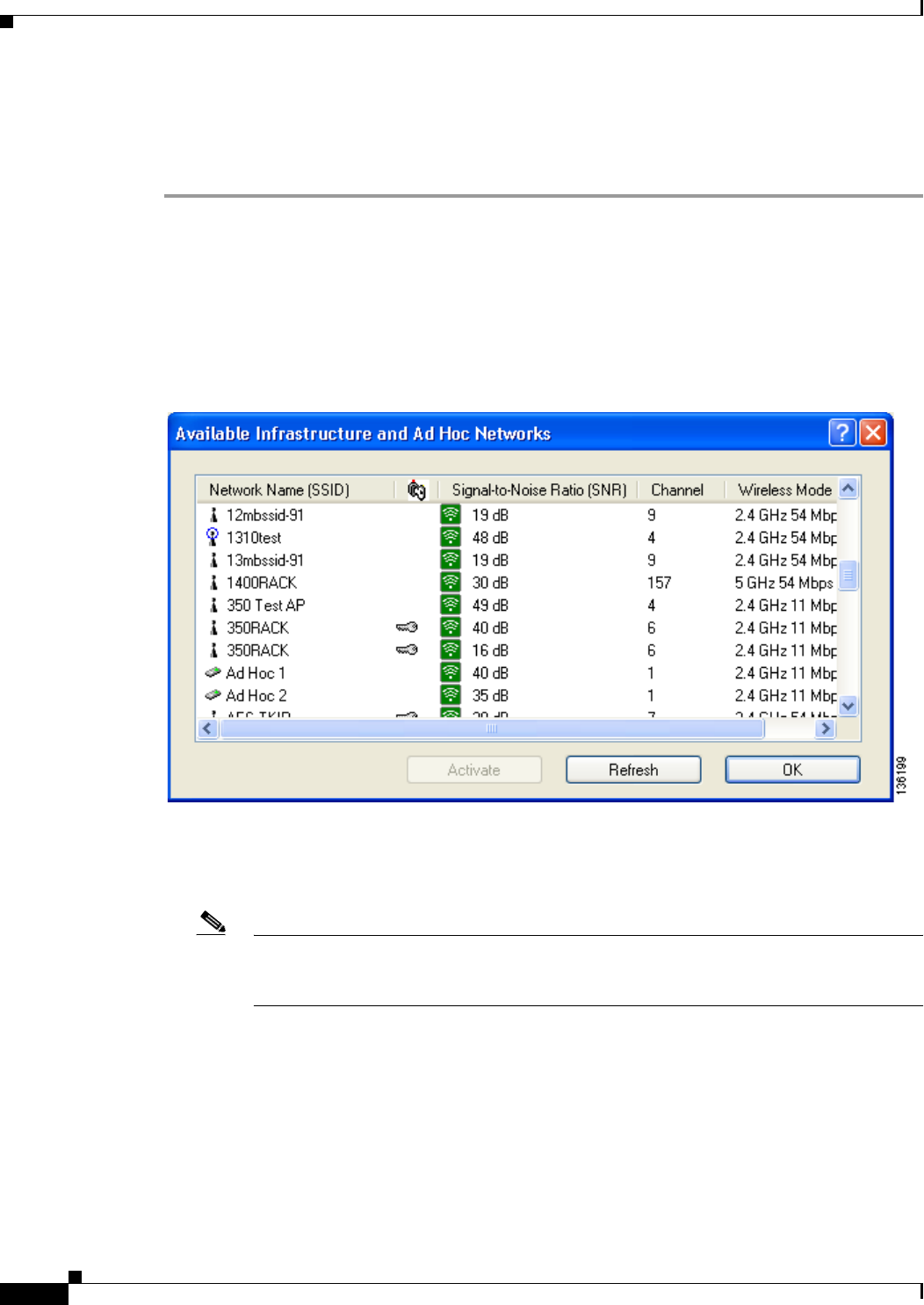
4-4
Cisco Aironet 802.11a/b/g Wireless LAN Client Adapters (CB21AG and PI21AG) Installation and Configuration Guide
OL-4211-05
Chapter 4 Using the Profile Manager
Creating a New Profile
Creating a New Profile
Follow the steps below to create a new profile.
Step 1 Perform one of the following:
•If you want to create a new profile from scratch, click New on the Cisco Aironet Desktop Utility
(Profile Management) window. Then go to Step 4.
•If you want to find an available network and create a profile based on it, click Scan on the Cisco
Aironet Desktop Utility (Profile Management) window. The Available Infrastructure and Ad Hoc
Networks window appears (see Figure 4-2).
Figure 4-2 Available Infrastructure and Ad Hoc Networks Window
This window displays a list of all available networks. Click the Refresh button when you want to
refresh the window and update the list of available networks.
Note The SSID of a Cisco IOS access point appears in the list of available networks only if a Guest
Mode SSID is enabled or the Broadcast SSID in Beacon option is selected. Refer to the
software configuration guide for your access point for additional information.
Table 4-2 provides a description of the default fields on the Available Infrastructure and Ad Hoc
Networks window. If you want to be able to view additional fields, choose Scan List Settings from
the Options drop-down menu. The Configure Scan List Columns window appears (see Figure 4-3).
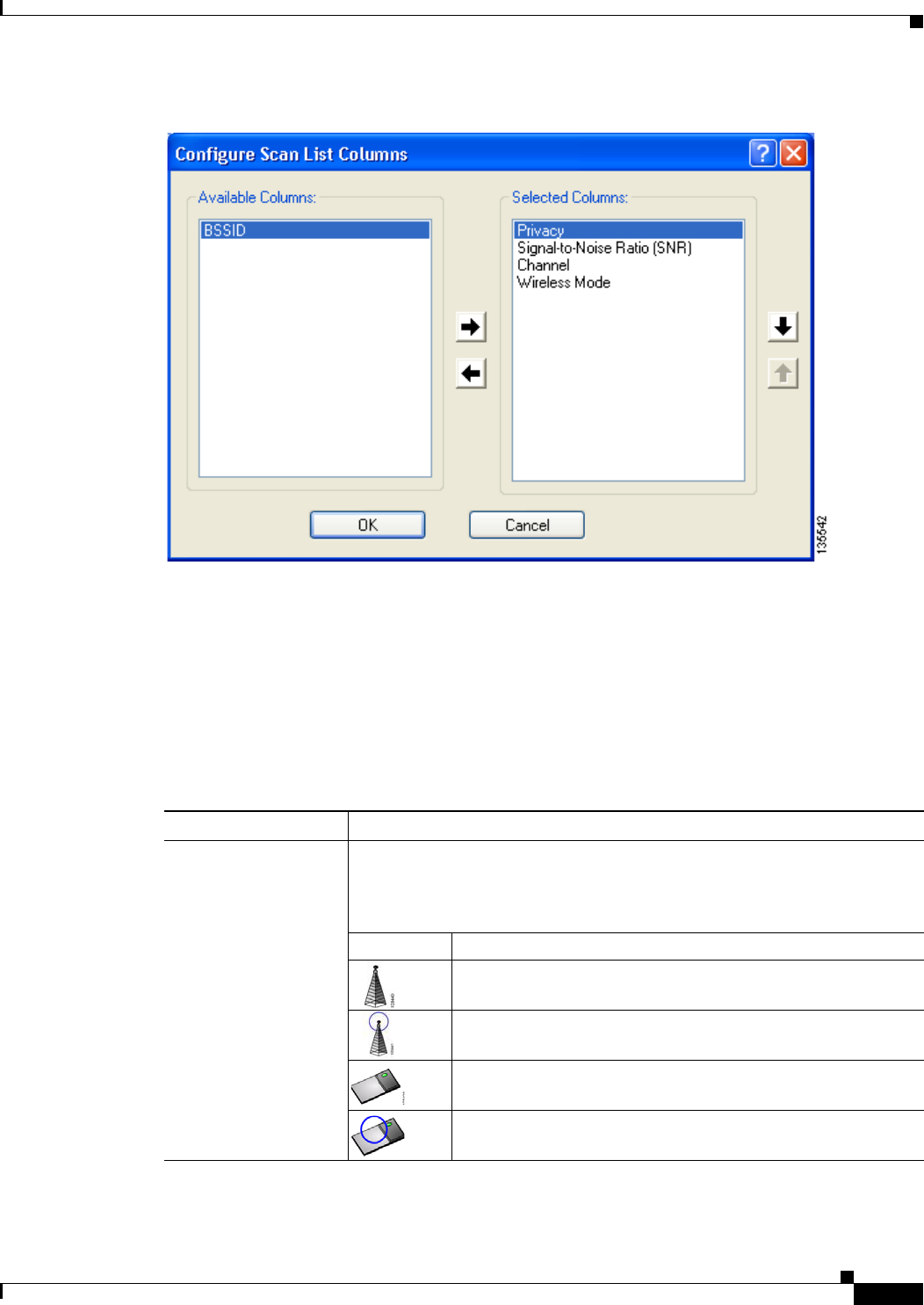
4-5
Cisco Aironet 802.11a/b/g Wireless LAN Client Adapters (CB21AG and PI21AG) Installation and Configuration Guide
OL-4211-05
Chapter 4 Using the Profile Manager
Creating a New Profile
Figure 4-3 Configure Scan List Columns Window
All of the fields that can be displayed on the Available Infrastructure and Ad Hoc Networks window
appear in the Available Columns box. Highlight the fields that you want to be displayed and click
the right arrow to move those fields to the Selected Columns box. You can use the left arrow to
move any undesired fields from the Selected Columns box to the Available Columns box and the up
and down arrows to change the order in which the fields are presented on the Available
Infrastructure and Ad Hoc Networks window. Click OK to save your changes.
Table 4-2 Description of Fields on Available Infrastructure and Ad Hoc Networks Window
Field Description
Network Name (SSID) The service set identifier (SSID) indicates the name of an available wireless
network. The icons to the left of the SSIDs provide information on network
type and link status.
Icon Description
An available infrastructure network.
The infrastructure network to which your client adapter is
currently associated.
An available ad hoc network.
The ad hoc network to which your client adapter is currently
associated.

4-6
Cisco Aironet 802.11a/b/g Wireless LAN Client Adapters (CB21AG and PI21AG) Installation and Configuration Guide
OL-4211-05
Chapter 4 Using the Profile Manager
Creating a New Profile
Step 2 Scroll down to see the full list of available networks.
Step 3 Click the SSID of the network to which you want your client adapter to associate and click Activate.
Note If the SSID is blank, you cannot activate the network.
Step 4 When the Profile Management (General) window appears (see Figure 4-4), enter a name for your new
profile (such as Office,Home, etc.) in the Profile Name field.
Key icon SSIDs that are designated with a key icon are being advertised as secure
networks.
Signal-to-Noise Ratio
(SNR)
The difference between the signal strength and the current noise level. The higher
the value, the better the client adapter’s ability to communicate with the access
point.
Note The color of this parameter’s icon provides a visual interpretation of
the signal-to-noise ratio: Excellent or Good (green), Fair (yellow),
Poor (red).
Note The signal-to-noise ratio is displayed either in decibels (dB) or as a
percentage (%), depending on the value selected for the Signal
Strength Display Units parameter on the Display Settings window.
See the “Setting Parameters that Affect ADU Status and Statistics
Tools” section on page 7-2 for more information.
Channel The channel that the access point (in infrastructure mode) or the other client
(in ad hoc mode) is using for communications.
Wireless Mode The frequency and rate at which the access point (in infrastructure mode) or
the other client (in ad hoc mode) is configured to transmit and receive packets.
BSSID The basic service set identifier (BSSID) is the MAC address of the access
point.
Table 4-2 Description of Fields on Available Infrastructure and Ad Hoc Networks Window
Field Description
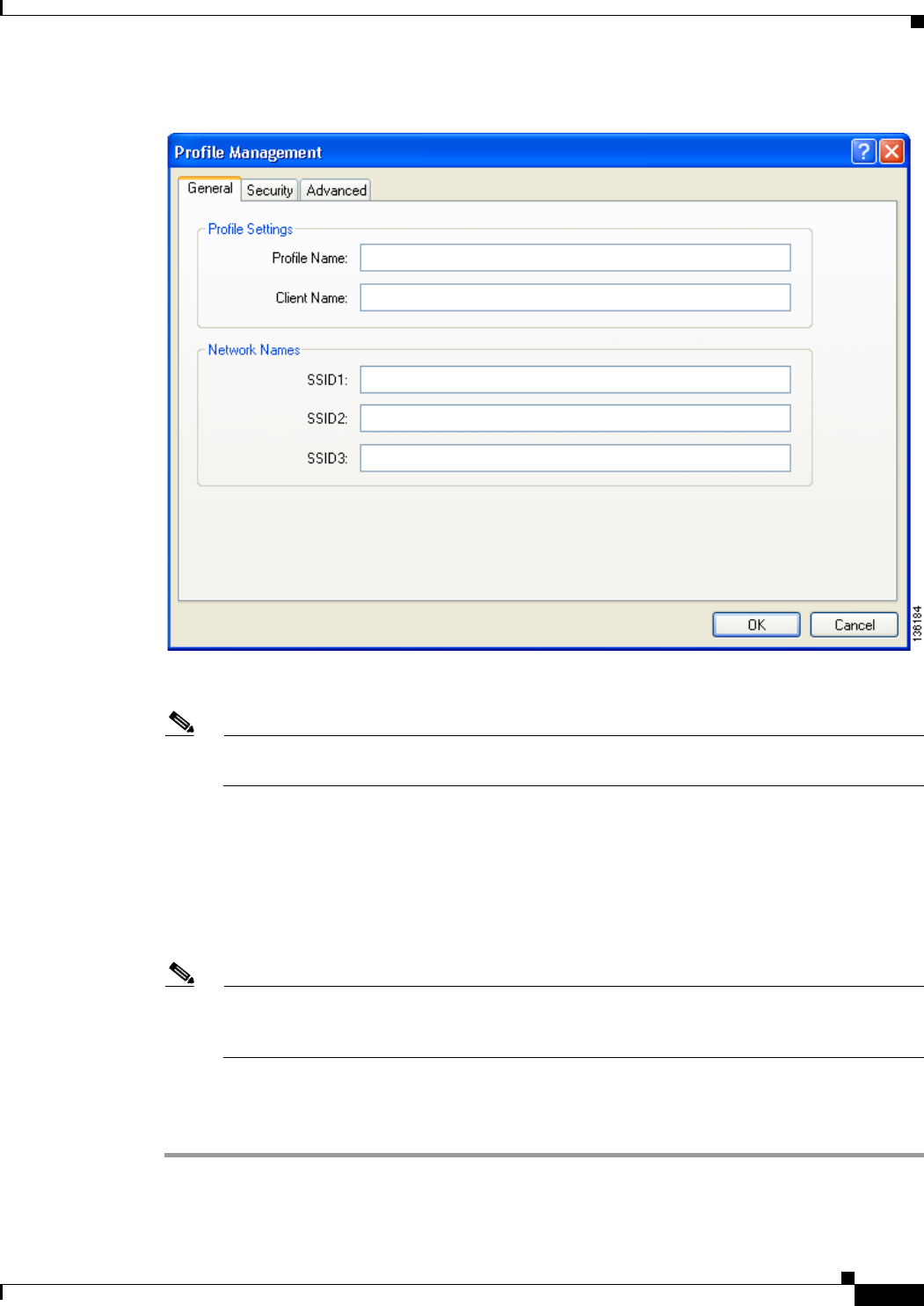
4-7
Cisco Aironet 802.11a/b/g Wireless LAN Client Adapters (CB21AG and PI21AG) Installation and Configuration Guide
OL-4211-05
Chapter 4 Using the Profile Manager
Creating a New Profile
Figure 4-4 Profile Management (General) Window
Note If you are creating a profile after scanning for an available network, the SSID of the network
appears in the SSID1 field.
Step 5 Perform one of the following:
•If you want this profile to use the default values, click OK. The profile is added to the profiles list
on the Cisco Aironet Desktop Utility (Profile Management) window.
•If you want to change any of the configuration parameter settings, follow the instructions in
Chapter 5. The profile is added to the profiles list on the Cisco Aironet Desktop Utility (Profile
Management) window.
Note The profiles for PC-Cardbus cards are tied to the slot in which the card is inserted. Therefore,
you must always insert your PC-Cardbus card into the same slot, create profiles for both slots,
or export the profiles from one slot and import them for the other slot.
Step 6 Go to the “Including a Profile in Auto Profile Selection” section on page 4-8 to enable the profile to be
selected automatically or go to the “Selecting the Active Profile” section on page 4-10 to activate the
profile.
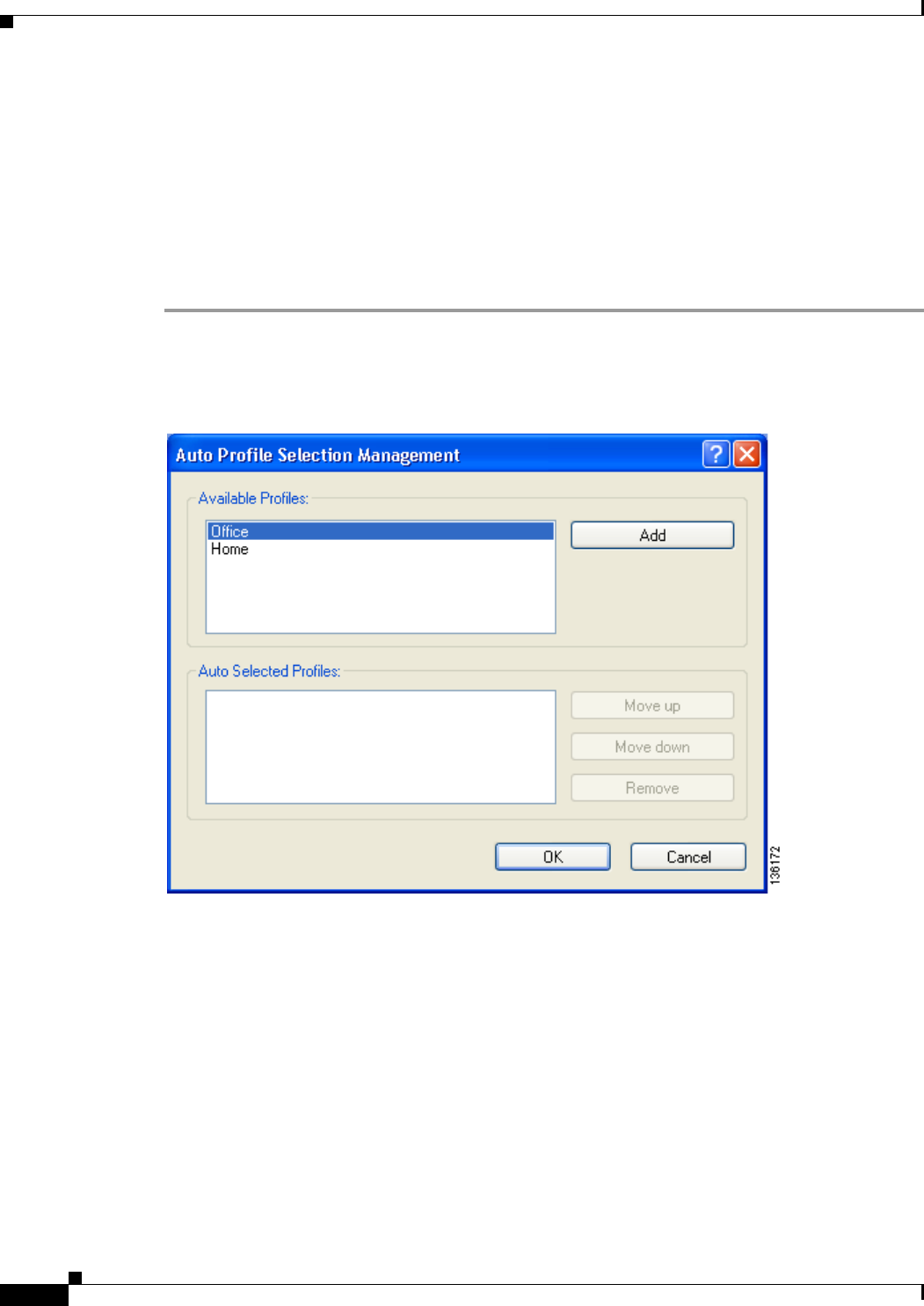
4-8
Cisco Aironet 802.11a/b/g Wireless LAN Client Adapters (CB21AG and PI21AG) Installation and Configuration Guide
OL-4211-05
Chapter 4 Using the Profile Manager
Including a Profile in Auto Profile Selection
Including a Profile in Auto Profile Selection
After you have created profiles for your client adapter, you can choose to include them in the profile
manager’s auto profile selection feature. Then when auto profile selection is enabled, the client adapter
automatically selects a profile from the list of profiles that were included in auto profile selection and
uses it to establish a connection to the network.
Follow these steps to include any of your profiles in auto profile selection and to establish the order in
which the profiles will be selected for use.
Step 1 Open ADU and click the Profile Management tab.
Step 2 Click Order Profiles. The Auto Profile Selection Management window appears (see Figure 4-5).
Figure 4-5 Auto Profile Selection Management Window

4-9
Cisco Aironet 802.11a/b/g Wireless LAN Client Adapters (CB21AG and PI21AG) Installation and Configuration Guide
OL-4211-05
Chapter 4 Using the Profile Manager
Including a Profile in Auto Profile Selection
Step 3 The profiles that you created are listed in the Available Profiles box. Highlight each one that you want
to include in auto profile selection and click the Add button. The profiles appear in the Auto Selected
Profiles box.
The following rules apply to auto profile selection:
•You must include at least two profiles in the Auto Selected Profiles box.
•The profiles must specify an SSID; otherwise, they do not appear in the Available Profiles
box.
•Profiles cannot specify multiple SSIDs; otherwise, they do not appear in the Available
Profiles box.
•Each profile that is included in auto profile selection must have a unique SSID. For example,
if Profile A and Profile B both have “ABCD” as their SSID, only Profile A or Profile B (whichever
was created first) appears in the Available Profiles box and can be included in auto profile
selection.
Note To remove a profile from auto profile selection, select the profile in the Auto Selected Profiles
box and click Remove. The profile is removed from the Auto Selected Profiles box.
Step 4 The first profile in the Auto Selected Profiles box has the highest priority while the last profile has the
lowest priority. To change the order (and priority) of your auto-selectable profiles, select the profile that
you want to move and click Move up or Move down to move the profile up or down, respectively.
Step 5 Click OK to save your changes.
When auto profile selection is enabled (see the “Selecting the Active Profile” section on page 4-10 for
instructions), the client adapter scans for an available network. The profile with the highest priority and
the same SSID as one of the found networks is the one that is used to connect to the network. If the
connection fails, the client adapter tries the next highest priority profile that matches the SSID and so on.
Note When you enable auto profile selection, the client adapter scans the wireless modes specified by
all the profiles in the auto profile selection list for an available network. The client ignores the
selected profile’s wireless mode setting, which was configured on the ADU Profile Management
(Advanced) window. Using this method, the client does not need to disassociate nor change the
current profile while looking for networks in other profiles.
Step 6 Go to the “Selecting the Active Profile” section on page 4-10 to enable auto profile selection.

4-10
Cisco Aironet 802.11a/b/g Wireless LAN Client Adapters (CB21AG and PI21AG) Installation and Configuration Guide
OL-4211-05
Chapter 4 Using the Profile Manager
Selecting the Active Profile
Selecting the Active Profile
Follow the steps below to specify the profile that the client adapter is to use.
Note You can use ASTU instead of the ADU Profile Manager to select the active profile. Refer to Chapter 8
for instructions.
Step 1 Open ADU and click the Profile Management tab. The Cisco Aironet Desktop Utility (Profile
Management) window appears (see Figure 4-1).
Step 2 Perform one of the following:
•Select one profile for the client adapter to use either by double-clicking that profile in the profiles
list or by clicking that profile in the profiles list and then clicking Activate.
If the client adapter cannot associate (or establish a connection) to an access point (in infrastructure
mode) or another client (in ad hoc mode) or loses association while using the selected profile, the
adapter does not attempt to associate using another profile. To associate, you must select a different
profile or enable auto profile selection.
•Enable auto profile selection by checking the Auto Select Profiles check box.
This option causes the client adapter’s driver to automatically select a profile from the list of profiles
that were set up to be included in auto profile selection.
If the client adapter loses association for more than 10 seconds (or for more than the time specified
by the LEAP/EAP-FAST authentication timeout value on the LEAP/EAP-FAST Settings window if
LEAP/EAP-FAST is enabled), the driver switches automatically to another profile that is included
in auto profile selection. The adapter does not switch profiles as long as it remains associated or
reassociates within 10 seconds (or within the time specified by the LEAP/EAP-FAST authentication
timeout value). To force the client adapter to associate to a different access point (in infrastructure
mode) or another client (in ad hoc mode), you must uncheck the Auto Select Profiles check box and
select a new profile from the profiles list.
Note This option is available only if two or more profiles are included in auto profile selection.
Note Login scripts are not reliable if you use auto profile selection with LEAP or EAP-FAST. If
you authenticate and achieve full network connectivity before or at the same time as you log
into the computer, login scripts will run. However, if you authenticate and achieve full
network connectivity after you log into the computer, login scripts will not run.
•Click Scan. The Available Infrastructure and Ad Hoc Networks window appears (see Figure 4-2).
Double-click the SSID of a network that is used by one of your profiles and click OK.
The client adapter starts using a profile based on the option selected above. The active profile is
designated by the following icon in the profiles list:

4-11
Cisco Aironet 802.11a/b/g Wireless LAN Client Adapters (CB21AG and PI21AG) Installation and Configuration Guide
OL-4211-05
Chapter 4 Using the Profile Manager
Modifying a Profile
Modifying a Profile
Follow the steps in the appropriate section below to edit or delete an existing profile.
Editing a Profile
Step 1 Open ADU and click the Profile Management tab. The Cisco Aironet Desktop Utility (Profile
Management) window appears (see Figure 4-1).
Step 2 In the profiles list, select the profile that you want to edit.
Step 3 Click Modify.
Step 4 Follow the instructions in Chapter 5 to change any of the configuration parameters for this profile.
Deleting a Profile
Step 1 Open ADU and click the Profile Management tab. The Cisco Aironet Desktop Utility (Profile
Management) window appears (see Figure 4-1).
Step 2 In the profiles list, select the profile that you want to delete.
Note You cannot delete the active profile.
Step 3 Click Remove. The profile is deleted.
Importing and Exporting Profiles
This section provides instructions for importing and exporting profiles. You may want to use the
import/export feature for the following reasons:
•To back up profiles before uninstalling client adapter software
•To export profiles for a PC-Cardbus card in one Cardbus slot and import them for use with a second
Cardbus slot
•To set up your computer with a profile from another computer
•To export one of your profiles and use it to set up additional computers
Follow the instructions on the following pages to import or export profiles.
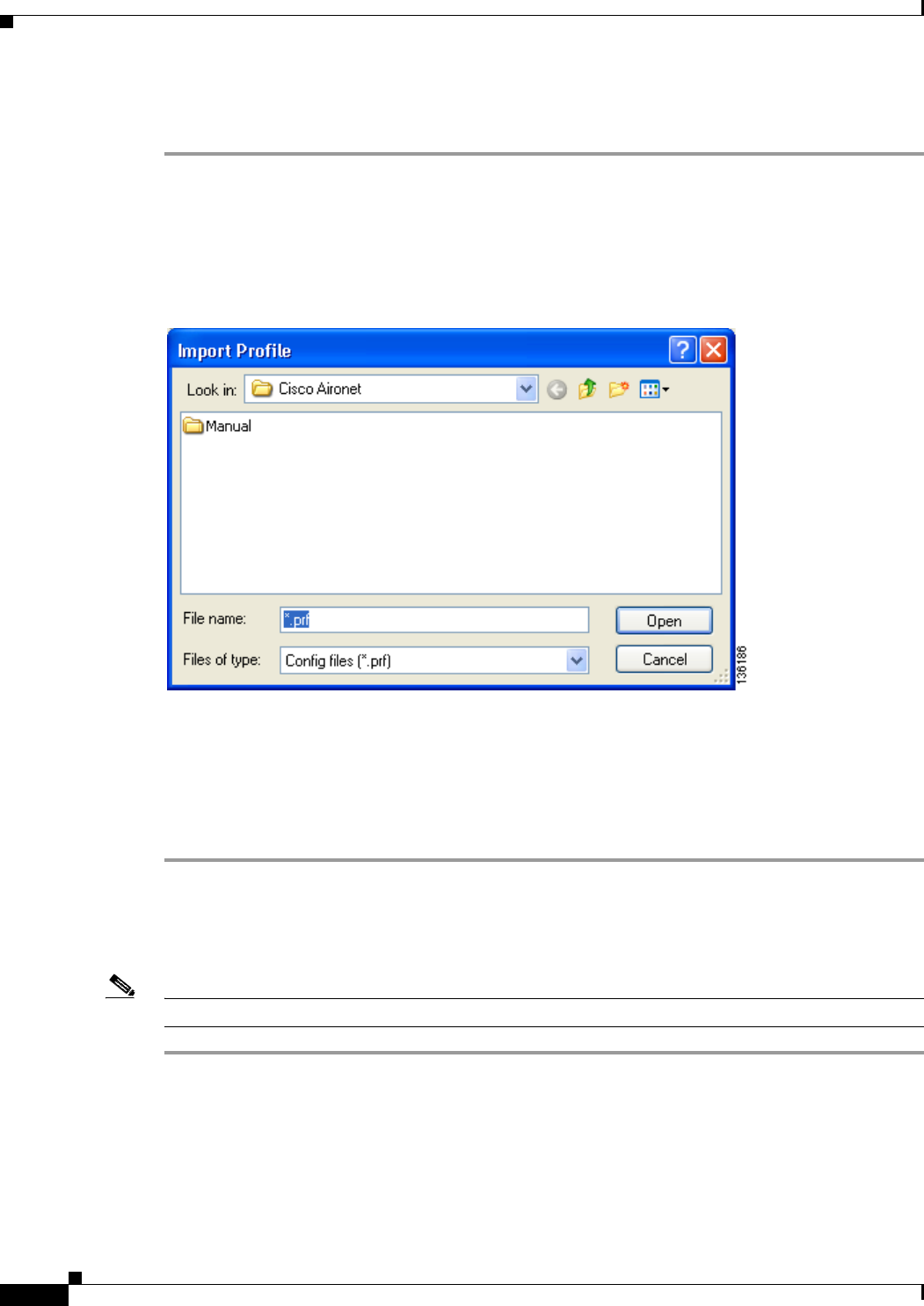
4-12
Cisco Aironet 802.11a/b/g Wireless LAN Client Adapters (CB21AG and PI21AG) Installation and Configuration Guide
OL-4211-05
Chapter 4 Using the Profile Manager
Importing and Exporting Profiles
Importing a Profile
Step 1 If the profile that you want to import is on a floppy disk, insert the disk into your computer’s floppy drive.
Step 2 Open ADU and click the Profile Management tab. The Cisco Aironet Desktop Utility (Profile
Management) window appears (see Figure 4-1).
Step 3 Click Import. The Import Profile window appears (see Figure 4-6).
Figure 4-6 Import Profile Window
Step 4 In the Look in drop-down box, find the directory containing the profile.
Step 5 Select the profile that you want to import so it appears in the File name box at the bottom of the window.
Step 6 Click Open. The imported profile appears in the profiles list on the Cisco Aironet Desktop Utility
(Profile Management) window.
Exporting a Profile
Note PACs are not exported with EAP-FAST profiles.
Step 1 Insert a blank floppy disk into your computer’s floppy drive, if you wish to export a profile to a floppy
disk.
Step 2 Open ADU and click the Profile Management tab. The Cisco Aironet Desktop Utility (Profile
Management) window appears (see Figure 4-1).
Step 3 In the profiles list, select the profile that you want to export.
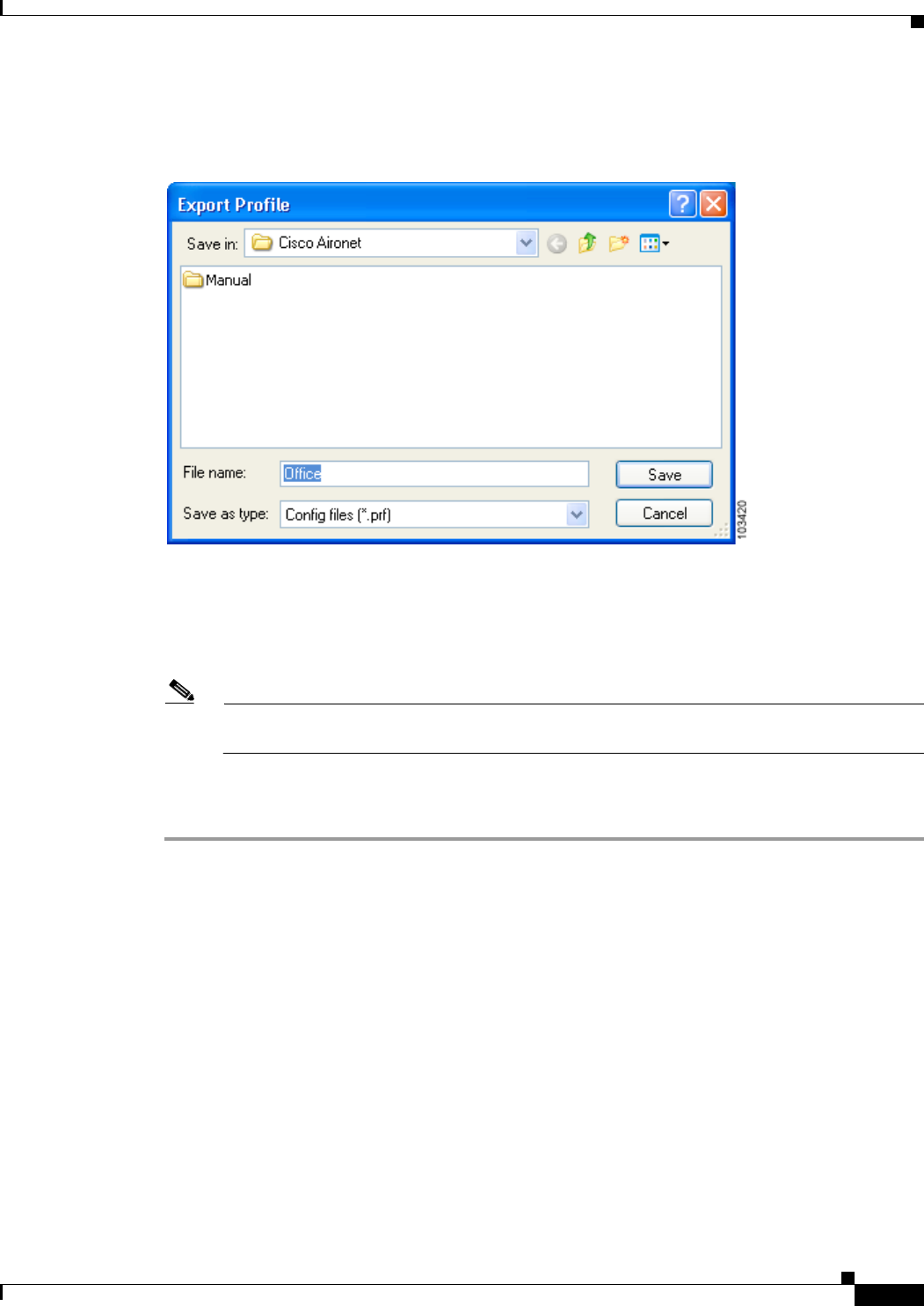
4-13
Cisco Aironet 802.11a/b/g Wireless LAN Client Adapters (CB21AG and PI21AG) Installation and Configuration Guide
OL-4211-05
Chapter 4 Using the Profile Manager
Importing and Exporting Profiles
Step 4 Click Export. The Export Profile window appears (see Figure 4-7).
Figure 4-7 Export Profile Window
The profile name appears in the File name box.
Step 5 Choose a directory (such as your computer’s floppy disk drive or a location on the network) from the
Save in drop-down box.
Note The default location is the directory where ADU is installed (such as C:\Program Files\Cisco
Aironet).
Step 6 Click Save. The profile is exported to the specified location.
Step 7 Follow the instructions in the “Importing a Profile” section to import the profile on another computer.

4-14
Cisco Aironet 802.11a/b/g Wireless LAN Client Adapters (CB21AG and PI21AG) Installation and Configuration Guide
OL-4211-05
Chapter 4 Using the Profile Manager
Importing and Exporting Profiles

CHAPTER
5-1
Cisco Aironet 802.11a/b/g Wireless LAN Client Adapters (CB21AG and PI21AG) Installation and Configuration Guide
OL-4211-05
5
Configuring the Client Adapter
This chapter explains how to configure profile parameters. The following topics are covered in this
chapter:
•Overview, page 5-2
•Setting General Parameters, page 5-3
•Setting Advanced Parameters, page 5-6
•Setting Security Parameters, page 5-14
•Enabling Wi-Fi Multimedia, page 5-59
•Setting Roaming Parameters in the Windows Control Panel, page 5-63

5-2
Cisco Aironet 802.11a/b/g Wireless LAN Client Adapters (CB21AG and PI21AG) Installation and Configuration Guide
OL-4211-05
Chapter 5 Configuring the Client Adapter
Overview
Overview
When you choose to create a new profile or modify an existing profile on the Cisco Aironet Desktop
Utility (Profile Management) window, the Profile Management windows appear. These windows enable
you to set the configuration parameters for that profile.
Note If you do not change any of the configuration parameters for a newly created profile, the default values
are used.
Note If you are planning to set parameters on more than one of the Profile Management windows, wait until
you are finished with all of the windows before clicking OK. When you click OK, you are returned to
the Cisco Aironet Desktop Utility (Profile Management) window.
Each of the Profile Management windows (listed below) contains parameters that affect a specific aspect
of the client adapter:
•General—Prepares the client adapter for use in a wireless network
•Advanced—Controls how the client adapter operates within an infrastructure or ad hoc network
•Security—Controls how a client adapter associates to an access point, authenticates to the wireless
network, and encrypts and decrypts data
Table 5-1 enables you to quickly locate instructions for setting each Profile Management window’s
parameters.
Note If your system administrator used an administrative tool to deactivate certain parameters, these
parameters are disabled on the Profile Management windows and cannot be selected.
Note You can also set two roaming parameters for your client adapter outside of ADU using the Windows
Control Panel. Refer to the “Setting Roaming Parameters in the Windows Control Panel” on page 5-63
for details.
Table 5-1 Locating Configuration Instructions
Parameter Category Page Number
General 5-3
Advanced 5-6
Security 5-14
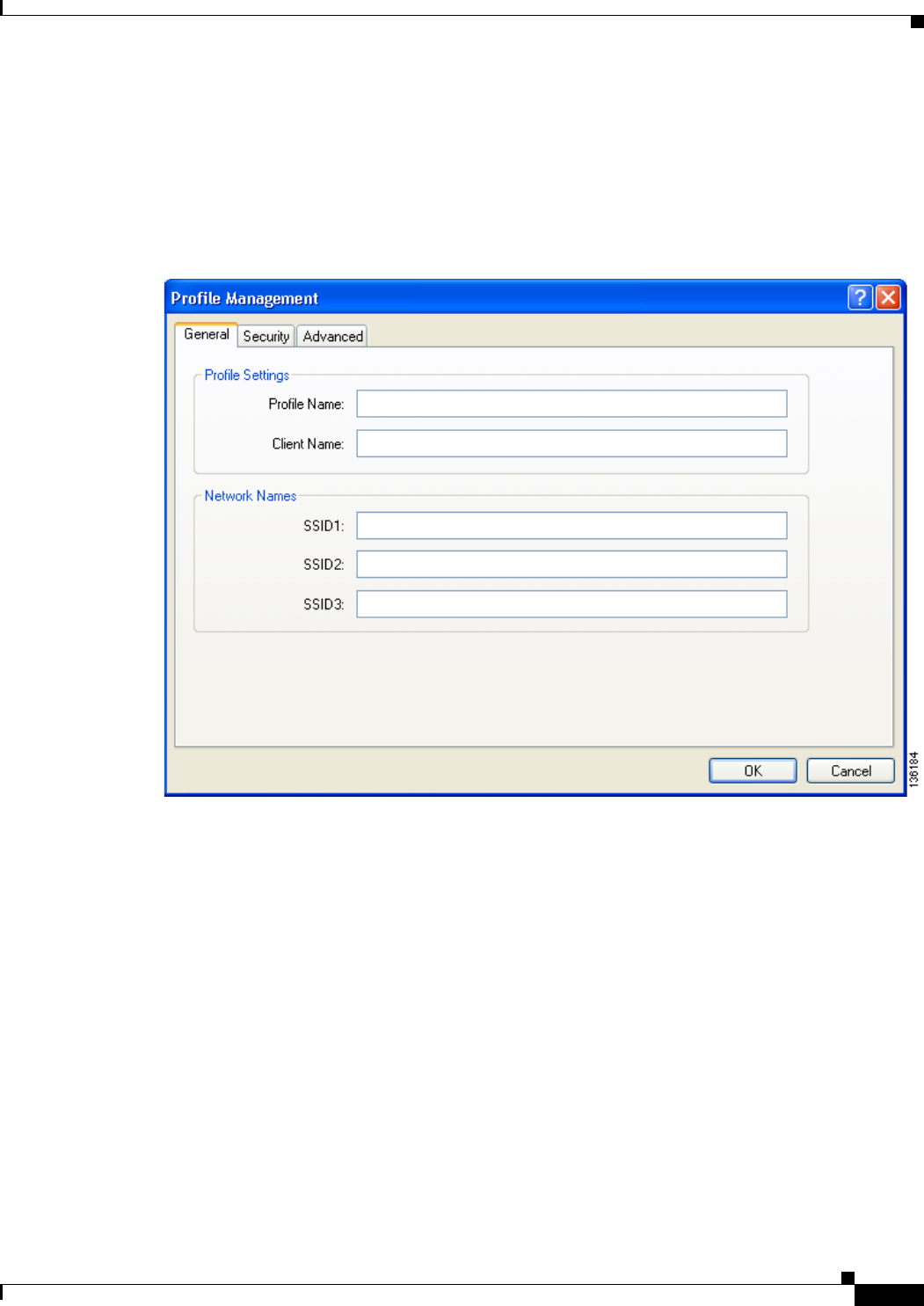
5-3
Cisco Aironet 802.11a/b/g Wireless LAN Client Adapters (CB21AG and PI21AG) Installation and Configuration Guide
OL-4211-05
Chapter 5 Configuring the Client Adapter
Setting General Parameters
Setting General Parameters
The Profile Management (General) window (see Figure 5-1) enables you to set parameters that prepare
the client adapter for use in a wireless network. This window appears after you click New or Modify on
the Cisco Aironet Desktop Utility (Profile Management) window.
Figure 5-1 Profile Management (General) Window

5-4
Cisco Aironet 802.11a/b/g Wireless LAN Client Adapters (CB21AG and PI21AG) Installation and Configuration Guide
OL-4211-05
Chapter 5 Configuring the Client Adapter
Setting General Parameters
Table 5-2 lists and describes the client adapter’s general parameters. Follow the instructions in the table
to change any parameters.
Table 5-2 Profile Management General Parameters
Parameter Description
Profile Name The name assigned to the configuration profile.
Range: You can key in up to 32 ASCII characters.
Default: A blank field
Client Name A logical name for your workstation. It enables an administrator to
ascertain which devices are connected to the access point without
having to memorize every MAC address. This name is included in the
access point’s list of connected devices. The client name is filled in
automatically but can be changed.
Range: You can key in up to 16 ASCII characters.
Default: The name of your computer
Note Each computer on the network should have a unique client
name.
SSID1 The service set identifier (SSID) identifies the specific wireless
network that you want the client adapter to access.
Range: You can key in up to 32 ASCII characters (case sensitive).
Default: A blank field
Note If you leave this parameter blank, your client adapter can
associate to any access point on the network that is configured
to allow broadcast SSIDs. If the access point with which the
client adapter is to communicate is not configured to allow
broadcast SSIDs, the value of this parameter must match the
SSID of the access point. Otherwise, the client adapter is unable
to access the network.
Note You must enter an SSID if this profile is configured for use in
an ad hoc network.

5-5
Cisco Aironet 802.11a/b/g Wireless LAN Client Adapters (CB21AG and PI21AG) Installation and Configuration Guide
OL-4211-05
Chapter 5 Configuring the Client Adapter
Setting General Parameters
Go to the next section to set additional parameters, or click OK to save your changes and return to the
Cisco Aironet Desktop Utility (Profile Management) window.
SSID2 An optional SSID that identifies a second distinct network and enables
the client adapter to roam to that network without having to be
reconfigured.
Range: You can key in up to 32 ASCII characters (case sensitive).
Default: A blank field
Note If a profile specifies more than one SSID, it cannot be included
in auto profile selection or used with WPA/WPA2 passphrase.
Note This field is unavailable for any profiles that are included in
auto profile selection or configured for use in an ad hoc
network.
SSID3 An optional SSID that identifies a third distinct network and enables the
client adapter to roam to that network without having to be
reconfigured.
Range: You can key in up to 32 ASCII characters (case sensitive).
Default: A blank field
Note If a profile specifies more than one SSID, it cannot be included
in auto profile selection or used with WPA/WPA2 passphrase.
Note This field is unavailable for any profiles that are included in
auto profile selection or configured for use in an ad hoc
network.
Table 5-2 Profile Management General Parameters (continued)
Parameter Description
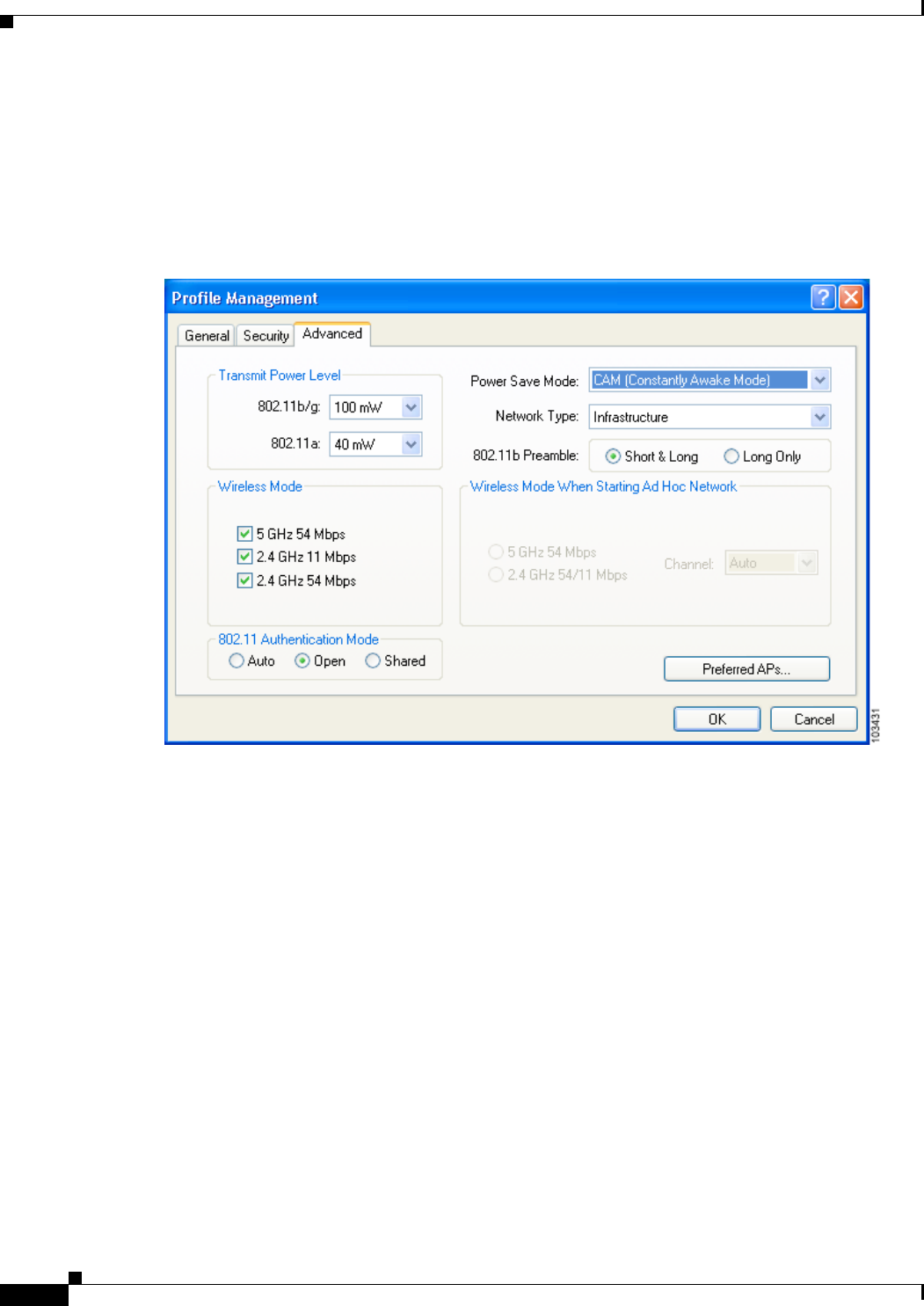
5-6
Cisco Aironet 802.11a/b/g Wireless LAN Client Adapters (CB21AG and PI21AG) Installation and Configuration Guide
OL-4211-05
Chapter 5 Configuring the Client Adapter
Setting Advanced Parameters
Setting Advanced Parameters
The Profile Management (Advanced) window (see Figure 5-2) enables you to set parameters that control
how the client adapter operates within an infrastructure or ad hoc network. To open this window, click
the Advanced tab from any Profile Management window.
Figure 5-2 Profile Management (Advanced) Window

5-7
Cisco Aironet 802.11a/b/g Wireless LAN Client Adapters (CB21AG and PI21AG) Installation and Configuration Guide
OL-4211-05
Chapter 5 Configuring the Client Adapter
Setting Advanced Parameters
Table 5-3 lists and describes the client adapter’s advanced parameters. Follow the instructions in the
table to change any parameters.
Table 5-3 Profile Management Advanced Parameters
Parameter Description
Transmit Power Level Specifies the preferred power level at which your client adapter
transmits. Although the adapter supports up to 100 mW, the transmit
power level that is actually used is limited to the maximum value
allowed by your country’s regulatory agency (FCC in the U.S., DOC in
Canada, ETSI in Europe, TELEC in Japan, etc.).
Options: Dependent on the radio band used and the power table
programmed into the client adapter; see the table below.
Default: The maximum power level programmed into the client adapter
and allowed by your country’s regulatory agency
Radio Band Transmit Power Level
802.11b/g 10, 20, 32, 50, 63, or 100 mW
802.11a 10, 13, 20, 25, or 40 mW
Note The client adapter’s maximum transmit power level may be
lower when operating in 802.11g mode than when operating in
802.11b mode due to 802.11g-specific regulatory limitations in
some countries.
Note Reducing the transmit power level conserves battery power but
decreases radio range.
Note If configured to control the client power level, access points can
limit the maximum power of the client.

5-8
Cisco Aironet 802.11a/b/g Wireless LAN Client Adapters (CB21AG and PI21AG) Installation and Configuration Guide
OL-4211-05
Chapter 5 Configuring the Client Adapter
Setting Advanced Parameters
Power Save Mode Sets your client adapter to its optimum power consumption setting.
Options: CAM (Constantly Awake Mode), Fast PSP (Power Save
Mode), or Max PSP (Max Power Saving)
Default: CAM (Constantly Awake Mode)
Power Save Mode Description
CAM (Constantly Awake
Mode)
Keeps the client adapter powered up
continuously so there is little lag in
message response time.
Consumes the most power but offers the
highest throughput. Is recommended for
desktop computers and devices that use
AC power.
Fast PSP (Power Save
Mode)
Switches between PSP mode and CAM
mode, depending on network traffic. This
mode switches to CAM when retrieving a
large number of packets and switches back
to PSP after the packets have been
retrieved.
Is recommended when power consumption
is a concern but you need greater
throughput than that allowed by Max PSP.
Max PSP (Max Power
Saving)
Causes the access point to buffer incoming
messages for the client adapter, which
wakes up periodically and polls the access
point to see if any buffered messages are
waiting for it. The adapter can request
each message and then go back to sleep.
Conserves the most power but offers the
lowest throughput. Is recommended for
devices for which power consumption is
the ultimate concern (such as small
battery-powered devices).
Note If this profile is configured for use in an ad hoc network, CAM
mode is used automatically.
Table 5-3 Profile Management Advanced Parameters (continued)
Parameter Description

5-9
Cisco Aironet 802.11a/b/g Wireless LAN Client Adapters (CB21AG and PI21AG) Installation and Configuration Guide
OL-4211-05
Chapter 5 Configuring the Client Adapter
Setting Advanced Parameters
Network Type Specifies the type of network in which your client adapter is installed.
Options: Infrastructure or Ad Hoc
Default: Infrastructure
Network Type Description
Ad Hoc Often referred to as peer to peer. Indicates
that your wireless network consists of a
few wireless devices that are not
connected to a wired Ethernet network
through an access point. For example, an
ad hoc network could be set up between
computers in a conference room so that
users can share information in a meeting.
Infrastructure Indicates that your wireless network is
connected to a wired Ethernet network
through an access point.
802.11b Preamble Determines whether your client adapter uses both short and long radio
headers or only long radio headers. The adapter can use short radio
headers only if the access point is also configured to support them and
is using them. If any clients associated to an access point are using long
headers, then all clients in that cell must use long headers, even if both
this client and the access point have short radio headers enabled.
Short radio headers improve throughput performance; long radio
headers ensure compatibility with clients and access points that do not
support short radio headers.
Options: Short & Long or Long Only
Default: Short & Long
Note This parameter is disabled if the Wireless Mode parameter does
not include the 2.4 GHz 11 Mbps option.
Table 5-3 Profile Management Advanced Parameters (continued)
Parameter Description

5-10
Cisco Aironet 802.11a/b/g Wireless LAN Client Adapters (CB21AG and PI21AG) Installation and Configuration Guide
OL-4211-05
Chapter 5 Configuring the Client Adapter
Setting Advanced Parameters
Wireless Mode Specifies the frequency and rate at which your client adapter should
transmit packets to or receive packets from access points.
Options: 5 GHz 54 Mbps, 2.4 GHz 54 Mbps, and 2.4 GHz 11 Mbps
Default: All options selected
Note When more than one option is selected, the client adapter
attempts to use the wireless modes in this order:
5 GHz 54 Mbps, 2.4 GHz 54 Mbps, 2.4 GHz 11 Mbps.
Note If you choose 2.4 GHz 11 Mbps, the client adapter can associate
to access points containing an 802.11b or 802.11g radio at
802.11b data rates. If you choose 2.4 GHz 54 Mbps, the client
adapter can associate to access points containing an 802.11b
radio at 802.11b data rates or to access points containing an
802.11g radio at 802.11b or 802.11g data rates.
Note When you enable auto profile selection, the client adapter
ignores the selected profile’s wireless mode setting and scans
the wireless modes specified by all the profiles in the auto
profile selection list for an available network. Using this
method, the client does not need to disassociate nor change the
current profile while looking for networks in other profiles.
Note Your client adapter’s wireless mode must match that of the
access points with which it is to communicate. Otherwise, your
client adapter may not be able to associate to them.
Wireless Mode When Starting
Ad Hoc Network
Specifies the frequency and rate at which your client adapter should
transmit packets to or receive packets from other clients (in ad hoc
mode).
Options: 5 GHz 54 Mbps, 2.4 GHz 11 Mbps, or 2.4 GHz 54 Mbps
Default: 5 GHz 54 Mbps
Note The client scans the band(s) specified by the Wireless Mode
parameter before creating a new ad hoc cell based on the band
specified by the Wireless Mode When Starting Ad Hoc
Network parameter.
Note Your client adapter’s wireless mode must match that of the
other clients with which it is to communicate. Otherwise, your
client adapter may not be able to associate to them.
Note The 2.4 GHz 54 Mbps wireless mode may not be functional on
some vendors’ products. In this case, the client adapter uses the
2.4 GHz 11 Mbps wireless mode.
Table 5-3 Profile Management Advanced Parameters (continued)
Parameter Description

5-11
Cisco Aironet 802.11a/b/g Wireless LAN Client Adapters (CB21AG and PI21AG) Installation and Configuration Guide
OL-4211-05
Chapter 5 Configuring the Client Adapter
Setting Advanced Parameters
Channel Specifies the channel that your client adapter uses for communications
in a 2.4-GHz ad hoc network. The available channels conform to the
IEEE 802.11 Standard for your regulatory domain.
The channel of the client adapter must be set to match the channel used
by the other clients in the wireless network. If the client adapter does
not find any other ad hoc clients, this parameter specifies the channel
with which the adapter will start its cell.
Range: Dependent on regulatory domain
Example: 1 to 11 (2412 to 2462 MHz) in North America
Default: Auto (the client automatically determines the channel on
which to start communications)
Note This parameter is available only when 2.4 GHz 11 Mbps or 2.4
GHz 54 Mbps is selected for the Wireless Mode When Starting
Ad Hoc Network parameter. When 5 GHz 54 Mbps is selected,
the Channel parameter is set to Auto automatically.
Note Refer to Appendix D for a list of channel identifiers, channel
center frequencies, and regulatory domains for each channel.
Table 5-3 Profile Management Advanced Parameters (continued)
Parameter Description

5-12
Cisco Aironet 802.11a/b/g Wireless LAN Client Adapters (CB21AG and PI21AG) Installation and Configuration Guide
OL-4211-05
Chapter 5 Configuring the Client Adapter
Setting Advanced Parameters
802.11 Authentication Mode Specifies how your client adapter attempts to authenticate to an access
point. Open and shared authentication do not rely on a RADIUS server
on your network.
Options: Auto, Open, or Shared
Default: Open
802.11 Authentication Mode Description
Auto Causes the client adapter to attempt to
authenticate using shared authentication.
If it fails, the client adapter then attempts
to authenticate using open authentication.
Open Enables your client adapter, regardless of
its WEP settings, to authenticate and
attempt to communicate with an access
point. However, communication can occur
only if the adapter’s WEP key matches that
of the access point.
Shared Enables your client adapter to authenticate
and communicate only with access points
that have the same WEP key.
During shared key authentication, the
access point sends an unencrypted
challenge packet to the client adapter,
which encrypts the packet and sends it
back to the access point. The access point
attempts to decrypt the encrypted packet
and sends an authentication response
packet indicating the success or failure of
the decryption back to the client adapter. If
the packet is successfully encrypted/
decrypted, the user is considered to be
authenticated.
Note Cisco recommends that Auto and Shared not be used because
they present a security risk.
Note Your client adapter’s 802.11 authentication mode setting must
match that of the access points with which it is to communicate,
or be set to auto. Otherwise, your client adapter may not be able
to authenticate to them.
Note If this profile is configured for use in an ad hoc network or is
not configured to use static WEP, this parameter is unavailable,
and Open authentication is used.
Table 5-3 Profile Management Advanced Parameters (continued)
Parameter Description
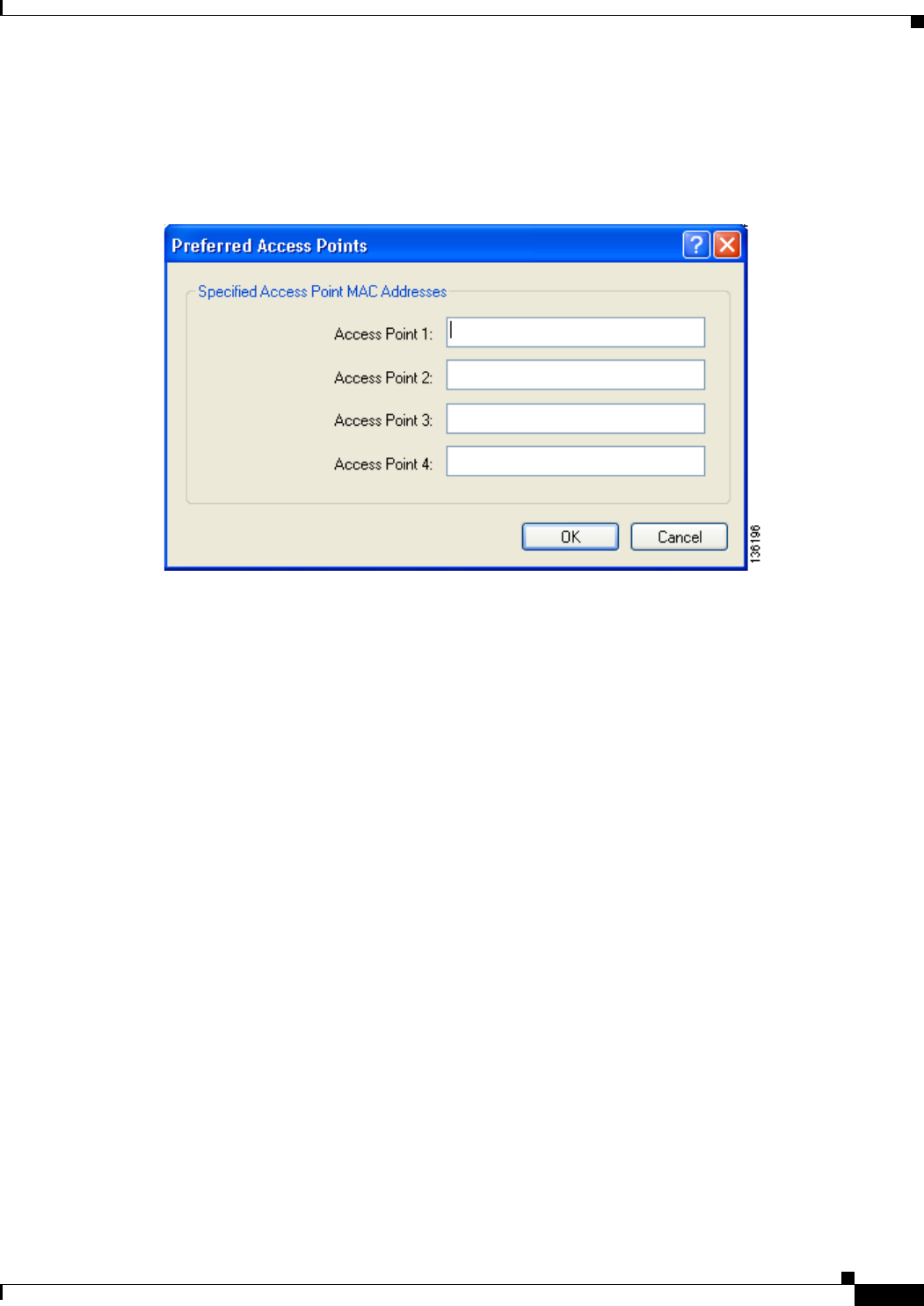
5-13
Cisco Aironet 802.11a/b/g Wireless LAN Client Adapters (CB21AG and PI21AG) Installation and Configuration Guide
OL-4211-05
Chapter 5 Configuring the Client Adapter
Setting Advanced Parameters
If this profile is configured for use in an infrastructure network and you want to specify up to four access
points to which the client adapter should attempt to associate, click Preferred APs. The Preferred
Access Points window appears (see Figure 5-3).
Figure 5-3 Preferred Access Points Window
Leave the Access Point 1 through Access Point 4 fields blank or enter the MAC addresses of up to four
preferred access points to which the client adapter can associate; then click OK. (The MAC address
should consist of 12 hexadecimal characters.) If the specified access points are not found or the client
adapter roams out of range, the adapter may associate to another access point.
Go to the next section to set additional parameters or click OK to save your changes and return to the
Cisco Aironet Desktop Utility (Profile Management) window.
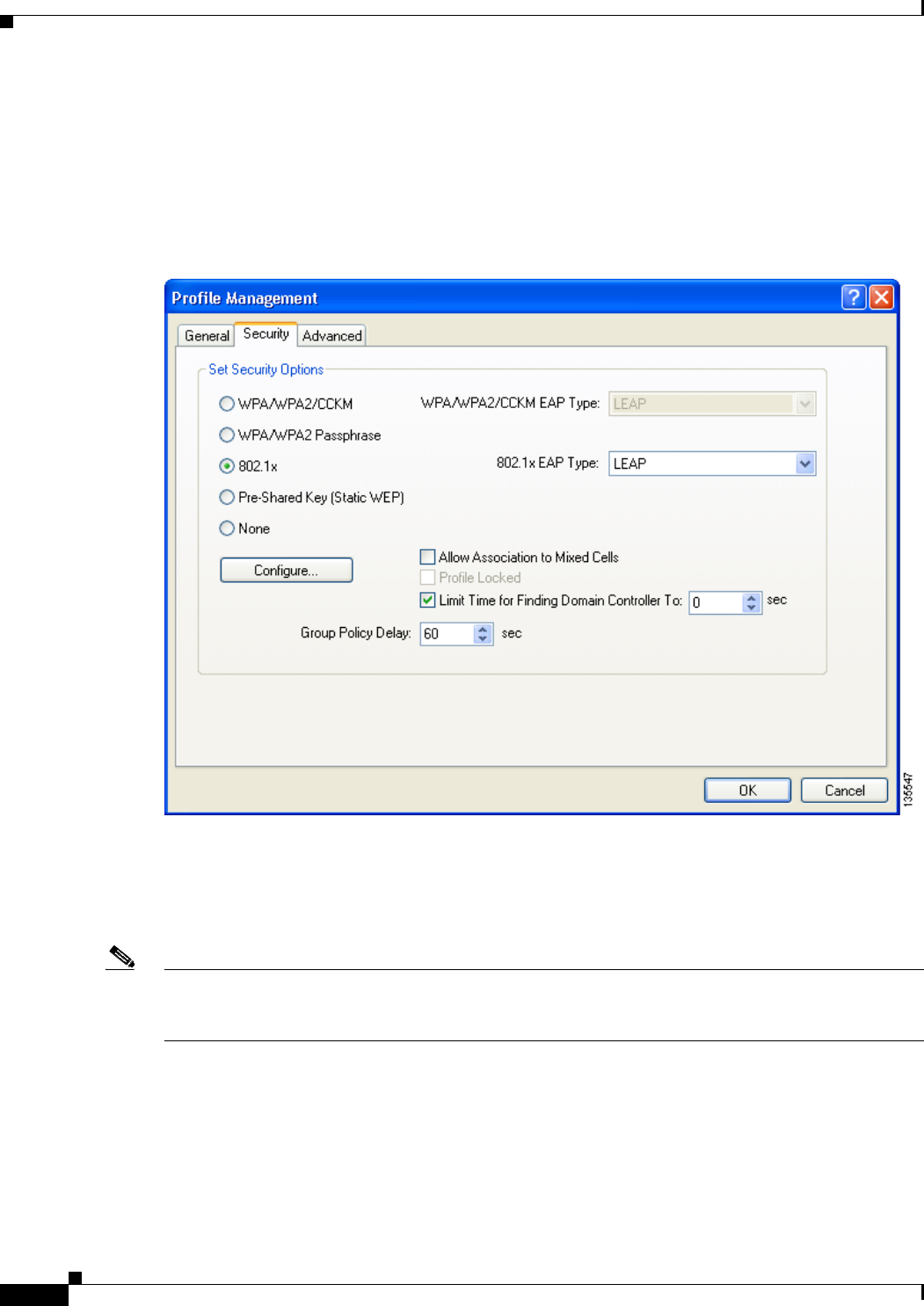
5-14
Cisco Aironet 802.11a/b/g Wireless LAN Client Adapters (CB21AG and PI21AG) Installation and Configuration Guide
OL-4211-05
Chapter 5 Configuring the Client Adapter
Setting Security Parameters
Setting Security Parameters
The Profile Management (Security) window (see Figure 5-4) enables you to set parameters that control
how the client adapter associates to an access point, authenticates to the wireless network, and encrypts
and decrypts data. To access this window, click the Security tab from any Profile Management window.
Figure 5-4 Profile Management (Security) Window
This window is different from the other Profile Management windows in that it includes many security
features, each of which involves a number of steps. In addition, the security features themselves are
complex and need to be understood before they are implemented. Therefore, this section provides an
overview of the security features as well as procedures for enabling them.
Note If your system administrator used an administrative tool to lock this profile, the Profile Locked check
box is checked. Locked profiles cannot be modified (with the exception of password fields), written over,
or removed.
Overview of Security Features
You can protect your data as it is transmitted through your wireless network by encrypting it through the
use of wired equivalent privacy (WEP) encryption keys. With WEP encryption, the transmitting device
encrypts each packet with a WEP key, and the receiving device uses that same key to decrypt each
packet.

5-15
Cisco Aironet 802.11a/b/g Wireless LAN Client Adapters (CB21AG and PI21AG) Installation and Configuration Guide
OL-4211-05
Chapter 5 Configuring the Client Adapter
Setting Security Parameters
The WEP keys used to encrypt and decrypt transmitted data can be statically associated with your
adapter or dynamically created as part of the EAP authentication process. The information in the “Static
WEP Keys” and “EAP (with Dynamic WEP Keys)” sections below can help you to decide which type
of WEP keys you want to use. Dynamic WEP keys with EAP offer a higher degree of security than static
WEP keys.
WEP keys, whether static or dynamic, are either 40 or 128 bits in length. 128-bit WEP keys offer a
greater level of security than 40-bit WEP keys.
Note Refer to the “Additional WEP Key Security Features” on page 5-21 for information on three security
features that can make your WEP keys even more secure.
Static WEP Keys
Each device (or profile) within your wireless network can be assigned up to four static WEP keys. If a
device receives a packet that is not encrypted with the appropriate key (as the WEP keys of all devices
that are to communicate with each other must match), the device discards the packet and never delivers
it to the intended receiver.
You do not need to re-enter static WEP keys each time the client adapter is inserted or the Windows
device is rebooted because the keys are stored (in an encrypted format for security reasons) in the
registry of the Windows device. When the driver loads and reads the client adapter’s registry parameters,
it also finds the static WEP keys, unencrypts them, and stores them in volatile memory on the adapter.
The Define Pre-Shared Keys window enables you to view the WEP key settings for a particular profile
and to assign new WEP keys or overwrite existing WEP keys. Refer to the “Enabling Static WEP” on
page 5-26 for instructions.
EAP (with Dynamic WEP Keys)
The standard for wireless LAN security, as defined by IEEE, is called 802.1X for 802.11, or simply
802.1X. An access point that supports 802.1X and its protocol, Extensible Authentication Protocol
(EAP), acts as the interface between a wireless client and an authentication server, such as a RADIUS
server, to which the access point communicates over the wired network.
Five 802.1X authentication types are available in ADU for use with Windows 2000 or XP:
•EAP-Cisco Wireless (or LEAP)—This authentication type leverages Cisco Key Integrity Protocol
(CKIP) and MMH message integrity check (MIC) for data protection. ADU offers a variety of LEAP
configuration options, including how a username and password are entered to begin the
authentication process.
The username and password are used by the client adapter to perform mutual authentication with the
RADIUS server through the access point. The username and password need to be re-entered each
time the client adapter is inserted or the Windows device is rebooted unless you configure your
adapter to use saved LEAP credentials.
RADIUS servers that support LEAP include Cisco Secure ACS release 2.6 or later, Cisco Access
Registrar release 1.7 or later, Funk Software’s Steel-Belted RADIUS release 4.1 or later, and
Meetinghouse Data Communications’ AEGIS release 1.1 or later.

5-16
Cisco Aironet 802.11a/b/g Wireless LAN Client Adapters (CB21AG and PI21AG) Installation and Configuration Guide
OL-4211-05
Chapter 5 Configuring the Client Adapter
Setting Security Parameters
•EAP-FAST—This authentication type (Flexible Authentication via Secure Tunneling) uses a
three-phased tunneled authentication process to provide advanced 802.1X EAP mutual
authentication.
–
Phase 0 enables the client to dynamically provision a protected access credential (PAC) when
necessary. During this phase, a PAC is generated securely between the user and the network.
–
Phase 1 uses the PAC to establish a mutually authenticated and secure tunnel between the client
and the RADIUS server. RADIUS servers that support EAP-FAST include Cisco Secure ACS
version 3.2.3 and later.
–
Phase 2 performs client authentication in the established tunnel.
ADU offers a variety of EAP-FAST configuration options, including how and when a username and
password are entered to begin the authentication process and whether automatic or manual PAC
provisioning is used.
The client adapter uses the username, password, and PAC to perform mutual authentication with the
RADIUS server through the access point. The username and password need to be re-entered each
time the client adapter is inserted or the Windows device is rebooted unless you configure your
adapter to use saved EAP-FAST credentials.
PACs are created by Cisco Secure ACS and are identified by an ID. The user obtains his or her own
copy of the PAC from the server, and the ID links the PAC to the profile created in ADU. When
manual PAC provisioning is enabled, the PAC is manually copied from the server and imported onto
the client device. The following rules govern PAC storage:
–
PACs are stored as encrypted data files in either the global or private store on the user’s
computer.
•Global PACs can be accessed and used by any user at any logon stage. They are available
before or during logon or after the user is logged off if the profile is not configured with the
No Network Connection Unless User Is Logged In option.
•Private PACs can be accessed and used only by the user who provisioned them or the system
administrator.
Note Global PACs are stored on C:\Document and Settings\All Users\Application
Data\Cisco\cscostore, and private PACs are stored on C:\Document and Settings\user\
Application Data\Cisco\cscostore.
–
If automatic PAC provisioning is enabled and it occurs after the user is logged on, the PAC is
stored in the private store of the currently logged-on user. Otherwise, the PAC is stored in the
global store.
–
PAC files can be added or overwritten using the import feature.
–
PAC files can be removed using the delete feature. They are also deleted when you uninstall the
client adapter software.
–
PAC files are tied to the machine, so they cannot be used if copied to another machine.

5-17
Cisco Aironet 802.11a/b/g Wireless LAN Client Adapters (CB21AG and PI21AG) Installation and Configuration Guide
OL-4211-05
Chapter 5 Configuring the Client Adapter
Setting Security Parameters
EAP-FAST authentication is designed to support the following user databases over a wireless LAN:
–
Cisco Secure ACS internal user database
–
Cisco Secure ACS ODBC user database
–
Windows NT/2000/2003 domain user database
–
LDAP user database
LDAP user databases (such as NDS) support only manual PAC provisioning while the other three
user databases support both automatic and manual PAC provisioning.
Note PACs that are created by ACS version 3.x.xx are not compatible with ACS version 4.0.xx. Client
stations must import new PACs. If you select auto-provisioning, new PACs will automatically be
generated and used. However, if you select manual provisioning, you must manually export new
PACs to the client stations. If a user wants to authenticate to ACS version 4.0.xx and version
3.x.xx at different times, both PACs must remain on the client station. The ADU is capable of
automatically selecting the appropriate PAC. However, if you experiences authentication failures
after upgrading the software, delete all the PACs provisioned from the 3.x.xx server.
•EAP-TLS—This authentication type uses a dynamic session-based WEP key derived from the
client adapter and RADIUS server to encrypt data. It uses a client certificate for authentication.
RADIUS servers that support EAP-TLS include Cisco Secure ACS release 3.0 or later and Cisco
Access Registrar release 1.8 or later.
•PEAP (EAP-GTC)—This PEAP authentication type is designed to support One-Time Password
(OTP), Windows NT or 2000 domain, and LDAP user databases over a wireless LAN. It is based on
EAP-TLS authentication but uses a password instead of a client certificate for authentication. PEAP
(EAP-GTC) uses a dynamic session-based WEP key derived from the client adapter and RADIUS
server to encrypt data. If your network uses an OTP user database, PEAP (EAP-GTC) requires you
to enter a hardware or software token password to start the EAP authentication process and gain
access to the network. If your network uses a Windows NT or 2000 domain user database or an
LDAP user database (such as NDS), PEAP (EAP-GTC) requires you to enter your username,
password, and domain name in order to start the authentication process.
RADIUS servers that support PEAP (EAP-GTC) authentication include Cisco Secure ACS release
3.1 or later.
•PEAP (EAP-MSCHAP V2)—This PEAP authentication type is based on EAP-TLS authentication
but uses a password or client certificate for authentication. PEAP (EAP-MSCHAP V2) uses a
dynamic session-based WEP key derived from the client adapter and RADIUS server to encrypt
data.
RADIUS servers that support PEAP (EAP-MSCHAP V2) authentication include Cisco Secure ACS
release 3.2 or later.
When you configure your access point as indicated in Table 5-4 on page 5-22 and configure your client
adapter for LEAP, EAP-FAST, EAP-TLS, PEAP (EAP-GTC), or PEAP (EAP-MSCHAP V2),
authentication to the network occurs in the following sequence:
1. The client associates to an access point and begins the authentication process.
Note The client does not gain full access to the network until authentication between the client
and the RADIUS server is successful.

5-18
Cisco Aironet 802.11a/b/g Wireless LAN Client Adapters (CB21AG and PI21AG) Installation and Configuration Guide
OL-4211-05
Chapter 5 Configuring the Client Adapter
Setting Security Parameters
2. Communicating through the access point, the client and RADIUS server complete the authentication
process, with the password (LEAP and PEAP), PAC (EAP-FAST), or certificate (EAP-TLS and
PEAP) being the shared secret for authentication. The password and PAC are never transmitted
during the process.
3. If authentication is successful, the client and RADIUS server derive a dynamic, session-based WEP
key that is unique to the client.

5-19
Cisco Aironet 802.11a/b/g Wireless LAN Client Adapters (CB21AG and PI21AG) Installation and Configuration Guide
OL-4211-05
Chapter 5 Configuring the Client Adapter
Setting Security Parameters
4. The RADIUS server transmits the key to the access point using a secure channel on the wired LAN.
5. For the length of a session, or time period, the access point and the client use this key to encrypt or
decrypt all unicast packets (and broadcast packets if the access point is set up to do so) that travel
between them.
Refer to the following pages for instructions on enabling these EAP types:
•LEAP, page 5-29
•EAP-FAST, page 5-34
•EAP-TLS, PEAP (EAP-GTC), or PEAP (EAP-MSCHAP V2), page 5-44
Note Refer to the IEEE 802.11 Standard for more information on 802.1X authentication and to the following
URL for additional information on RADIUS servers:
http://www.cisco.com/en/US/products/sw/iosswrel/ps1835/products_configuration_guide_chapter0918
6a00800ca7ab.html
WPA and WPA2
Wi-Fi Protected Access (WPA) and WPA2 are standards-based security solutions from the Wi-Fi
Alliance that provide data protection and access control for wireless LAN systems. WPA is compatible
with the IEEE 802.11i standard but was implemented prior to the standard’s ratification; WPA2 is the
Wi-Fi Alliance’s implementation of the ratified IEEE 802.11i standard.
WPA uses Temporal Key Integrity Protocol (TKIP) and message integrity check (MIC) for data
protection while WPA2 uses the stronger Advanced Encryption Standard encryption algorithm using
Counter Mode with Cipher Block Chaining Message Authentication Code Protocol (AES-CCMP). Both
WPA and WPA2 use 802.1X for authenticated key management.
Both WPA and WPA2 support two mutually exclusive key management types: WPA/WPA2 and
WPA/WPA2 passphrase (also known as WPA pre-shared key or WPA-PSK). Using WPA or WPA2, clients
and the authentication server authenticate to each other using an EAP authentication method, and the
client and server generate a pairwise master key (PMK). The server generates the PMK dynamically and
passes it to the access point. Using WPA or WPA2 passphrase, however, you configure a passphrase (or
pre-shared key) on both the client and the access point, and that passphrase is used as the PMK.
Refer to the following pages for instructions on enabling these WPA variations:
•WPA/WPA2 passphrase, page 5-28
•LEAP with WPA/WPA2, page 5-29
•EAP-FAST with WPA/WPA2, page 5-34
•EAP-TLS with WPA/WPA2, page 5-45
•PEAP (EAP-GTC) with WPA/WPA2, page 5-48
•PEAP (EAP-MSCHAP V2) with WPA/WPA2, page 5-52
Note WPA must also be enabled on the access point. To use WPA, access points must use Cisco IOS Release
12.2(11)JA or later. To use WPA2, access points must use Cisco IOS Release 12.3(2)JA or later. Refer
to the documentation for your access point for instructions on enabling this feature.

5-20
Cisco Aironet 802.11a/b/g Wireless LAN Client Adapters (CB21AG and PI21AG) Installation and Configuration Guide
OL-4211-05
Chapter 5 Configuring the Client Adapter
Setting Security Parameters
CCKM Fast Secure Roaming
Some applications that run on a client device may require fast roaming between access points. Voice
applications, for example, require it to prevent delays and gaps in conversation. CCKM fast secure
roaming is enabled automatically for CB21AG and PI21AG clients using WPA/WPA2/CCKM with
LEAP, EAP-FAST, EAP-TLS, PEAP (EAP-GTC), or PEAP (EAP-MSCHAP V2). However, this feature
must be enabled on the access point.
During normal operation, EAP-enabled clients mutually authenticate with a new access point by
performing a complete EAP authentication, including communication with the main RADIUS server.
However, when you configure your wireless LAN for CCKM fast secure roaming, EAP-enabled clients
securely roam from one access point to another without the need to reauthenticate with the RADIUS
server. Using Cisco Centralized Key Management (CCKM), an access point that is configured for
wireless domain services (WDS) uses a fast rekeying technique that enables Cisco client devices to roam
from one access point to another typically in under 150 milliseconds (ms). CCKM fast secure roaming
ensures that there is no perceptible delay in time-sensitive applications such as wireless Voice over IP
(VoIP), enterprise resource planning (ERP), or Citrix-based solutions.
Note If you want to enable CCKM fast secure roaming on the client adapter, you must choose the
WPA/WPA2/CCKM security option on the Profile Management (Security) window, regardless of
whether you want the adapter to use WPA or WPA2. The configuration of the access point to which your
client adapter associates determines whether CCKM will be used with 802.1x, WPA, or WPA2.
Note Access points must use Cisco IOS Release 12.2(11)JA or later to enable CCKM fast secure roaming.
Refer to the documentation for your access point for instructions on enabling this feature.
Note The Microsoft Wireless Configuration Manager and the Microsoft 802.1X supplicant, if installed, must
be disabled in order for CCKM fast secure roaming to operate correctly. If your computer is running
Windows XP and you chose to configure your client adapter using ADU during installation, these
features should already be disabled. Similarly, if your computer is running Windows 2000, the Microsoft
802.1X supplicant, if installed, should already be disabled. Refer to Chapter 10 if you need additional
information.
Reporting Access Points that Fail LEAP Authentication
The CB21AG and PI21AG client adapters and the following access point firmware versions support a
feature that is designed to detect access points that fail LEAP authentication:
•12.00T or later (access points running VxWorks)
•Cisco IOS Release 12.2(4)JA or later (1100 series access points)
•Cisco IOS Release 12.2(8)JA or later (1200 series access points)
•Cisco IOS Release 12.2(13)JA or later (350 series access points)
•Cisco IOS Release 12.3(4)JA (1130 series and BR 1310 series access points)
•Cisco IOS Release 12.3(7)JA (1240 series access points)
An access point running one of these firmware versions records a message in the system log when the
client discovers and reports another access point in the wireless network that has failed LEAP
authentication.

5-21
Cisco Aironet 802.11a/b/g Wireless LAN Client Adapters (CB21AG and PI21AG) Installation and Configuration Guide
OL-4211-05
Chapter 5 Configuring the Client Adapter
Setting Security Parameters
The process takes place as follows:
1. A client with a LEAP profile attempts to associate to access point A.
2. Access point A does not handle LEAP authentication successfully, perhaps because the access point
does not understand LEAP or cannot communicate to a trusted LEAP authentication server.
3. The client records the MAC address for access point A and the reason why the association failed.
4. The client associates successfully to access point B.
5. The client sends the MAC address of access point A and the reason code for the failure to access
point B.
6. Access point B logs the failure in the system log.
Note This feature does not need to be enabled on the client adapter or access point; it is supported
automatically by both devices. However, the access points must use the specified firmware versions
or later.
Additional WEP Key Security Features
The three security features discussed in this section (MIC, TKIP, and broadcast key rotation) are
designed to prevent sophisticated attacks on your wireless network’s WEP keys. These features do not
need to be enabled on the client adapter; they are supported automatically in the client adapter software.
However, they must be enabled on the access point.
Note Refer to the documentation for your access point for instructions on enabling these security features.
Message Integrity Check (MIC)
MIC prevents bit-flip attacks on encrypted packets. During a bit-flip attack, an intruder intercepts an
encrypted message, alters it slightly, and retransmits it, and the receiver accepts the retransmitted
message as legitimate. The MIC adds a few bytes to each packet to make the packets tamper-proof.
The Advanced Status window indicates if MIC is being used, and the Advanced Statistics window
provides MIC statistics.
Temporal Key Integrity Protocol (TKIP)
This feature, also referred to as WEP key hashing, defends against an attack on WEP in which the
intruder uses the initialization vector (IV) in encrypted packets to calculate the WEP key. TKIP removes
the predictability that an intruder relies on to determine the WEP key by exploiting IVs. It protects both
unicast and broadcast WEP keys.
Note TKIP is enabled automatically when WPA is enabled.
Broadcast Key Rotation
When you enable broadcast WEP key rotation, the access point provides a dynamic broadcast WEP key
and changes it at the interval you select.

5-22
Cisco Aironet 802.11a/b/g Wireless LAN Client Adapters (CB21AG and PI21AG) Installation and Configuration Guide
OL-4211-05
Chapter 5 Configuring the Client Adapter
Setting Security Parameters
Synchronizing Security Features
In order to use any of the security features discussed in this section, both your client adapter and the
access point to which it will associate must be set appropriately. Table 5-4 indicates the client and access
point settings required for each security feature. This chapter provides specific instructions for enabling
the security features on your client adapter. Refer to the documentation for your access point for
instructions on enabling any of these features on the access point.
Table 5-4 Client and Access Point Security Settings
Security Feature Client Setting Access Point Setting
Static WEP with open
authentication
Choose Open authentication and
Pre-Shared Key (Static WEP) and
create a WEP key
Set up and enable WEP and enable
Open Authentication for the SSID
Static WEP with shared key
authentication
Choose Shared authentication and
Pre-Shared Key (Static WEP) and
create a WEP key
Set up and enable WEP and enable
Shared Key Authentication for the
SSID
WPA or WPA2 passphrase
(or WPA or WPA2
pre-shared key)
Choose WPA/WPA2 Passphrase
and enter the passphrase
Choose a cipher suite, enable Open
Authentication and WPA for the
SSID, and enter a WPA pre-shared
key
Note To allow both WPA and
non-WPA clients to use the
SSID, enable optional
WPA.
LEAP authentication Choose 802.1x and LEAP; then set
LEAP settings
Set up and enable WEP and enable
Network-EAP Authentication for
the SSID
LEAP authentication with
WPA or WPA2
Choose WPA/WPA2/CCKM and
LEAP; then set LEAP settings
For WPA, choose a cipher suite that
includes TKIP and enable
Network-EAP and Open with EAP
Authentication and WPA for the
SSID
For WPA2, choose a cipher suite
that includes AES-CCMP and
enable Network-EAP and Open
with EAP Authentication and WPA
for the SSID
Note To allow both WPA and
non-WPA clients to use the
SSID, enable optional
WPA.

5-23
Cisco Aironet 802.11a/b/g Wireless LAN Client Adapters (CB21AG and PI21AG) Installation and Configuration Guide
OL-4211-05
Chapter 5 Configuring the Client Adapter
Setting Security Parameters
EAP-FAST authentication Choose 802.1x and EAP-FAST, set
EAP-FAST settings, and enable
automatic provisioning or import a
PAC file
Set up and enable WEP and enable
both Network-EAP and Open with
EAP Authentication for the SSID
EAP-FAST authentication
with WPA or WPA2
Choose WPA/WPA2/CCKM and
EAP-FAST, set EAP-FAST
settings, and enable automatic
provisioning or import a PAC file
For WPA, choose a cipher suite that
includes TKIP and enable both
Network-EAP and Open with EAP
Authentication as well as WPA for
the SSID
For WPA2, choose a cipher suite
that includes AES-CCMP and
enable both Network-EAP and
Open with EAP Authentication as
well as WPA for the SSID
Note To allow both WPA and
non-WPA clients to use the
SSID, enable optional
WPA.
EAP-TLS authentication
If using ADU to
configure card
Choose 802.1x and EAP-TLS; then
set EAP-TLS settings
Set up and enable WEP and enable
Open with EAP Authentication for
the SSID
If using Windows XP
to configure card
Choose Enable network access
control using IEEE 802.1X and
Smart Card or other Certificate as
the EAP Type
Set up and enable WEP and enable
Open with EAP Authentication for
the SSID
EAP-TLS authentication with WPA or WPA2
If using ADU to
configure card
Choose WPA/WPA2/CCKM and
EAP-TLS; then set EAP-TLS
settings
For WPA, choose a cipher suite that
includes TKIP; then enable WPA
and Open with EAP Authentication
for the SSID
For WPA2, choose a cipher suite
that includes AES-CCMP; then
enable WPA and Open with EAP
Authentication for the SSID
Note To allow both WPA and
non-WPA clients to use the
SSID, enable optional
WPA.
Table 5-4 Client and Access Point Security Settings (continued)
Security Feature Client Setting Access Point Setting

5-24
Cisco Aironet 802.11a/b/g Wireless LAN Client Adapters (CB21AG and PI21AG) Installation and Configuration Guide
OL-4211-05
Chapter 5 Configuring the Client Adapter
Setting Security Parameters
If using Windows XP
to configure card
Enable WPA and choose Enable
network access control using IEEE
802.1X and Smart Card or other
Certificate as the EAP Type
Note WPA2 is not yet available
in the Microsoft Wireless
Configuration Manager in
Windows XP.
For WPA, choose a cipher suite that
includes TKIP; then enable WPA
and Open with EAP Authentication
for the SSID
Note To allow both WPA and
non-WPA clients to use the
SSID, enable optional
WPA.
PEAP authentication
If using ADU to
configure card
Choose 802.1x and PEAP
(EAP-GTC) or PEAP
(EAP-MSCHAP V2); then set
PEAP settings
Set up and enable WEP and enable
Open with EAP Authentication for
the SSID
If using Windows XP
to configure card
Choose Enable network access
control using IEEE 802.1X and
PEAP as the EAP Type
Set up and enable WEP and enable
Open with EAP Authentication for
the SSID
PEAP authentication with WPA or WPA2
If using ADU to
configure card
Choose WPA/WPA2/CCKM and
PEAP (EAP-GTC) or PEAP
(EAP-MSCHAP V2); then set
PEAP settings
For WPA, choose a cipher suite that
includes TKIP; then enable WPA
and Open with EAP Authentication
for the SSID
For WPA2, choose a cipher suite
that includes AES-CCMP; then
enable WPA and Open with EAP
Authentication for the SSID
Note To allow both WPA and
non-WPA clients to use the
SSID, enable optional
WPA.
If using Windows XP
to configure card
Enable WPA and choose Enable
network access control using IEEE
802.1X and PEAP as the EAP Type
Note WPA2 is not yet available
in the Microsoft Wireless
Configuration Manager in
Windows XP.
For WPA, choose a cipher suite that
includes TKIP; then enable WPA
and Open with EAP Authentication
for the SSID
Note To allow both WPA and
non-WPA clients to use the
SSID, enable optional
WPA.
Table 5-4 Client and Access Point Security Settings (continued)
Security Feature Client Setting Access Point Setting

5-25
Cisco Aironet 802.11a/b/g Wireless LAN Client Adapters (CB21AG and PI21AG) Installation and Configuration Guide
OL-4211-05
Chapter 5 Configuring the Client Adapter
Setting Security Parameters
CCKM fast secure roaming Choose WPA/WPA2/CCKM and
LEAP, EAP-FAST, EAP-TLS,
PEAP (EAP-GTC), or PEAP (EAP
MSCHAP V2); then set the EAP
authentication settings
Note If you want to enable
CCKM, you must choose
WPA/WPA2/CCKM,
regardless of whether you
want the client adapter to
use WPA or WPA2. The
configuration of the access
point to which your client
adapter associates
determines whether CCKM
will be used with 802.1x,
WPA, or WPA2.
Use Cisco IOS Release 12.2(11)JA
or later, choose a cipher suite that is
compatible with CCKM, enable
both Network-EAP and Open with
EAP Authentication and CCKM
for the SSID, and configure for
participation in wireless domain
services (WDS)
Note To allow both 802.1X
clients and non-802.1X
clients to use the SSID,
enable optional CCKM.
Reporting access points
that fail LEAP
authentication
No settings required; automatically
enabled
No settings required; automatically
enabled in the firmware versions
listed on page 5-20.
MIC No settings required; automatically
enabled
Set up and enable WEP with full
encryption, set MIC to MMH or
check the Enable MIC check box,
and set Use Aironet Extensions to
Yes
TKIP No settings required; automatically
enabled
Set up and enable WEP, set TKIP to
Cisco or check the Enable Per
Packet Keying check box, and set
Use Aironet Extensions to Yes
Broadcast key rotation Enable LEAP, EAP-FAST,
EAP-TLS, PEAP (EAP-GTC), or
PEAP (EAP-MSCHAP V2)
Set up and enable WEP and set
Broadcast WEP Key Rotation
Interval to any value other than
zero (0)
Table 5-4 Client and Access Point Security Settings (continued)
Security Feature Client Setting Access Point Setting
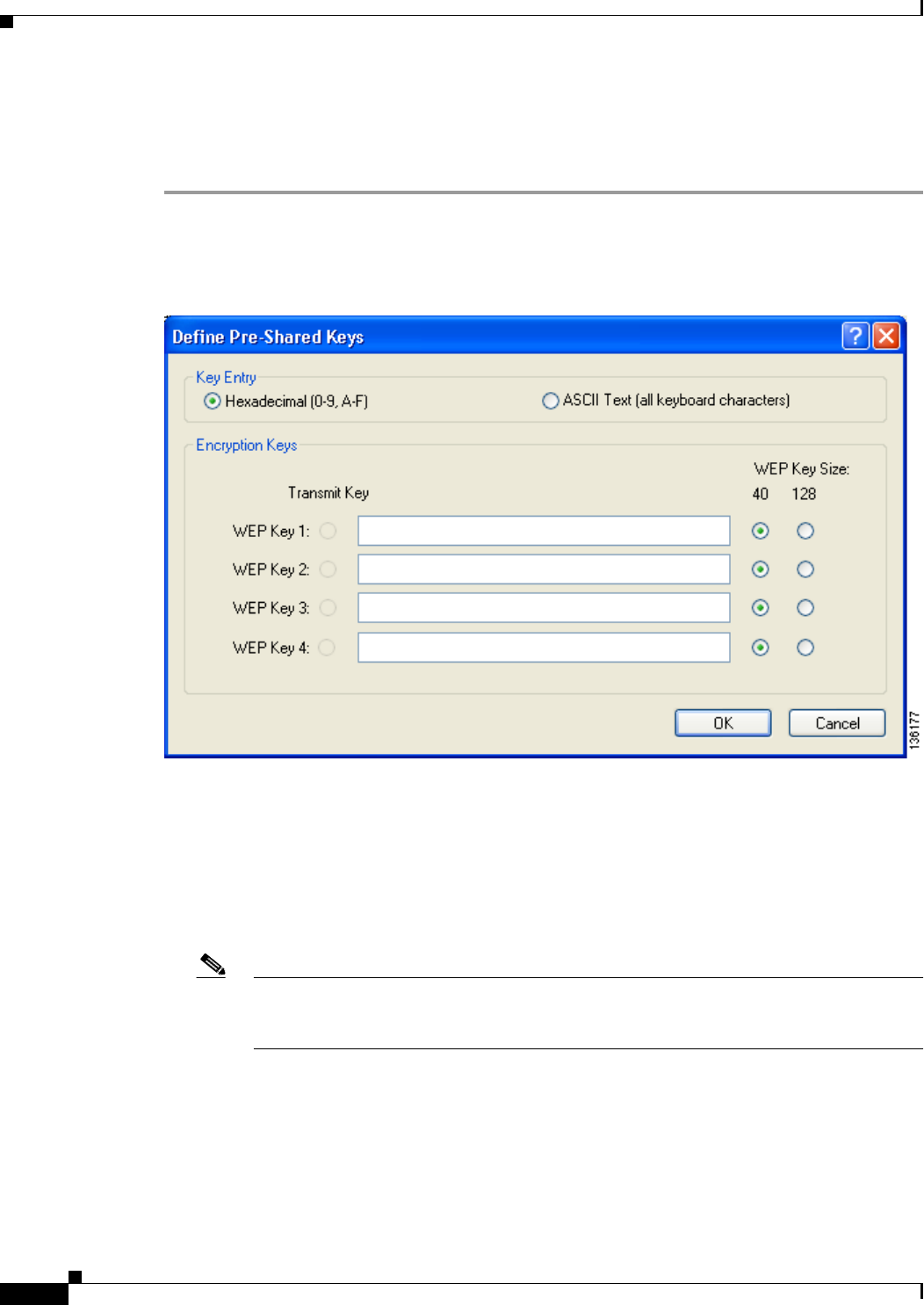
5-26
Cisco Aironet 802.11a/b/g Wireless LAN Client Adapters (CB21AG and PI21AG) Installation and Configuration Guide
OL-4211-05
Chapter 5 Configuring the Client Adapter
Setting Security Parameters
Enabling Static WEP
Follow the steps below to enable static WEP for this profile.
Step 1 Choose Pre-Shared Key (Static WEP) on the Profile Management (Security) window.
Step 2 Click Configure. The Define Pre-Shared Keys window appears (see Figure 5-5).
Figure 5-5 Define Pre-Shared Keys Window
Step 3 Choose one of the following WEP key entry methods:
•Hexadecimal (0-9, A-F)—Specifies that the WEP key will be entered in hexadecimal characters,
which include 0-9, A-F, and a-f.
•ASCII Text (all keyboard characters)—Specifies that the WEP key will be entered in ASCII text,
which includes alpha characters, numbers, and punctuation marks.
Note ASCII text WEP keys are not supported on the Cisco Aironet 1200 Series Access Points, so
you must choose the Hexadecimal (0-9, A-F) option if you are planning to use your client
adapter with these access points.
Step 4 For the static WEP key that you are entering (1, 2, 3, or 4), choose a WEP key size of 40 or 128 on the
right side of the window. 21AG client adapters can use 40- or 128-bit keys.

5-27
Cisco Aironet 802.11a/b/g Wireless LAN Client Adapters (CB21AG and PI21AG) Installation and Configuration Guide
OL-4211-05
Chapter 5 Configuring the Client Adapter
Setting Security Parameters
Step 5 Obtain the static WEP key from your system administrator and enter it in the blank field for the key you
are creating. Follow the guidelines below to enter a new static WEP key:
•WEP keys must contain the following number of characters:
–
10 hexadecimal characters or 5 ASCII text characters for 40-bit keys
Example: 5A5A313859 (hexadecimal) or ZZ18Y (ASCII)
–
26 hexadecimal characters or 13 ASCII text characters for 128-bit keys
Example: 5A583135333554595549333534 (hexadecimal) or ZX1535TYUI354 (ASCII)
Note You must enter hexadecimal characters if your client adapter will be used with Cisco Aironet
1200 Series Access Points.
•Your client adapter’s WEP key must match the WEP key used by the access point (in infrastructure
mode) or clients (in ad hoc mode) with which you are planning to communicate.
•When setting more than one WEP key, the keys must be assigned to the same WEP key numbers for
all devices. For example, WEP key 2 must be WEP key number 2 on all devices. When multiple
WEP keys are set, they must be in the same order on all devices.
Note All existing static WEP keys are displayed as bullets for security reasons. If you need to modify
a WEP key, simply click in the WEP key field, delete the bullets, and enter a new key.
Step 6 Click the Transmit Key button to the left of the key you want to use to transmit packets. Only one WEP
key can be selected as the transmit key.
Step 7 Click OK to save your settings and return to the Profile Management (Security) window.
Step 8 Perform one of the following to set the Allow Association to Mixed Cells parameter, which indicates
whether the client adapter can associate to an access point that allows both WEP and non-WEP
associations:
•Check the Allow Association to Mixed Cells check box if the access point to which the client
adapter is to associate (or the VLAN to which the client will be assigned) has WEP set to Optional.
Otherwise, the client is unable to establish a connection with the access point.
•Uncheck the Allow Association to Mixed Cells check box if the access point to which the client
adapter is to associate (or the VLAN to which the client will be assigned) does not have WEP set to
Optional. This is the default setting.
Note For security reasons, Cisco recommends that WEP-enabled and WEP-disabled clients not be
allowed in the same cell because broadcast packets are sent unencrypted, even to clients running
WEP. However, you can enable VLANs on the access point to separate WEP-enabled and
WEP-disabled clients.
Step 9 Click OK to save your settings and return to the Cisco Aironet Desktop Utility (Profile Management) window.
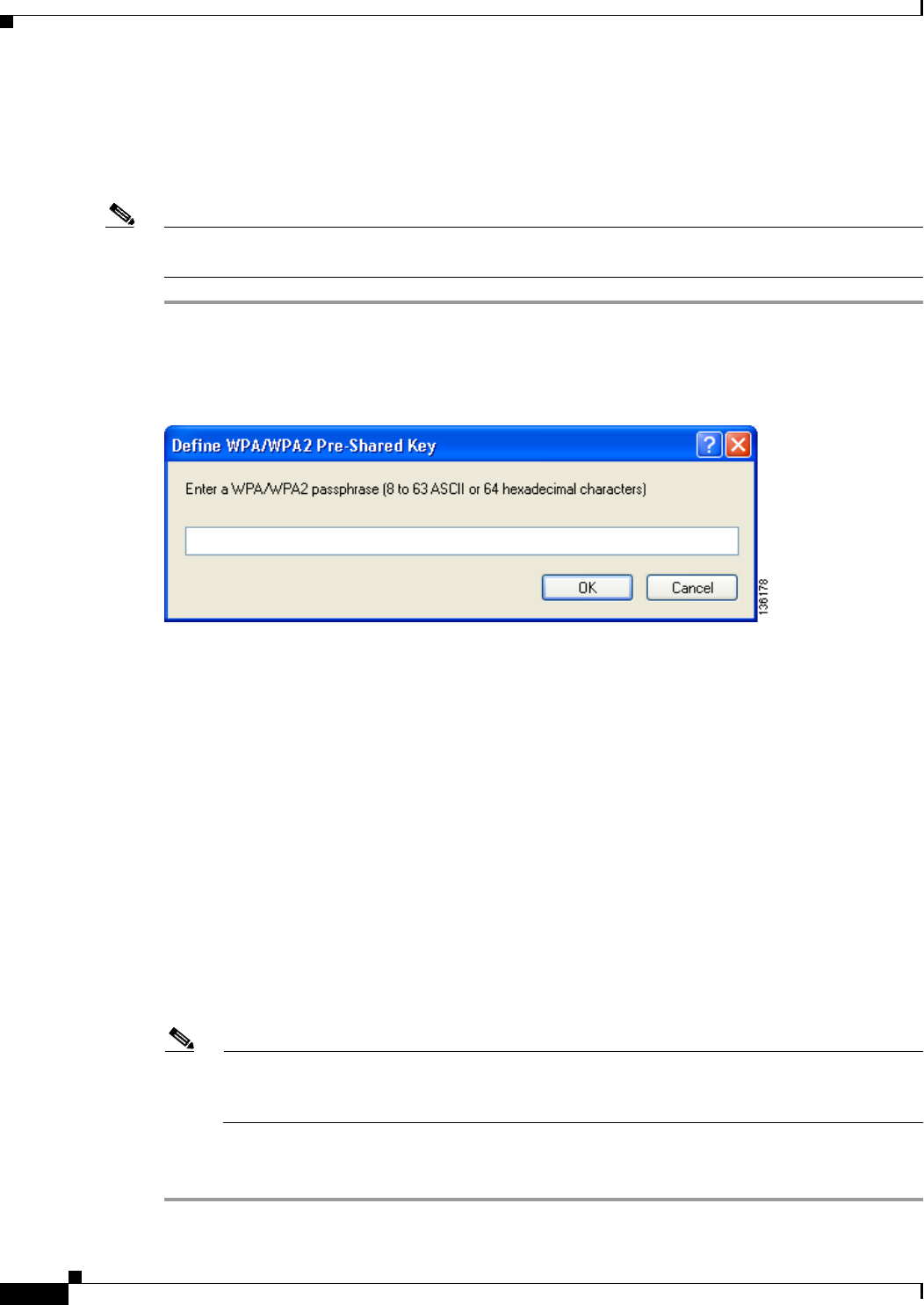
5-28
Cisco Aironet 802.11a/b/g Wireless LAN Client Adapters (CB21AG and PI21AG) Installation and Configuration Guide
OL-4211-05
Chapter 5 Configuring the Client Adapter
Setting Security Parameters
Enabling WPA/WPA2 Passphrase
Follow the steps below to enable WPA/WPA2 passphrase (also known as WPA/WPA2 pre-shared key) for
this profile.
Note To use WPA passphrase, access points must use Cisco IOS Release 12.2(11)JA or later. To use WPA2
passphrase, access points must use Cisco IOS Release 12.3(2)JA or later.
Step 1 Choose WPA/WPA2 Passphrase on the Profile Management (Security) window.
Step 2 Click Configure. The Define WPA/WPA2 Pre-Shared Key window appears (see Figure 5-6).
Figure 5-6 Define WPA/WPA2 Pre-Shared Key Window
Step 3 Obtain the WPA/WPA2 passphrase for the access point (in an infrastructure network) or other clients (in
an ad hoc network) from your system administrator and enter it in the WPA/WPA2 passphrase field.
Follow the guidelines below to enter a passphrase:
•WPA/WPA2 passphrases must contain 8 to 63 ASCII text characters or 64 hexadecimal characters.
•Your client adapter’s WPA/WPA2 passphrase must match the passphrase used by the access point
with which you are planning to communicate.
Step 4 Click OK to save the passphrase and return to the Profile Management (Security) window.
Step 5 If you want to change the value of the Group Policy Delay parameter, enter a new value or use the up
and down arrows to select a value between 0 and 65535 seconds. (Microsoft supports only values
between 30 and 600 seconds. The default value is 60 seconds.)
The Group Policy Delay parameter specifies how much time elapses before the Windows logon process
starts Group Policy, a Windows feature used by administrators to specify configuration options for
groups of users. The objective is to delay the start of Group Policy until wireless network authentication
occurs. The value that you set for this parameter goes into effect after the computer reboots with this
profile set as the active profile.
Note A Microsoft hot fix is required in order to use this parameter on computers running Windows
2000. Refer to the “Installing a Microsoft Hot Fix for Group Policy Delay” on page 3-21 for
information on obtaining and installing the hot fix.
Step 6 Click OK to save your settings and return to the Cisco Aironet Desktop Utility (Profile Management)
window.

5-29
Cisco Aironet 802.11a/b/g Wireless LAN Client Adapters (CB21AG and PI21AG) Installation and Configuration Guide
OL-4211-05
Chapter 5 Configuring the Client Adapter
Setting Security Parameters
Enabling LEAP
Before you can enable LEAP authentication, your network devices must meet the following
requirements:
•Access points to which your client adapter may attempt to authenticate must use the following
firmware versions or later: 11.23T (access points running VxWorks), Cisco IOS Release 12.2(4)JA
(1100 series access points), Cisco IOS Release 12.2(8)JA (1200 series access points), Cisco IOS
Release 12.3(4)JA (1130 series and BR 1310 series access points), Cisco IOS Release 12.3(7)JA
(1240 series access points), or Cisco IOS Release 12.2(13)JA (350 series access points).
Note To use WPA or CCKM, access points must use Cisco IOS Release 12.2(11)JA or later. To
use WPA2, access points must use Cisco IOS Release 12.3(2)JA or later. To use the
Reporting Access Points That Fail LEAP Authentication feature, access points must use the
firmware versions listed on page 5-22.
•All necessary infrastructure devices (such as access points, servers, etc.) must be properly
configured for LEAP authentication.
Follow the steps below to enable LEAP authentication for this profile.
Step 1 Perform one of the following on the Profile Management (Security) window:
•If you want to enable LEAP without WPA or WPA2, choose 802.1x under Set Security Options and
LEAP in the 802.1x EAP Type drop-down box.
•If you want to enable LEAP with WPA or WPA2, choose WPA/WPA2/CCKM under Set Security
Options and LEAP in the WPA/WPA2/CCKM EAP Type drop-down box.
Note If you want to enable CCKM on the client adapter, you must choose the WPA/WPA2/CCKM
security option, regardless of whether you want the adapter to use WPA or WPA2. The
configuration of the access point to which your client adapter associates determines whether
CCKM will be used with 802.1x, WPA, or WPA2.
Note Refer to the “WPA and WPA2” on page 5-19 for additional information.
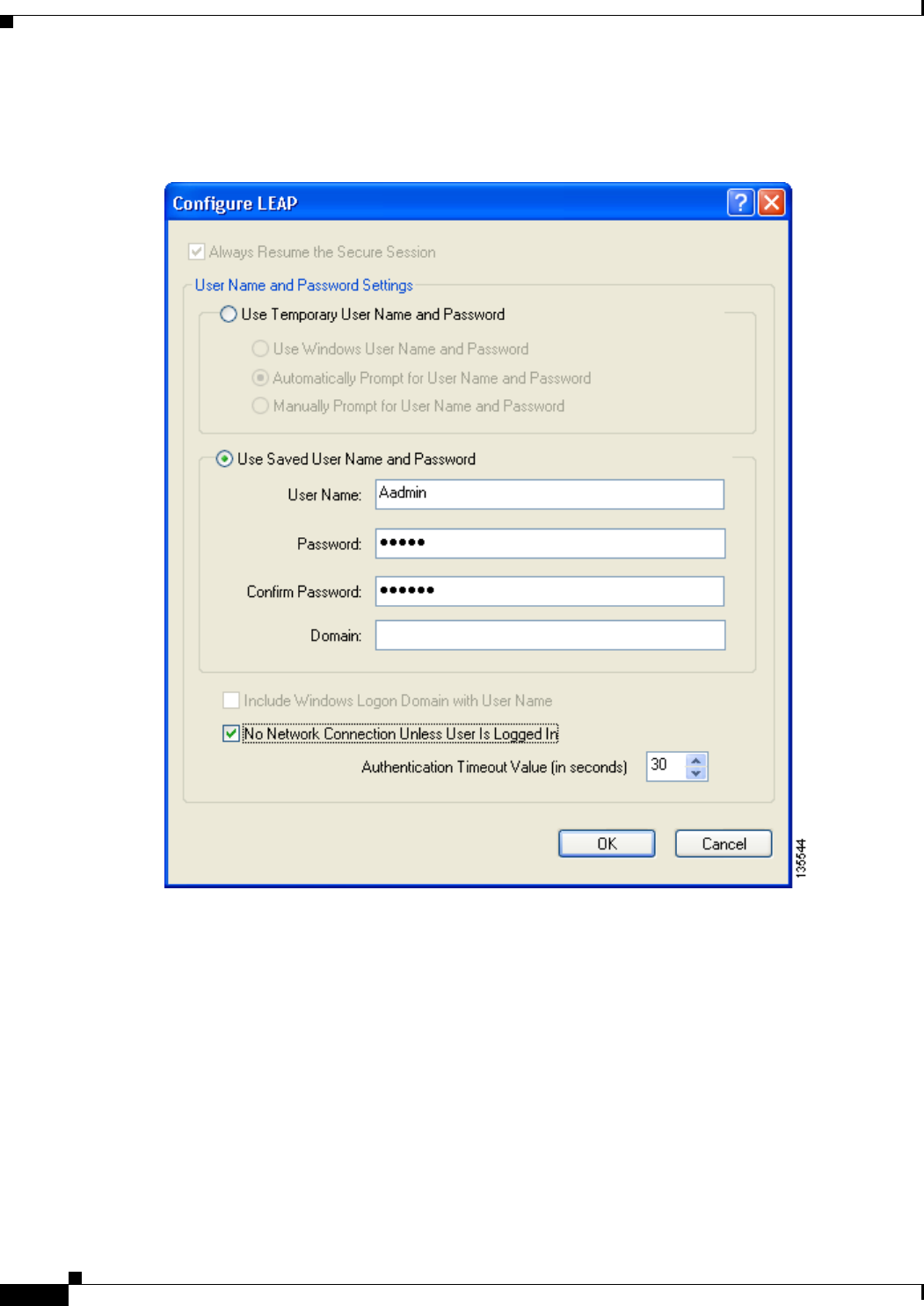
5-30
Cisco Aironet 802.11a/b/g Wireless LAN Client Adapters (CB21AG and PI21AG) Installation and Configuration Guide
OL-4211-05
Chapter 5 Configuring the Client Adapter
Setting Security Parameters
Step 2 Click Configure. The Configure LEAP window appears (see Figure 5-7).
Figure 5-7 Configure LEAP Window
Step 3 Choose one of the following LEAP username and password setting options:
•Use Temporary User Name and Password—Requires you to enter the LEAP username and
password each time the computer reboots in order to authenticate and gain access to the network,
unless you choose Use Windows User Name and Password.
•Use Saved User Name and Password—Does not require you to enter a LEAP username and
password each time the computer reboots. Authentication occurs automatically as needed using a
saved username and password (which are registered with the RADIUS server).

5-31
Cisco Aironet 802.11a/b/g Wireless LAN Client Adapters (CB21AG and PI21AG) Installation and Configuration Guide
OL-4211-05
Chapter 5 Configuring the Client Adapter
Setting Security Parameters
Step 4 Perform one of the following:
•If you chose Use Temporary User Name and Password in Step 3, choose one of the following
options:
–
Use Windows User Name and Password—Causes your Windows username and password to
also serve as your LEAP username and password, giving you only one set of credentials to
remember. After you log in, the LEAP authentication process begins automatically. This option
is the default setting.
–
Automatically Prompt for User Name and Password—Requires you to enter a separate
LEAP username and password (which are registered with the RADIUS server) in addition to
your regular Windows login in order to start the LEAP authentication process.
–
Manually Prompt for User Name and Password—Requires you to manually invoke the LEAP
authentication process as needed using the Manual Login option in the Action drop-down menu
or ASTU. You are not prompted to enter a LEAP username and password during the Windows
login. This option might be used to support a software token one-time password system or other
systems that require additional software that is not available at login.
•If you chose Use Saved User Name and Password in Step 3, follow these steps:
a. Enter a username and password in the appropriate fields.
b. Re-enter the password in the Confirm Password field.
c. If you wish to specify a domain name that will be passed to the RADIUS server along with your
username, enter it in the Domain field.
Step 5 If you chose Automatically Prompt for User Name and Password or Manually Prompt for User
Name and Password in Step 4, perform one of the following:
•Check the Always Resume the Secure Session check box at the top of the window if you want the
LEAP supplicant to always attempt to resume the previous session without prompting you to
re-enter your credentials whenever the client adapter becomes disassociated. The session resumes
after the client temporarily loses connection to the access point (such as by roaming in and out of
range) or wakes up from suspend or hibernate mode. This is the default setting.
•Uncheck the Always Resume the Secure Session check box if you want to be prompted to re-enter
your LEAP username and password whenever your client adapter temporarily loses association by
roaming out of range or wakes up from suspend or hibernate mode.
Note Checking this check box gives you the convenience of not having to re-enter your username and
password when your client adapter experiences momentary losses of association. However, if
you leave your device unattended during the period of time when the LEAP session can be
resumed without re-entering user credentials, be aware that someone can resume your LEAP
session and access the network.
Note The Always Resume the Secure Session check box is disabled if you chose Use Windows User
Name and Password or Use Saved User Name and Password in Step 4.

5-32
Cisco Aironet 802.11a/b/g Wireless LAN Client Adapters (CB21AG and PI21AG) Installation and Configuration Guide
OL-4211-05
Chapter 5 Configuring the Client Adapter
Setting Security Parameters
Step 6 If you work in an environment with multiple domains and therefore want your Windows login domain
to be passed to the RADIUS server along with your username, check the Include Windows Logon
Domain with User Name check box. The default setting is checked.
Note If you chose to use a saved username and password, the Include Windows Logon Domain with
User Name check box is grayed out and the saved domain name is passed to the RADIUS server.
Step 7 If you want to force the client adapter to disassociate after you log off so that another user cannot gain
access to the wireless network using your credentials, check the No Network Connection Unless User
Is Logged In check box. The default setting is checked.
Step 8 In the Authentication Timeout Value field, choose the amount of time (in seconds) before a LEAP
authentication attempt is considered to be failed and an error message appears.
Range: 30 to 300 seconds
Default: 90 seconds
Step 9 Click OK to save your settings and return to the Profile Management (Security) window.
Step 10 Perform one of the following to set the Allow Association to Mixed Cells parameter, which indicates
whether the client adapter can associate to an access point that allows both WEP and non-WEP
associations:
•Check the Allow Association to Mixed Cells check box if the access point to which the client
adapter is to associate (or the VLAN to which the client will be assigned) has WEP set to Optional.
Otherwise, the client is unable to establish a connection with the access point.
•Uncheck the Allow Association to Mixed Cells check box if the access point to which the client
adapter is to associate (or the VLAN to which the client will be assigned) does not have WEP set to
Optional. This is the default setting.
Note This parameter is available only if the 802.1x security option is selected.
Note For security reasons, Cisco recommends that WEP-enabled and WEP-disabled clients not be
allowed in the same cell because broadcast packets are sent unencrypted, even to clients running
WEP. However, you can enable VLANs on the access point to separate WEP-enabled and
WEP-disabled clients.
Step 11 If you want to limit the amount of time that is spent searching for a domain controller during the
authentication process, check the Limit Time for Finding Domain Controller To check box. Then in
the edit box, enter the amount of time (in seconds) to which you want to limit the search for the domain
controller. A timeout value of 0 causes the authentication process to bypass the “Finding Domain
Controller” step altogether.
Range of timeout value: 0 to 300 seconds
Default: Unchecked; 0 seconds

5-33
Cisco Aironet 802.11a/b/g Wireless LAN Client Adapters (CB21AG and PI21AG) Installation and Configuration Guide
OL-4211-05
Chapter 5 Configuring the Client Adapter
Setting Security Parameters
Note When the “Finding Domain Controller” step is reached during the authentication process, a
timer starts based on the number of seconds you specified for finding the domain controller. If
either this value or the LEAP authentication timeout value expires before the domain controller
is found, the authentication process times out. For example, if the authentication timeout value
is 60 seconds and the finding domain controller timeout value is 10 seconds, the client adapter
has up to 60 seconds to complete the entire authentication process, up to 10 seconds of which is
allocated for finding the domain controller. However, if authentication happens quickly, the
software might reach the “Finding Domain Controller” step in 5 seconds. If the domain
controller could not be found within 10 seconds, the authentication process would time out in
just 15 seconds.
Note The finding domain controller timeout value can never extend the authentication process beyond
the LEAP authentication timeout value, even if the finding domain controller timeout value is
greater than the LEAP authentication timeout value.
Note If you require domain services such as login scripts and roaming desktops, Cisco recommends
that you uncheck the Limit Time for Finding Domain Controller To check box.
Note Regardless of whether the check box is checked or unchecked, the “Finding Domain Controller”
step is bypassed once you are logged into Windows or if you log into the local machine and not
into a domain.
Step 12 If you want to change the value of the Group Policy Delay parameter, enter a new value or use the up
and down arrows to select a value between 0 and 65535 seconds. (Microsoft supports only values
between 30 and 600 seconds. The default value is 60 seconds.)
The Group Policy Delay parameter specifies how much time elapses before the Windows logon process
starts Group Policy, a Windows feature used by administrators to specify configuration options for
groups of users. The objective is to delay the start of Group Policy until wireless network authentication
occurs. The value that you set for this parameter goes into effect after the computer reboots with this
profile set as the active profile.
Note A Microsoft hot fix is required in order to use this parameter on computers running Windows
2000. Refer to the “Installing a Microsoft Hot Fix for Group Policy Delay” on page 3-21 for
information on obtaining and installing the hot fix.
Step 13 Click OK to save your settings and return to the Cisco Aironet Desktop Utility (Profile Management)
window.
Step 14 Refer to Chapter 6 for instructions on authenticating using LEAP.

5-34
Cisco Aironet 802.11a/b/g Wireless LAN Client Adapters (CB21AG and PI21AG) Installation and Configuration Guide
OL-4211-05
Chapter 5 Configuring the Client Adapter
Setting Security Parameters
Enabling EAP-FAST
Before you can enable EAP-FAST authentication, your network devices must meet the following
requirements:
•Access points to which your client adapter may attempt to authenticate must use the following
firmware versions or later: 11.23T (340 and 350 series access points), 11.54T (1200 series access
points), Cisco IOS Release 12.3(4)JA (1130 series and BR 1310 series access points), Cisco IOS
Release 12.3(7)JA (1240 series access points), or Cisco IOS Release 12.2(4)JA (1100 series access
points).
Note To use WPA or CCKM, access points must use Cisco IOS Release 12.2(11)JA or later. To
use WPA2, access points must use Cisco IOS Release 12.3(2)JA or later. To use the
Reporting Access Points That Fail LEAP or EAP-FAST Authentication feature, access
points must use the firmware versions listed on page 5-20.
Note The access point to which your client adapter will associate must be configured for open
authentication.
•All necessary infrastructure devices (such as access points, servers, gateways and user databases)
must be properly configured for EAP-FAST authentication.
Follow these steps to enable EAP-FAST authentication for this profile.
Step 1 Perform one of the following on the Profile Management (Security) window:
•If you want to enable EAP-FAST without WPA or WPA2, choose 802.1x under Set Security Options
and EAP-FAST in the 802.1x EAP Type drop-down box.
•If you want to enable EAP-FAST with WPA or WPA2, choose WPA/WPA2/CCKM under Set
Security Options and EAP-FAST in the WPA/WPA2/CCKM EAP Type drop-down box.
Note If you want to enable CCKM on the client adapter, you must choose the WPA/WPA2/CCKM
security option, regardless of whether you want the adapter to use WPA or WPA2. The
configuration of the access point to which your client adapter associates determines whether
CCKM will be used with 802.1x, WPA, or WPA2.
Note Refer to the “WPA and WPA2” on page 5-19 for additional information.
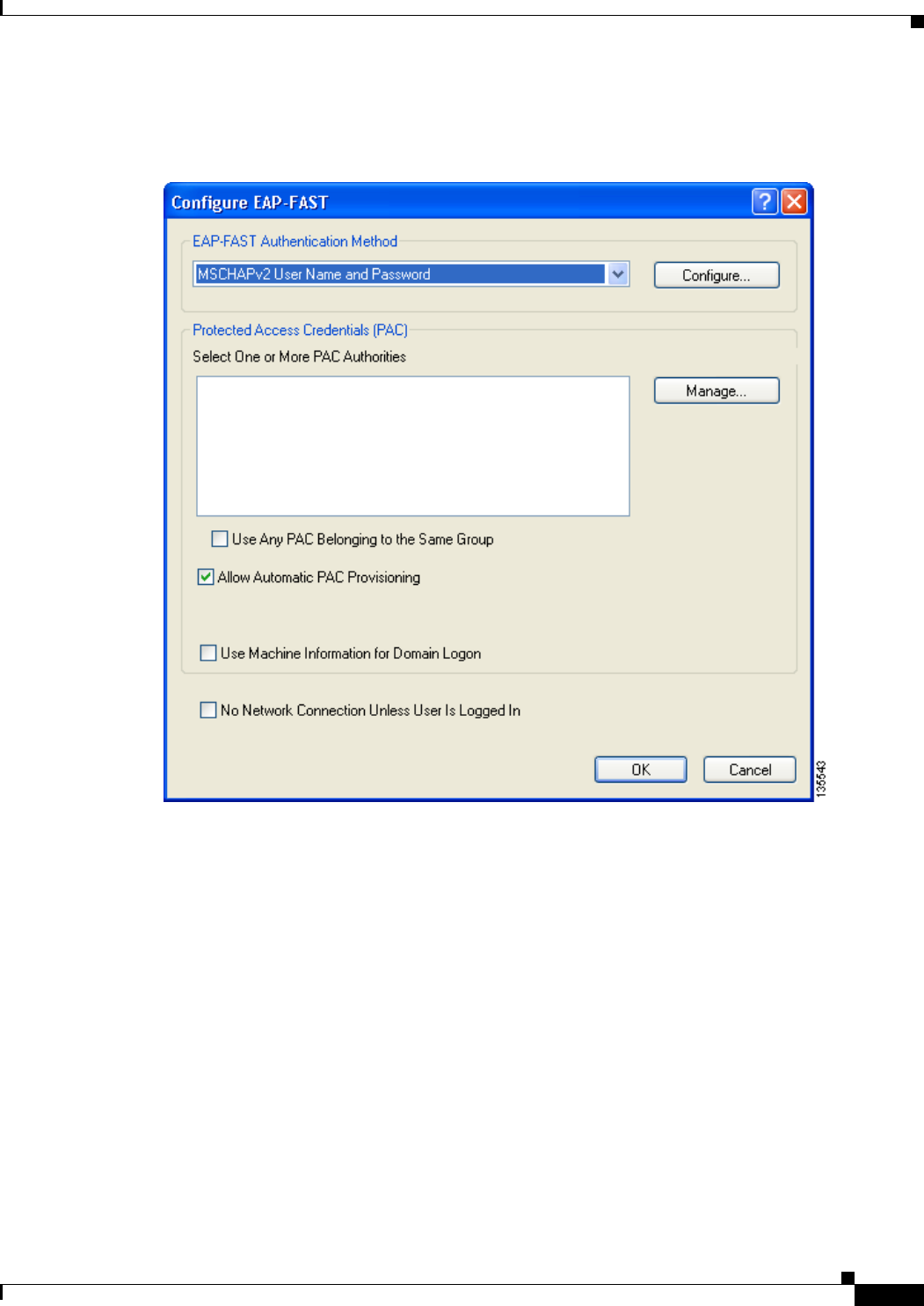
5-35
Cisco Aironet 802.11a/b/g Wireless LAN Client Adapters (CB21AG and PI21AG) Installation and Configuration Guide
OL-4211-05
Chapter 5 Configuring the Client Adapter
Setting Security Parameters
Step 2 Click Configure. The Configure EAP-FAST window appears (see Figure 5-8).
Figure 5-8 Configure EAP-FAST Window
Step 3 Choose an authentication method from the EAP-FAST Authentication Method drop-down list and click
Configure.
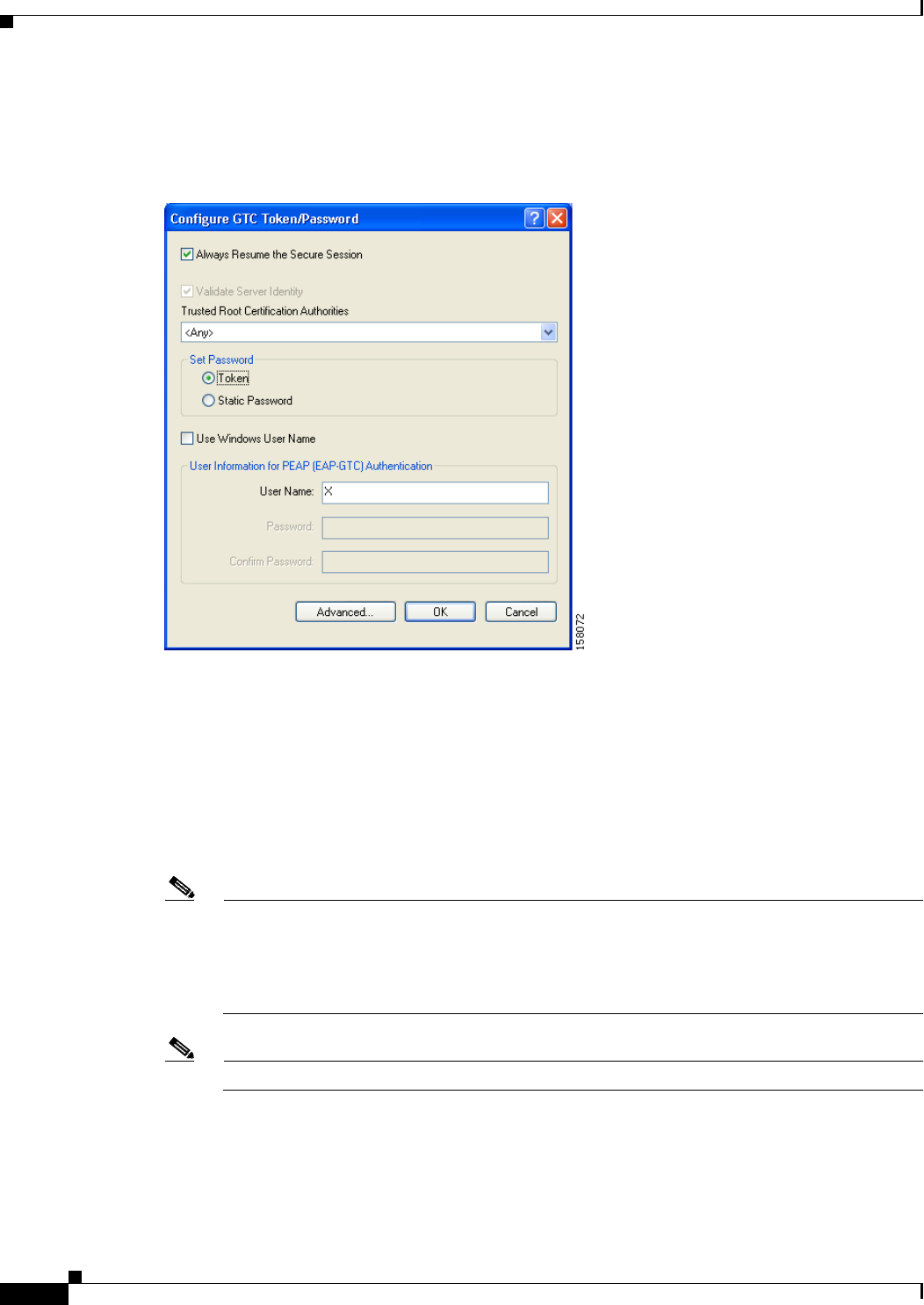
5-36
Cisco Aironet 802.11a/b/g Wireless LAN Client Adapters (CB21AG and PI21AG) Installation and Configuration Guide
OL-4211-05
Chapter 5 Configuring the Client Adapter
Setting Security Parameters
Step 4 If you chose GTC Token/Password in Step 3, do the following in the Configure GTC Token/Password
window (see Figure 5-9):
Figure 5-9 Configure GTC Token/Password Window
1. Check the Always Resume the Secure Session check box at the top of the window if you want the
EAP-FAST supplicant to always attempt to resume the previous session without prompting you to
re-enter your credentials whenever the client adapter becomes disassociated. The session resumes
after the client temporarily loses connection to the access point (such as by roaming in and out of
coverage) or wakes up from suspend or hibernate mode. This is the default setting.
Uncheck the Always Resume the Secure Session check box if you want to be prompted to re-enter
your EAP-FAST username and password whenever your client adapter temporarily loses association
by roaming out of coverage or wakes up from suspend or hibernate mode.
Note Checking this check box gives you the convenience of not having to re-enter your username and
password when your client adapter experiences momentary losses of association. However, if
you leave your device unattended during the period of time when the EAP-FAST session can be
resumed without re-entering user credentials, be aware that someone can resume your
EAP-FAST session and access the network.
Note The Always Resume the Secure Session check box is disabled if you chose Static Password.
2. Check the Validate Server Identity check box to force the system to validate the identity of the
server as an added level of security.
If you uncheck this box, only user credentials will be validated.
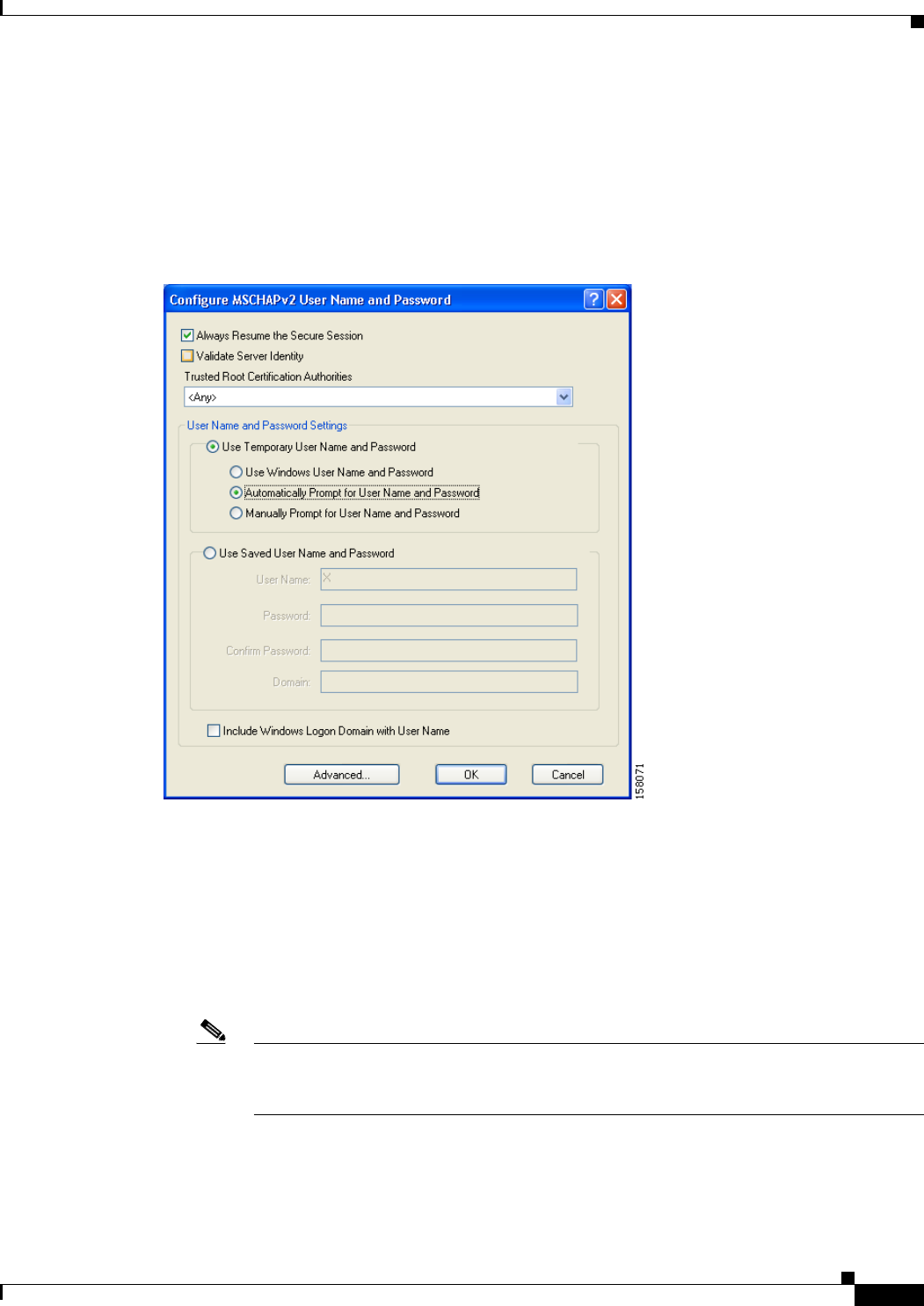
5-37
Cisco Aironet 802.11a/b/g Wireless LAN Client Adapters (CB21AG and PI21AG) Installation and Configuration Guide
OL-4211-05
Chapter 5 Configuring the Client Adapter
Setting Security Parameters
3. To configure the remaining options in this window, refer to “Enabling PEAP (EAP-GTC)” on
page 5-48.
4. Click OK to save your settings and return to the Configure EAP-FAST window.
Step 5 If you chose MSCHAPv2 User Name and Password in Step 3, do the following in the Configure
MSCHAPv2 User Name and Password window (see Figure 5-10):
Figure 5-10 Configure MSCHAPv2 User Name and Password Window
1. Check the Always Resume the Secure Session check box at the top of the window if you want the
EAP-FAST supplicant to always attempt to resume the previous session without prompting you to
re-enter your credentials whenever the client adapter becomes disassociated. The session resumes
after the client temporarily loses connection to the access point (such as by roaming in and out of
coverage) or wakes up from suspend or hibernate mode. This is the default setting.
Uncheck the Always Resume the Secure Session check box if you want to be prompted to re-enter
your EAP-FAST username and password whenever your client adapter temporarily loses association
by roaming out of coverage or wakes up from suspend or hibernate mode.
Note To check or uncheck the Always Resume the Secure Session check box, you must first
choose Automatically Prompt for User Name and Password or Manually Prompt for
User Name and Password under Use Temporary User Name and Password.
2. Check the Validate Server Identity check box to force the system to validate the identity of the
server as an added level of security.

5-38
Cisco Aironet 802.11a/b/g Wireless LAN Client Adapters (CB21AG and PI21AG) Installation and Configuration Guide
OL-4211-05
Chapter 5 Configuring the Client Adapter
Setting Security Parameters
3. Choose a certificate authority from which the server certificate was downloaded in the Trusted Root
Certification Authorities drop-down box, or, if applicable, choose <Any>.
4. To use a temporary username and password, choose Use Temporary User Name and Password.
This option requires you to enter the EAP-FAST username and password each time the computer
reboots in order to authenticate and gain access to the network, unless you choose Use Windows
User Name and Password.
Choose one of the following options under Use Temporary User Name and Password:
–
Use Windows User Name and Password—Causes your Windows username and password to
also serve as your EAP-FAST username and password, giving you only one set of credentials to
remember. After you log in, the authentication process begins automatically. This option is the
default setting.
–
Automatically Prompt for User Name and Password—Requires you to enter a separate
EAP-FAST username and password (which are registered with the RADIUS server) in addition
to your regular Windows login in order to start the authentication process.
–
Manually Prompt for User Name and Password—Requires you to manually invoke the
EAP-FAST authentication process as needed using the Manual Login option in the Action
drop-down menu or ASTU. You are not prompted to enter an EAP-FAST username and
password during the Windows login. This option might be used to support a software token
one-time password system or other systems that require additional software that is not available
at login.
5. To use a saved username and password, choose Use Saved User Name and Password.
This option does not require you to enter an EAP-FAST username and password each time the
computer reboots. Authentication occurs automatically as needed using a saved username and
password (which are registered with the RADIUS server).
Follow these steps to specify the username and password to use for EAP-FAST authentication:
a. Enter a username and password in the appropriate fields.
b. Re-enter the password in the Confirm Password field.
c. If you wish to specify a domain name that will be passed to the RADIUS server along with your
username, enter it in the Domain field.
6. If you work in an environment with multiple domains and therefore want your Windows login
domain to be passed to the RADIUS server along with your username, check the Include Windows
Logon Domain with User Name check box. The default setting is checked.
Note If you chose to use a saved username and password but do not check the Include Windows Logon
Domain with User Name check box, the saved domain name is not passed to the RADIUS server.
7. To specify a server or domain name and a login name to use for authenticating user credentials, click
Advanced and follow the instructions in “Configuring Advanced Settings” on page 5-58.
8. Click OK to save your settings and return to the Configure EAP-FAST window.
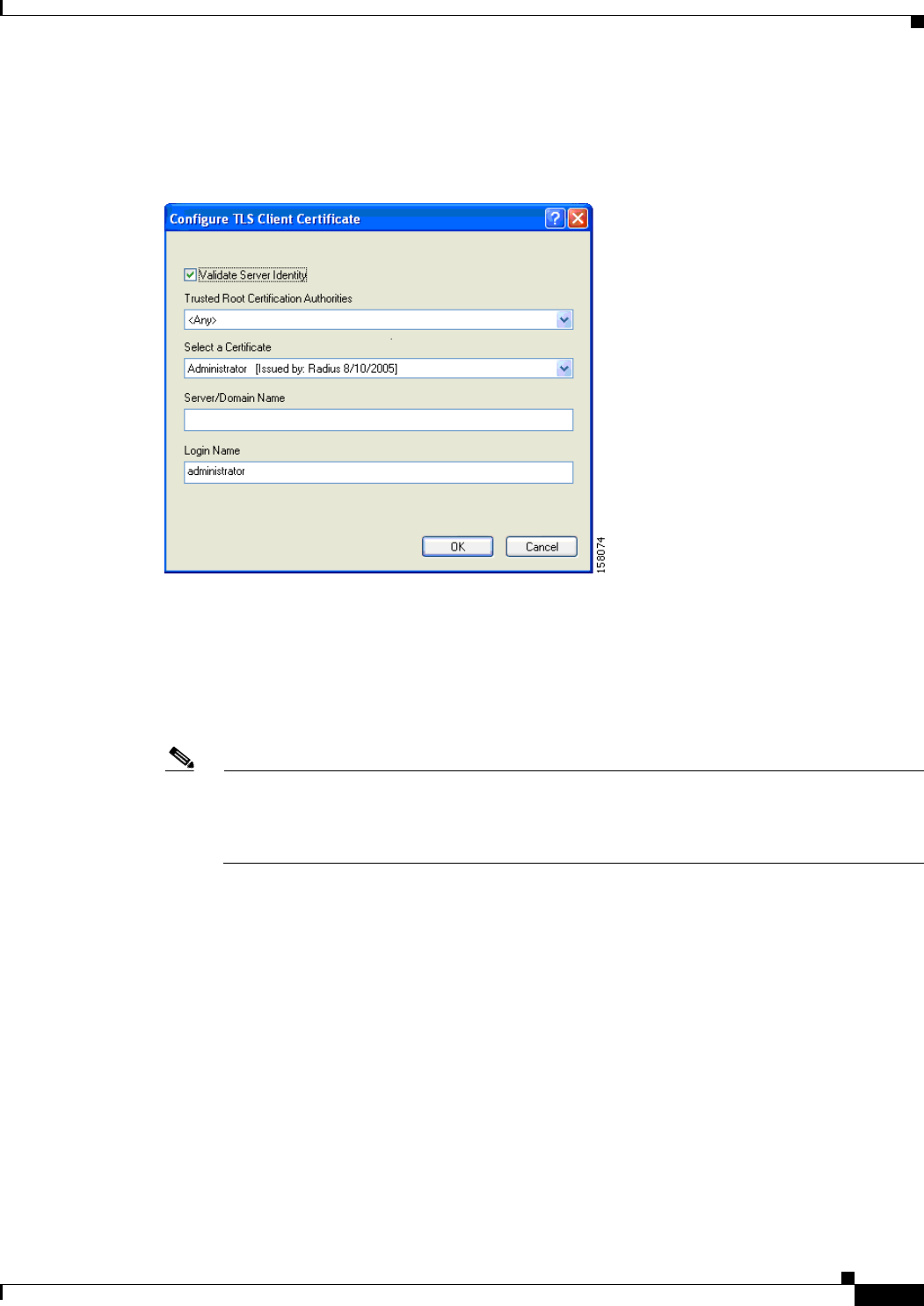
5-39
Cisco Aironet 802.11a/b/g Wireless LAN Client Adapters (CB21AG and PI21AG) Installation and Configuration Guide
OL-4211-05
Chapter 5 Configuring the Client Adapter
Setting Security Parameters
Step 6 If you chose TLS Client Certificate in Step 3, refer to “Enabling EAP-TLS” on page 5-45 (Step 5 to
Step 10) to configure the options in the Configure TLS Client Certificate window (Figure 5-11).
Figure 5-11 Configure TLS Client Certificate Window
Step 7 In the Select One or More PAC Authorities list, select the PAC authorities and PAC authority groups that
are associated with the network defined by the profile’s SSID. The list contains the names of all the
authentication servers from which you have previously provisioned a PAC.
If the Select One or More PAC Authorities list is empty or does not contain the name of a desired PAC
authority, go to Step 8 to import a PAC file.
Note This step is required for manual PAC provisioning but optional for automatic PAC provisioning.
If automatic provisioning is enabled, automatic provisioning will be initiated during the
authentication process of the EAP-FAST profile if no PAC authority was selected, the PAC could
not be found, or the specified PAC does not match the server ID.
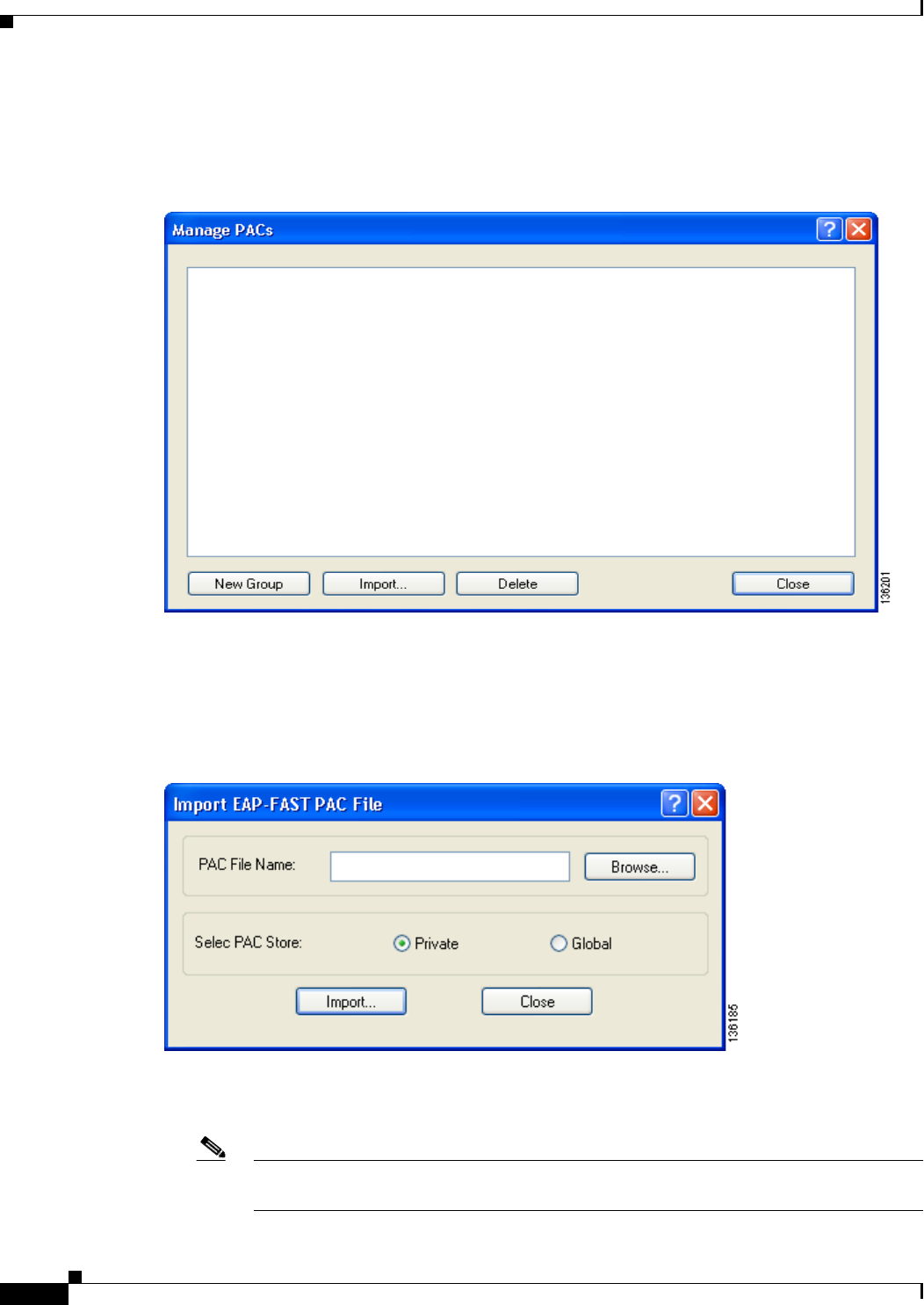
5-40
Cisco Aironet 802.11a/b/g Wireless LAN Client Adapters (CB21AG and PI21AG) Installation and Configuration Guide
OL-4211-05
Chapter 5 Configuring the Client Adapter
Setting Security Parameters
Step 8 If necessary, follow these steps to import or modify the grouping of PAC files:
a. Click Manage. The Manage PACs window appears (see Figure 5-12).
Figure 5-12 Manage PACs Window
b. To create a new group, click New Group.
c. To move a PAC from one group to another, just drag it to the destination group.
d. Click Import. The Import EAP-FAST PAC File window appears (see Figure 5-13).
Figure 5-13 Import EAP-FAST PAC File Window
e. Find the location of the PAC file (*.pac) in the Look in box. The default location is C:\Program
Files\Cisco Aironet.
Note The filename and extension of a PAC file is determined by the PAC authority that issues it,
but the standard file extension is pac.
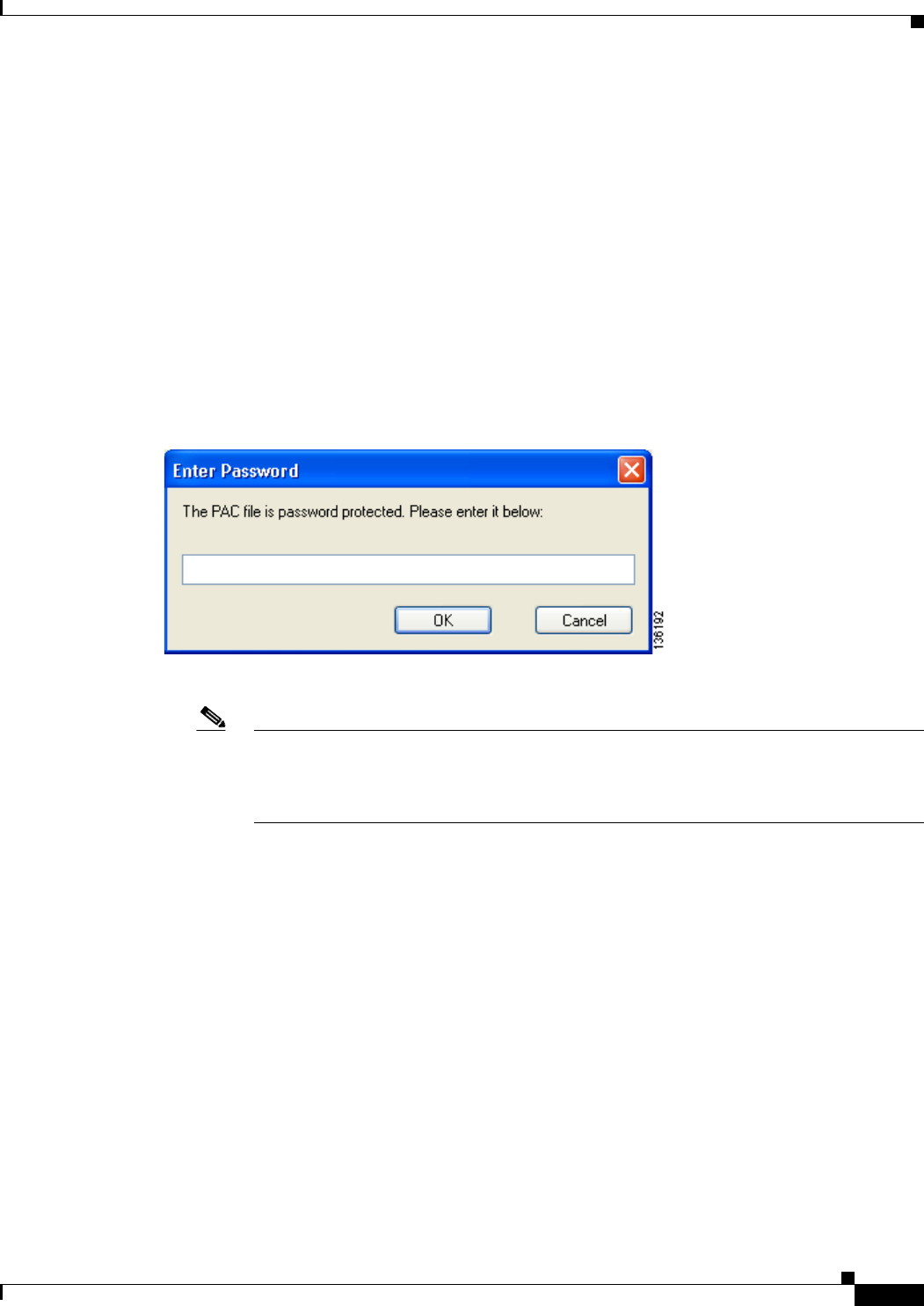
5-41
Cisco Aironet 802.11a/b/g Wireless LAN Client Adapters (CB21AG and PI21AG) Installation and Configuration Guide
OL-4211-05
Chapter 5 Configuring the Client Adapter
Setting Security Parameters
f. Choose one of these PAC store options to determine where the imported PAC file will be stored and
to whom it will be accessible:
•Global—PACs that are stored in the global PAC store can be accessed and used by any user at
any logon stage. Global PACs are available before or during logon or after the user is logged off
if the profile is not configured with the No Network Connection Unless User Is Logged In
option.
•Private—PACs that are stored in the private store can be accessed and used only by the user
who provisioned them or the system administrator. They are not accessible until the user is
logged onto the local system. This is the default option.
g. Click Import.
h. If the Enter Password window appears (see Figure 5-14), enter the PAC file password, which can be
obtained from your system administrator, and click OK.
Figure 5-14 Enter Password Window
Note PAC file passwords are optional. The PAC authority determines whether to issue PAC files
that require user-supplied passwords. Nevertheless, all PAC files (even those without
passwords) are encrypted and protected. PAC file passwords are different from EAP-FAST
passwords and need to be entered only once, at the time a PAC is imported.
i. If you try to import a PAC file with the same PAC ID as a previously imported PAC file, you are
asked if you want to update the existing PAC. If you click Ye s , the existing PAC is replaced by the
new one from the imported file.
j. If the PAC file was imported successfully, the following message appears: “The EAP-FAST PAC file
was imported and is ready for use.” Click OK to return to the Manage PACs window.
k. The imported PAC now appears in the PAC tree on the Manage PACs window.
l. To delete a group or manually provisioned PAC file from storage, select the item and click Delete.
When a message appears asking you to confirm your decision, click Ye s . The PAC file is removed
from the tree.
m. Click Close to return to the Configure EAP-FAST window.
n. The name of the PAC authority that issued the PAC now appears in the PAC authority list on the
Configure EAP-FAST window. Select the desired PAC authorities or groups from the list.
Step 9 Check the Use Any PAC Belonging to the Same Group check box to use any PAC authority in the
selected groups for PAC provisioning.

5-42
Cisco Aironet 802.11a/b/g Wireless LAN Client Adapters (CB21AG and PI21AG) Installation and Configuration Guide
OL-4211-05
Chapter 5 Configuring the Client Adapter
Setting Security Parameters
Step 10 Perform one of the following to configure PAC provisioning:
•If you want to enable automatic PAC provisioning, make sure the Allow Automatic PAC
Provisioning check box is checked. A protected access credentials (PAC) is automatically obtained
as needed (for example, when a PAC expires, when the client adapter accesses a different server or
when the EAP-FAST username cannot be matched to a previously provisioned PAC).
•If you want to enable manual PAC provisioning, uncheck the Allow Automatic PAC Provisioning
check box. This option requires you to choose a PAC authority or manually import a PAC file.
Note LDAP user databases support only manual PAC provisioning while Cisco Secure ACS internal,
Cisco Secure ODBC, and Windows NT/2000/2003 domain user databases support both
automatic and manual PAC provisioning.
Note Provisioning occurs only upon initial negotiation of the PAC or upon PAC expiration. After the
PAC is provisioned, it serves as the per-user key by which authentication transactions are
secured.
Step 11 Check the Use Machine Information for Domain Logon check box if you want the client to attempt to
log into a domain using machine authentication with a machine certificate and machine credentials rather
than user authentication. Doing so enables your computer to connect to the network prior to user logon.
The default setting is unchecked.
Note If you do not check the Use Machine Information for Domain Logon check box, machine
authentication is not performed. Authentication does not occur until you log on.
Step 12 If you want to force the client adapter to disassociate after you log off so that another user cannot gain
access to the wireless network using your credentials, check the No Network Connection Unless User
Is Logged In check box. The default setting is checked.
Step 13 Click OK to save your settings and return to the Profile Management (Security) window.
Note If you selected a private PAC and the No Network Connection Unless User Is Logged In check
box is unchecked, a message appears indicating that the PAC may not be accessible during the
domain logon process or when you are logged off. If you want a copy of the PAC to be added to
the global store so that it will be available when you are not logged on, click Ye s . If you do not
want a copy of the PAC to be added to the global store, click No; then click OK when a message
appears indicating that you may need to later reconfigure your profile to use a global PAC if you
experience wireless connection problems during domain logon or when you are not logged on.
Step 14 Perform one of the following to set the Allow Association to Mixed Cells parameter, which indicates
whether the client adapter can associate to an access point that allows both WEP and non-WEP
associations:
•Check the Allow Association to Mixed Cells check box if the access point to which the client
adapter is to associate (or the VLAN to which the client will be assigned) has WEP set to Optional.
Otherwise, the client is unable to establish a connection with the access point.
•Uncheck the Allow Association to Mixed Cells check box if the access point to which the client
adapter is to associate (or the VLAN to which the client will be assigned) does not have WEP set to
Optional. This is the default setting.

5-43
Cisco Aironet 802.11a/b/g Wireless LAN Client Adapters (CB21AG and PI21AG) Installation and Configuration Guide
OL-4211-05
Chapter 5 Configuring the Client Adapter
Setting Security Parameters
Note This parameter is available only if the 802.1x security option is selected.
Note For security reasons, Cisco recommends that WEP-enabled and WEP-disabled clients not be
allowed in the same cell because broadcast packets are sent unencrypted, even to clients running
WEP. However, you can enable VLANs on the access point to separate WEP-enabled and
WEP-disabled clients.
Step 15 If you want to limit the amount of time that is spent searching for a domain controller during the
authentication process, check the Limit Time for Finding Domain Controller To check box. Then in
the edit box, enter the amount of time (in seconds) to which you want to limit the search for the domain
controller. A timeout value of 0 causes the authentication process to bypass the “Finding Domain
Controller” step altogether.
Range of timeout value: 0 to 300 seconds
Default: Unchecked; 0 seconds
Note When the “Finding Domain Controller” step is reached during the authentication process, a
timer starts based on the number of seconds you specified for finding the domain controller. If
either this value or the EAP-FAST authentication timeout value expires before the domain
controller is found, the authentication process times out. For example, if the authentication
timeout value is 60 seconds and the finding domain controller timeout value is 10 seconds, the
client adapter has up to 60 seconds to complete the entire authentication process, up to 10
seconds of which is allocated for finding the domain controller. However, if authentication
happens quickly, the software might reach the “Finding Domain Controller” step in 5 seconds.
If the domain controller could not be found within 10 seconds, the authentication process would
timeout in just 15 seconds.
Note The finding domain controller timeout value can never extend the authentication process beyond
the EAP-FAST authentication timeout value, even if the finding domain controller timeout value
is greater than the EAP-FAST authentication timeout value.
Note If you require domain services such as login scripts and roaming desktops, Cisco recommends
that you uncheck the Limit Time for Finding Domain Controller To check box.
Note Regardless of whether the check box is checked or unchecked, the “Finding Domain Controller”
step is bypassed once you are logged into Windows or if you log into the local machine and not
into a domain.

5-44
Cisco Aironet 802.11a/b/g Wireless LAN Client Adapters (CB21AG and PI21AG) Installation and Configuration Guide
OL-4211-05
Chapter 5 Configuring the Client Adapter
Setting Security Parameters
Step 16 If you want to change the value of the Group Policy Delay parameter, enter a new value or use the up
and down arrows to select a value between 0 and 65535 seconds. (Microsoft supports only values
between 30 and 600 seconds. The default value is 60 seconds.)
The Group Policy Delay parameter specifies how much time elapses before the Windows logon process
starts Group Policy, a Windows feature used by administrators to specify configuration options for
groups of users. The objective is to delay the start of Group Policy until wireless network authentication
occurs. The value that you set for this parameter goes into effect after the computer reboots with this
profile set as the active profile.
Note A Microsoft hot fix is required in order to use this parameter on computers running Windows
2000. Refer to the “Installing a Microsoft Hot Fix for Group Policy Delay” on page 3-21 for
information on obtaining and installing the hot fix.
Step 17 Click OK to save your settings and return to the Cisco Aironet Desktop Utility (Profile Management)
window.
Step 18 Refer to Chapter 6 for instructions on authenticating using EAP-FAST.
Enabling EAP-TLS or PEAP
Before you can enable EAP-TLS or PEAP authentication, your network devices must meet the following
requirements:
•You must have a valid Windows username and password, and the password cannot be blank.
•The appropriate certificates must be installed on your computer. EAP-TLS requires both a
Certificate Authority (CA) certificate and a user certificate while PEAP requires only a CA
certificate.
Note Contact your system administrator if you need help obtaining and importing the necessary
certificates.
•To support EAP-TLS machine authentication with machine credentials:
–
A machine certificate must be obtained from the server, and client machine access must be
enabled on the server.
–
Permissions for the MachineKeys folder, which stores the certificate pair keys for both the
computer and users, must be set correctly. Refer to Microsoft knowledgebase article Q278381
for information on correctly setting up folder permissions:
http://support.microsoft.com/default.aspx?scid=kb;en-us;Q278381
Note If you ever change permissions on higher-level directories and those settings are applied
to all subdirectories, you may need to reset the permissions for the MachineKeys folder.

5-45
Cisco Aironet 802.11a/b/g Wireless LAN Client Adapters (CB21AG and PI21AG) Installation and Configuration Guide
OL-4211-05
Chapter 5 Configuring the Client Adapter
Setting Security Parameters
•Access points to which your client adapter may attempt to authenticate must use the following
firmware versions or later: 12.00T (access points running VxWorks), Cisco IOS Release 12.2(4)JA
(1100 series access points), Cisco IOS Release 12.2(8)JA (1200 series access points), Cisco IOS
Release 12.3(4)JA (1130 series and BR 1310 series access points), Cisco IOS Release 12.3(7)JA
(1240 series access points), or Cisco IOS Release 12.2(13)JA (350 series access points).
Note To use WPA or CCKM, access points must use Cisco IOS Release 12.2(11)JA or later. To
use WPA2, access points must use Cisco IOS Release 12.3(2)JA or later.
•All necessary infrastructure devices (such as access points, servers, gateways, user databases, etc.)
must be properly configured for the authentication type you plan to enable on the client.
Follow the instructions in one of the sections below to enable EAP-TLS or PEAP authentication for this
profile:
•Enabling EAP-TLS, 5-45
•Enabling PEAP (EAP-GTC), 5-48
•Enabling PEAP (EAP-MSCHAP V2), 5-52
•Enabling PEAP (EAP-MSCHAP V2) machine authentication with machine certificates, 5-55
Enabling EAP-TLS
Follow the steps below to enable EAP-TLS authentication for this profile.
Step 1 Perform one of the following on the Profile Management (Security) window:
•If you want to enable EAP-TLS without WPA or WPA2, choose 802.1x under Set Security Options
and EAP-TLS in the 802.1x EAP Type drop-down box.
•If you want to enable EAP-TLS with WPA or WPA2, choose WPA/WPA2/CCKM under Set
Security Options and EAP-TLS in the WPA/WPA2/CCKM EAP Type drop-down box.
Note If you want to enable CCKM on the client adapter, you must choose the WPA/WPA2/CCKM
security option, regardless of whether you want the adapter to use WPA or WPA2. The
configuration of the access point to which your client adapter associates determines whether
CCKM will be used with 802.1x, WPA, or WPA2.
Note Refer to the “WPA and WPA2” on page 5-19 for additional information.
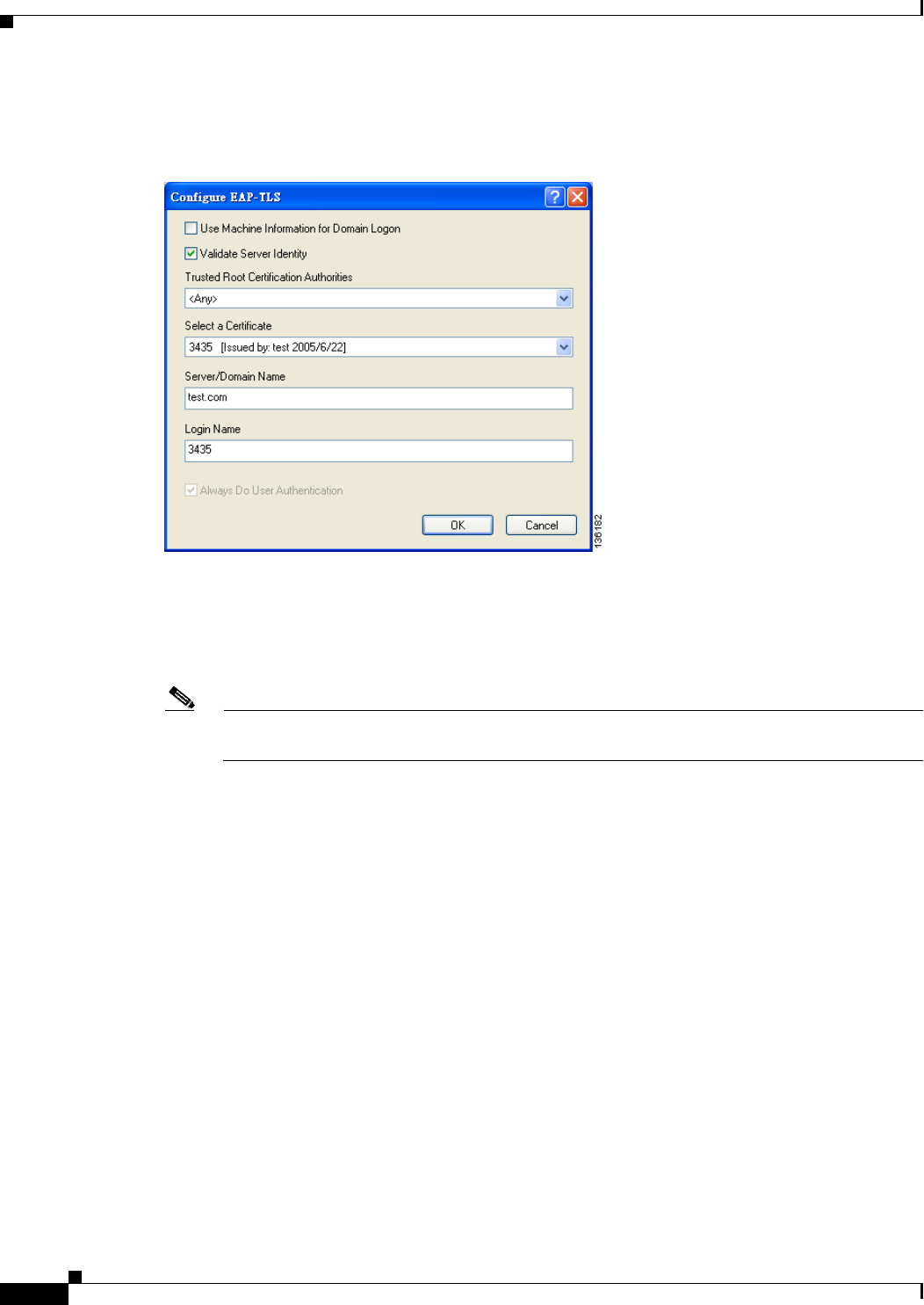
5-46
Cisco Aironet 802.11a/b/g Wireless LAN Client Adapters (CB21AG and PI21AG) Installation and Configuration Guide
OL-4211-05
Chapter 5 Configuring the Client Adapter
Setting Security Parameters
Step 2 Click Configure. The Configure EAP-TLS window appears (see Figure 5-15).
Figure 5-15 Configure EAP-TLS Window
Step 3 Check the Use Machine Information for Domain Logon check box if you want the client to attempt to
log into a domain using machine authentication with a machine certificate and machine credentials rather
than user authentication. Doing so enables your computer to connect to the network prior to user logon.
The default setting is unchecked.
Note If you do not check the Use Machine Information for Domain Logon check box, machine
authentication is not performed. Authentication does not occur until you log on.
Step 4 If you checked the Use Machine Information For Domain Logon check box in the previous step, the
Always Do User Authentication check box at the bottom of the window becomes active. Perform one of
the following:
•Check the Always Do User Authentication check box if you want the client to switch from using
machine authentication to using user authentication after you log on using your username and
password. This is the default setting.
•Uncheck the Always Do User Authentication check box if you want the client to continue to use
machine authentication after your computer logs into the domain.
Step 5 Check the Validate Server Identity check box to force the system to validate the identity of the server
as an added level of security. If you uncheck this box, only user credentials will be validated.
Step 6 Choose the certificate authority from which the server certificate was downloaded in the Trusted Root
Certification Authorities drop-down box.
Step 7 Choose your server certificate in the Select a Certificate drop-down box.

5-47
Cisco Aironet 802.11a/b/g Wireless LAN Client Adapters (CB21AG and PI21AG) Installation and Configuration Guide
OL-4211-05
Chapter 5 Configuring the Client Adapter
Setting Security Parameters
Step 8 Perform one of the following:
•Leave the Server/Domain Name field blank to allow the client to accept a certificate from any server
that supplies a certificate signed by the certificate authority listed in the Trusted Root Certification
Authorities drop-down box. This is the recommended option.
•In the Server/Domain Name field, enter the domain name of the server from which the client will
accept a certificate.
Step 9 If the Login Name field is not filled in automatically, enter your username in this format:
username@domain (for example, jsmith@acs-test.cisco.com).
Step 10 Click OK to save your settings and return to the Profile Management (Security) window.
Step 11 Perform one of the following to set the Allow Association to Mixed Cells parameter, which indicates
whether the client adapter can associate to an access point that allows both WEP and non-WEP
associations:
•Check the Allow Association to Mixed Cells check box if the access point to which the client
adapter is to associate (or the VLAN to which the client will be assigned) has WEP set to Optional.
Otherwise, the client is unable to establish a connection with the access point.
•Uncheck the Allow Association to Mixed Cells check box if the access point to which the client
adapter is to associate (or the VLAN to which the client will be assigned) does not have WEP set to
Optional. This is the default setting.
Note This parameter is available only if the 802.1x security option is selected.
Note For security reasons, Cisco recommends that WEP-enabled and WEP-disabled clients not be
allowed in the same cell because broadcast packets are sent unencrypted, even to clients running
WEP. However, you can enable VLANs on the access point to separate WEP-enabled and
WEP-disabled clients.
Step 12 If you want to change the value of the Group Policy Delay parameter, enter a new value or use the up
and down arrows to select a value between 0 and 65535 seconds. (Microsoft supports only values
between 30 and 600 seconds. The default value is 60 seconds.)
The Group Policy Delay parameter specifies how much time elapses before the Windows logon process
starts Group Policy, a Windows feature used by administrators to specify configuration options for
groups of users. The objective is to delay the start of Group Policy until wireless network authentication
occurs. The value that you set for this parameter goes into effect after the computer reboots with this
profile set as the active profile.
Note A Microsoft hot fix is required in order to use this parameter on computers running Windows
2000. Refer to the “Installing a Microsoft Hot Fix for Group Policy Delay” on page 3-21 for
information on obtaining and installing the hot fix.
Step 13 Click OK to save your settings and return to the Cisco Aironet Desktop Utility (Profile Management)
window.
Step 14 Refer to Chapter 6 for instructions on authenticating using EAP-TLS.

5-48
Cisco Aironet 802.11a/b/g Wireless LAN Client Adapters (CB21AG and PI21AG) Installation and Configuration Guide
OL-4211-05
Chapter 5 Configuring the Client Adapter
Setting Security Parameters
Enabling PEAP (EAP-GTC)
Follow these steps to enable PEAP (EAP-GTC) authentication for this profile.
Step 1 Perform one of the following:
•If you want to enable PEAP (EAP-GTC) without WPA or WPA2, choose 802.1x under Set Security
Options and PEAP (EAP-GTC) in the 802.1x EAP Type drop-down box.
•If you want to enable PEAP (EAP-GTC) with WPA or WPA2, choose WPA/WPA2/CCKM under
Set Security Options and PEAP (EAP-GTC) in the WPA/WPA2/CCKM EAP Type drop-down box.
Note If you want to enable CCKM on the client adapter, you must choose the WPA/WPA2/CCKM
security option, regardless of whether you want the adapter to use WPA or WPA2. The
configuration of the access point to which your client adapter associates determines whether
CCKM will be used with 802.1x, WPA, or WPA2.
Note Refer to the “WPA and WPA2” on page 5-19 for additional information.
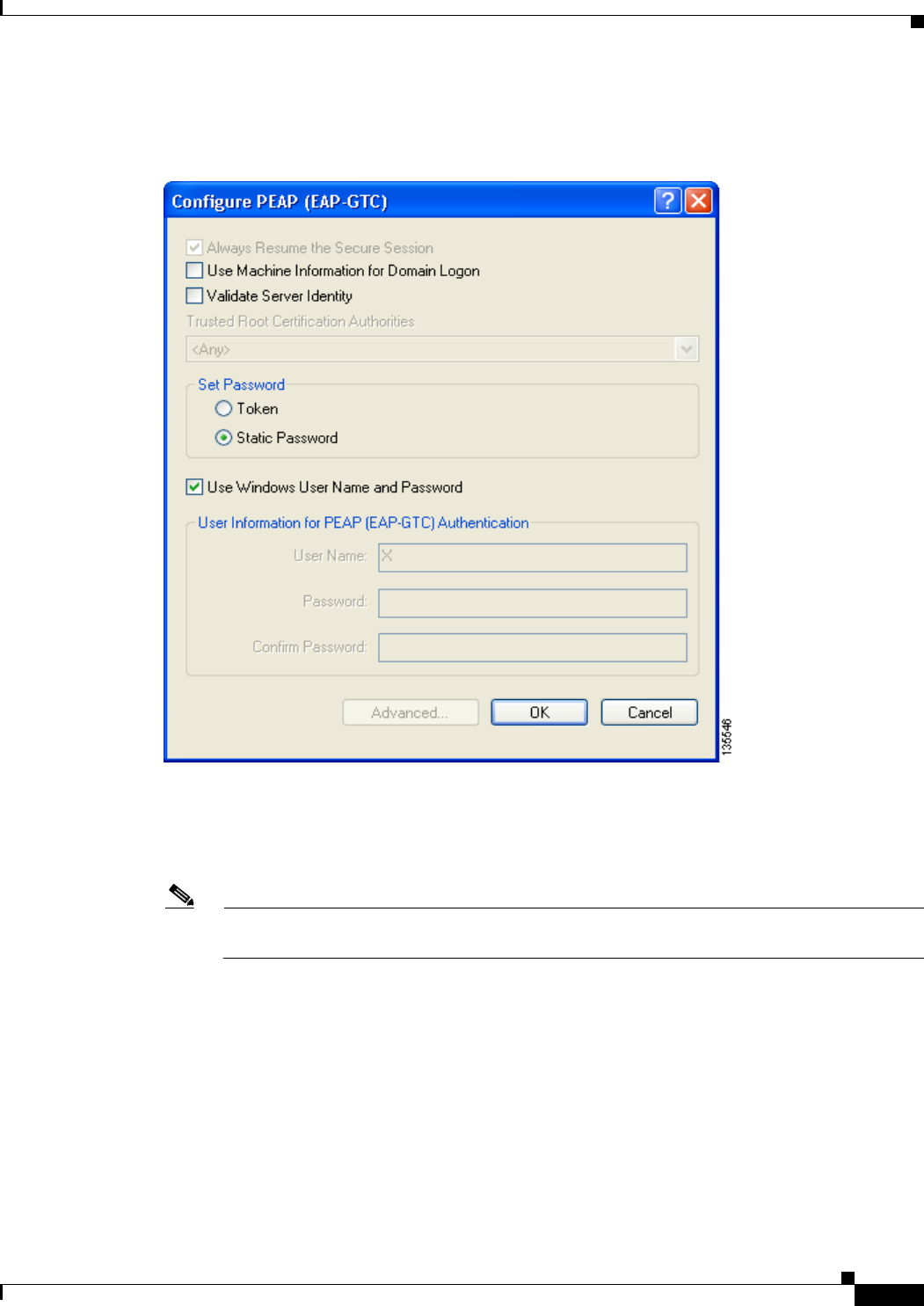
5-49
Cisco Aironet 802.11a/b/g Wireless LAN Client Adapters (CB21AG and PI21AG) Installation and Configuration Guide
OL-4211-05
Chapter 5 Configuring the Client Adapter
Setting Security Parameters
Step 2 Click Configure. The Configure PEAP (EAP-GTC) window appears (see Figure 5-16).
Figure 5-16 Configure PEAP (EAP-GTC) Window
Step 3 Check the Use Machine Information for Domain Logon check box if you want the client to attempt to
log into a domain using machine authentication with user credentials rather than user authentication.
Doing so enables your computer to connect to the network prior to user logon. The default setting is
checked.
Note If you do not check the Use Machine Information for Domain Logon check box, machine
authentication is not performed. Authentication does not occur until you log on.
Step 4 Check the Validate Server Identity check box to force the system to validate the identity of the server
as an added level of security. If you uncheck this box, only user credentials will be validated.
Step 5 Choose the certificate authority from which the server certificate was downloaded in the Trusted Root
Certification Authorities drop-down box, or, if applicable, choose <Any>.
Step 6 Choose either Token or Static Password, depending on your user database.

5-50
Cisco Aironet 802.11a/b/g Wireless LAN Client Adapters (CB21AG and PI21AG) Installation and Configuration Guide
OL-4211-05
Chapter 5 Configuring the Client Adapter
Setting Security Parameters
Note If you choose Token, you must use a hardware token device or the Secure Computing SofToken
program (release 2.1 or later) to obtain the one-time password and enter the password when
prompted during the authentication process. Secure Computing PremierAccess release 3.1.1 or
later is the only supported token server.
Step 7 If you chose Token in Step 6, perform one of the following:
•Check the Always Resume the Secure Session check box at the top of the window if you want the
PEAP (EAP-GTC) supplicant to always attempt to resume the previous session without prompting
you to re-enter your credentials whenever the client adapter becomes disassociated. The session
resumes after the client temporarily loses connection to the access point (such as by roaming in and
out of coverage) or wakes up from suspend or hibernate mode. This is the default setting.
•Uncheck the Always Resume the Secure Session check box if you want to be prompted to re-enter
your PEAP (EAP-GTC) username and password whenever your client adapter temporarily loses
association by roaming out of coverage or wakes up from suspend or hibernate mode.
Note Checking this check box gives you the convenience of not having to re-enter your username and
password when your client adapter experiences momentary losses of association. However, if
you leave your device unattended during the period of time when the PEAP (EAP-GTC) session
can be resumed without re-entering user credentials, be aware that someone can resume your
PEAP (EAP-GTC) session and access the network.
Note The Always Resume the Secure Session check box is disabled if you chose Static Password in
Step 6.
Step 8 Perform one of the following to specify the username that will be used for inner PEAP tunnel
authentication:
•If you want your Windows username to also serve as your PEAP username, check the Use Windows
User Name check box. This option gives you only one username to remember.
Note If you chose the Static Password option in Step 6, the check box reads Use Windows User
Name and Password.
•If you want to enter a separate PEAP username (which is registered with the RADIUS server) in
addition to your regular Windows username in order to start the PEAP authentication process, enter
your PEAP username in the User Name field.
Note Your Windows username is filled in automatically. Simply delete your Windows username
and enter your separate PEAP username.
Step 9 If you entered a PEAP username in the previous step and chose the Static Password option in Step 6,
enter your PEAP authentication password (which is registered with the RADIUS server) in both the
Password and Confirm Password fields.
Step 10 If the Use Windows User Name and Password check box is unchecked and you want to implement added
security by further refining the network certificate that will be accepted and controlling the string used to set
up the outer PEAP tunnel, follow the steps in “Configuring Advanced Settings” on page 5-58.

5-51
Cisco Aironet 802.11a/b/g Wireless LAN Client Adapters (CB21AG and PI21AG) Installation and Configuration Guide
OL-4211-05
Chapter 5 Configuring the Client Adapter
Setting Security Parameters
Step 11 Click OK to save your settings and return to the Profile Management (Security) window.
Step 12 Perform one of the following to set the Allow Association to Mixed Cells parameter, which indicates
whether the client adapter can associate to an access point that allows both WEP and non-WEP
associations:
•Check the Allow Association to Mixed Cells check box if the access point to which the client
adapter is to associate (or the VLAN to which the client will be assigned) has WEP set to Optional.
Otherwise, the client is unable to establish a connection with the access point.
•Uncheck the Allow Association to Mixed Cells check box if the access point to which the client
adapter is to associate (or the VLAN to which the client will be assigned) does not have WEP set to
Optional. This is the default setting.
Note This parameter is available only if the 802.1x security option is selected.
Note For security reasons, Cisco recommends that WEP-enabled and WEP-disabled clients not be
allowed in the same cell because broadcast packets are sent unencrypted, even to clients running
WEP. However, you can enable VLANs on the access point to separate WEP-enabled and
WEP-disabled clients.
Step 13 If you want to change the value of the Group Policy Delay parameter, enter a new value or use the up
and down arrows to select a value between 0 and 65535 seconds. (Microsoft supports only values
between 30 and 600 seconds. The default value is 60 seconds.)
The Group Policy Delay parameter specifies how much time elapses before the Windows logon process
starts Group Policy, a Windows feature used by administrators to specify configuration options for
groups of users. The objective is to delay the start of Group Policy until wireless network authentication
occurs. The value that you set for this parameter goes into effect after the computer reboots with this
profile set as the active profile.
Note A Microsoft hot fix is required in order to use this parameter on computers running Windows
2000. Refer to the “Installing a Microsoft Hot Fix for Group Policy Delay” on page 3-21 for
information on obtaining and installing the hot fix.
Step 14 Click OK to save your settings and return to the Cisco Aironet Desktop Utility (Profile Management)
window.
Step 15 Refer to Chapter 6 for instructions on authenticating using PEAP (EAP-GTC).

5-52
Cisco Aironet 802.11a/b/g Wireless LAN Client Adapters (CB21AG and PI21AG) Installation and Configuration Guide
OL-4211-05
Chapter 5 Configuring the Client Adapter
Setting Security Parameters
Enabling PEAP (EAP-MSCHAP V2)
Follow the steps below to enable PEAP (EAP-MSCHAP V2) for this profile.
Step 1 Perform one of the following:
•If you want to enable PEAP (EAP-MSCHAP V2) without WPA or WPA2, choose 802.1x under Set
Security Options and PEAP (EAP-MSCHAP V2) in the 802.1x EAP Type drop-down box.
•If you want to enable PEAP (EAP-MSCHAP V2) with WPA or WPA2, choose WPA/WPA2/CCKM
under Set Security Options and PEAP (EAP-MSCHAP V2) in the WPA/WPA2/CCKM EAP Type
drop-down box.
Note If you want to enable CCKM on the client adapter, you must choose the WPA/WPA2/CCKM
security option, regardless of whether you want the adapter to use WPA or WPA2. The
configuration of the access point to which your client adapter associates determines whether
CCKM will be used with 802.1x, WPA, or WPA2.
Note Refer to the “WPA and WPA2” on page 5-19 for additional information.
Step 2 Click Configure. The Configure PEAP (EAP-MSCHAP V2) window appears (see Figure 5-17).
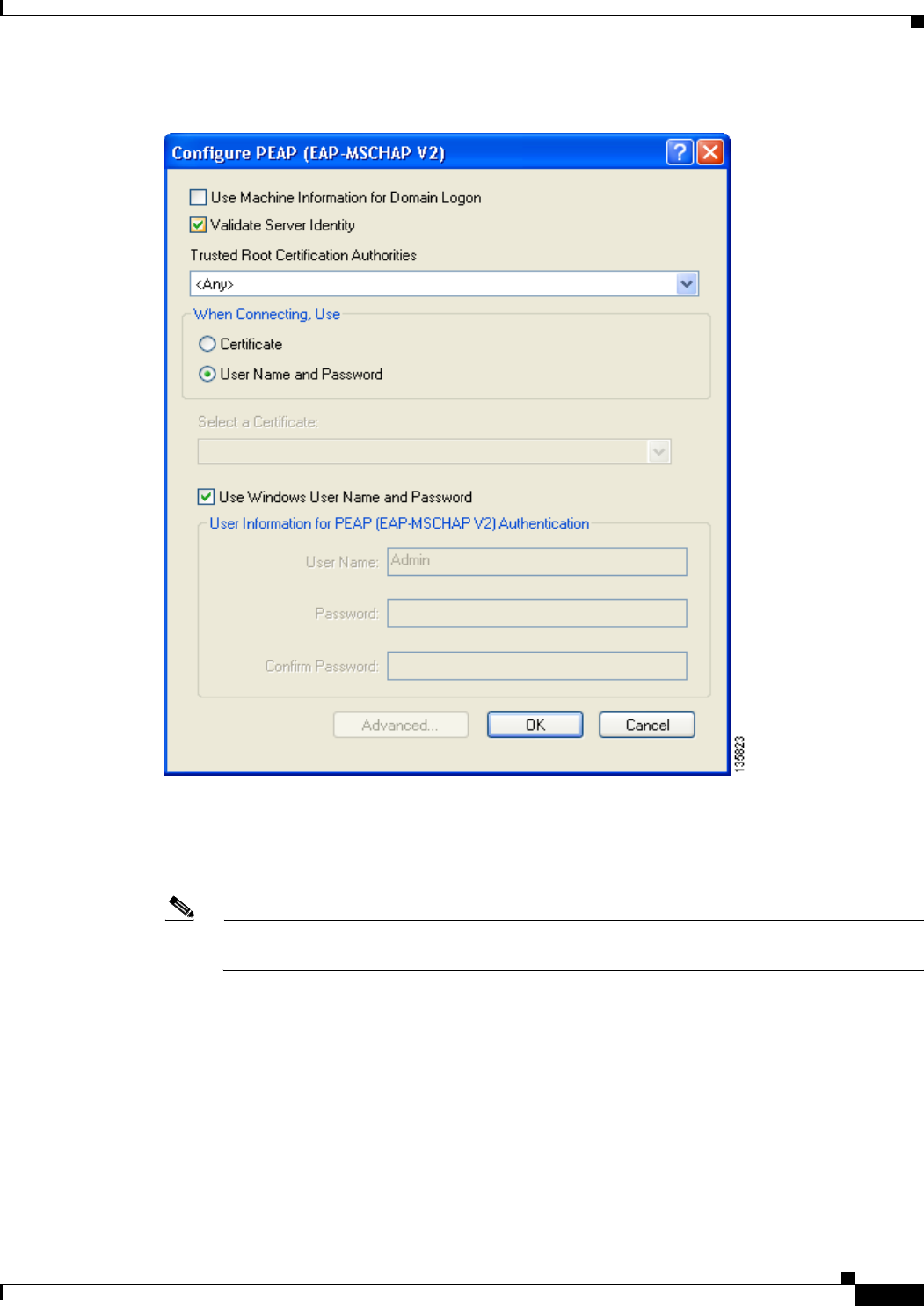
5-53
Cisco Aironet 802.11a/b/g Wireless LAN Client Adapters (CB21AG and PI21AG) Installation and Configuration Guide
OL-4211-05
Chapter 5 Configuring the Client Adapter
Setting Security Parameters
Figure 5-17 Configure PEAP (EAP-MSCHAP V2) Window
Step 3 Check the Use Machine Information for Domain Logon check box if you want the client to attempt to
log into a domain using machine authentication with user credentials rather than user authentication.
Doing so enables your computer to connect to the network prior to user logon. The default setting is
checked.
Note If you do not check the Use Machine Information for Domain Logon check box, machine
authentication is not performed. Authentication does not occur until you log on.
Step 4 Check the Validate Server Identity check box to force the system to validate the identity of the server
as an added level of security. If you uncheck this box, only user credentials will be validated.
Step 5 Choose the certificate authority from which the server certificate was downloaded in the Trusted Root
Certification Authorities drop-down box, or, if applicable, choose <Any>.
Step 6 Perform one of the following to specify how you want to establish a network connection:
•If you want to connect using a username and password, choose User Name and Password and go
to Step 7.
•If you want to connect using a user certificate installed on your computer, choose Certificate, select
a certificate from the drop-down box, and go to Step 8.
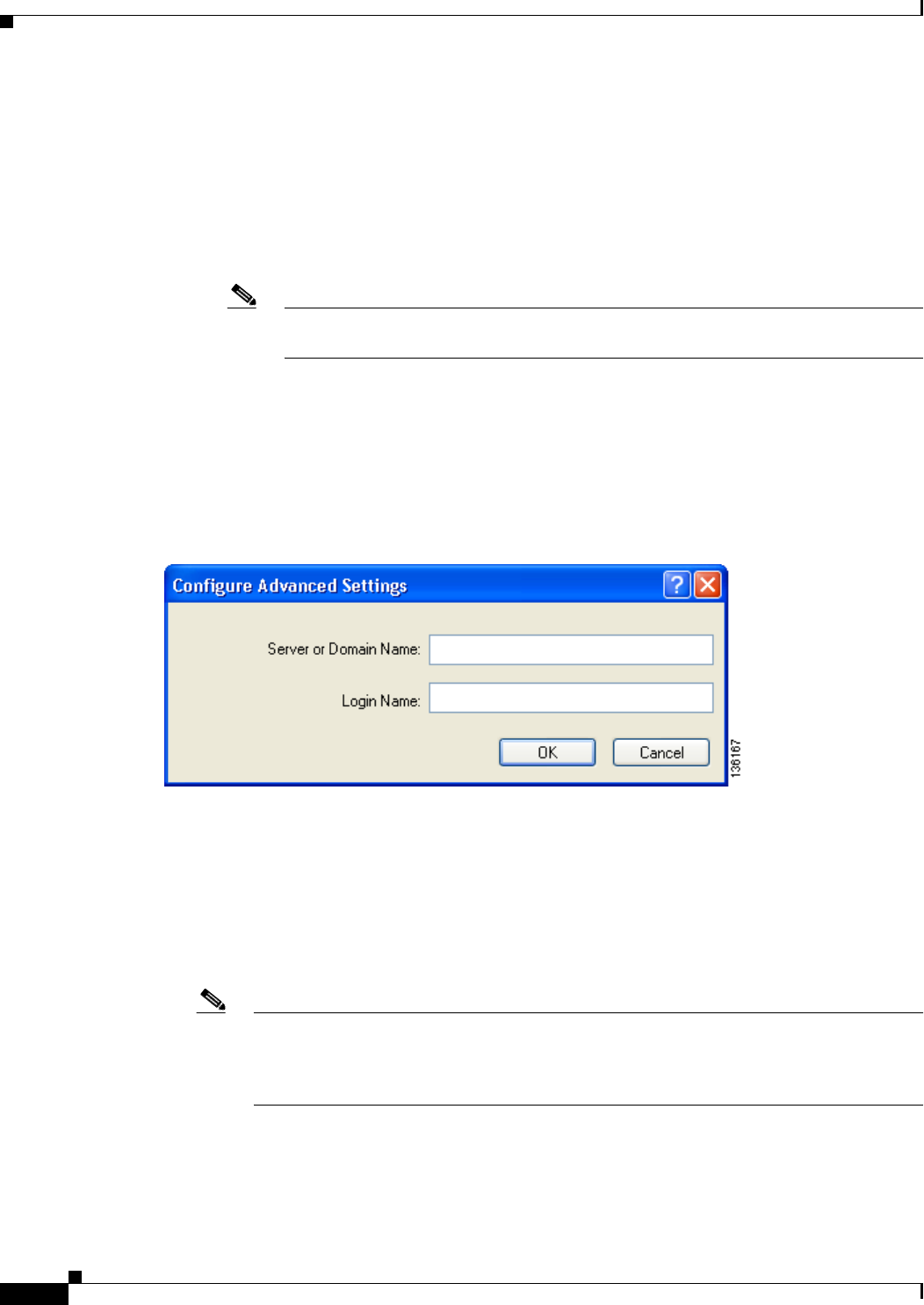
5-54
Cisco Aironet 802.11a/b/g Wireless LAN Client Adapters (CB21AG and PI21AG) Installation and Configuration Guide
OL-4211-05
Chapter 5 Configuring the Client Adapter
Setting Security Parameters
Step 7 Perform one of the following to specify the username and password that will be used for inner PEAP
tunnel authentication:
•If you want your Windows username and password to also serve as your PEAP username and
password, check the Use Windows User Name and Password check box.
•If you want to use a distinct username and password (which are registered with the RADIUS server)
to start the PEAP authentication process, follow these steps:
a. Enter your PEAP username and password in the corresponding fields.
Note Your Windows username is filled in automatically. Simply delete your Windows
username and enter your separate PEAP username.
b. Re-enter your password in the Confirm Password field.
Step 8 If you selected a certificate or entered a distinct username and password and you want to implement added
security by further refining the network certificate that will be accepted and controlling the string used to set
up the outer PEAP tunnel, follow these steps:
a. Click Advanced. The Configuration Settings window appears (see Figure 5-18).
Figure 5-18 Configuration Settings Window
b. Leave the Specific Server or Domain field blank to allow the client to accept a certificate from any
server that supplies a certificate signed by the certificate authority listed in the Trusted Root
Certification Authorities drop-down box on the Configure PEAP (EAP-MSCHAP V2) window (this
is the recommended option) or enter the domain name of the server from which the client will accept
a certificate.
c. If the Login Name field is not filled in automatically, enter your username with nothing after it (for
example, jsmith).
Note Some RADIUS servers require that the same name be entered for both the inner and outer
PEAP tunnels. That is, the same name may need to be entered in both the Login Name field
and the User Name field on the Configure PEAP (EAP-MSCHAP V2) window. Contact your
system administrator for information.
d. Click OK to save your settings.
Step 9 Click OK to save your settings and return to the Profile Management (Security) window.

5-55
Cisco Aironet 802.11a/b/g Wireless LAN Client Adapters (CB21AG and PI21AG) Installation and Configuration Guide
OL-4211-05
Chapter 5 Configuring the Client Adapter
Setting Security Parameters
Step 10 Perform one of the following to set the Allow Association to Mixed Cells parameter, which indicates
whether the client adapter can associate to an access point that allows both WEP and non-WEP
associations:
•Check the Allow Association to Mixed Cells check box if the access point to which the client
adapter is to associate (or the VLAN to which the client will be assigned) has WEP set to Optional.
Otherwise, the client is unable to establish a connection with the access point.
•Uncheck the Allow Association to Mixed Cells check box if the access point to which the client
adapter is to associate (or the VLAN to which the client will be assigned) does not have WEP set to
Optional. This is the default setting.
Note This parameter is available only if the 802.1x security option is selected.
Note For security reasons, Cisco recommends that WEP-enabled and WEP-disabled clients not be
allowed in the same cell because broadcast packets are sent unencrypted, even to clients running
WEP. However, you can enable VLANs on the access point to separate WEP-enabled and
WEP-disabled clients.
Step 11 If you want to change the value of the Group Policy Delay parameter, enter a new value or use the up
and down arrows to select a value between 0 and 65535 seconds. (Microsoft supports only values
between 30 and 600 seconds. The default value is 60 seconds.)
The Group Policy Delay parameter specifies how much time elapses before the Windows logon process
starts Group Policy, a Windows feature used by administrators to specify configuration options for
groups of users. The objective is to delay the start of Group Policy until wireless network authentication
occurs. The value that you set for this parameter goes into effect after the computer reboots with this
profile set as the active profile.
Note A Microsoft hot fix is required in order to use this parameter on computers running Windows
2000. Refer to the “Installing a Microsoft Hot Fix for Group Policy Delay” on page 3-21 for
information on obtaining and installing the hot fix.
Step 12 Click OK to save your settings and return to the Cisco Aironet Desktop Utility (Profile Management)
window.
Step 13 Refer to Chapter 6 for instructions on authenticating using PEAP (EAP-MSCHAP V2).
Enabling PEAP (EAP-MSCHAP V2) Machine Authentication with Machine Credentials
The Host Based EAP option in the 802.1x EAP Type drop-down box on the Profile Management
(Security) window enables client adapters that are configured through ADU to attempt to log into a
domain using PEAP (EAP-MSCHAP V2) machine authentication with machine credentials. Doing so
enables your computer to connect to the network prior to user logon. Follow these steps to enable this
authentication type.

5-56
Cisco Aironet 802.11a/b/g Wireless LAN Client Adapters (CB21AG and PI21AG) Installation and Configuration Guide
OL-4211-05
Chapter 5 Configuring the Client Adapter
Setting Security Parameters
Note This procedure enables you to use PEAP (EAP-MSCHAP V2) machine authentication with machine
credentials. If you want to enable PEAP (EAP-MSCHAP V2) machine authentication with user
credentials, follow the instructions in the “Enabling PEAP (EAP-MSCHAP V2)” on page 5-52.
Note Because this feature requires the Microsoft Wireless Configuration Manager to start and stop as you
switch between host-based EAP and non-host-based EAP profiles, it works only for users with
administrator or power-user privileges. An error message appears if you attempt to switch to or from a
host-based EAP profile and you do not have the proper permissions.
Note To use this feature on a computer running Windows 2000, your computer must have the Microsoft
802.1X supplicant installed.
Note Host Based EAP is not included in the list of WPA/WPA2/CCKM EAP Type options on the Profile
Management (Security) window in ADU because this feature is not supported for use with WPA or
WPA2.
Step 1 Choose 802.1x under Set Security Options and Host Based EAP in the 802.1x EAP Type drop-down
box.
Step 2 If you want to change the value of the Group Policy Delay parameter, enter a new value or use the up
and down arrows to select a value between 0 and 65535 seconds. (Microsoft supports only values
between 30 and 600 seconds. The default value is 60 seconds.)
The Group Policy Delay parameter specifies how much time elapses before the Windows logon process
starts Group Policy, a Windows feature used by administrators to specify configuration options for
groups of users. The objective is to delay the start of Group Policy until wireless network authentication
occurs. The value that you set for this parameter goes into effect after the computer reboots with this
profile set as the active profile.
Note A Microsoft hot fix is required in order to use this parameter on computers running Windows
2000. Refer to the “Installing a Microsoft Hot Fix for Group Policy Delay” on page 3-21 for
information on obtaining and installing the hot fix.
Step 3 Click OK to save your settings.
Step 4 Activate this profile on the Cisco Aironet Desktop Utility (Profile Management) window. The Microsoft
Wireless Configuration Manager starts.
Step 5 Click Start > Settings > Control Panel > Network and Dial-up Connections or Network Connections.
Step 6 Right-click your wireless connection.
Step 7 Click Properties. The Connection Properties window appears.

5-57
Cisco Aironet 802.11a/b/g Wireless LAN Client Adapters (CB21AG and PI21AG) Installation and Configuration Guide
OL-4211-05
Chapter 5 Configuring the Client Adapter
Setting Security Parameters
Step 8 Perform one of the following:
•On Windows 2000, click the Authentication tab.
•On Windows XP, choose the Wireless Networks tab, make sure that the Use Windows to configure
my wireless network settings check box is checked, click the SSID of the access point to which
you want the client adapter to associate from the list of available networks, click Configure, and
choose the Authentication tab.
Step 9 For EAP type, choose Protected EAP (PEAP).
Step 10 Configure any applicable settings on the Protected EAP Properties window and subwindows.
Note Refer to the “Enabling PEAP (EAP-MSCHAP V2)” on page E-66 if you need help configuring
the PEAP (EAP-MSCHAP V2) settings.
Step 11 After you have finished the configuration, PEAP authentication should begin. Depending on the
configuration settings you selected, you may be prompted for your PEAP username, password, and
domain name. Note that you may need to minimize ADU in order to access the pop-up window that
prompts you for your credentials.
Note You can have multiple host-based EAP profiles in ADU, but the Microsoft Wireless
Configuration Manager maintains only one configuration. If you want to use different PEAP
property settings for different host-based EAP profiles, you need to repeat the previous steps
beginning with Step 4 every time you switch to a different host-based EAP profile.
Note When you activate a host-based EAP profile, the Microsoft Wireless Configuration Manager
takes control of the client adapter’s authentication attempt. However, when you activate a
non-host-based EAP profile, ADU assumes this control.
Note If you experience problems while using a host-based EAP profile, make sure that 802.1X
authentication is disabled for any other network connection.
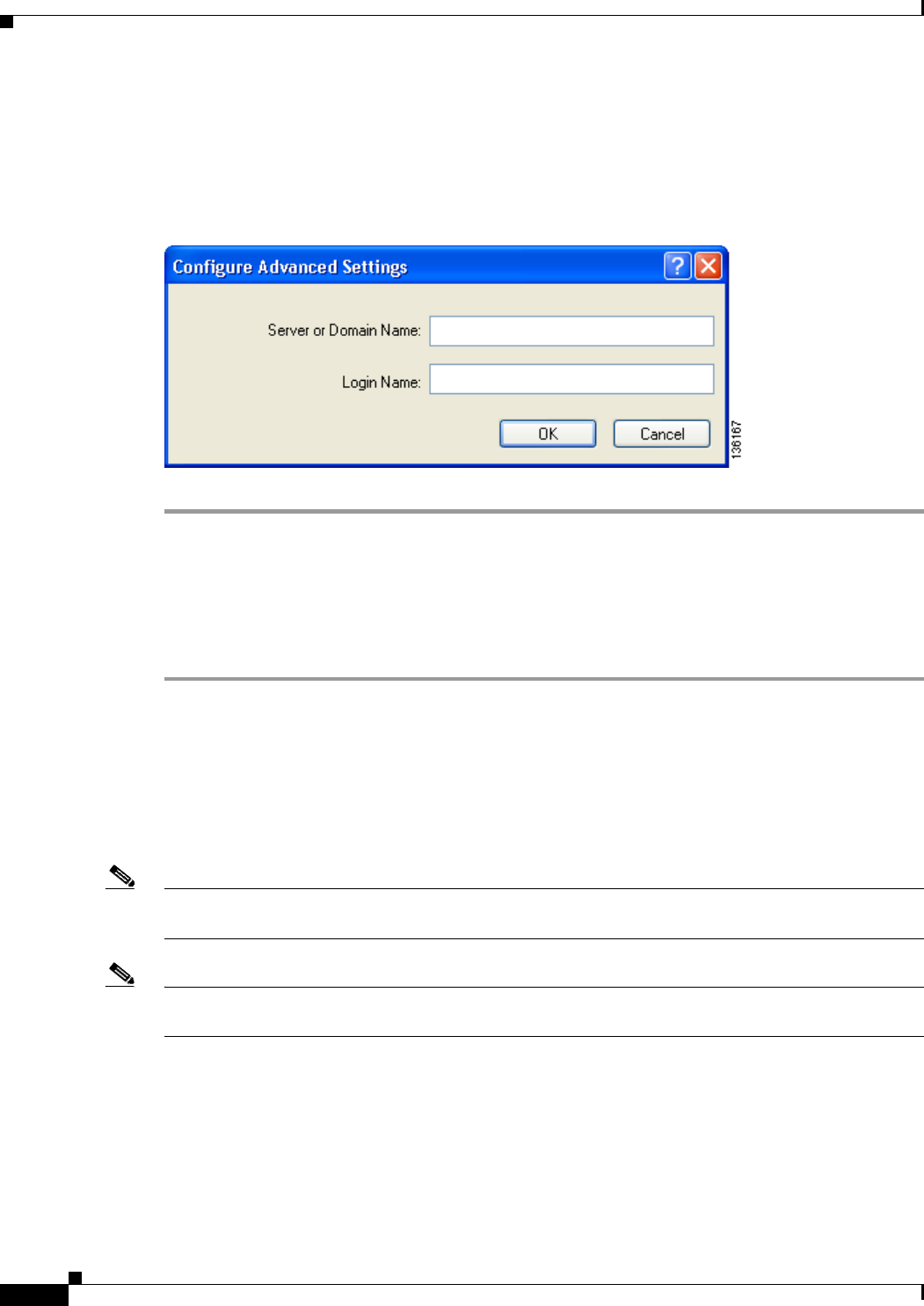
5-58
Cisco Aironet 802.11a/b/g Wireless LAN Client Adapters (CB21AG and PI21AG) Installation and Configuration Guide
OL-4211-05
Chapter 5 Configuring the Client Adapter
Setting Security Parameters
Configuring Advanced Settings
To specify a server or domain name and a login name to use for authenticating user credentials (see
Figure 5-19), follow these steps:
Figure 5-19 Configure Advanced Settings
Step 1 Leave the Specific Server or Domain field blank to allow the client to accept a certificate from any server
that supplies a certificate signed by the selected certificate authority or enter the domain name of the
server from which the client will accept a certificate.
Step 2 If the Login Name field is not filled in automatically, enter your username with nothing after it (for
example, jsmith).
Step 3 Click OK to save your settings.
Disabling Static WEP, WPA/WPA2 Passphrase, or EAP
To disable static WEP, WPA/WPA2 passphrase, or EAP authentication [LEAP, EAP-FAST, EAP-TLS,
PEAP (EAP-GTC), or PEAP (EAP-MSCHAP V2)] for a particular profile, choose None on the Profile
Management (Security) window and click OK.
Note Choosing any security option other than Pre-Shared Key (Static WEP) on the Profile Management
(Security) window disables static WEP automatically.
Note Choosing Pre-Shared Key (Static WEP) or WPA/WPA2 Passphrase on the Profile Management
(Security) window disables EAP automatically.

5-59
Cisco Aironet 802.11a/b/g Wireless LAN Client Adapters (CB21AG and PI21AG) Installation and Configuration Guide
OL-4211-05
Chapter 5 Configuring the Client Adapter
Enabling Wi-Fi Multimedia
Enabling Wi-Fi Multimedia
Wi-Fi Multimedia (WMM) is a component of the IEEE 802.11e wireless LAN standard for quality of
service (QoS). It specifically supports priority tagging and queuing. QoS is an access point feature that
enables networking professionals to provide preferential treatment to certain traffic at the expense of
other traffic. Without QoS, the access point offers best-effort service to each packet, regardless of the
packet contents or size. Implementing QoS in a wireless LAN makes network performance more
predictable and bandwidth usage more effective.
Cisco recommends that you enable WMM if your computer is running a time-sensitive application for
QoS-aware clients such as voice or video (for example, Cisco IP SoftPhone).
QoS and WMM must be enabled on the access point to which the client will associate. These features
are supported on the access point in Cisco IOS Release 12.3(2)JA or later. Refer to the documentation
for your access point for instructions on enabling these features.
WMM is supported automatically in the client adapter software. However, you must enable the Windows
QoS Packet Scheduler to ensure WMM support. Follow the instructions below to enable the QoS Packet
Scheduler on Windows 2000 or XP.
Note The QoS Packet Scheduler must be installed before you can enable it. It comes preinstalled on Windows
XP; however, you must install it on Windows 2000.
Enabling the QoS Packet Scheduler on Windows 2000
Follow these steps to enable the QoS Packet Scheduler on a computer running Windows 2000.
Step 1 Double-click My Computer,Control Panel, and Network and Dial-up Connections.
Step 2 Right-click your wireless network connection.
Step 3 Click Properties. The Wireless Cisco Connection Properties window appears (see Figure 5-20).
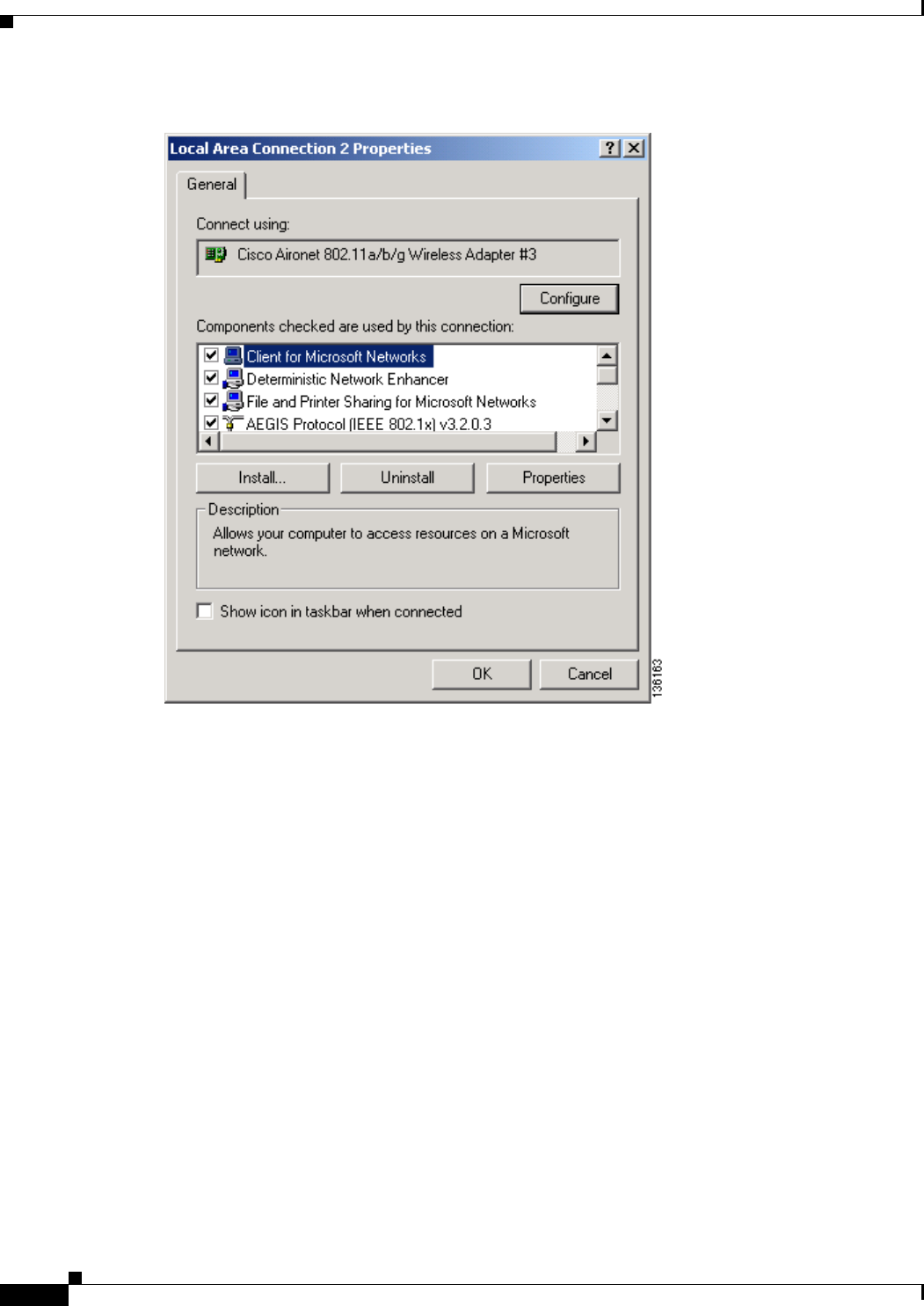
5-60
Cisco Aironet 802.11a/b/g Wireless LAN Client Adapters (CB21AG and PI21AG) Installation and Configuration Guide
OL-4211-05
Chapter 5 Configuring the Client Adapter
Enabling Wi-Fi Multimedia
Figure 5-20 Wireless Cisco Connection Properties Window
Step 4 If the QoS Packet Scheduler is already installed, it is included in the list of components that this
connection uses. If it appears in the list, go to Step 8. Otherwise, go to the next step to install it.
Step 5 Click Install. The Select Network Component Type window appears (see Figure 5-21).
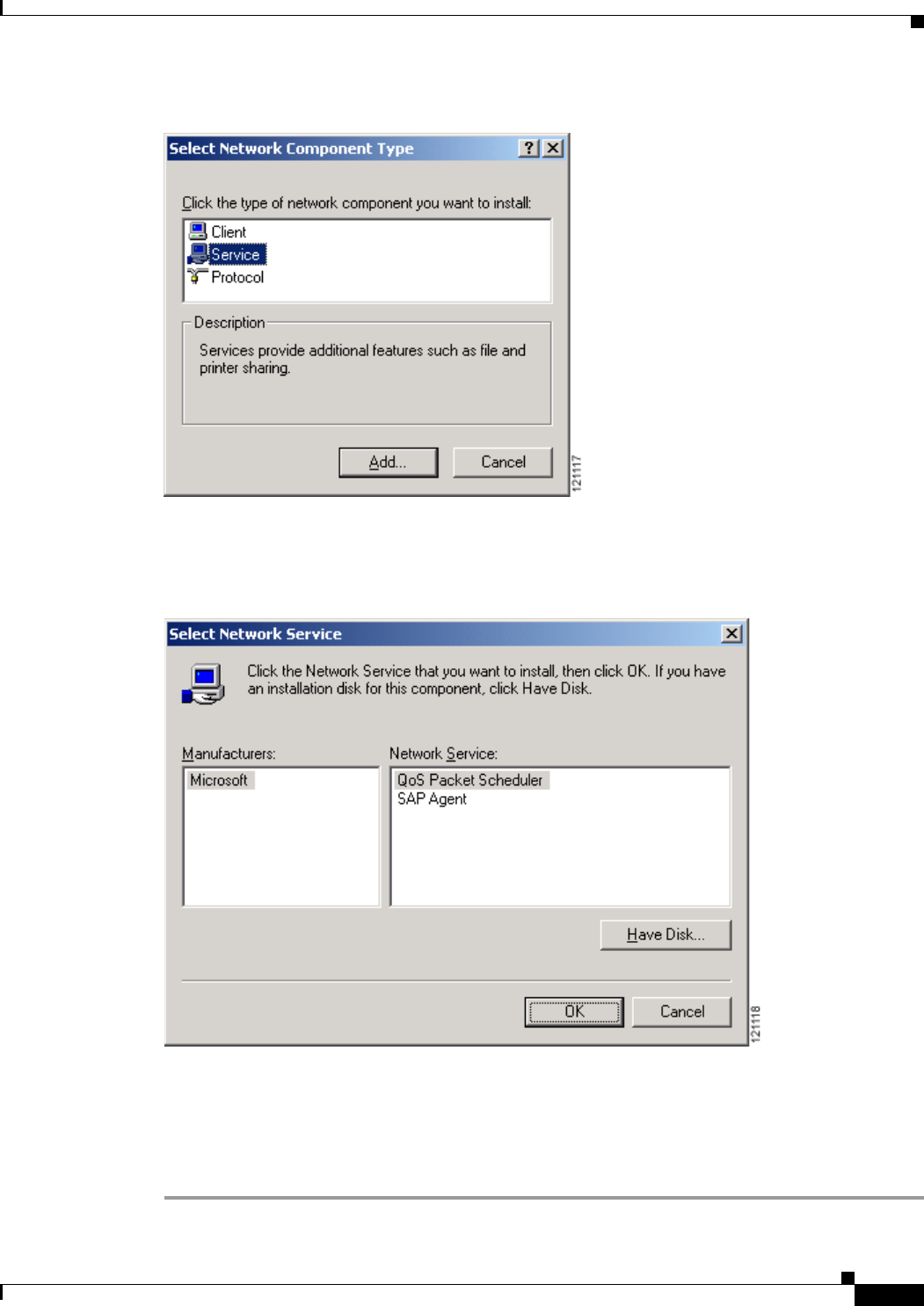
5-61
Cisco Aironet 802.11a/b/g Wireless LAN Client Adapters (CB21AG and PI21AG) Installation and Configuration Guide
OL-4211-05
Chapter 5 Configuring the Client Adapter
Enabling Wi-Fi Multimedia
Figure 5-21 Select Network Component Type Window
Step 6 Choose Service and click Add. The Select Network Service window appears (see Figure 5-22).
Figure 5-22 Select Network Service Window
Step 7 Click QoS Packet Scheduler and OK. The Wireless Cisco Connection Properties window reappears,
and the QoS Packet Scheduler is included in the list of connections.
Step 8 Check the QoS Packet Scheduler check box if it is not checked.
Step 9 Click OK.
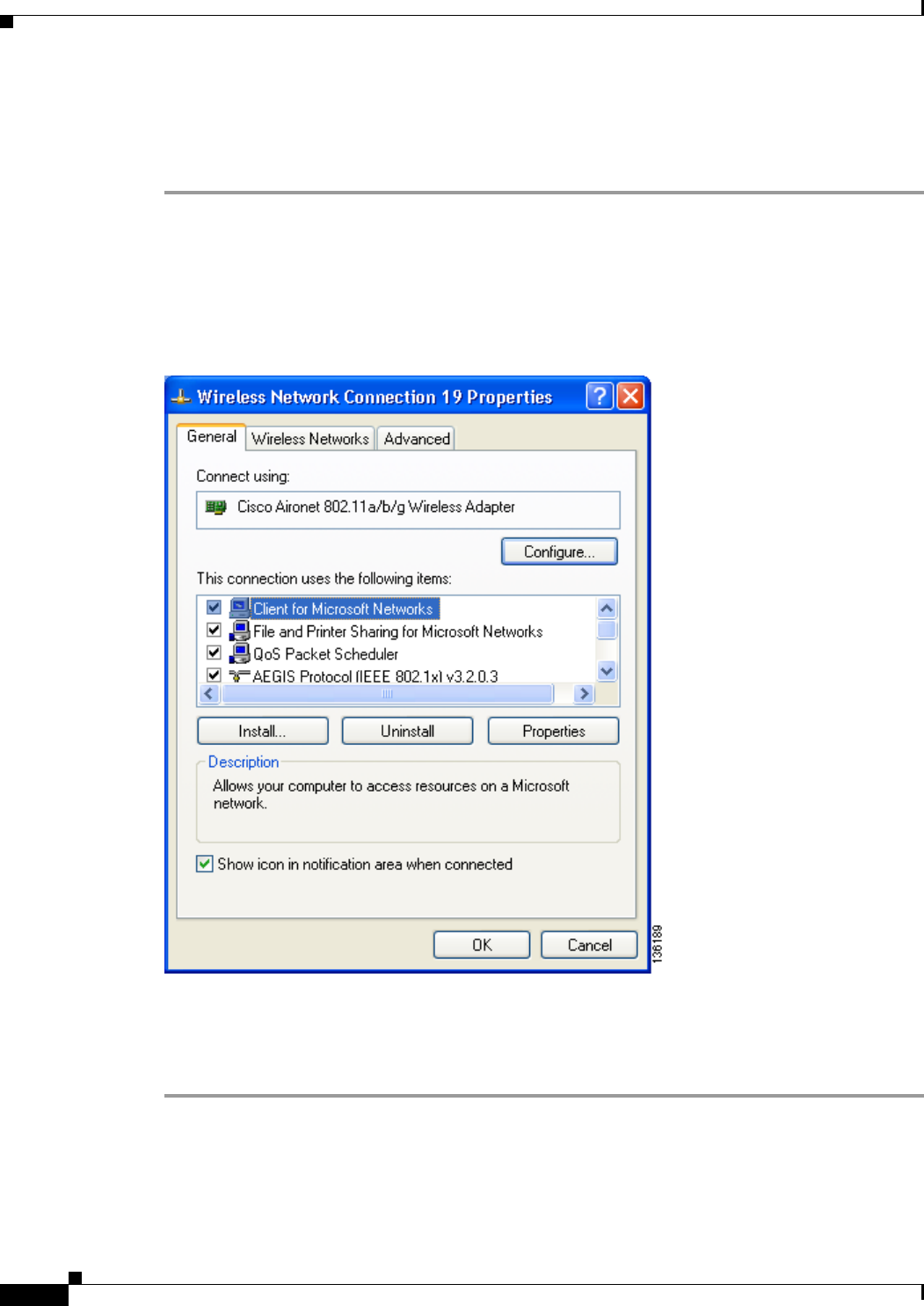
5-62
Cisco Aironet 802.11a/b/g Wireless LAN Client Adapters (CB21AG and PI21AG) Installation and Configuration Guide
OL-4211-05
Chapter 5 Configuring the Client Adapter
Enabling Wi-Fi Multimedia
Enabling the QoS Packet Scheduler on Windows XP
Follow these steps to enable the QoS Packet Scheduler on a computer running Windows XP.
Step 1 Click Control Panel.
Step 2 Double-click Network Connections.
Step 3 Right-click your wireless network connection.
Step 4 Click Properties. The Wireless Network Connection Properties window appears (see Figure 5-23).
Figure 5-23 Wireless Network Connection Properties Window
Step 5 Check the QoS Packet Scheduler check box, which appears in the list of items that this connection uses.
Step 6 Click OK.
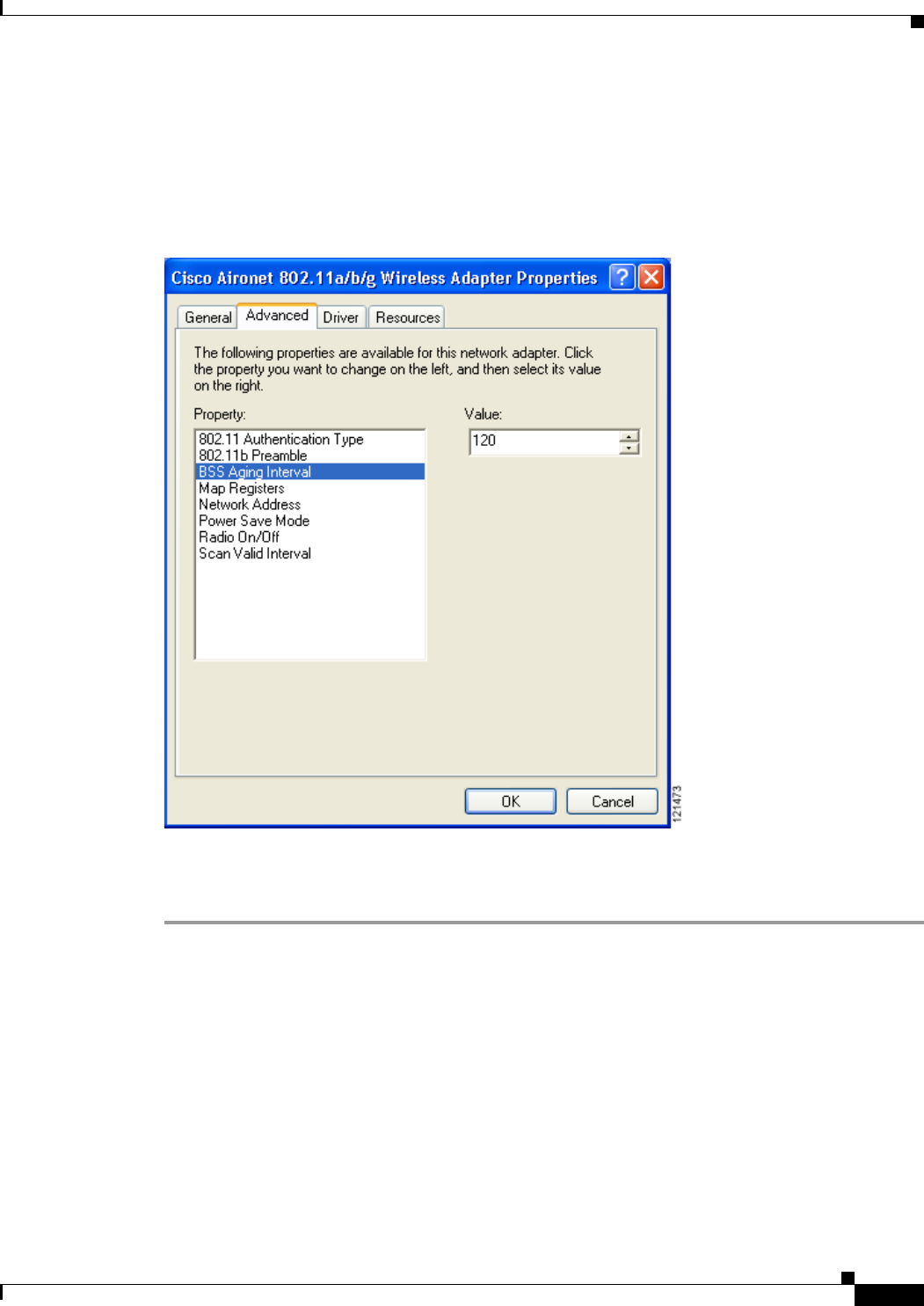
5-63
Cisco Aironet 802.11a/b/g Wireless LAN Client Adapters (CB21AG and PI21AG) Installation and Configuration Guide
OL-4211-05
Chapter 5 Configuring the Client Adapter
Setting Roaming Parameters in the Windows Control Panel
Setting Roaming Parameters in the Windows Control Panel
The Cisco Aironet 802.11a/b/g Wireless Adapter Properties window (see Figure 5-24) in the Windows
Control Panel enables you to set two parameters that regulate the client adapter’s roaming capabilities.
Figure 5-24 Cisco Aironet 802.11a/b/g Wireless Adapter Properties Window
Follow these steps to access the roaming parameters.
Step 1 Double-click My Computer,Control Panel, and System.
Step 2 Click the Hardware tab and Device Manager.
Step 3 Double-click Network Adapters.
Step 4 Right-click Cisco Aironet 802.11a/b/g Wireless Adapter.
Step 5 Click Properties and the Advanced tab. The roaming parameters appear in the Property list. Table 5-5
lists and describes the client adapter’s roaming parameters. Follow the instructions in the table to change
the parameters.

5-64
Cisco Aironet 802.11a/b/g Wireless LAN Client Adapters (CB21AG and PI21AG) Installation and Configuration Guide
OL-4211-05
Chapter 5 Configuring the Client Adapter
Setting Roaming Parameters in the Windows Control Panel
The default configuration of the client adapter software is optimized for high throughput and the lowest
power consumption. However, in some environments, this configuration can cause the client adapter to
unnecessarily stay with the currently associated access point longer than necessary.
If your application requires a faster roaming response, configure the BSS Aging Interval and Scan Valid
Interval parameters as follows:
•Set the BSS Aging Interval parameter to 20
•Set the Scan Valid Interval parameter to 20
Note If you are using client software prior to 2.7.0.2, you will not be able to set the BSS Aging Interval
parameter to 20. In that case, set it to 30.
Table 5-5 Roaming Parameters (in the Windows Control Panel)
Parameter Description
BSS Aging Interval The amount of time (in seconds) that the client keeps an access point in
its roaming scanlist after it can no longer communicate to that device.
The higher the value, the greater the number of access points to which
the client may roam.
Range: 20 to 300 seconds (in 10-second increments)
Default: 120 seconds
Note Cisco recommends that you set the BSS Aging Interval to twice
the value of the Scan Valid Interval. For example, if the Scan
Valid Interval is 50, the BSS Aging Interval would be 100.
Scan Valid Interval The amount of time (in seconds) before the client starts scanning for a
better access point after reaching the roaming threshold or missing
beacons. (See the threshold criteria in the table below.) The higher the
value, the less time the client spends scanning for a better access point
and the more time it has to send data.
Range: 20 to 120 seconds (in 5-second increments)
Default: 60 seconds
Note The client does not scan for a new access point as long as it has
a good connection and is passing data.
Wireless Mode
Signal Strength
Threshold (dBm)
Transmit Rate
Threshold (Mbps)
5 GHz, 54 Mbps or
2.4 GHz, 54 Mbps
24 24
2.4 GHz, 11 Mbps
(other modes enabled)
24 9
2.4 GHz, 11 Mbps
(only mode enabled)
24 5

5-65
Cisco Aironet 802.11a/b/g Wireless LAN Client Adapters (CB21AG and PI21AG) Installation and Configuration Guide
OL-4211-05
Chapter 5 Configuring the Client Adapter
Configuring Band Usage
Configuring Band Usage
If your AP coverage permits it, follow these steps to configure the client profile only in ADU to use the
5GHz (802.11a) or 2.4GHz (802.11b/g) band, not both:
Step 1 Launch ADU.
Step 2 Click Profile Management.
Step 3 Select the profile of interest and click Modify.
Step 4 Click Advanced.
Step 5 Under Wireless Mode, uncheck the rates that you do not intend to use.
If you do not use ADU to manage CB21AG, then you must use registry settings to select the rates. Follow
these steps:
1. Launch regedit and navigate to the following entry:
HKLM\System\CurrentControlSet\Control\Class\{4D36E972-E325-11CE-BFC1-08002bE10318}
2. Right-click and choose Find and find the variable called “NetBand.”
This variable will be under a four-digit subkey whose DriverDesc value is “Cisco Aironet
802.11a/b/g Wireless Adapter.”
The NetBand REG_SZ variable is a bitmask of supported rates. By default, this variable it is set to
15 decimal (0x0F). The supported values are:
–
802.11a 0x01
–
(not used) 0x02
–
802.11b 0x04
–
802.11g 0x08
–
(not used) 0x10
For example, to support only 11b and 11g rates, the bitmask would be 0x04 + 0x08 = 0x0C = 12 decimal.

5-66
Cisco Aironet 802.11a/b/g Wireless LAN Client Adapters (CB21AG and PI21AG) Installation and Configuration Guide
OL-4211-05
Chapter 5 Configuring the Client Adapter
Configuring Band Usage

CHAPTER
6-1
Cisco Aironet 802.11a/b/g Wireless LAN Client Adapters (CB21AG and PI21AG) Installation and Configuration Guide
OL-4211-05
6
Using EAP Authentication
This chapter explains the sequence of events that occurs and the actions you must take when a profile
that is set for EAP authentication is activated.
The following topics are covered in this chapter:
•Overview, page 6-2
•Using LEAP or EAP-FAST, page 6-2
•Using LEAP or EAP-FAST with the Windows Username and Password, page 6-3
•Using LEAP or EAP-FAST with an Automatically Prompted Login, page 6-6
•Using LEAP or EAP-FAST with a Manually Prompted Login, page 6-9
•Using LEAP or EAP-FAST with a Saved Username and Password, page 6-13
•Using EAP-TLS, page 6-14
•Using PEAP (EAP-GTC), page 6-15
•Using PEAP (EAP-MSCHAP V2), page 6-16
•Restarting the Authentication Process, page 6-16
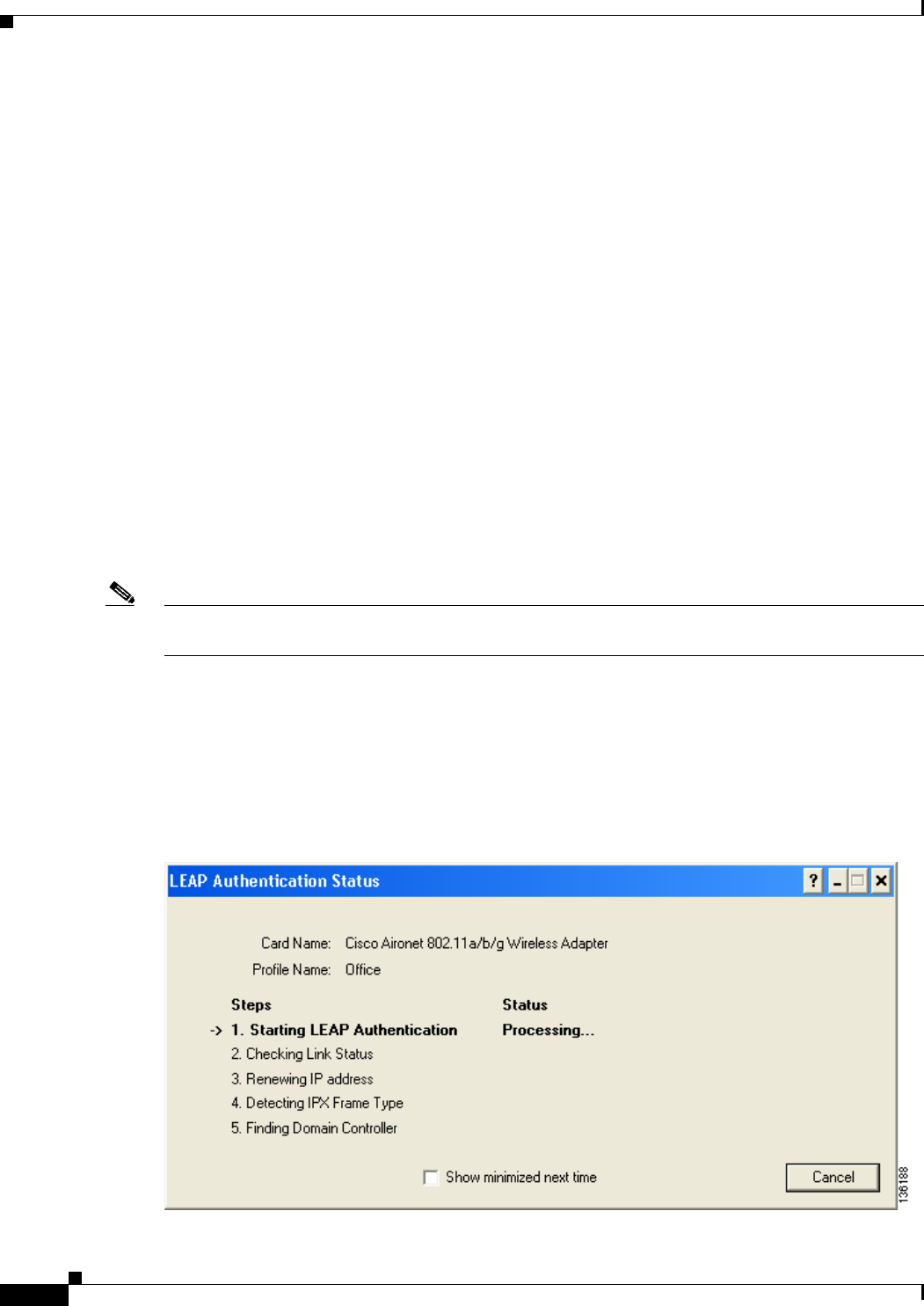
6-2
Cisco Aironet 802.11a/b/g Wireless LAN Client Adapters (CB21AG and PI21AG) Installation and Configuration Guide
OL-4211-05
Chapter 6 Using EAP Authentication
Overview
Overview
This chapter explains the sequence of events that occurs after you (or auto profile selection) activate a
profile that uses EAP authentication or you eject and reinsert the client adapter, reboot the computer, log
on while this profile is active, or are informed that your password has expired or is invalid. The chapter
contains seven sections based on the profile’s authentication type and its username and password
settings:
•LEAP or EAP-FAST with the Windows username and password, page 6-3
•LEAP or EAP-FAST with an automatically prompted login, page 6-6
•LEAP or EAP-FAST with a manually prompted login, page 6-9
•LEAP or EAP-FAST with a saved username and password, page 6-13
•EAP-TLS, page 6-14
•PEAP (EAP-GTC), page 6-15
•PEAP (EAP-MSCHAP V2), page 6-16
Also provided are an overview of LEAP and EAP-FAST authentication (below) and instructions for
restarting the authentication process when necessary (page 6-16).
Follow the instructions for your profile’s authentication type and credential settings to successfully
authenticate.
Note If any error messages appear during authentication, refer to Chapter 10 for explanations and
recommended actions.
Using LEAP or EAP-FAST
When LEAP or EAP-FAST authentication begins, the LEAP or EAP-FAST Authentication Status
window appears (see Figure 6-1).
Figure 6-1 LEAP or EAP-FAST Authentication Status Window

6-3
Cisco Aironet 802.11a/b/g Wireless LAN Client Adapters (CB21AG and PI21AG) Installation and Configuration Guide
OL-4211-05
Chapter 6 Using EAP Authentication
Using LEAP or EAP-FAST with the Windows Username and Password
This window provides information about the status of LEAP or EAP-FAST authentication. Table 6-1
lists and explains the stages of LEAP or EAP-FAST authentication. As each stage is completed, a status
message (such as Success) appears in the Status field. If any error messages appear, refer to the “Error
Messages” section on page 10-12 for an explanation and the recommended action to take.
If you do not want the LEAP or EAP-FAST Authentication Status window to appear each time the client
adapter attempts to authenticate using LEAP or EAP-FAST, check the Show minimized next time check
box at the bottom of the window. On future LEAP or EAP-FAST authentication attempts, the LEAP or
EAP-FAST Authentication Status window appears minimized in the Windows taskbar.
Note To make the LEAP or EAP-FAST Authentication Status window reappear once it has been minimized,
click the LEAP Authentication Status or EAP-FAST Authentication Status tab in the Windows
taskbar and uncheck the Show minimized next time check box. The LEAP or EAP-FAST
Authentication Status window should now appear for all future LEAP or EAP-FAST authentication
attempts.
Using LEAP or EAP-FAST with the Windows Username and
Password
Table 6-1 Stages of LEAP or EAP-FAST Authentication
Stage Explanation
Starting LEAP or EAP-FAST
Authentication
The client adapter associates to an access point, and the LEAP
or EAP-FAST authentication process begins.
Checking Link Status The client adapter is EAP authenticated, and the network
connection is verified.
Renewing IP Address If DHCP is enabled, the IP address is released and renewed.
Detecting IPX Frame Type The IPX frame type is reset if AutoDetect is enabled.
Finding Domain Controller If you are logging into a domain and the active profile
specifies that the domain name be included, an attempt is
made to find the domain controller to make sure subsequent
access to the domain is successful.

6-4
Cisco Aironet 802.11a/b/g Wireless LAN Client Adapters (CB21AG and PI21AG) Installation and Configuration Guide
OL-4211-05
Chapter 6 Using EAP Authentication
Using LEAP or EAP-FAST with the Windows Username and Password
After Profile Activation or Card Insertion
After you (or auto profile selection) activate a profile that uses your Windows username and password
for LEAP or EAP-FAST authentication or you eject and reinsert the client adapter while this profile is
active, the following events occur:
1. The LEAP or EAP-FAST Authentication Status window appears.
2. If your profile is configured for EAP-FAST and a message appears asking if you want to
auto-provision a PAC, click Yes.
3. If your client adapter authenticates, the window shows that each stage was successful and then
disappears. ASTU and the Link Status field on the ADU Current Status window show Authenticated.
If the authentication attempt fails, an error message appears after the authentication timeout period
has expired. Refer to the “Error Messages” section on page 10-12 for the necessary action to take.
After a Reboot or Logon
After your computer reboots or you log on, follow these steps to authenticate using LEAP or EAP-FAST.
Step 1 When the Windows login window appears, enter your Windows username and password and click OK.
The domain name is optional.
Note If your computer has Novell Client 32 software installed, a separate LEAP or EAP-FAST login
window appears before the Novell login window. If this occurs, enter your Windows and Novell
username and password in the login windows and click OK.
The LEAP or EAP-FAST Authentication Status window appears.
Step 2 If your profile is configured for EAP-FAST and a message appears asking if you want to auto-provision
a PAC, click Ye s .
Step 3 If your client adapter authenticates, the window shows that each stage was successful and then
disappears.
If the authentication attempt fails, an error message appears after the authentication timeout period has
expired. Refer to the “Error Messages” section on page 10-12 for the necessary action to take.
Step 4 Windows continues to log you onto the system. ASTU and the Link Status field on the ADU Current
Status window show Authenticated.
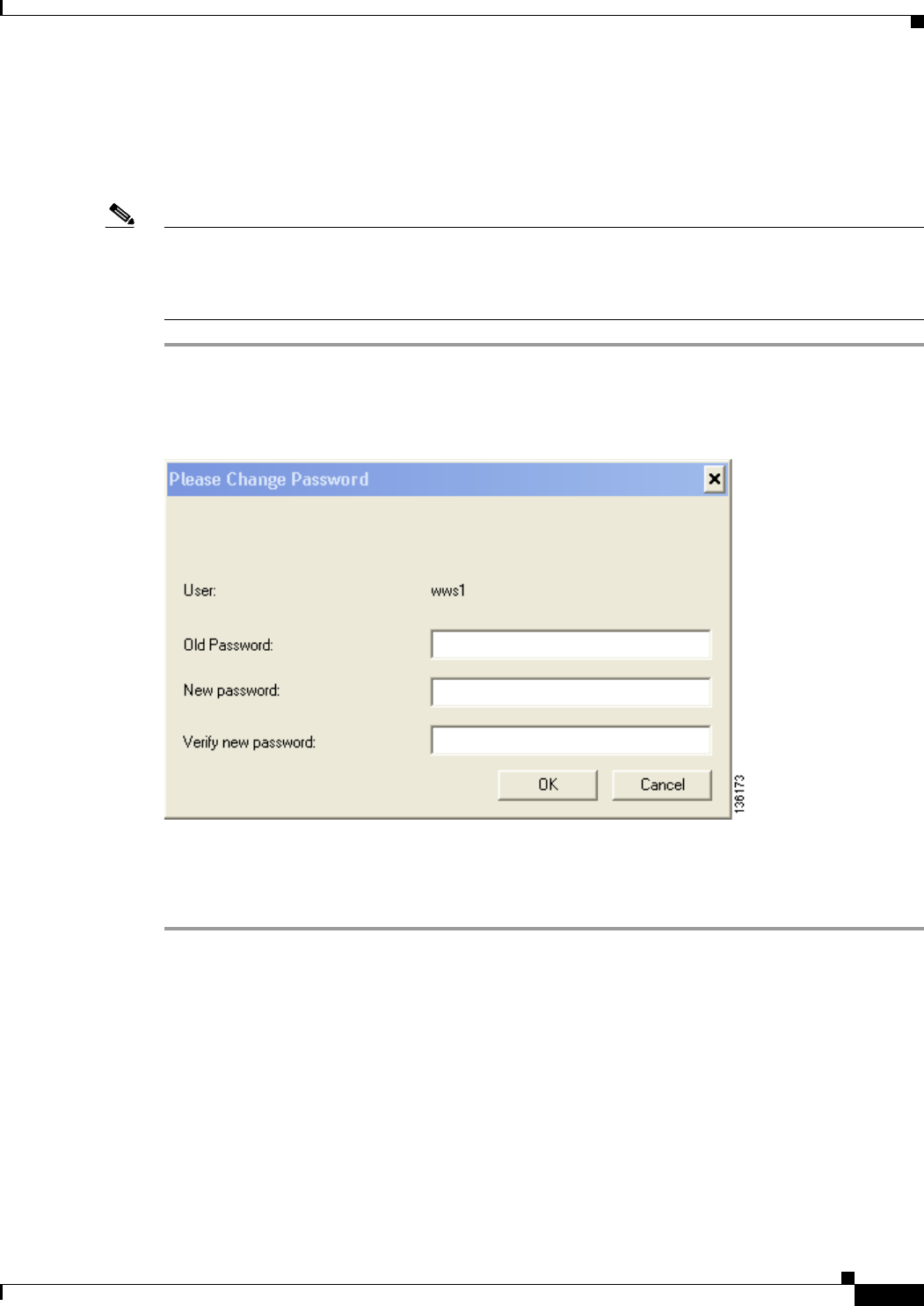
6-5
Cisco Aironet 802.11a/b/g Wireless LAN Client Adapters (CB21AG and PI21AG) Installation and Configuration Guide
OL-4211-05
Chapter 6 Using EAP Authentication
Using LEAP or EAP-FAST with the Windows Username and Password
After Your EAP-FAST Password Expires
If the EAP-FAST password for your current profile expires or becomes invalid, follow these steps to
change your password.
Note If you change your Windows password using the standard Windows Change Password function, the
client updates the EAP-FAST password automatically and maintains its connection to the access point
if the current profile uses the Windows username and password. However, data packets may be dropped
during this process.
Step 1 When the Please Change Password window appears (see Figure 6-2) to indicate that your password is
invalid, enter your old password in the Old Password field.
Figure 6-2 Please Change Password Window
Step 2 Enter your new password in both the New Password and Verify New Password fields and click OK.
Step 3 If prompted, log off and on again in order to update your local cached account with your new password.
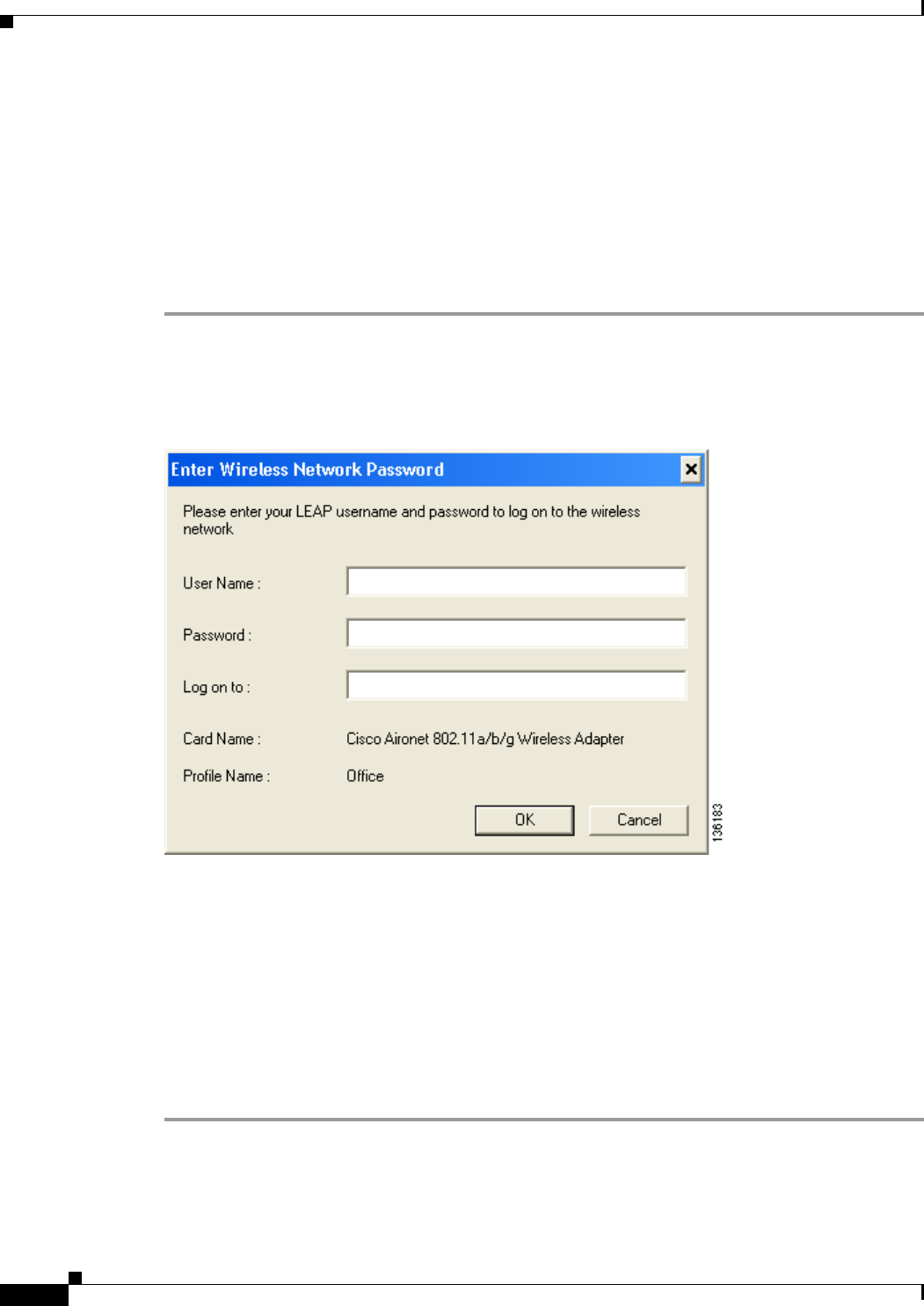
6-6
Cisco Aironet 802.11a/b/g Wireless LAN Client Adapters (CB21AG and PI21AG) Installation and Configuration Guide
OL-4211-05
Chapter 6 Using EAP Authentication
Using LEAP or EAP-FAST with an Automatically Prompted Login
Using LEAP or EAP-FAST with an Automatically Prompted Login
After Profile Activation or Card Insertion
After you (or auto profile selection) activate a profile that uses a separate username and password for
LEAP or EAP-FAST authentication or you eject and reinsert the client adapter while this profile is
active, follow these steps to authenticate.
Step 1 When the Enter Wireless Network Password window appears (see Figure 6-3), enter your LEAP or
EAP-FAST username and password and click OK. The domain name can be entered in the Log On To
field; it is optional.
Figure 6-3 Enter Wireless Network Password Window
The LEAP or EAP-FAST Authentication Status window appears.
Step 2 If your profile is configured for EAP-FAST and a message appears asking if you want to auto-provision
a PAC, click Ye s .
Step 3 If your client adapter authenticates, the LEAP or EAP -FAST Authentication Status window shows that
each stage was successful and then disappears. ASTU and the Link Status field on the ADU Current
Status window show Authenticated.
If the authentication attempt fails, an error message appears after the authentication timeout period has
expired. Refer to the “Error Messages” section on page 10-12 for the necessary action to take.
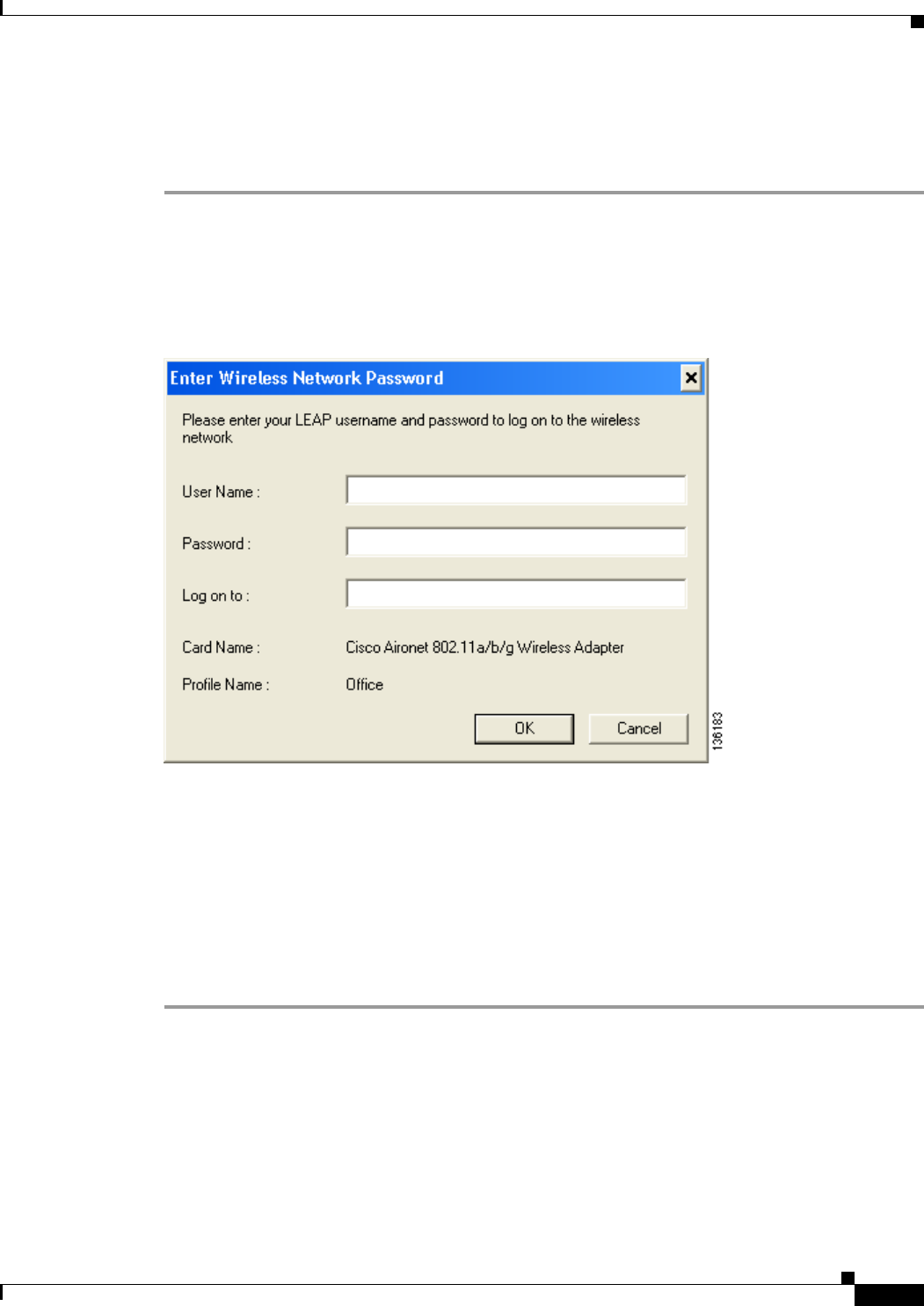
6-7
Cisco Aironet 802.11a/b/g Wireless LAN Client Adapters (CB21AG and PI21AG) Installation and Configuration Guide
OL-4211-05
Chapter 6 Using EAP Authentication
Using LEAP or EAP-FAST with an Automatically Prompted Login
After a Reboot or Logon
After your computer reboots or you log on, follow these steps to authenticate using LEAP or EAP-FAST.
Step 1 When the Windows login window appears, enter your Windows username and password and click OK.
Step 2 When the Enter Wireless Network Password window appears (see Figure 6-4), enter your LEAP or
EAP-FAST username and password and click OK. The domain name can be entered in the Log On To
field; it is optional.
Figure 6-4 Enter Wireless Network Password Window
The LEAP or EAP-FAST Authentication Status window appears.
Step 3 If your profile is configured for EAP-FAST and a message appears asking if you want to auto-provision
a PAC, click Ye s .
Step 4 If your client adapter authenticates, the window shows that each stage was successful and then
disappears. The logon or boot-up process completes.
If the authentication attempt fails, an error message appears after the authentication timeout period has
expired. Refer to the “Error Messages” section on page 10-12 for the necessary action to take.
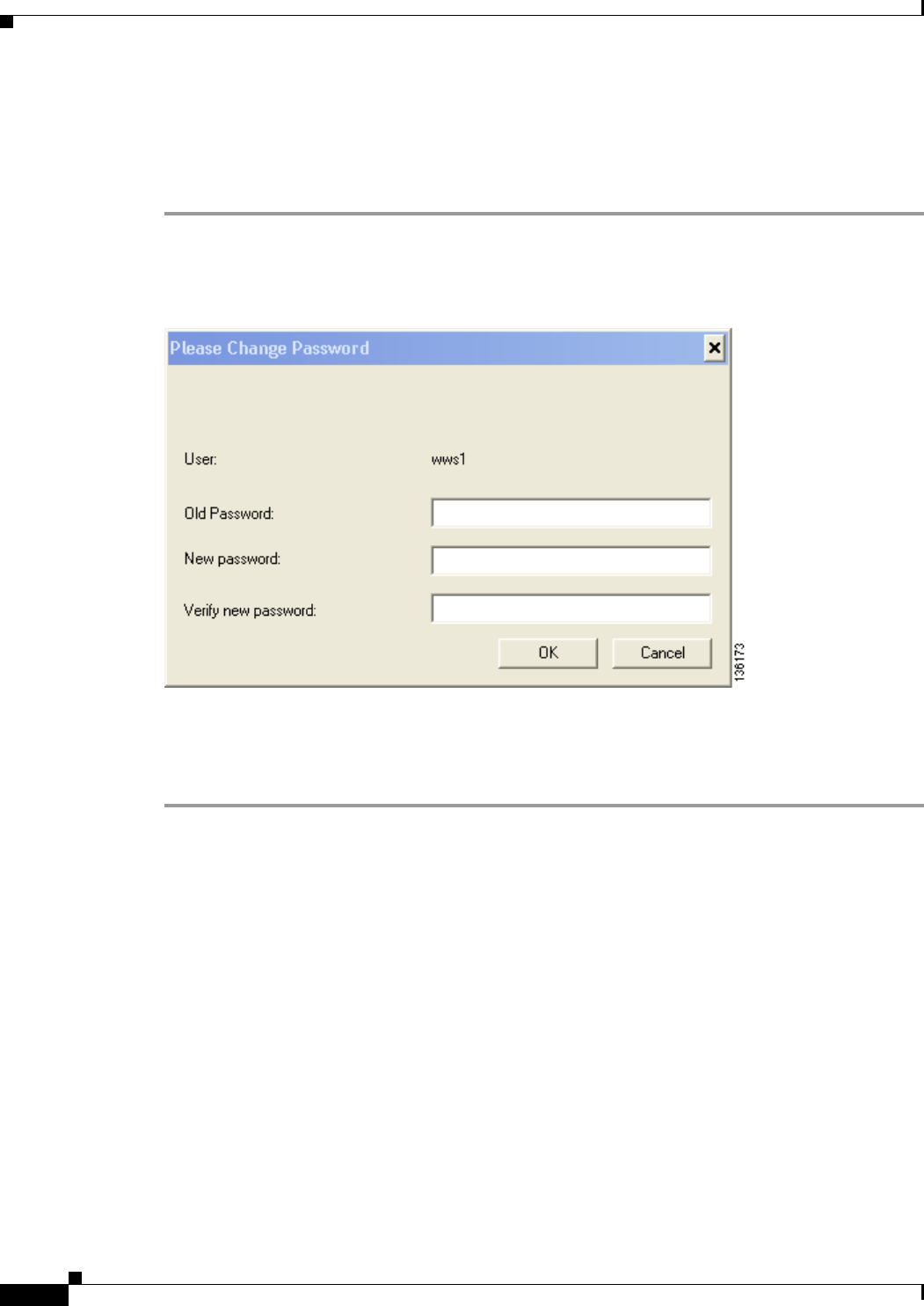
6-8
Cisco Aironet 802.11a/b/g Wireless LAN Client Adapters (CB21AG and PI21AG) Installation and Configuration Guide
OL-4211-05
Chapter 6 Using EAP Authentication
Using LEAP or EAP-FAST with an Automatically Prompted Login
After Your EAP-FAST Password Expires
If the EAP-FAST password for your current profile expires or becomes invalid, follow these steps to
change your password.
Step 1 When the Please Change Password window appears (see Figure 6-5) to indicate that your password is
invalid, enter your old password in the Old Password field.
Figure 6-5 Please Change Password Window
Step 2 Enter your new password in both the New Password and Verify New Password fields.
Step 3 Click OK. The client adapter should authenticate using your new password.
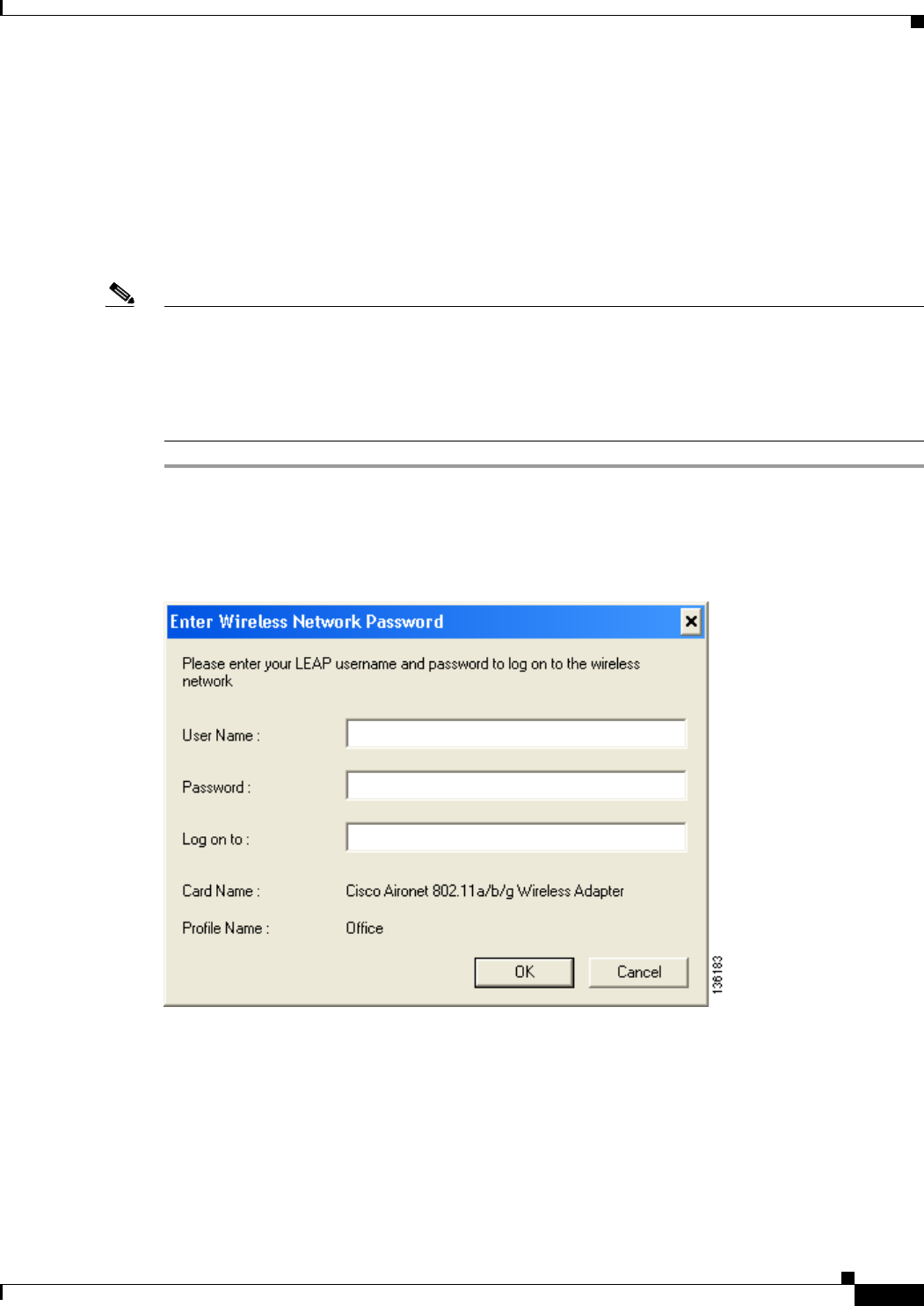
6-9
Cisco Aironet 802.11a/b/g Wireless LAN Client Adapters (CB21AG and PI21AG) Installation and Configuration Guide
OL-4211-05
Chapter 6 Using EAP Authentication
Using LEAP or EAP-FAST with a Manually Prompted Login
Using LEAP or EAP-FAST with a Manually Prompted Login
After Profile Activation
After you (or auto profile selection) activate a profile that uses LEAP or EAP-FAST authentication with
a manually prompted login, follow these steps to authenticate.
Note If auto profile selection is enabled, this procedure is applicable the first time auto profile selection
activates a manual LEAP or manual EAP-FAST profile. After you follow these steps to enter your LEAP
or EAP-FAST credentials, you can switch profiles without having to re-enter your credentials until you
reboot your computer, eject and reinsert your client adapter, or change the profile in any way (including
its priority in auto profile selection). If auto profile selection is disabled, you must re-enter your
credentials every time you activate a manual LEAP or manual EAP-FAST profile.
Step 1 When the Enter Wireless Network Password window appears (see Figure 6-6), enter your LEAP or
EAP-FAST username and password and click OK. The domain name can be entered in the Log On To
field; it is optional.
Figure 6-6 Enter Wireless Network Password Window
The LEAP or EAP-FAST Authentication Status window appears.
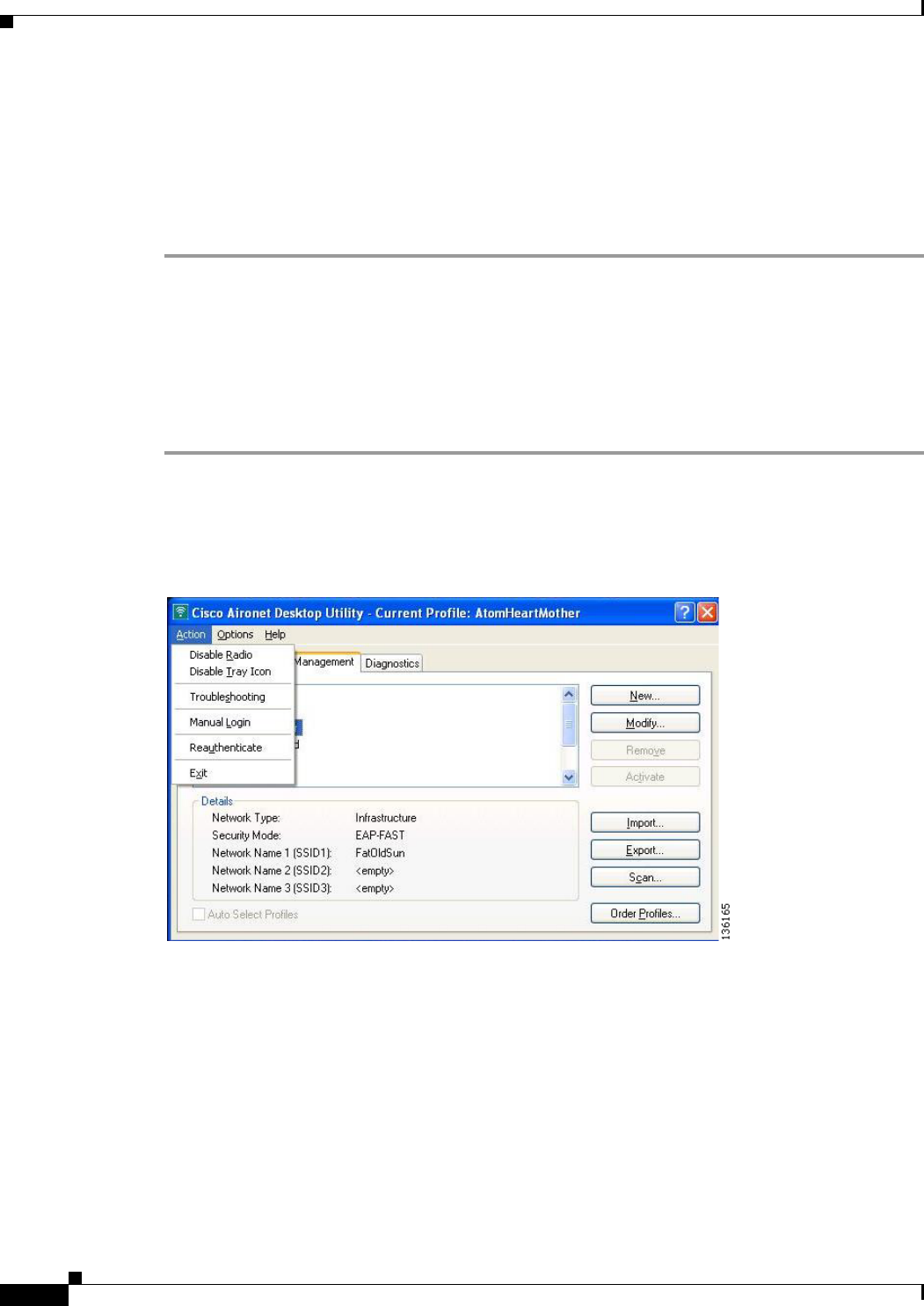
6-10
Cisco Aironet 802.11a/b/g Wireless LAN Client Adapters (CB21AG and PI21AG) Installation and Configuration Guide
OL-4211-05
Chapter 6 Using EAP Authentication
Using LEAP or EAP-FAST with a Manually Prompted Login
Step 2 If your profile is configured for EAP-FAST and a message appears asking if you want to auto-provision
a PAC, click Ye s .
Step 3 If your client adapter authenticates, the window shows that each stage was successful and then
disappears. ASTU and the Link Status field on the ADU Current Status window show Authenticated.
If the authentication attempt fails, an error message appears after the authentication timeout period has
expired. Refer to the “Error Messages” section on page 10-12 for the necessary action to take.
After a Reboot, Logon, or Card Insertion
After your computer reboots, you log on, or you eject and reinsert the client adapter, the adapter does
not automatically attempt to authenticate. You must manually invoke the authentication process. To do
so, follow these steps.
Step 1 If you rebooted your computer or logged on, complete your standard Windows login. Then open ASTU
or ADU.
Step 2 Choose the Manual Login option from the ADU Action drop-down menu (see Figure 6-7).
Figure 6-7 Action Drop-Down Menu
You can also choose the Manual Login option from the ASTU pop-up menu (see Figure 6-8).
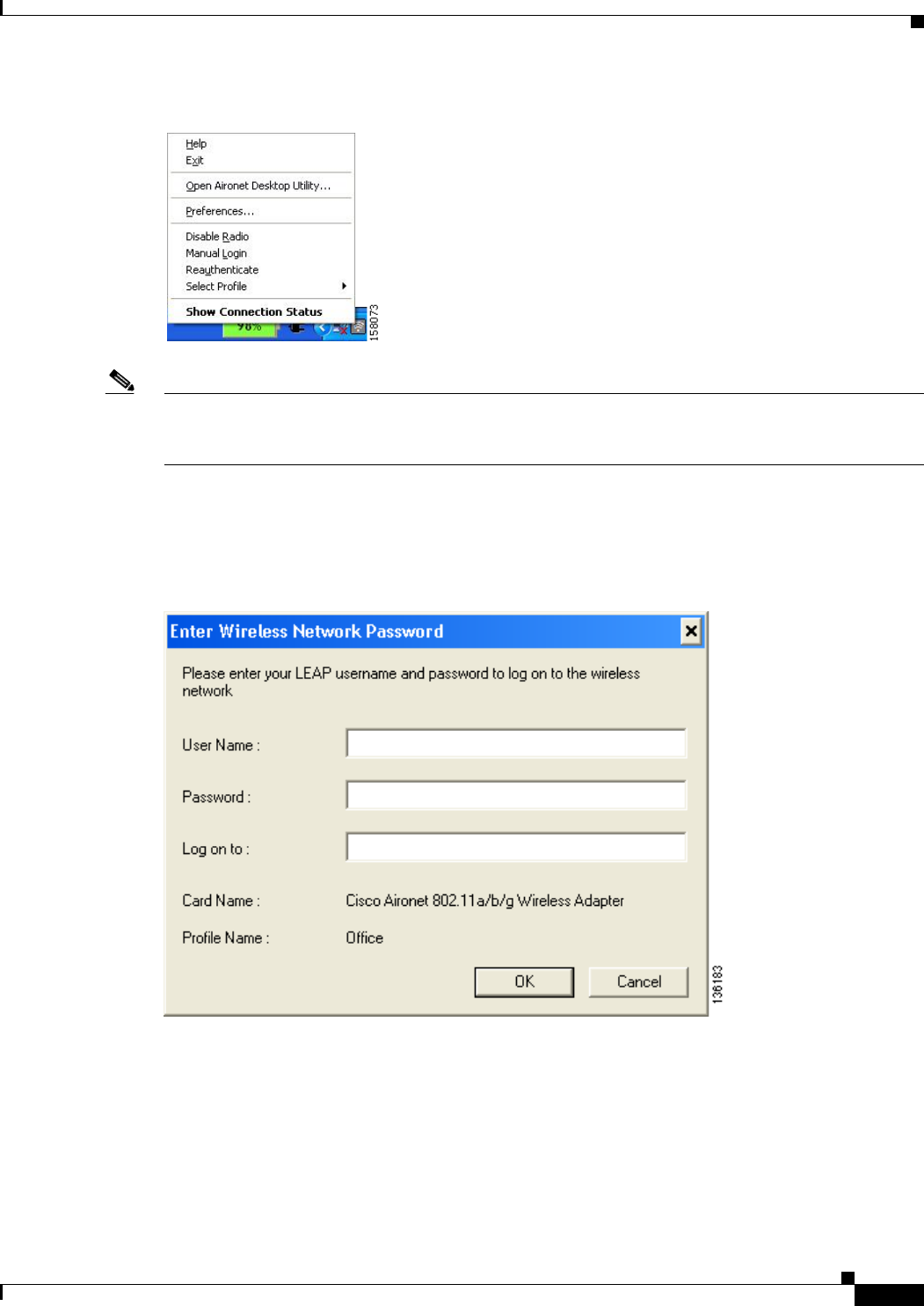
6-11
Cisco Aironet 802.11a/b/g Wireless LAN Client Adapters (CB21AG and PI21AG) Installation and Configuration Guide
OL-4211-05
Chapter 6 Using EAP Authentication
Using LEAP or EAP-FAST with a Manually Prompted Login
Figure 6-8 ASTU Pop-Up Menu
Note In ACAU, you can enable the Manual Login option in ASTU by clicking the Global Settings tab,
double-clicking Global Settings, double-clicking ASTU Settings, and choosing Yes under Manual
Login.
Step 3 When the Enter Wireless Network Password window appears (see Figure 6-9), enter your LEAP or
EAP-FAST username and password and click OK. The domain name can be entered in the Log On To
field; it is optional.
Figure 6-9 Enter Wireless Network Password Window
The LEAP or EAP-FAST Authentication Status window appears.
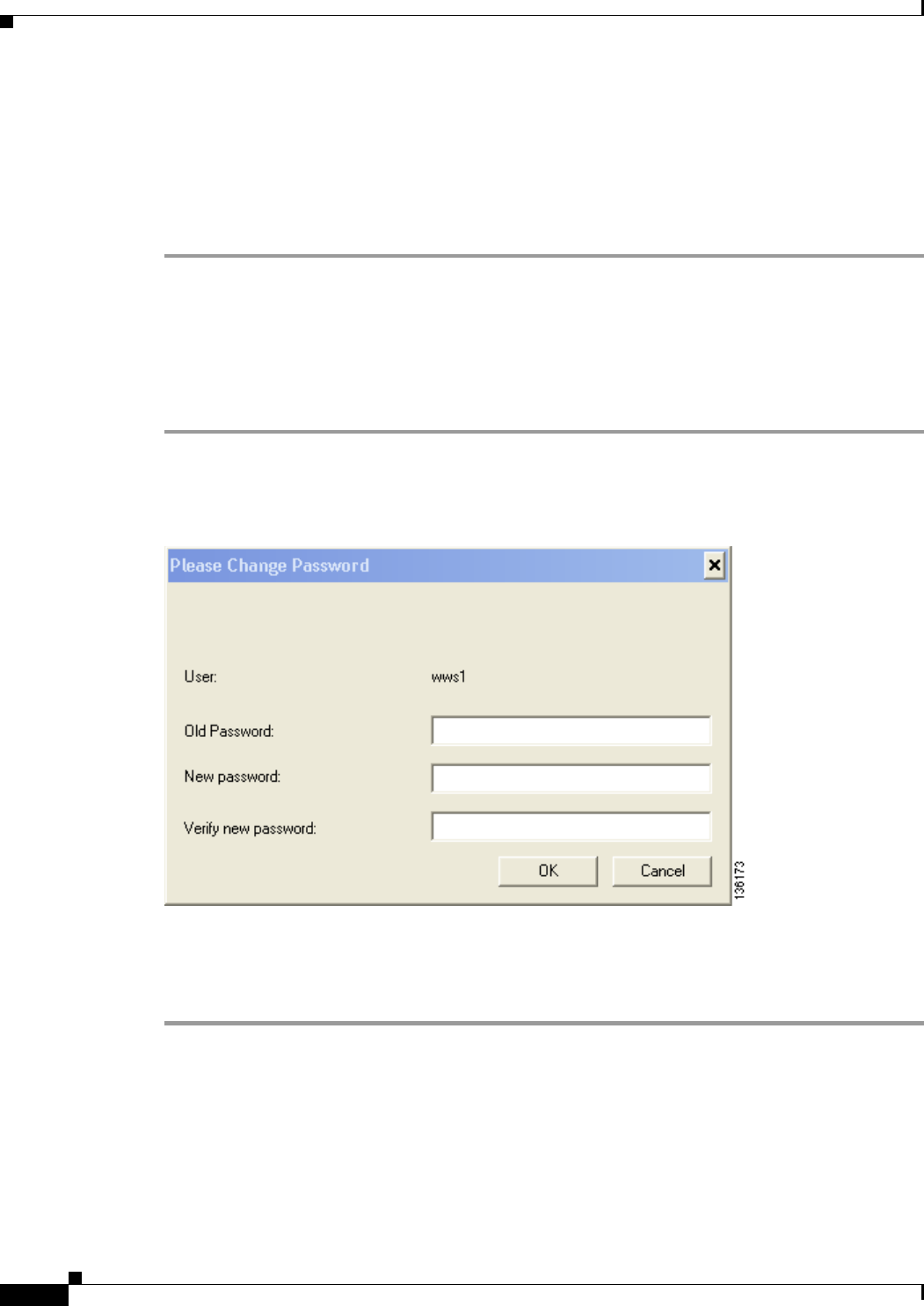
6-12
Cisco Aironet 802.11a/b/g Wireless LAN Client Adapters (CB21AG and PI21AG) Installation and Configuration Guide
OL-4211-05
Chapter 6 Using EAP Authentication
Using LEAP or EAP-FAST with a Manually Prompted Login
Step 4 If your profile is configured for EAP-FAST and a message appears asking if you want to auto-provision
a PAC, click Ye s .
Step 5 If your client adapter authenticates, the window shows that each stage was successful and then
disappears. ASTU and the Link Status field on the ADU Current Status window show Authenticated.
If the authentication attempt fails, an error message appears after the authentication timeout period has
expired. Refer to the “Error Messages” section on page 10-12 for the necessary action to take.
After Your EAP-FAST Password Expires
If the EAP-FAST password for your current profile expires or becomes invalid, follow these steps to
change your password.
Step 1 When the Please Change Password window appears (see Figure 6-10) to indicate that your password is
invalid, enter your old password in the Old Password field.
Figure 6-10 Please Change Password Window
Step 2 Enter your new password in both the New Password and Verify New Password fields.
Step 3 Click OK. The client adapter should authenticate using your new password.

6-13
Cisco Aironet 802.11a/b/g Wireless LAN Client Adapters (CB21AG and PI21AG) Installation and Configuration Guide
OL-4211-05
Chapter 6 Using EAP Authentication
Using LEAP or EAP-FAST with a Saved Username and Password
Using LEAP or EAP-FAST with a Saved Username and Password
After Profile Activation or Card Insertion
After you (or auto profile selection) activate a profile that uses LEAP or EAP-FAST authentication with
a saved LEAP or EAP-FAST username and password or you eject and reinsert the client adapter while
this profile is active, the following events occur:
1. The LEAP or EAP-FAST Authentication Status window appears.
2. If your profile is configured for EAP-FAST and a message appears asking if you want to
auto-provision a PAC, click Yes.
3. If your client adapter authenticates, the window shows that each stage was successful and then
disappears. ASTU and the Link Status field on the ADU Current Status window show Authenticated.
If the authentication attempt fails, an error message appears after the authentication timeout period
has expired. Refer to the “Error Messages” section on page 10-12 for the necessary action to take.
After a Reboot or Logon
After your computer reboots or you log on, the following events occur:
1. After you enter your Windows username and password, the authentication process begins
automatically using your saved LEAP or EAP-FAST username and password.
Note If you unchecked the No Network Connection Unless User Is Logged In check box on the
LEAP Settings window or EAP-FAST Settings window, the EAP authentication process
begins before the Windows login window appears.
2. If your profile is configured for EAP-FAST and a message appears asking if you want to
auto-provision a PAC, click Yes.
3. If your client adapter authenticates, the LEAP or EAP-FAST Authentication Status window shows
that each stage was successful and then disappears.
If the authentication attempt fails, an error message appears after the authentication timeout period
has expired. Refer to the “Error Messages” section on page 10-12 for the necessary action to take.
4. Windows continues to log you onto the system. ASTU and the Link Status field on the ADU Current
Status window show Authenticated.
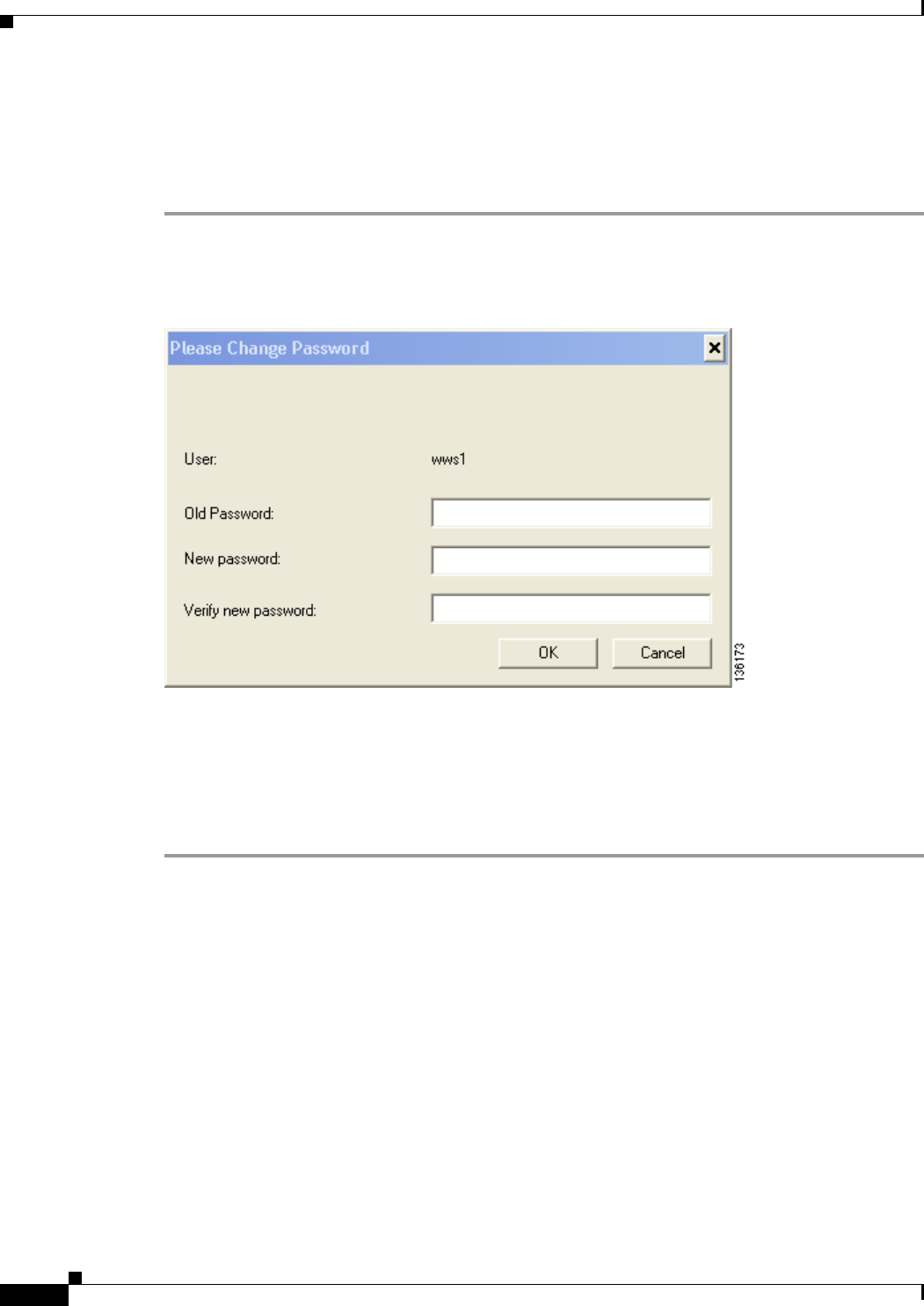
6-14
Cisco Aironet 802.11a/b/g Wireless LAN Client Adapters (CB21AG and PI21AG) Installation and Configuration Guide
OL-4211-05
Chapter 6 Using EAP Authentication
Using EAP-TLS
After Your EAP-FAST Password Expires
If the EAP-FAST password for your current profile expires or becomes invalid, follow these steps to
change your password.
Step 1 When the Please Change Password window appears (see Figure 6-11) to indicate that your password is
invalid, enter your old password in the Old Password field.
Figure 6-11 Please Change Password Window
Step 2 Enter your new password in both the New Password and Verify New Password fields.
Step 3 Click OK. The client adapter should authenticate using your new password.
Step 4 Edit the profile in ADU by changing the saved username and password on the EAP-FAST Settings
window.
Using EAP-TLS
After you (or auto profile selection) activate a profile that uses EAP-TLS authentication or you eject and
reinsert the client adapter, reboot the computer, or log on while this profile is active, the EAP
authentication process begins automatically, and the client adapter should EAP authenticate.
If your client adapter authenticates, ASTU and the Link Status field on the ADU Current Status window
show Authenticated. If the authentication attempt fails, ASTU and ADU show Authentication Failed.
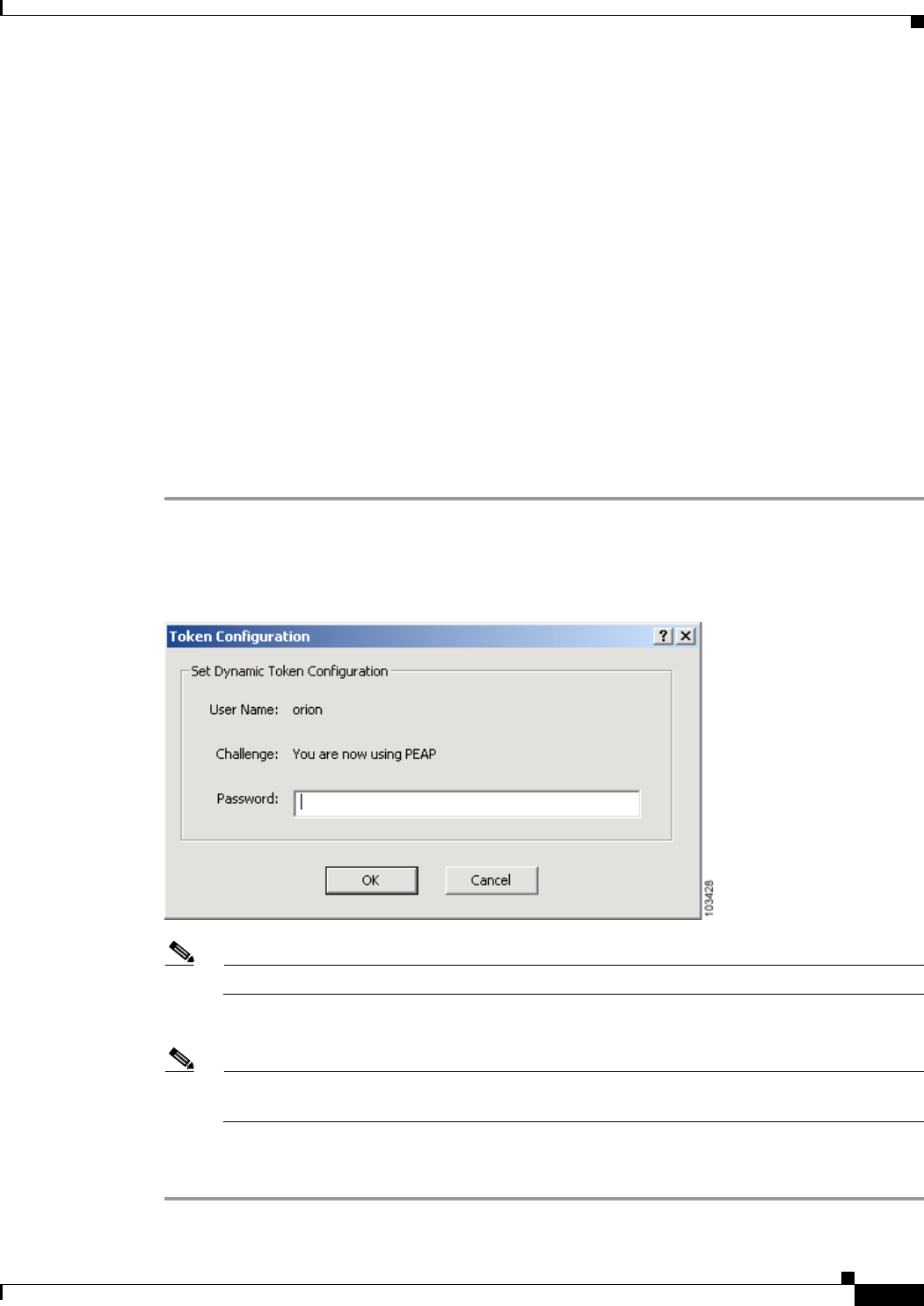
6-15
Cisco Aironet 802.11a/b/g Wireless LAN Client Adapters (CB21AG and PI21AG) Installation and Configuration Guide
OL-4211-05
Chapter 6 Using EAP Authentication
Using PEAP (EAP-GTC)
Using PEAP (EAP-GTC)
After you (or auto profile selection) activate a profile that uses PEAP (EAP-GTC) authentication or you
eject and reinsert the client adapter, reboot the computer, or log on while this profile is active, follow the
steps in one of the sections below to EAP authenticate. Choose the section appropriate for your user
database.
Windows NT or 2000 Domain Databases or LDAP Databases Only
The EAP authentication process begins automatically. The client adapter should EAP authenticate using
either your Windows credentials or the username and password entered in the Define PEAP (EAP-GTC)
Configuration window. If your client adapter authenticates, ASTU and the Link Status field on the ADU
Current Status window show Authenticated. If the authentication attempt fails, ASTU and ADU show
Authentication Failed.
OTP Databases Only
Step 1 Use your hardware token device or SofToken program to obtain the one-time password.
Step 2 When the Token Configuration window appears (see Figure 6-12), enter the one-time password.
Figure 6-12 Token Configuration Window
Note The username is filled in automatically.
Step 3 Click OK to begin the authentication process.
Note If the password is invalid or entered incorrectly, the Token Configuration window reappears,
enabling you to re-enter it.
If your client adapter authenticates, ASTU and the Link Status field on the ADU Current Status window
show Authenticated. If the authentication attempt fails, ASTU and ADU show Authentication Failed.

6-16
Cisco Aironet 802.11a/b/g Wireless LAN Client Adapters (CB21AG and PI21AG) Installation and Configuration Guide
OL-4211-05
Chapter 6 Using EAP Authentication
Using PEAP (EAP-MSCHAP V2)
Using PEAP (EAP-MSCHAP V2)
After you (or auto profile selection) activate a profile that uses PEAP (EAP-MSCHAP V2)
authentication or you eject and reinsert the client adapter, reboot the computer, or log on while this
profile is active, the EAP authentication process begins automatically. The client adapter should EAP
authenticate using either your Windows credentials or the username and password entered in the Define
PEAP (EAP-MSCHAP V2) Configuration window.
If your client adapter authenticates, ASTU and the Link Status field on the ADU Current Status window
show Authenticated. If the authentication attempt fails, ASTU and ADU show Authentication Failed.
Restarting the Authentication Process
To force your client adapter to try to reauthenticate using the username and password of the current
profile, choose Reauthenticate from the ASTU pop-up menu or the ADU Action drop-down menu.
When you choose this option, the authentication process begins.
If your client adapter is unable to authenticate using the specified username and password, you may be
prompted to re-enter them. If you click Cancel, a message appears indicating that the current profile will
be disabled until you choose the Reauthenticate option, reboot your computer, or eject and reinsert the
client adapter.